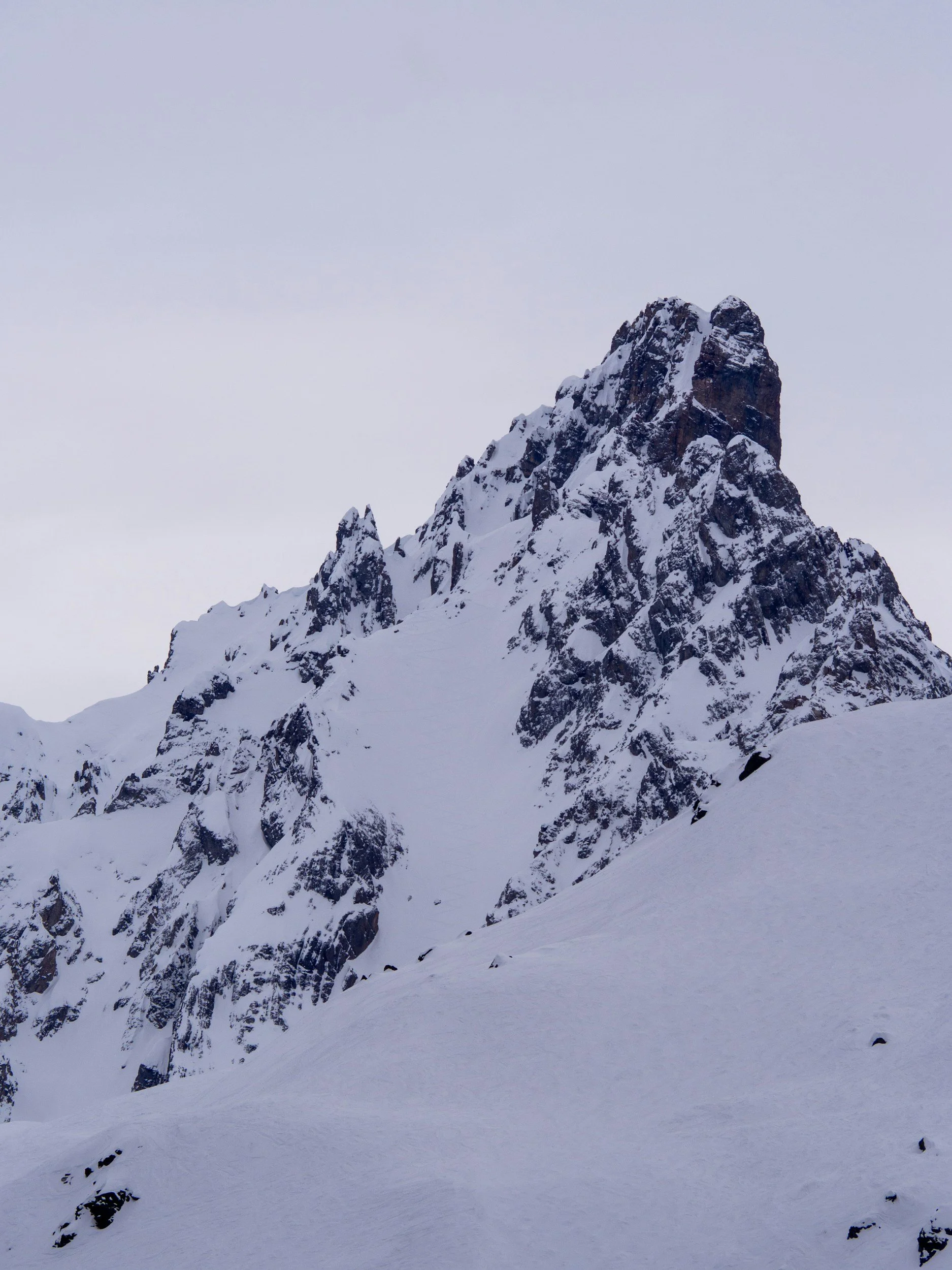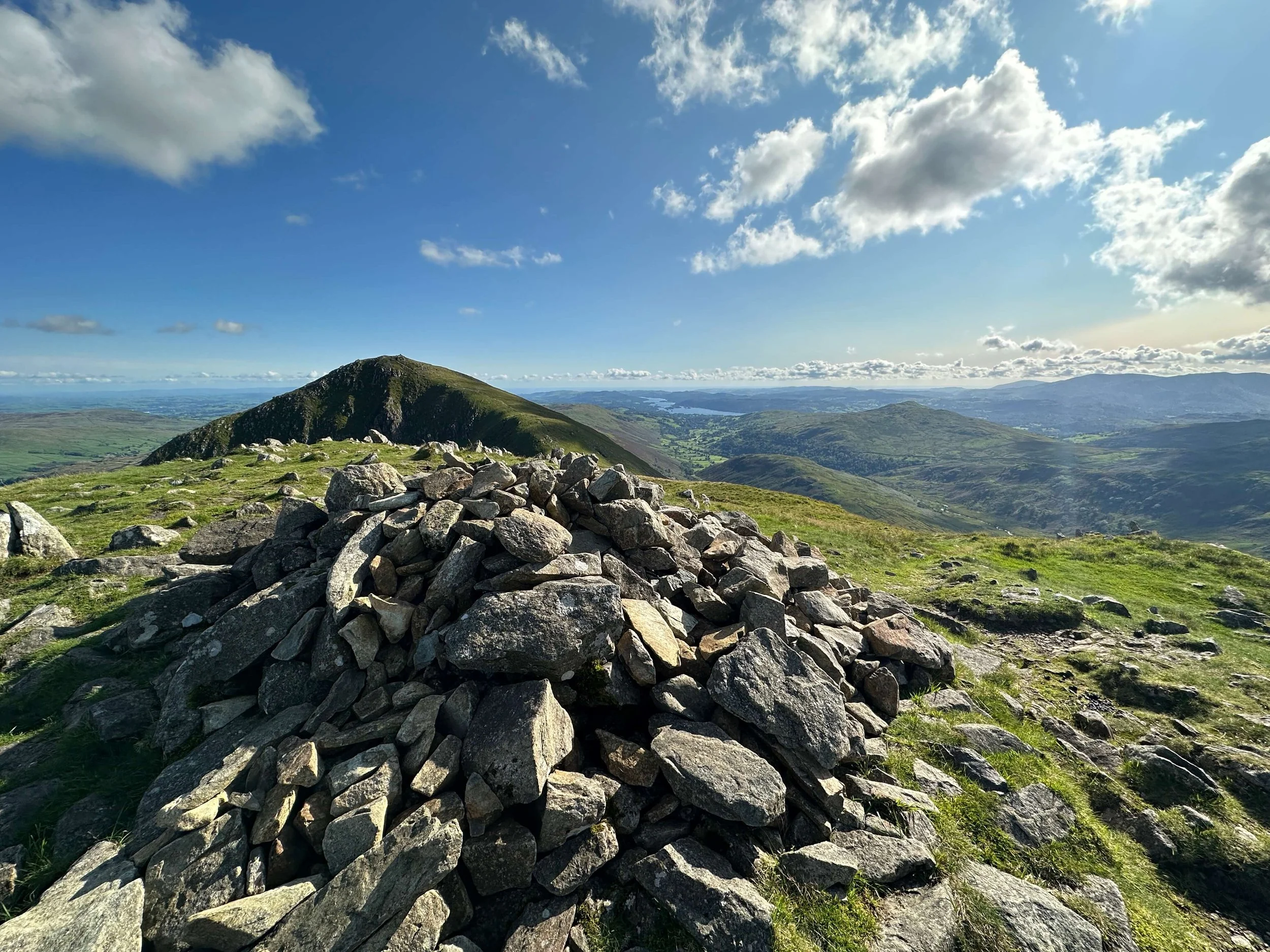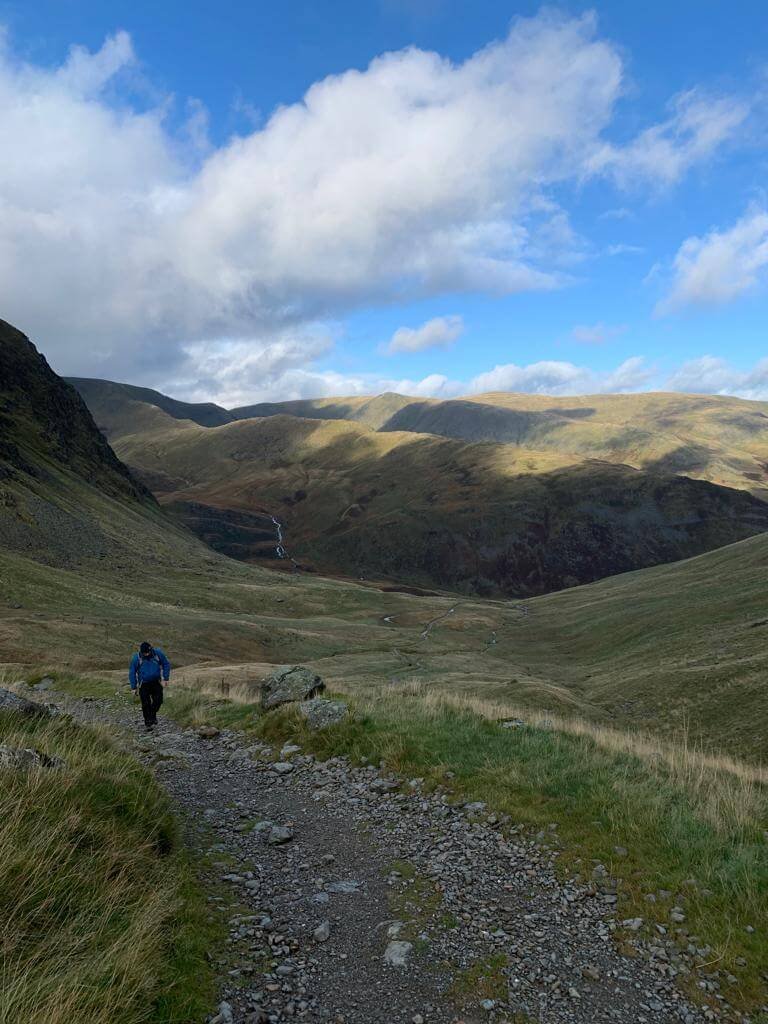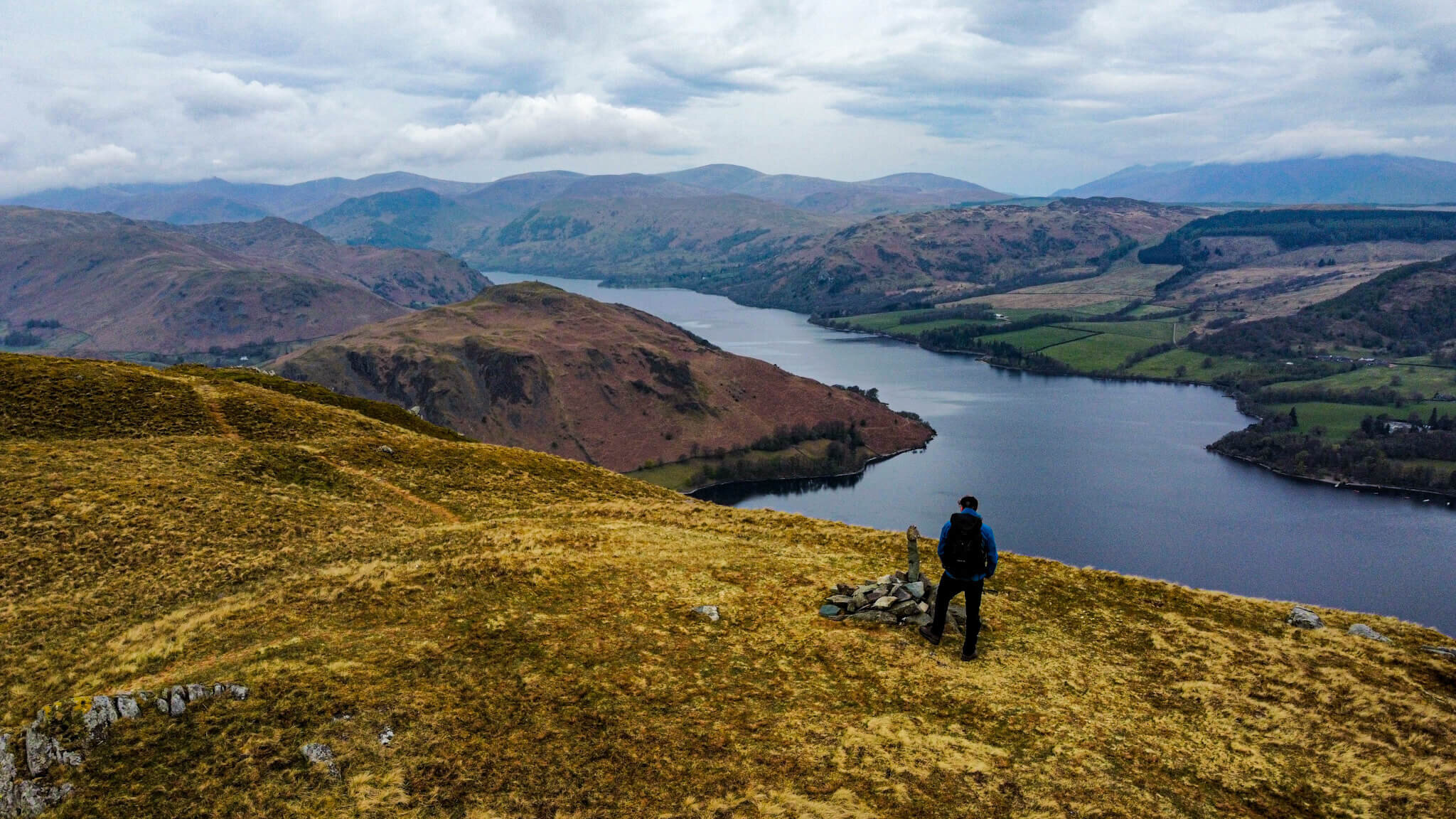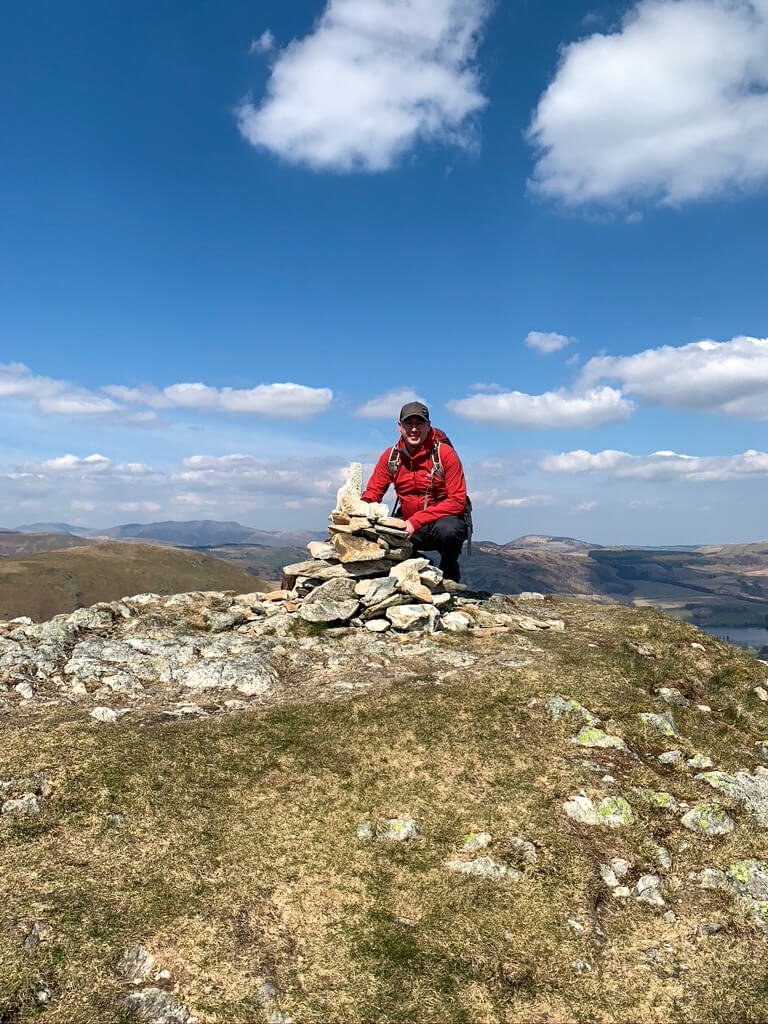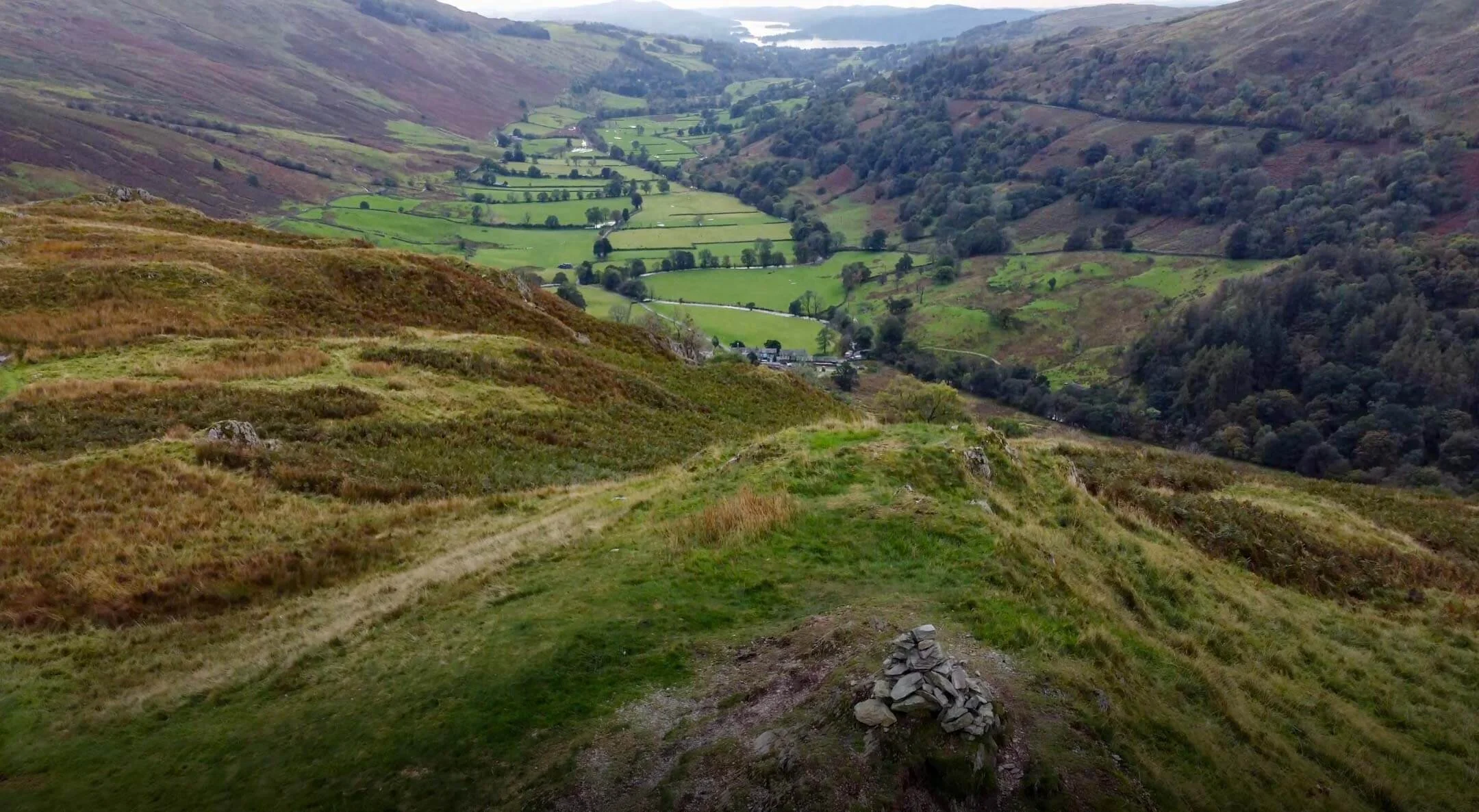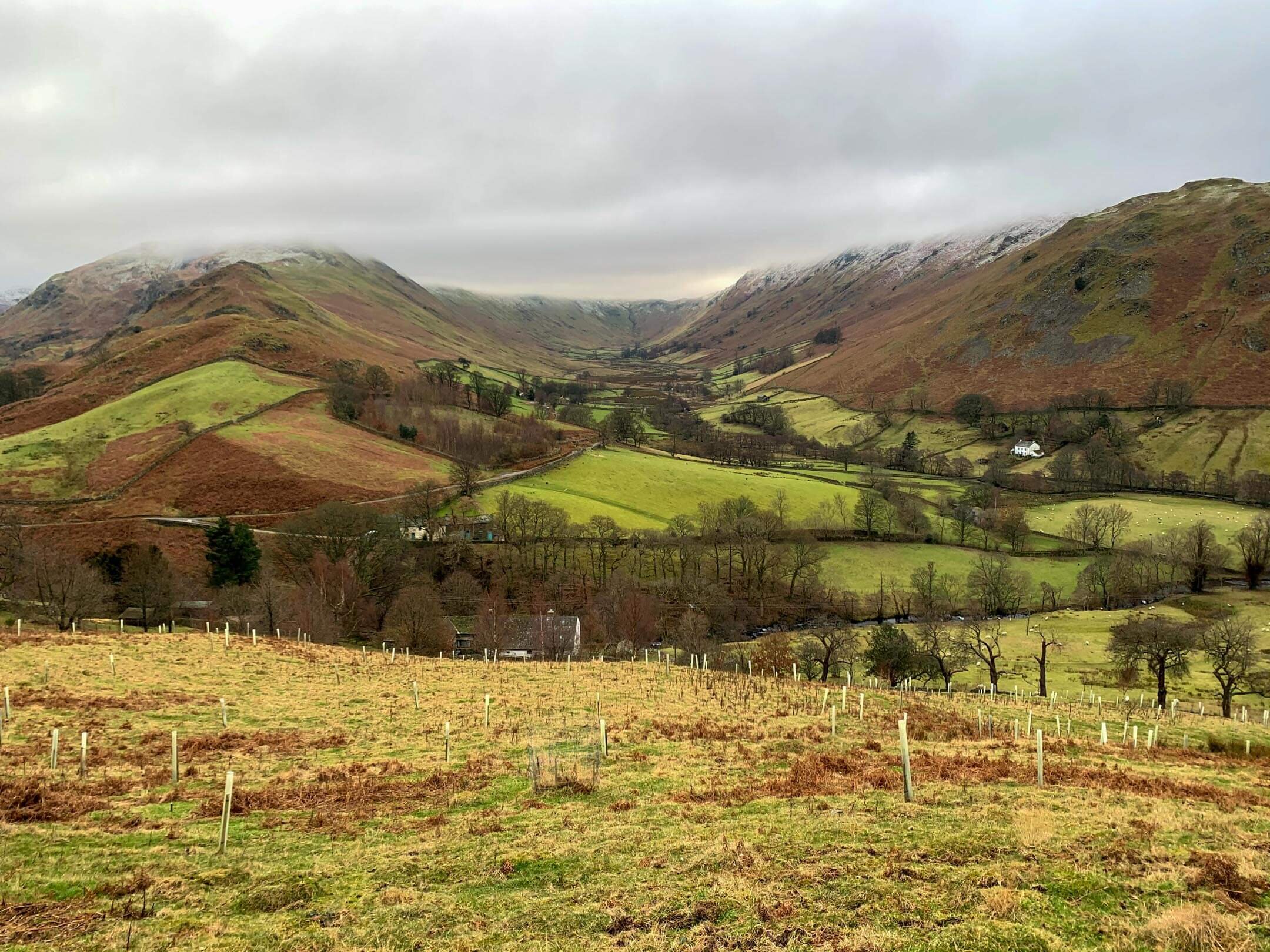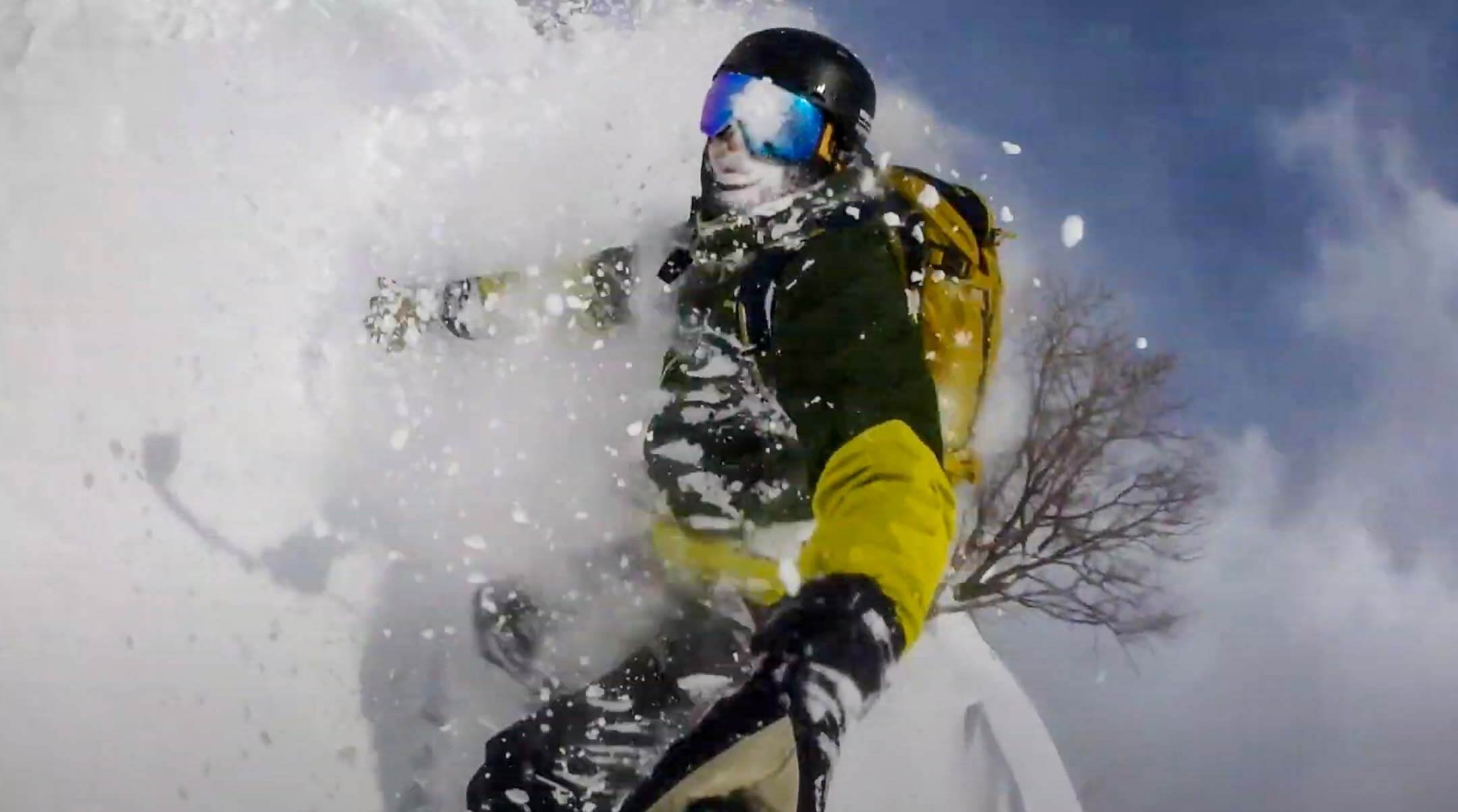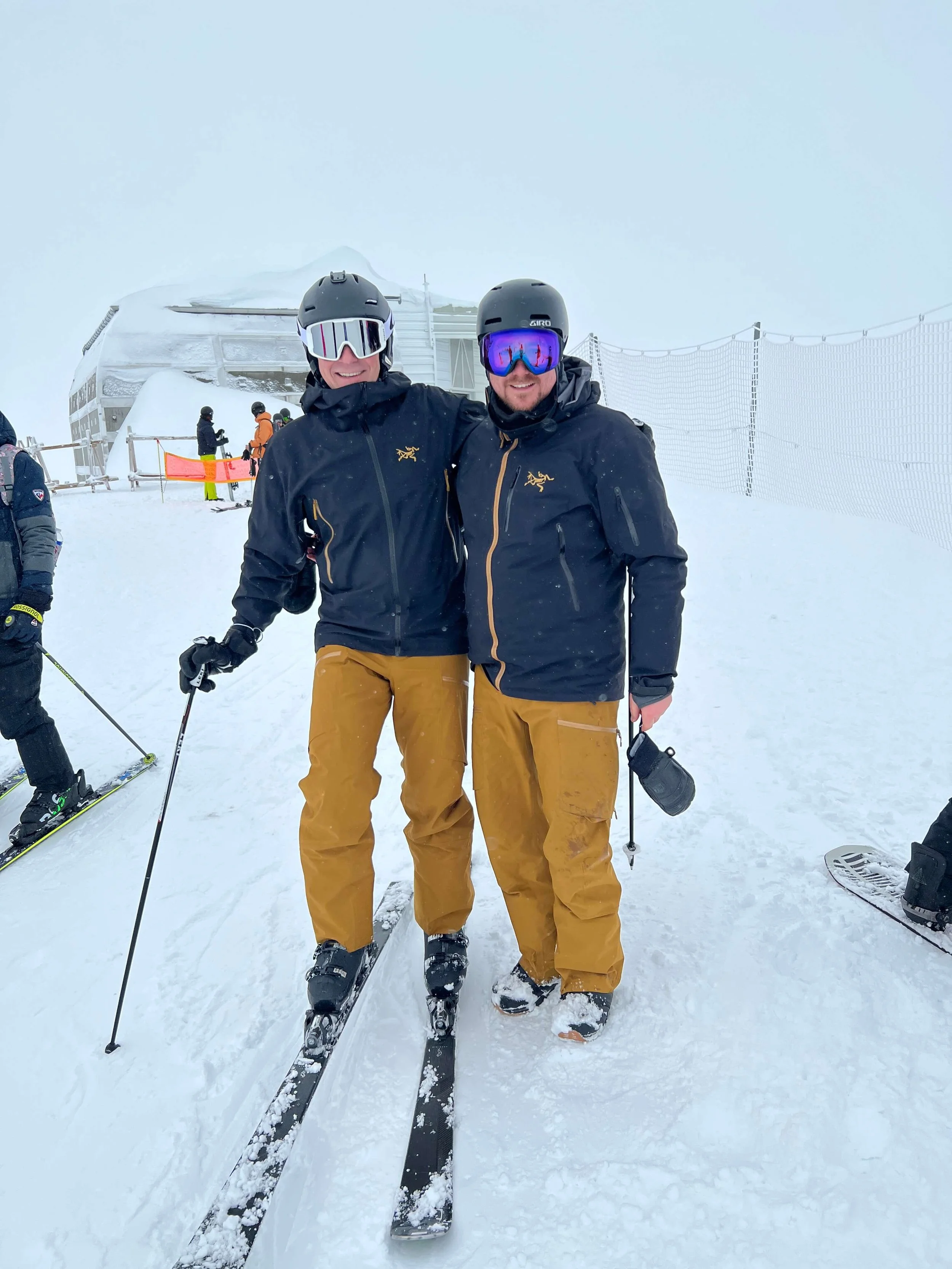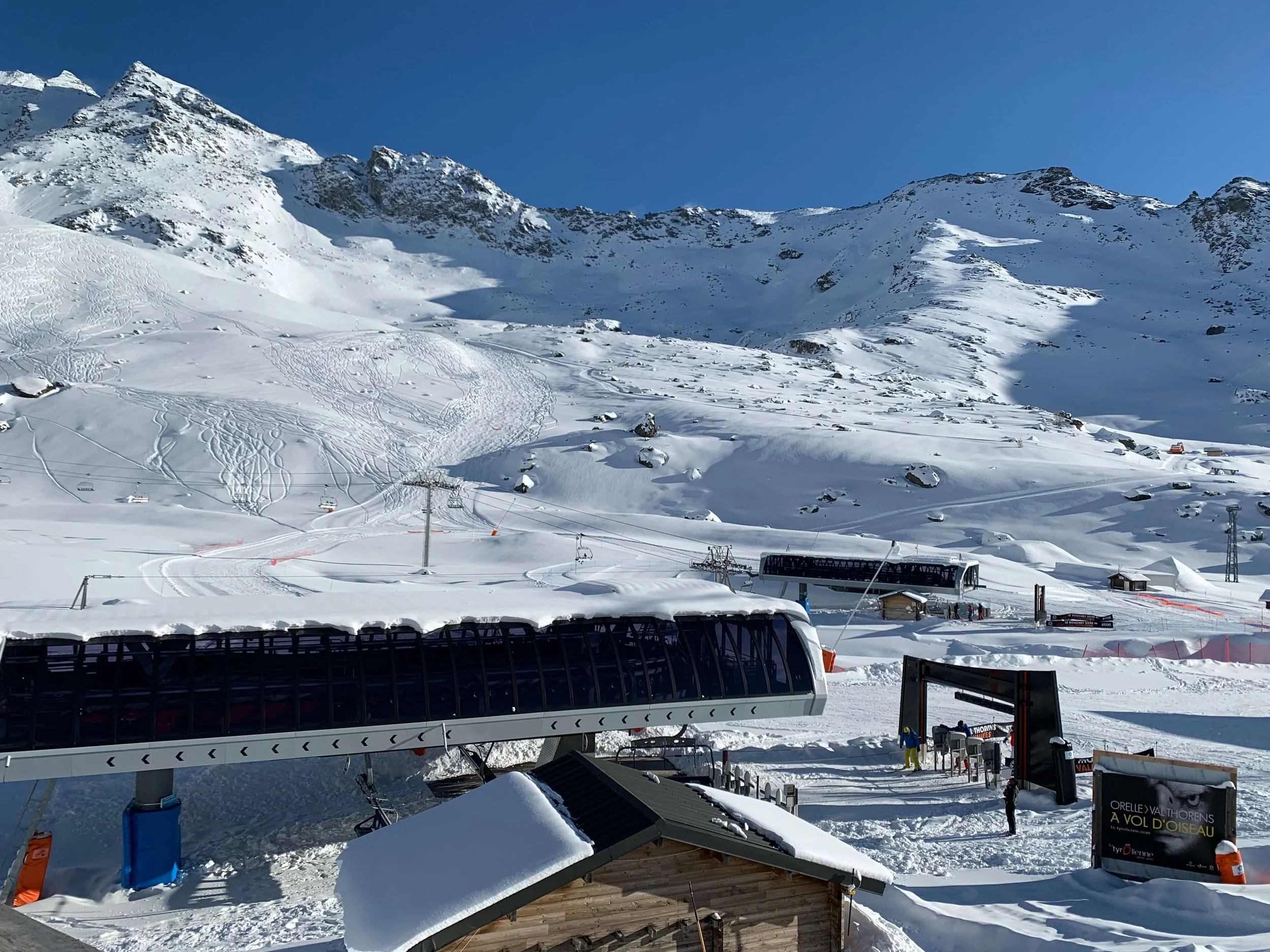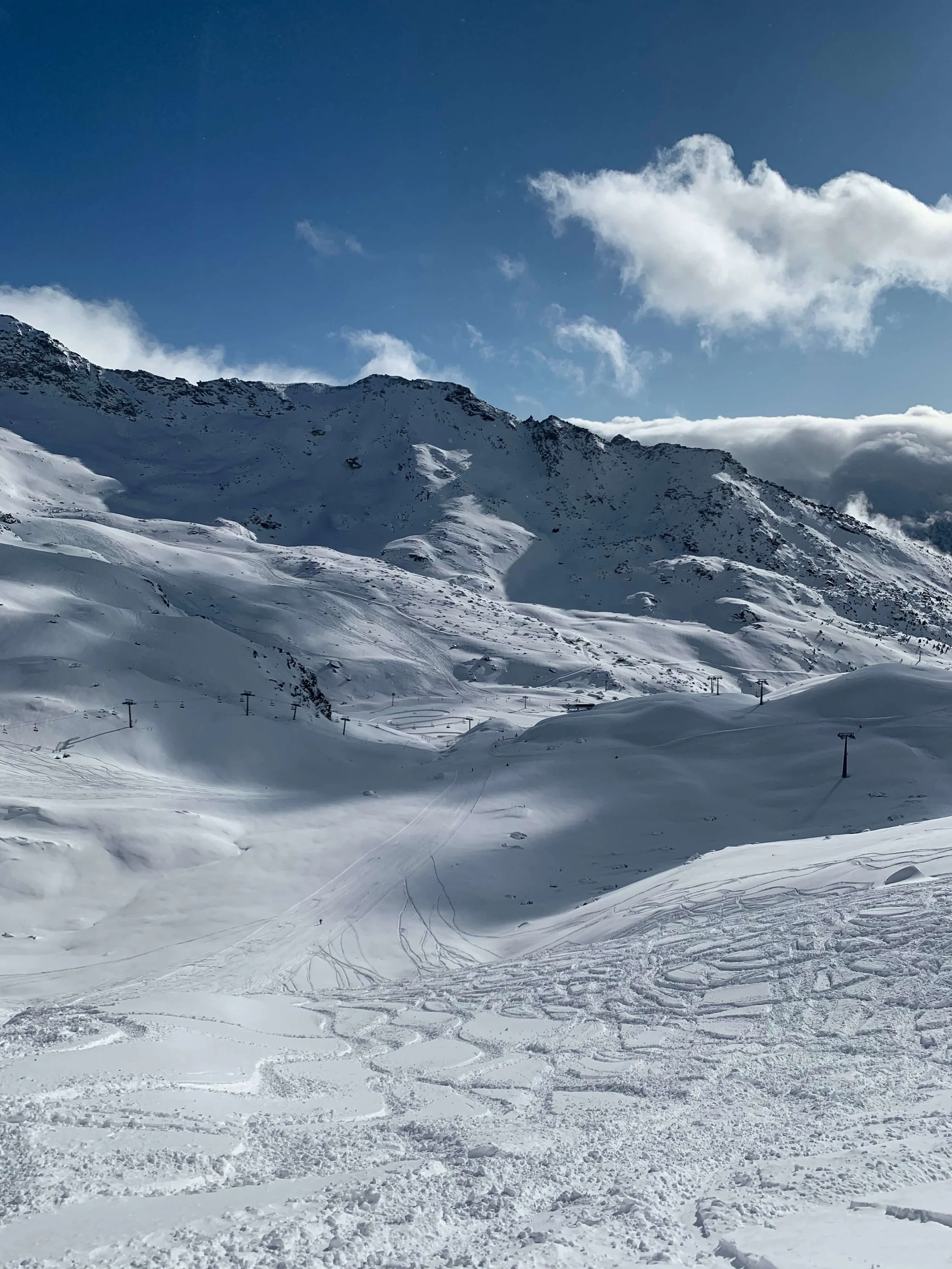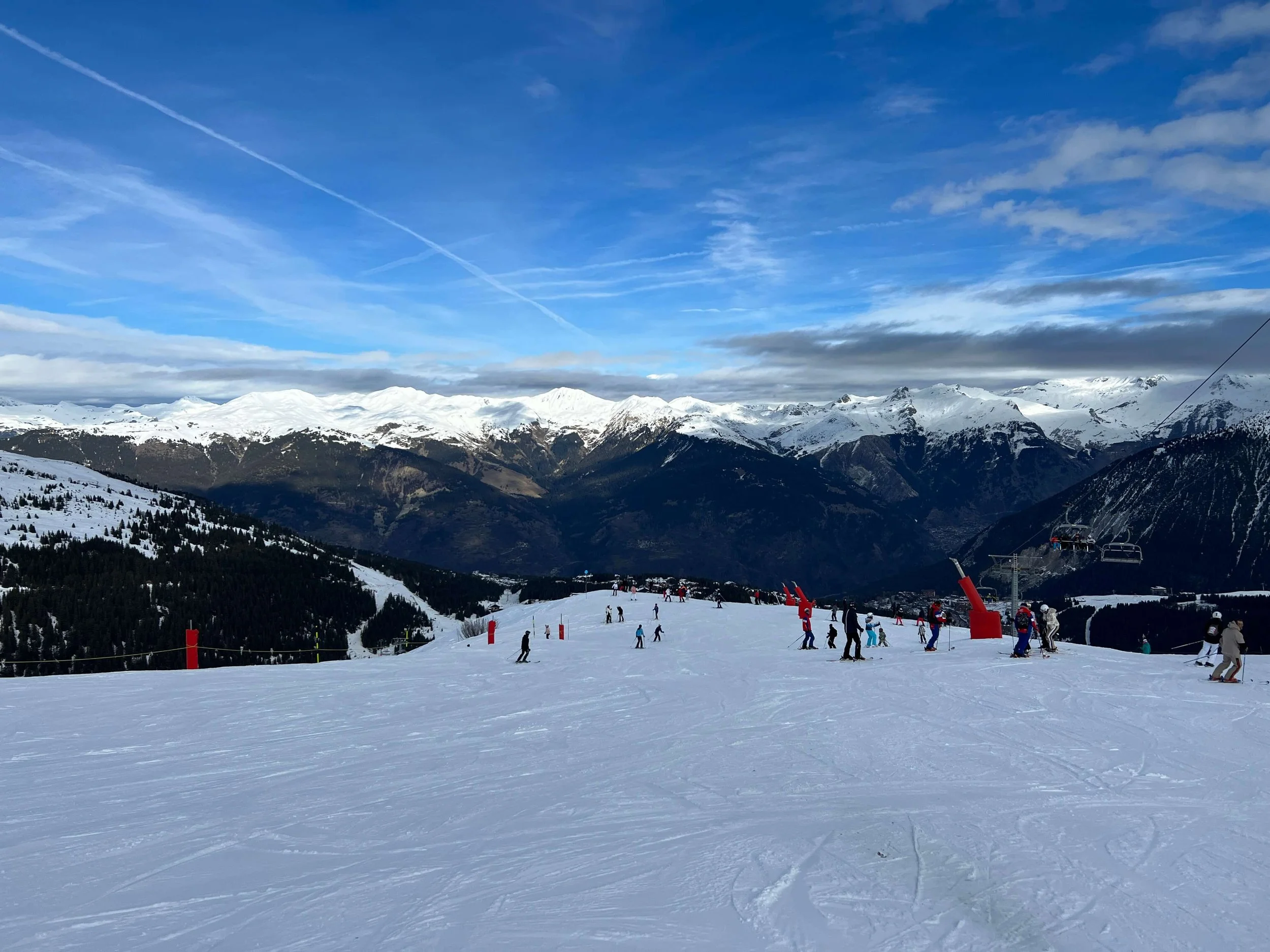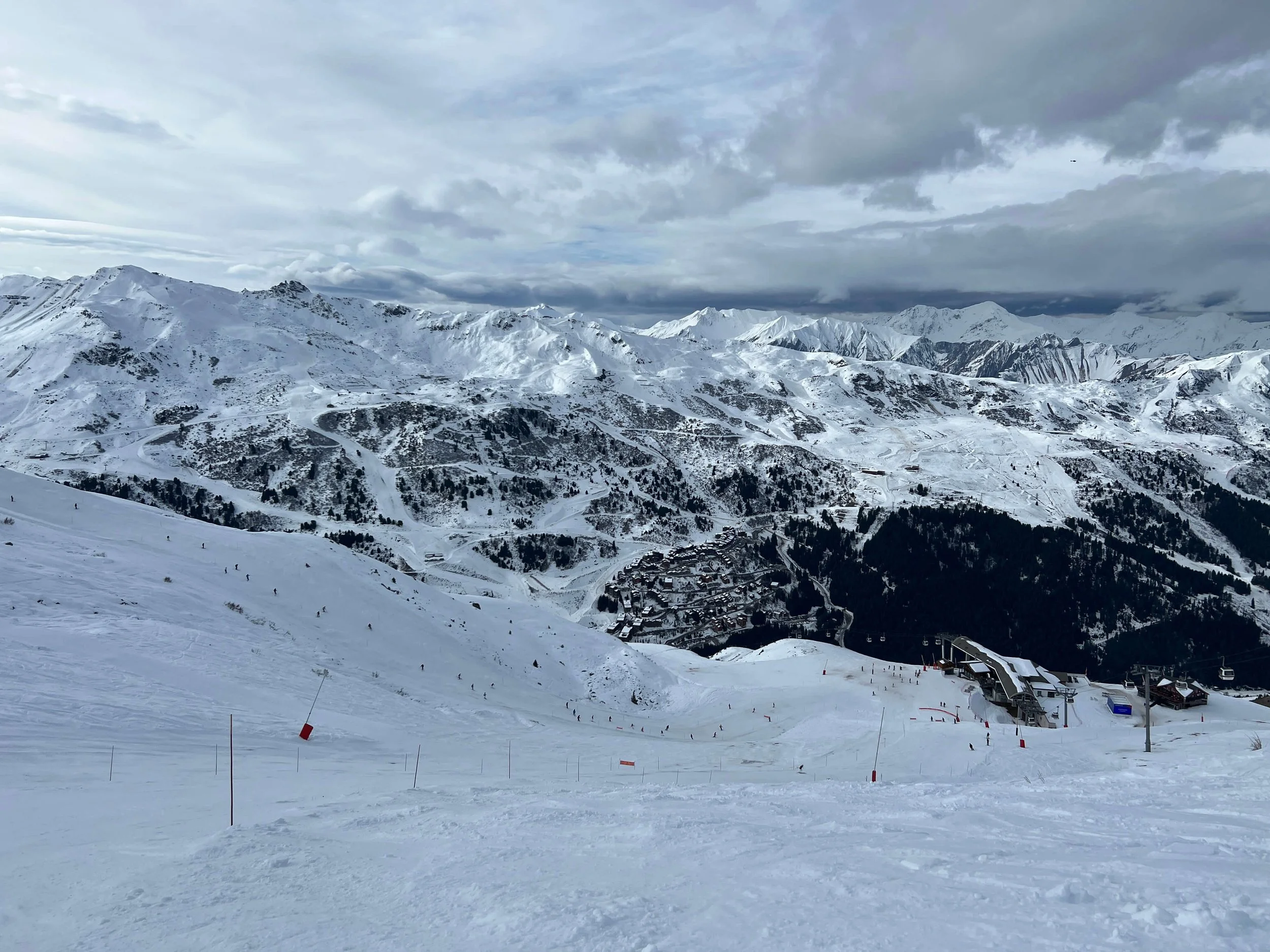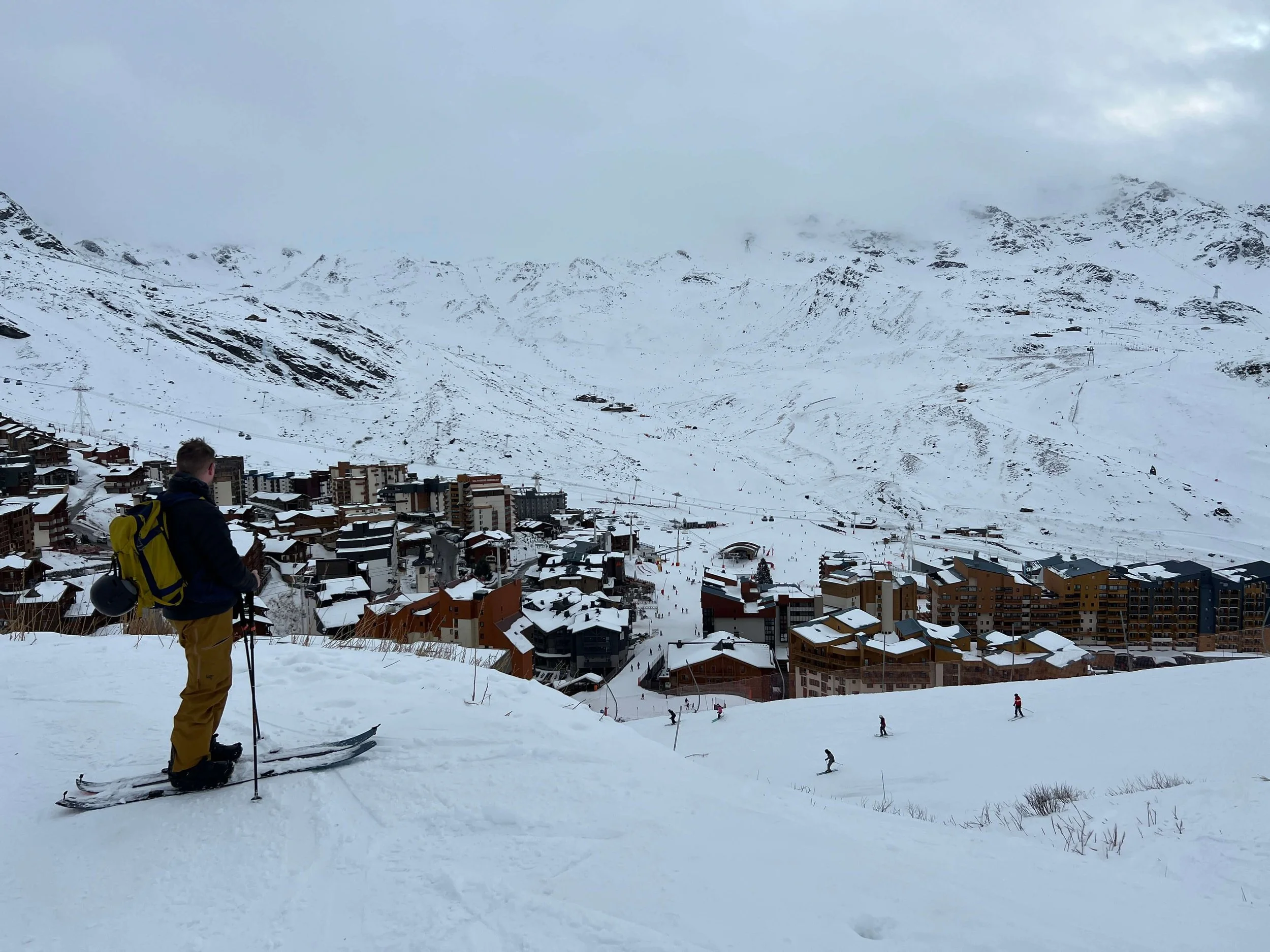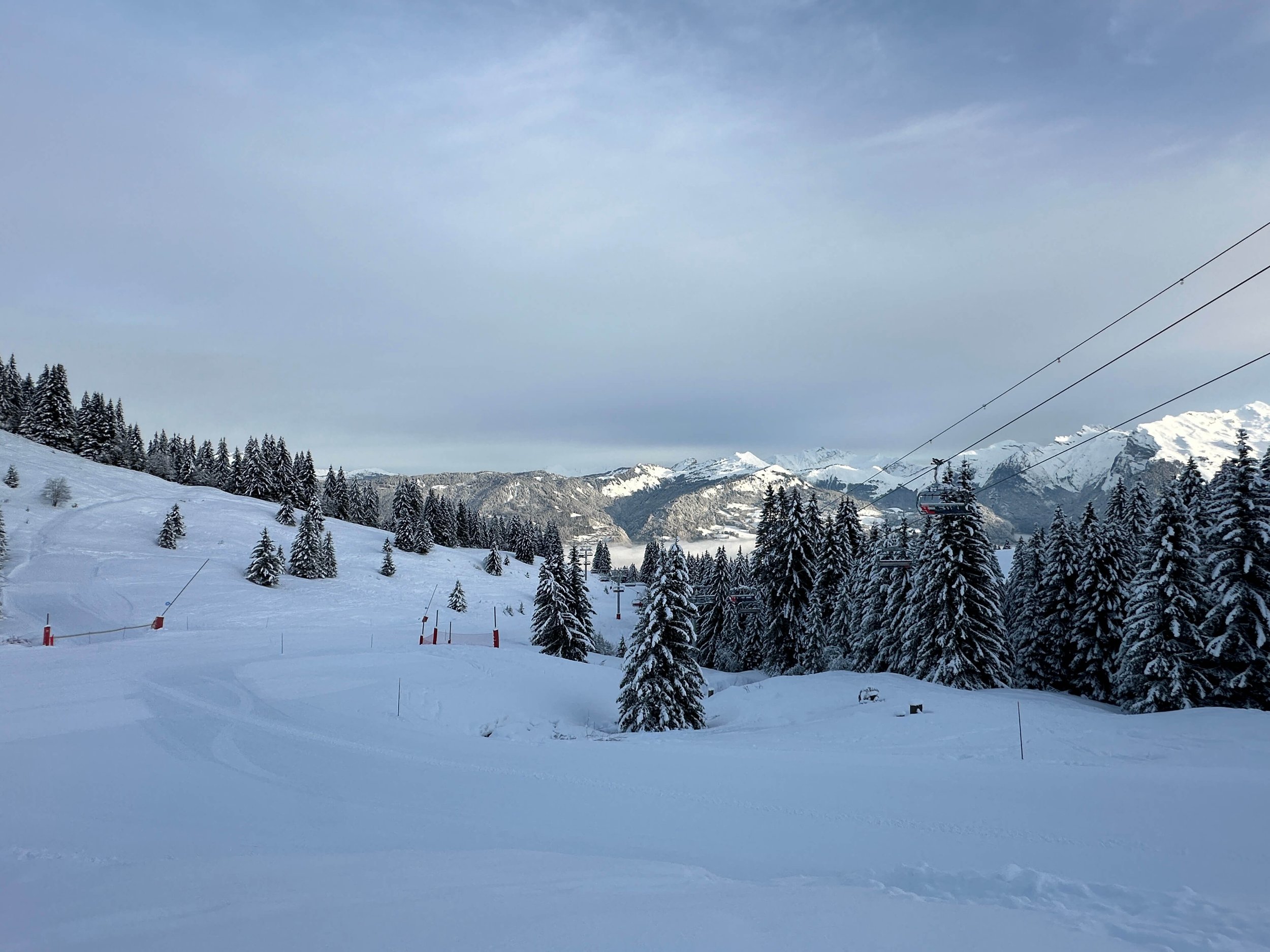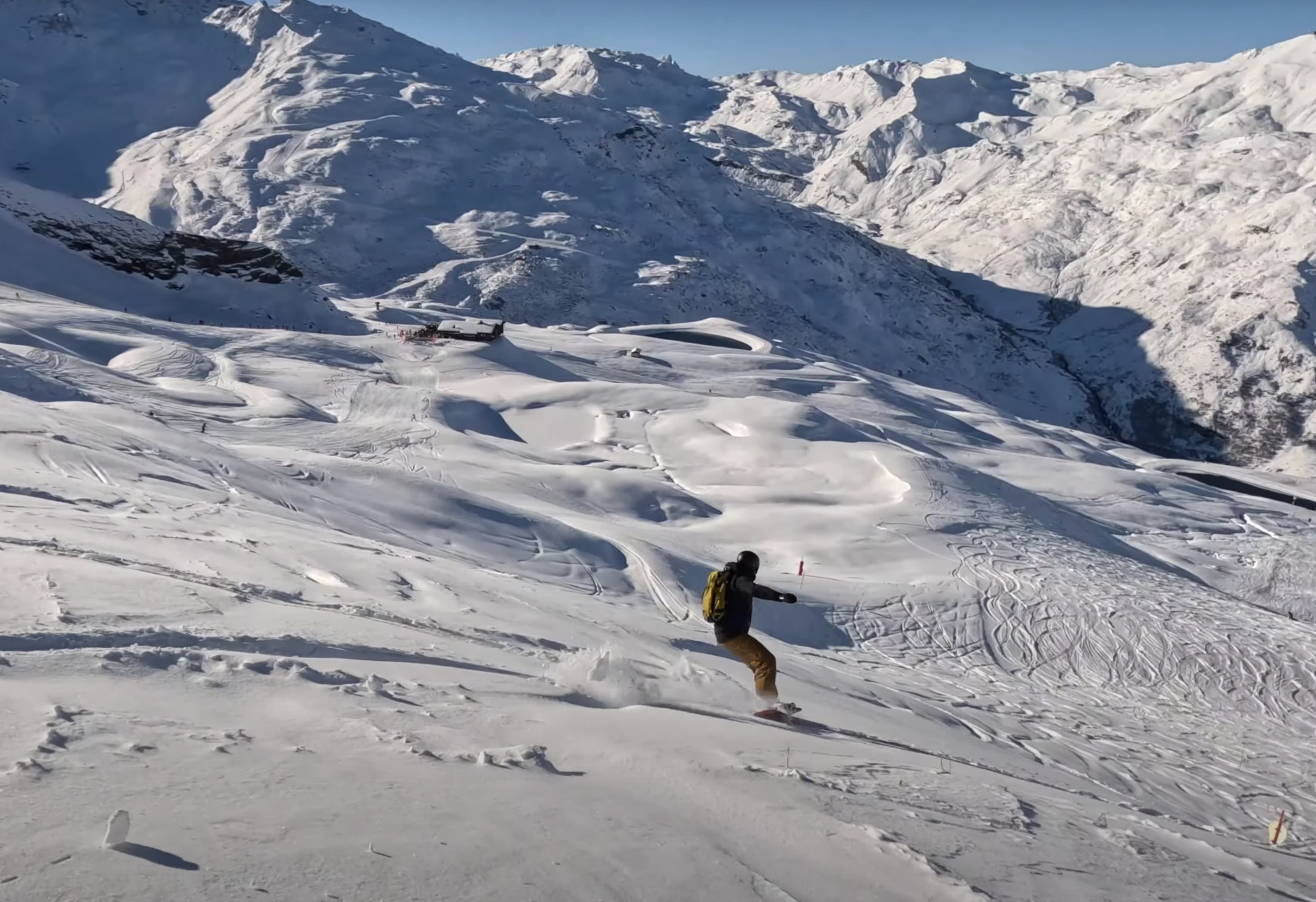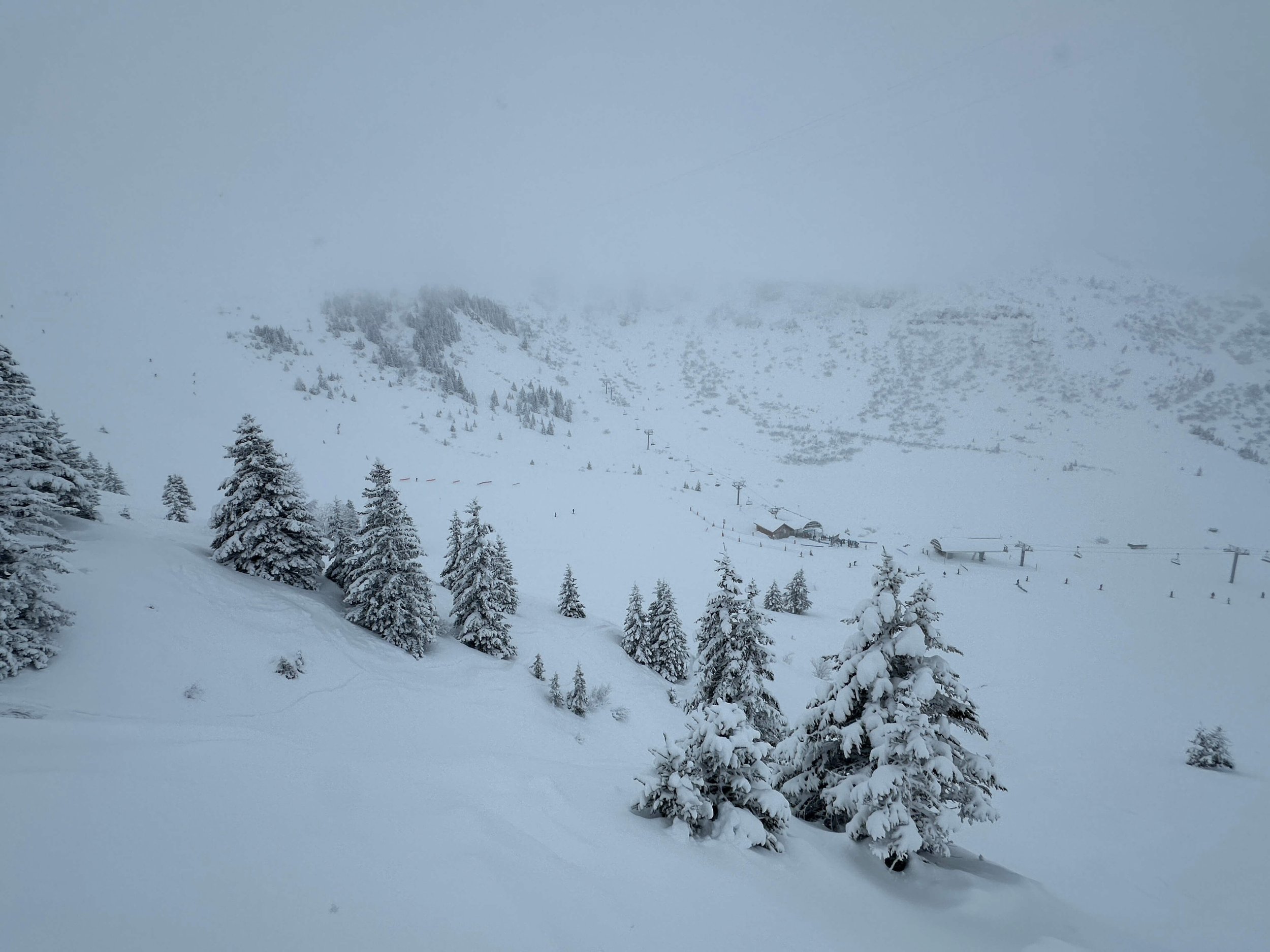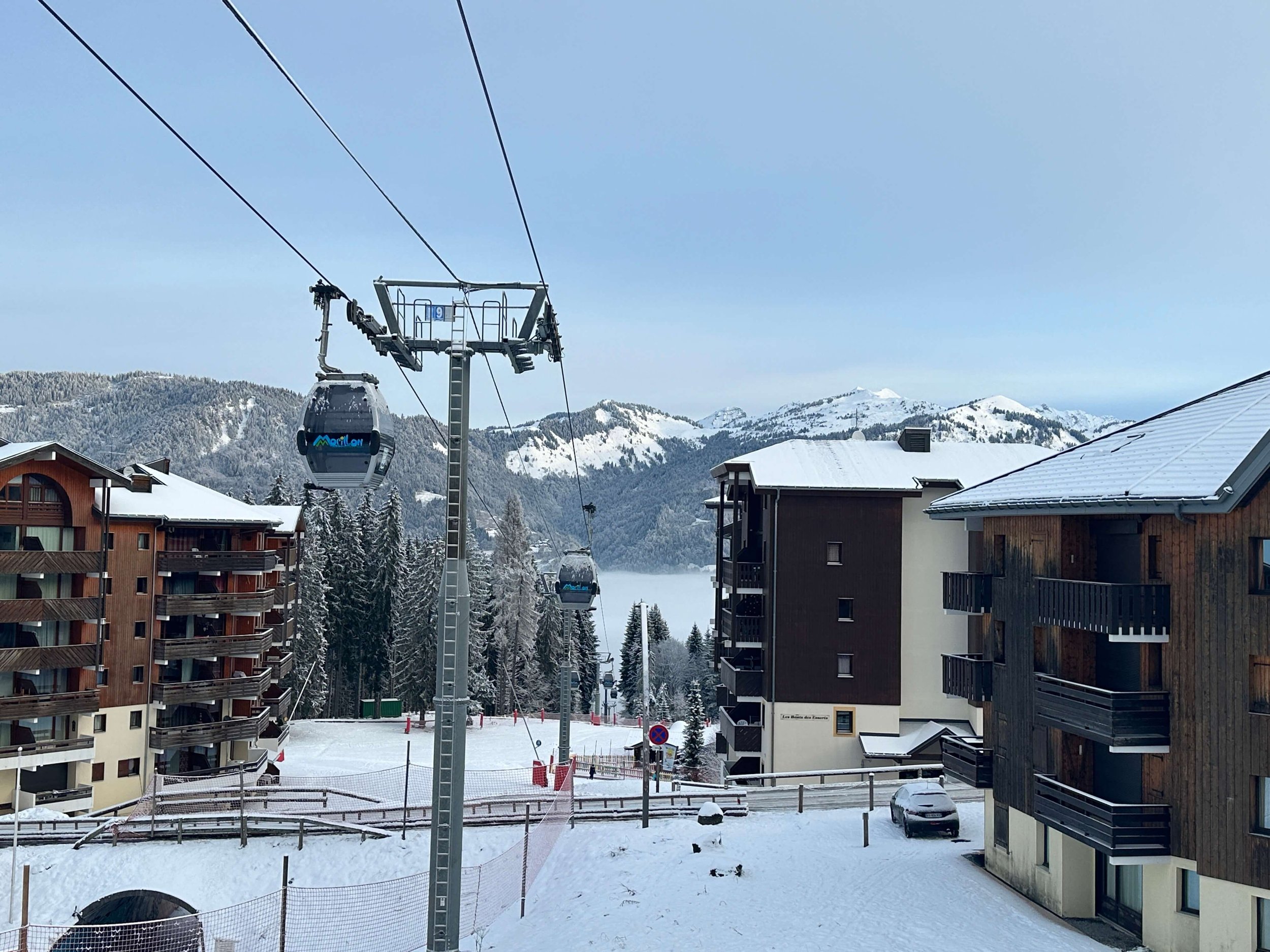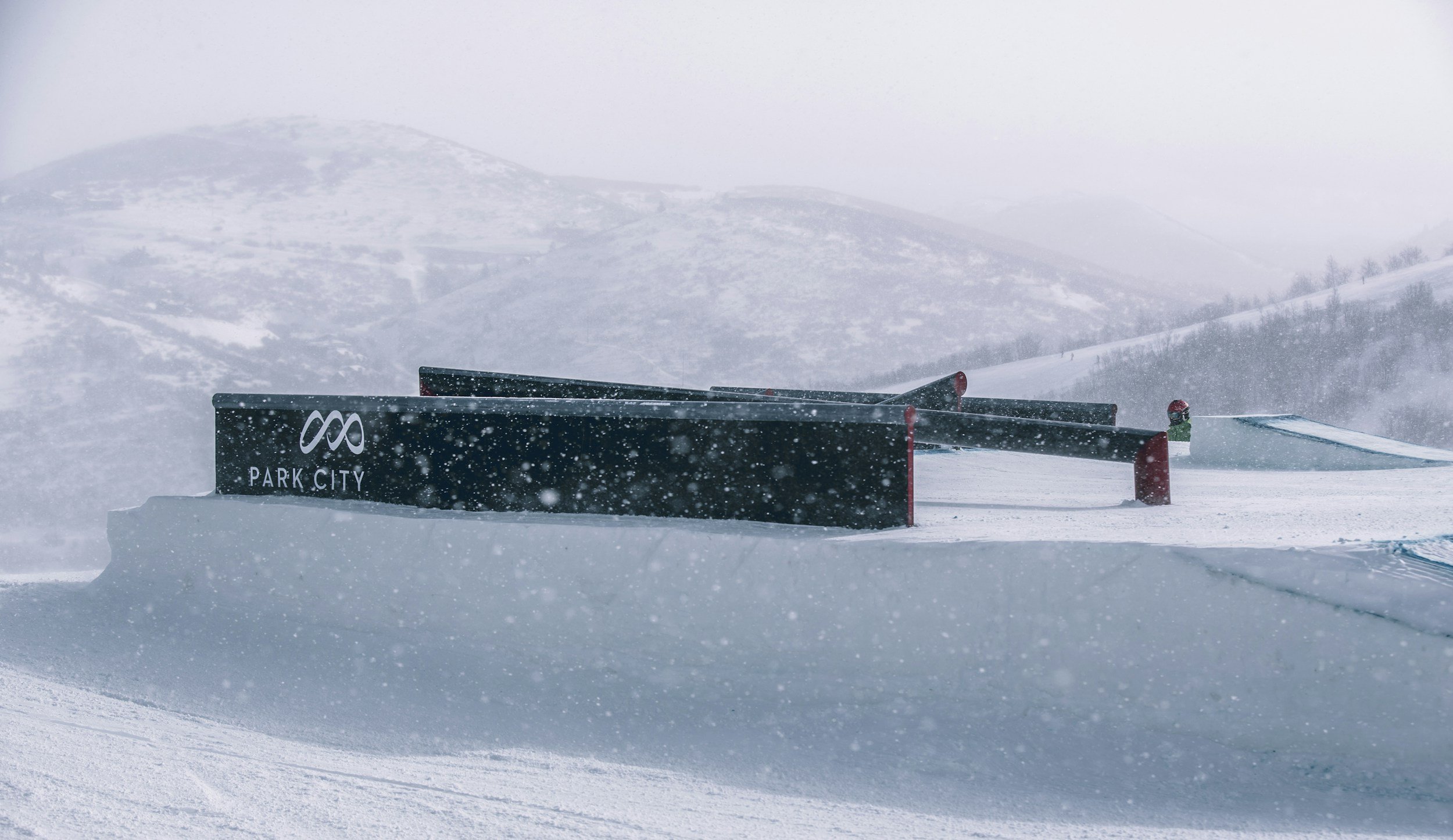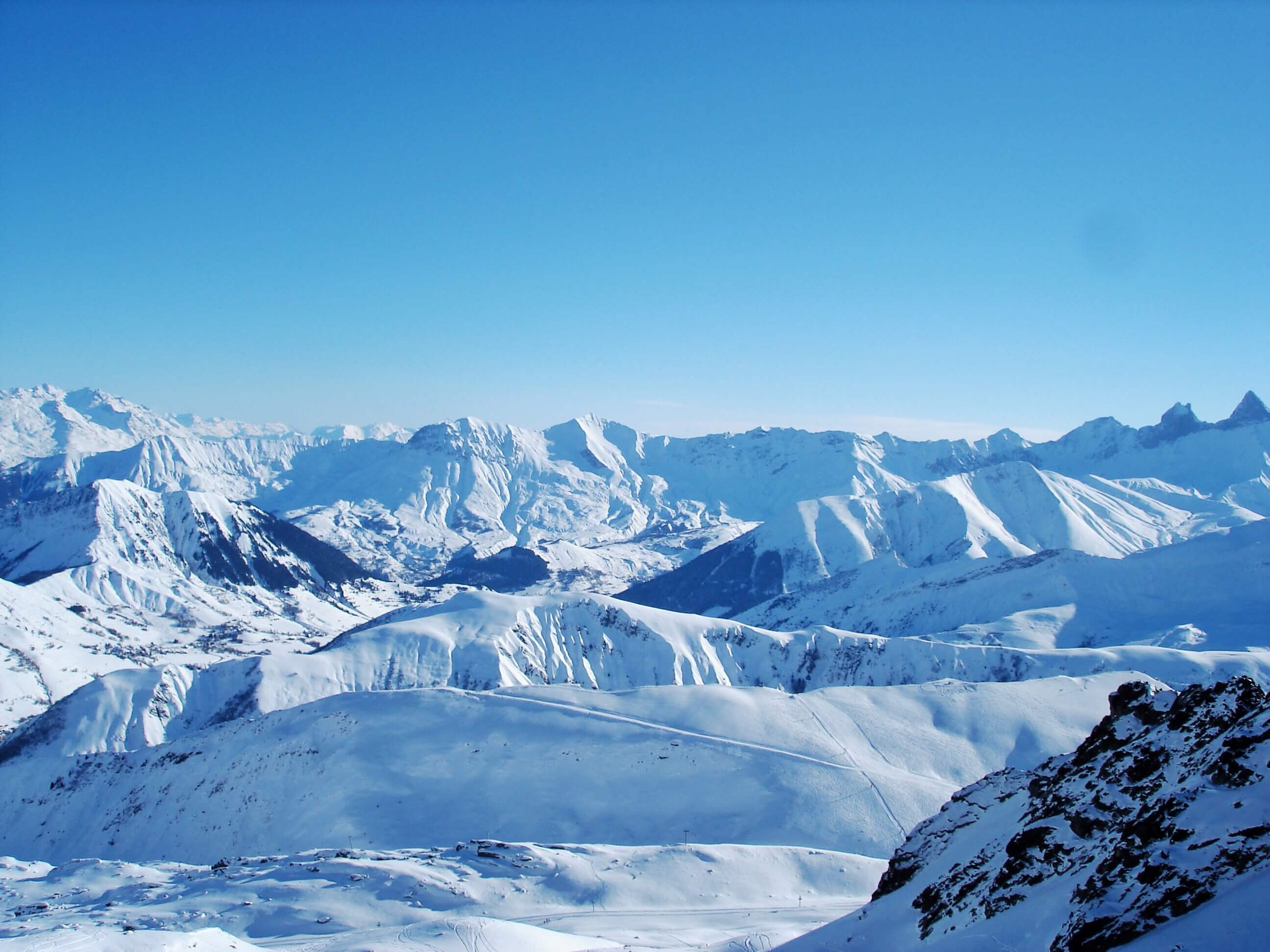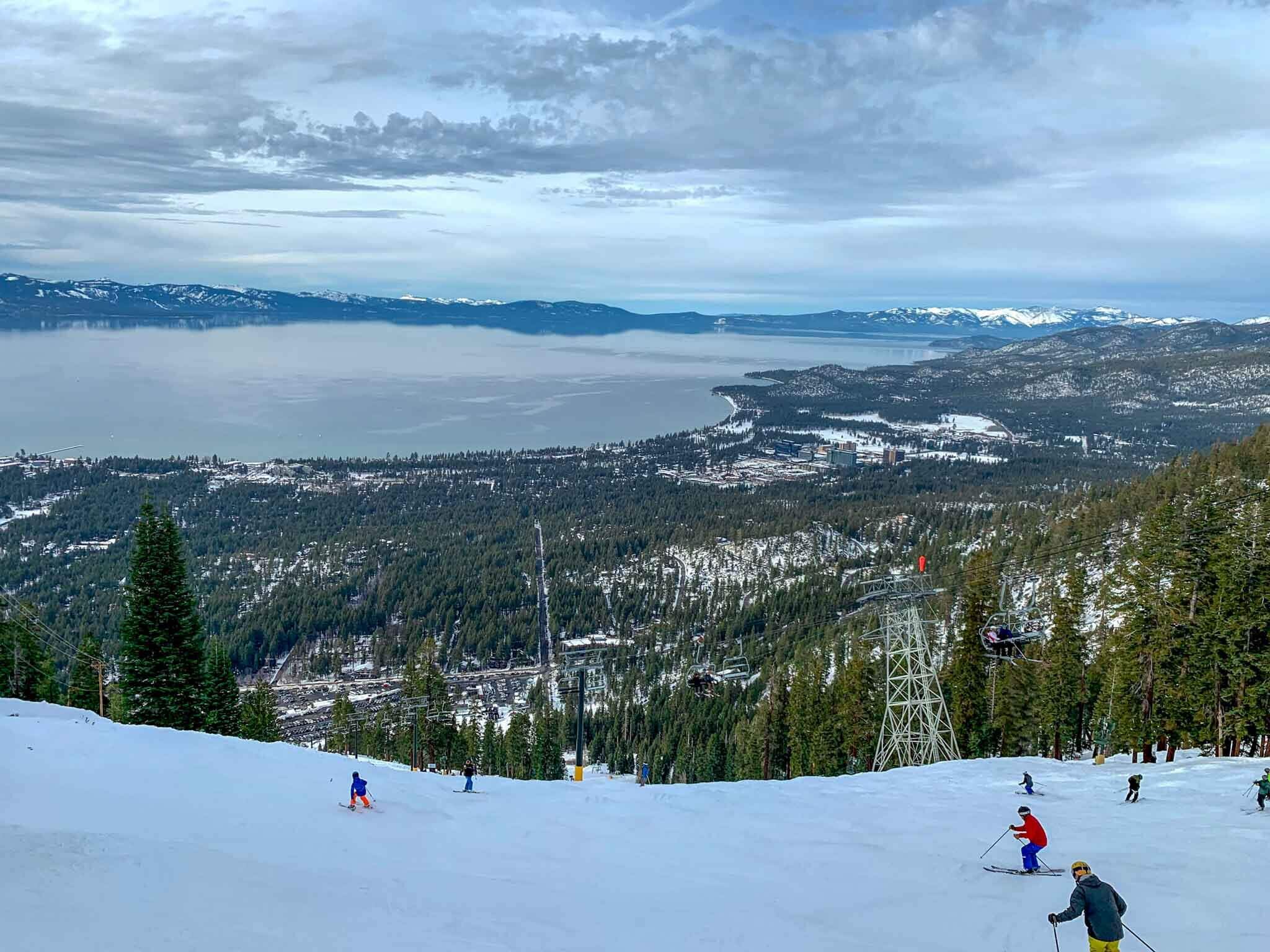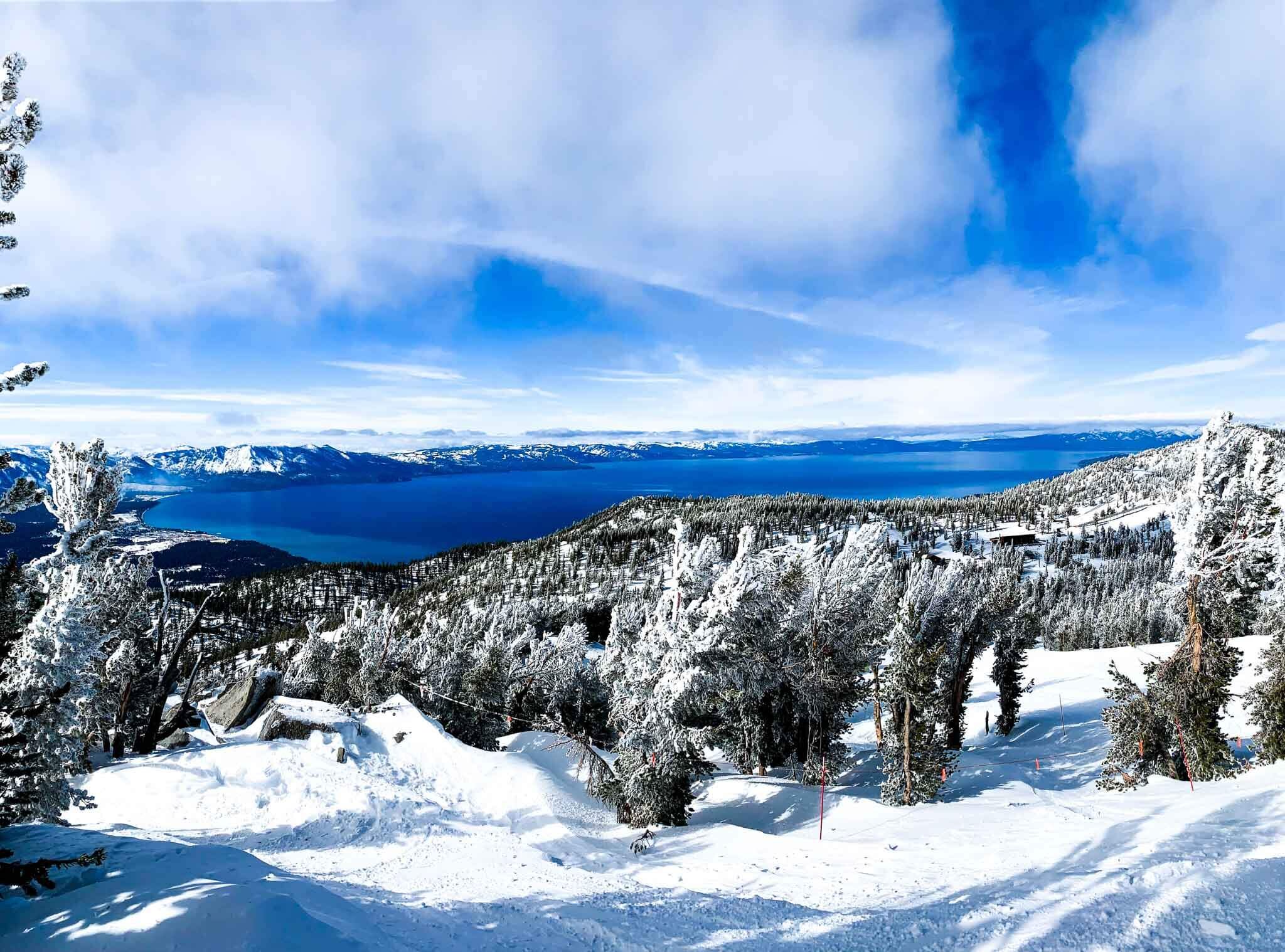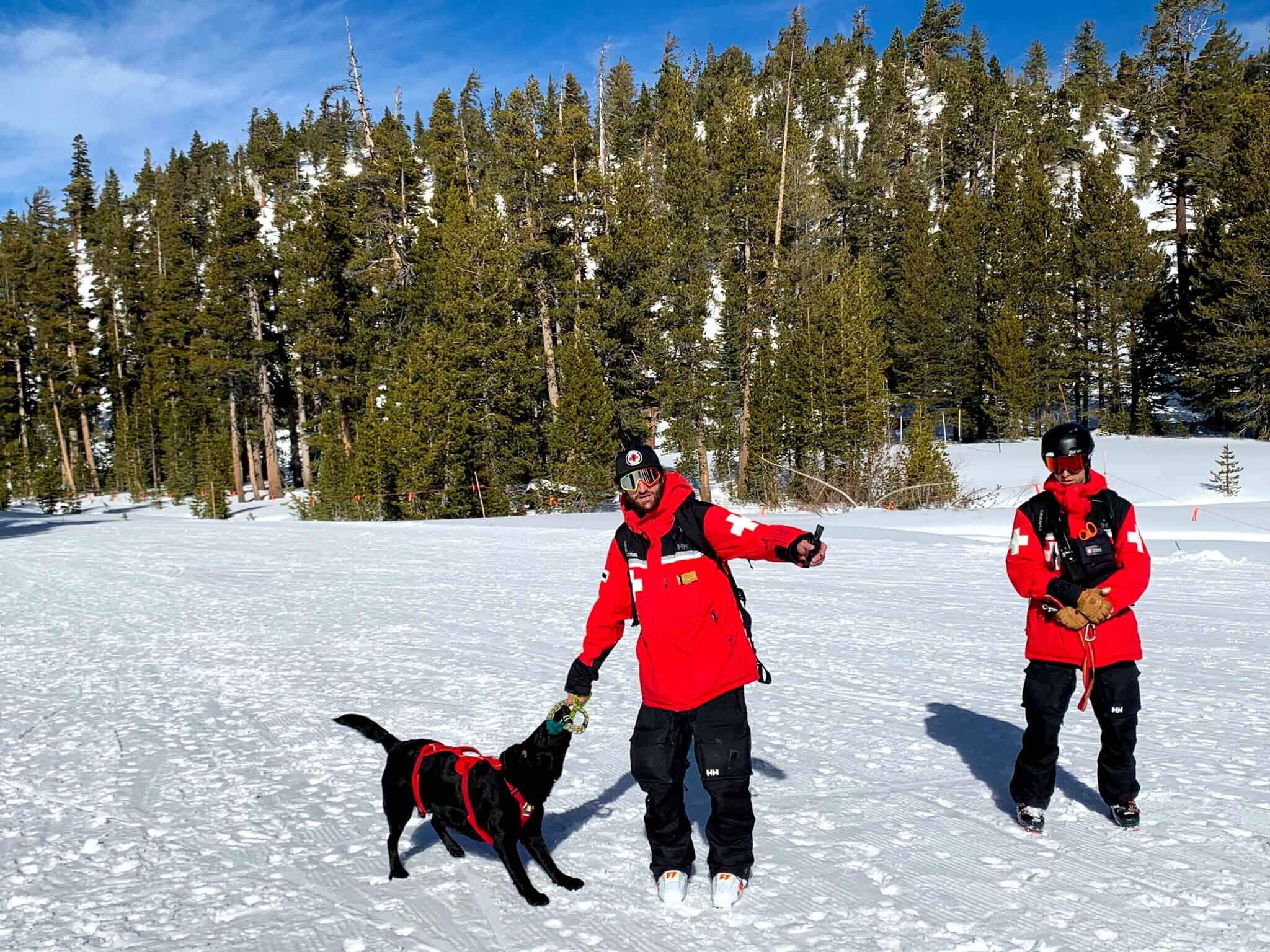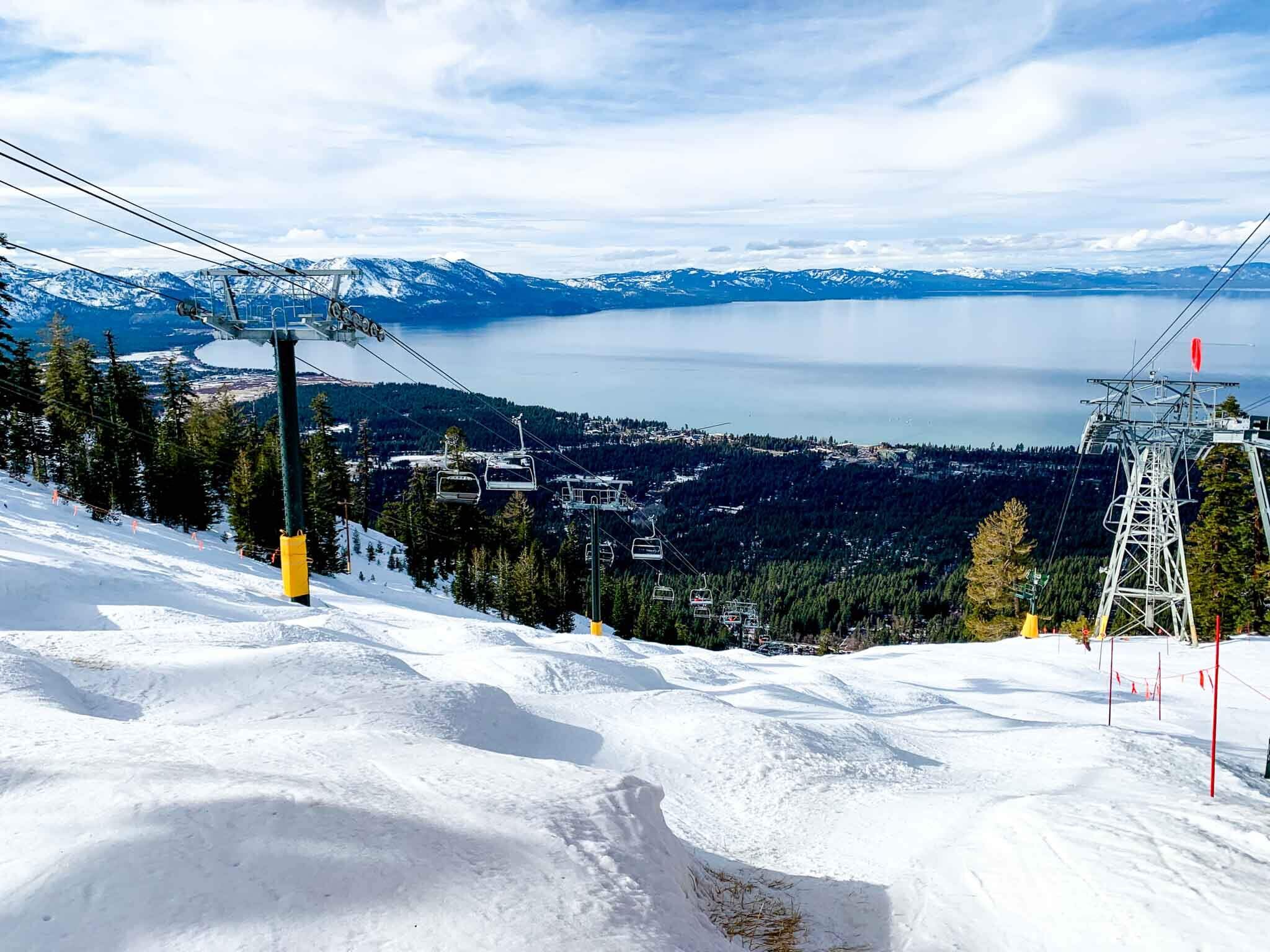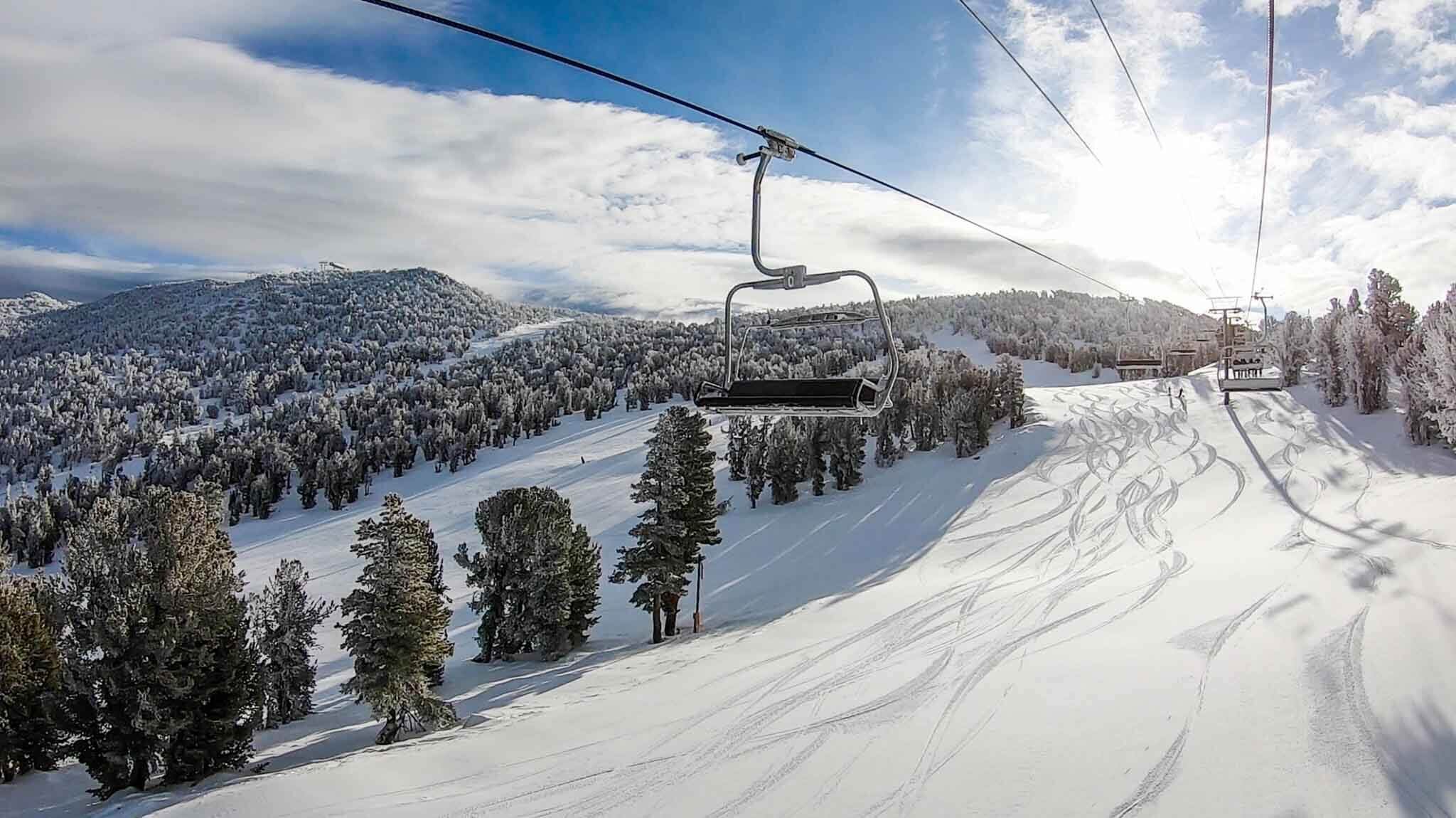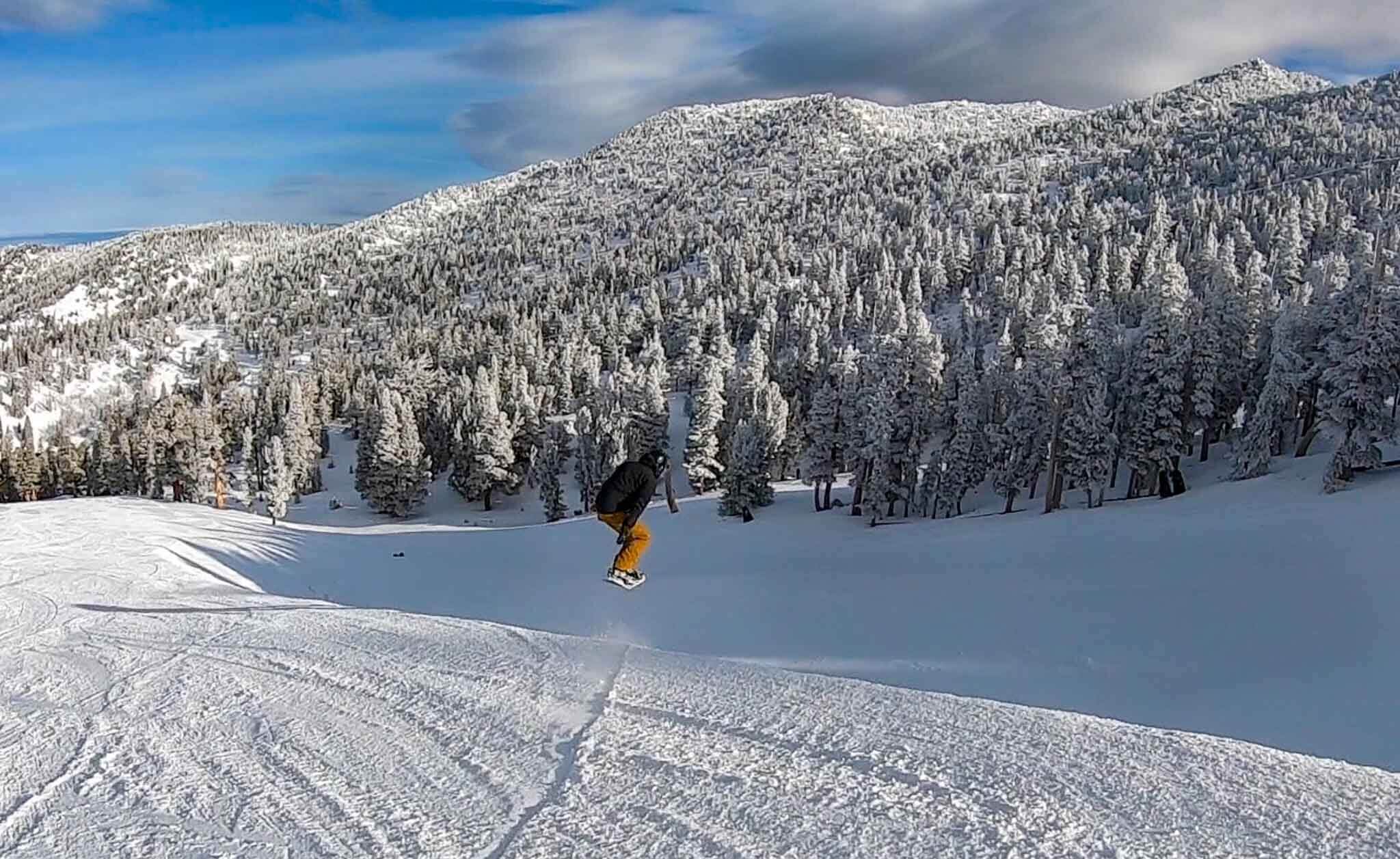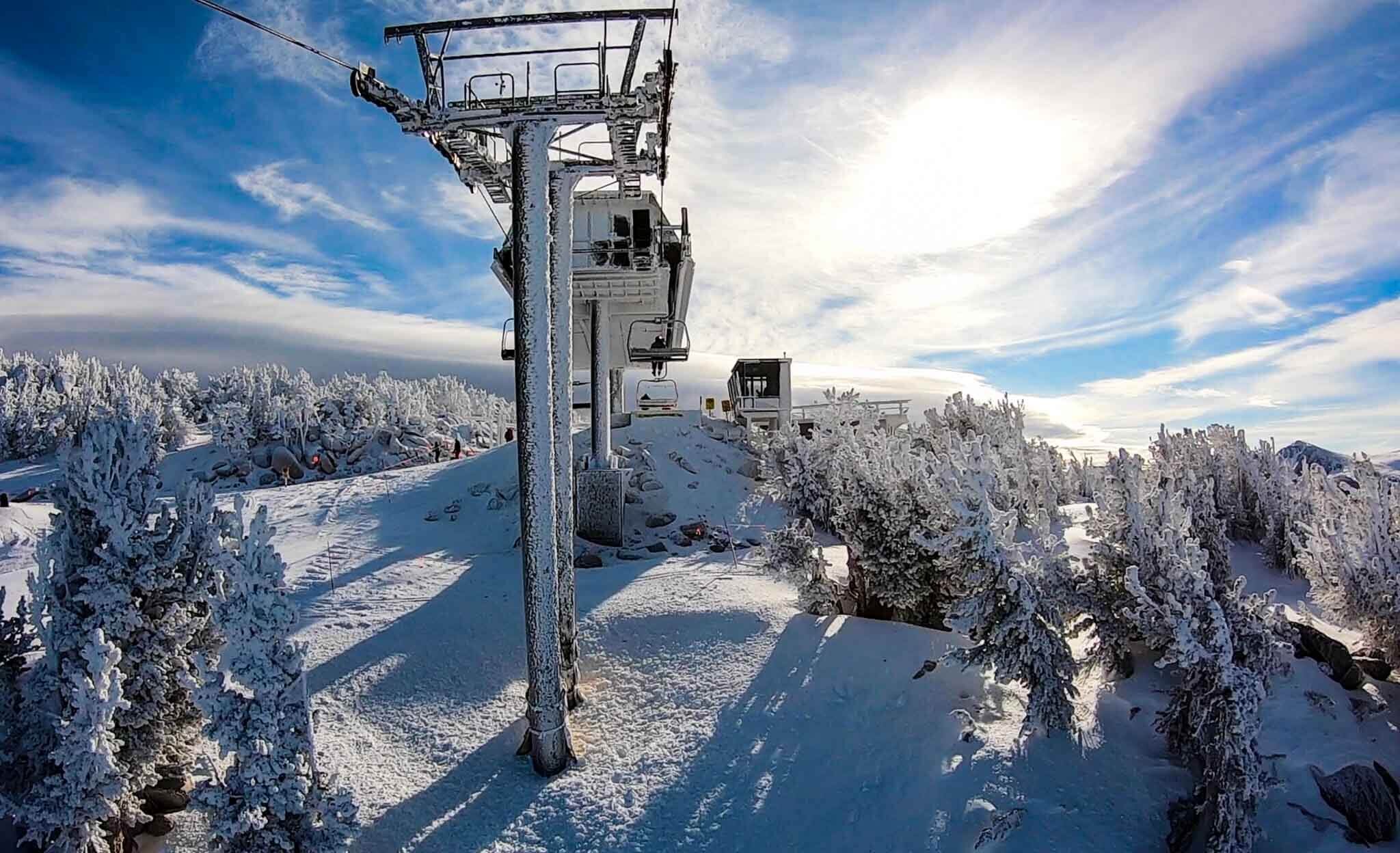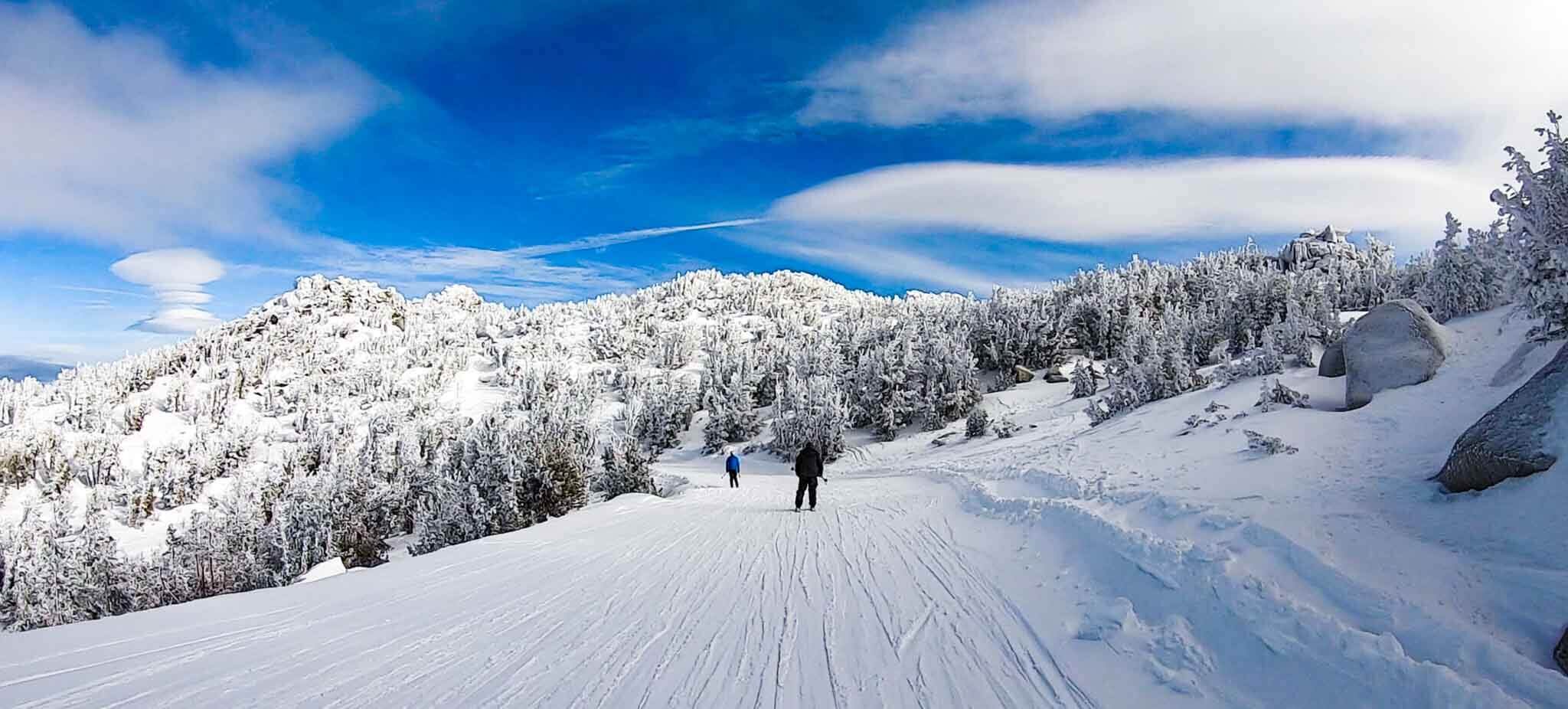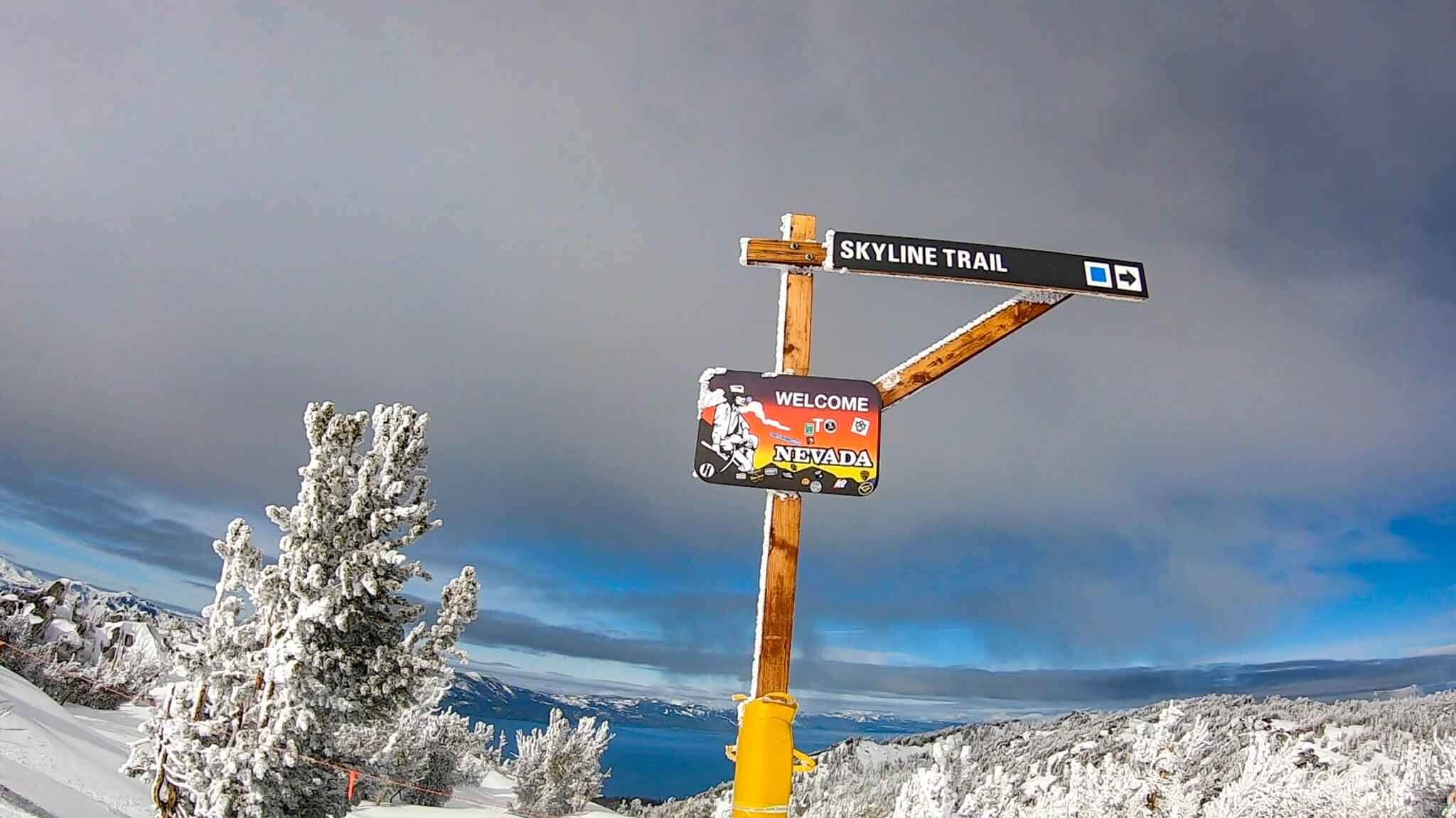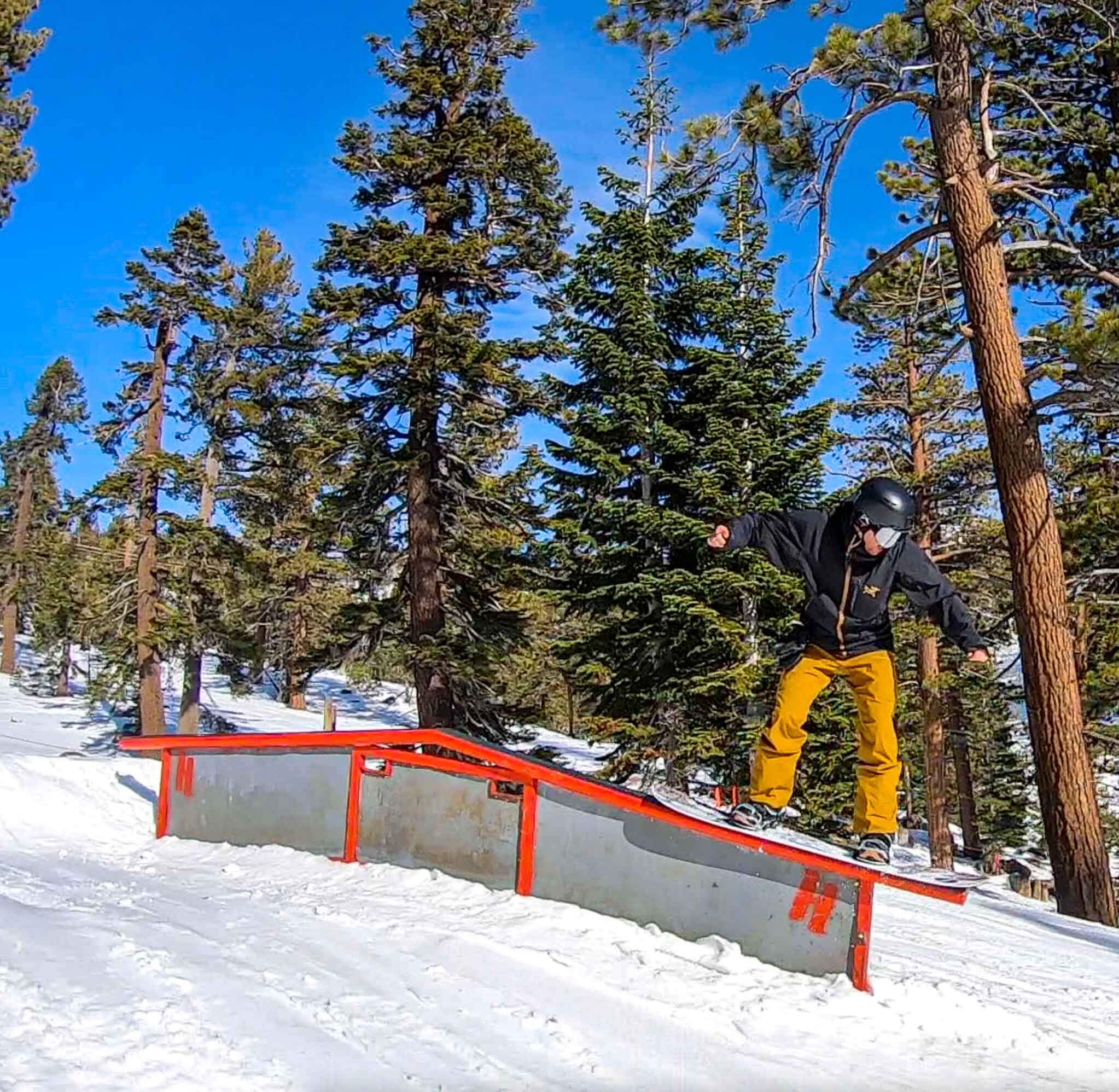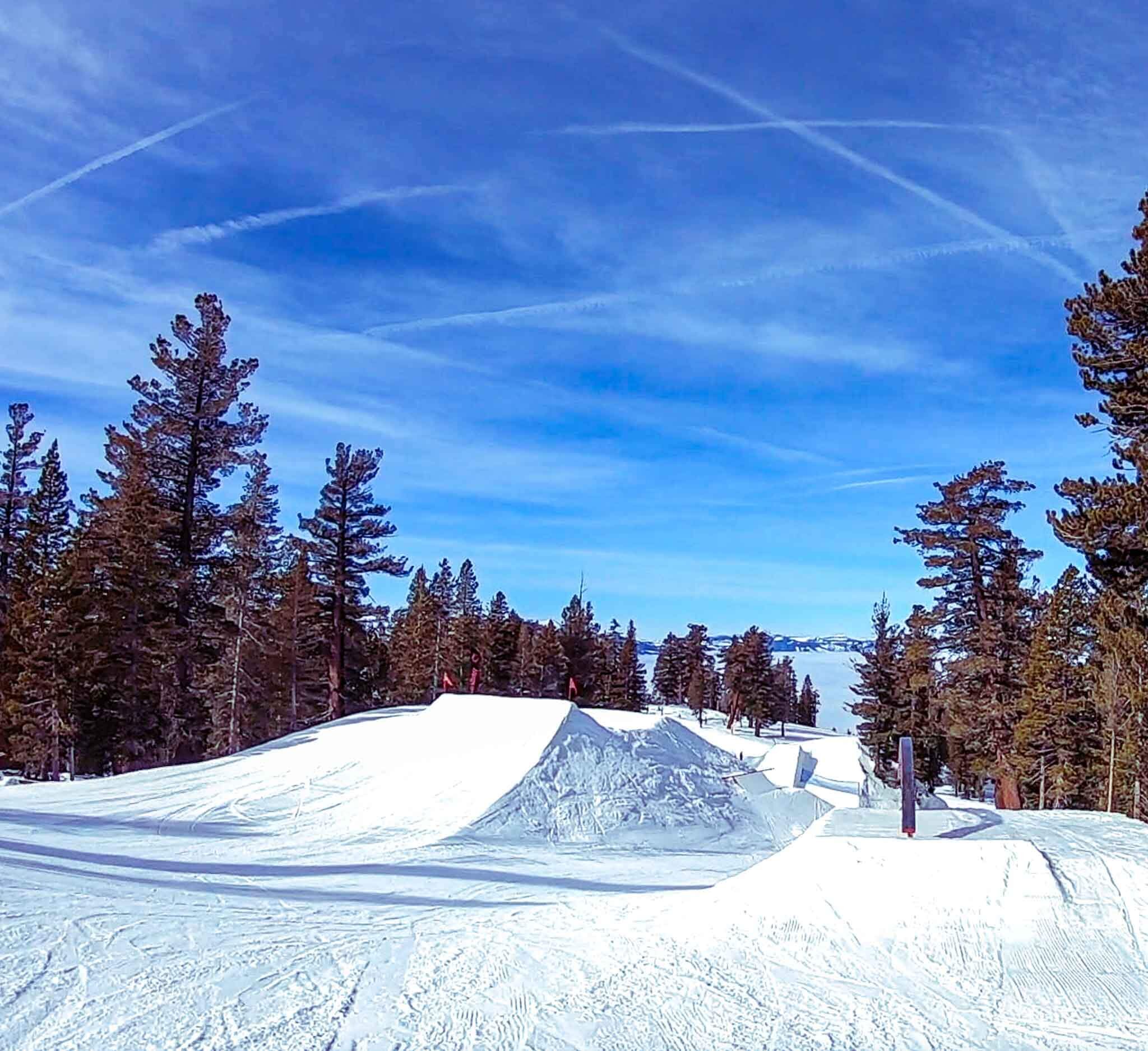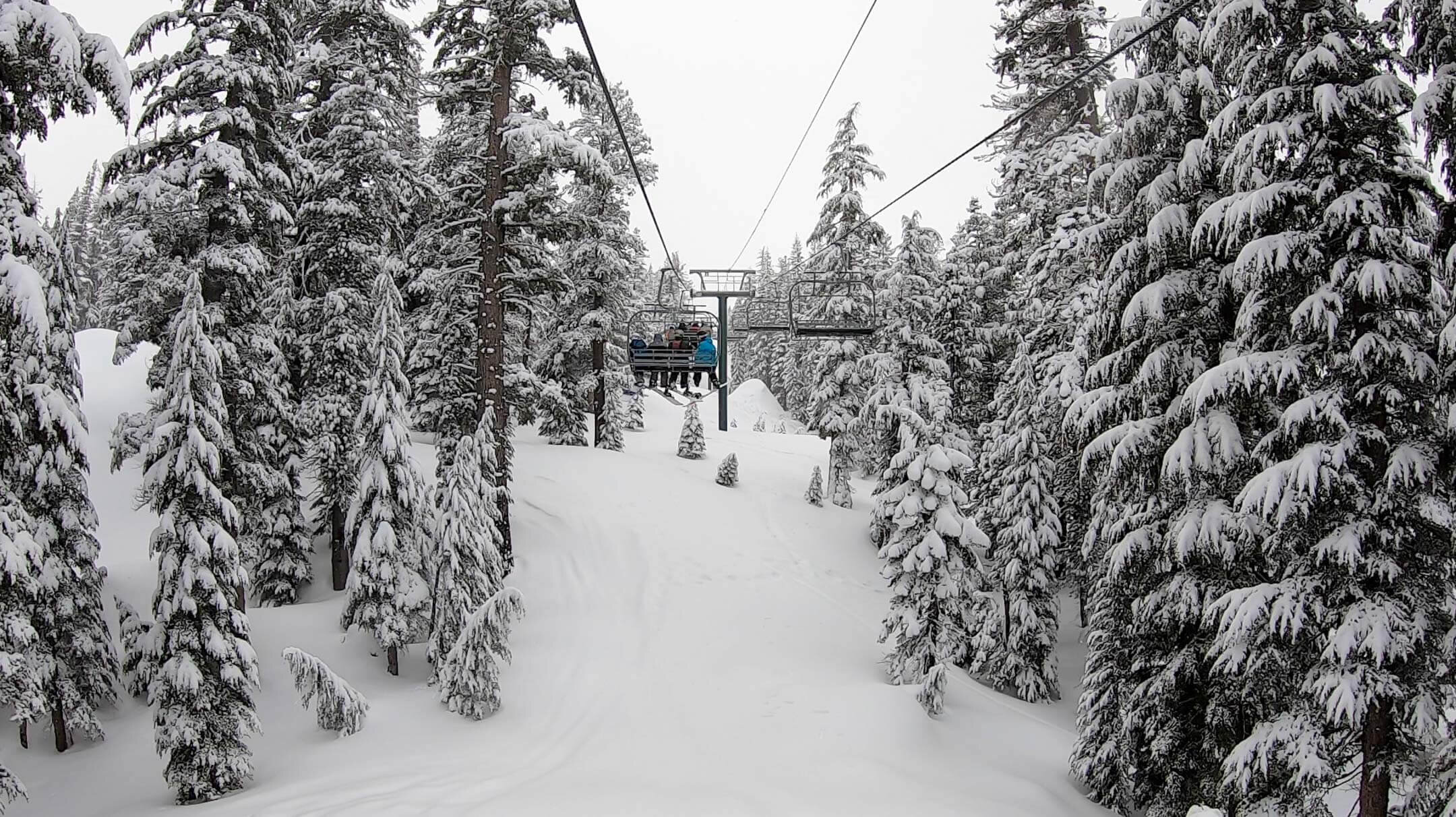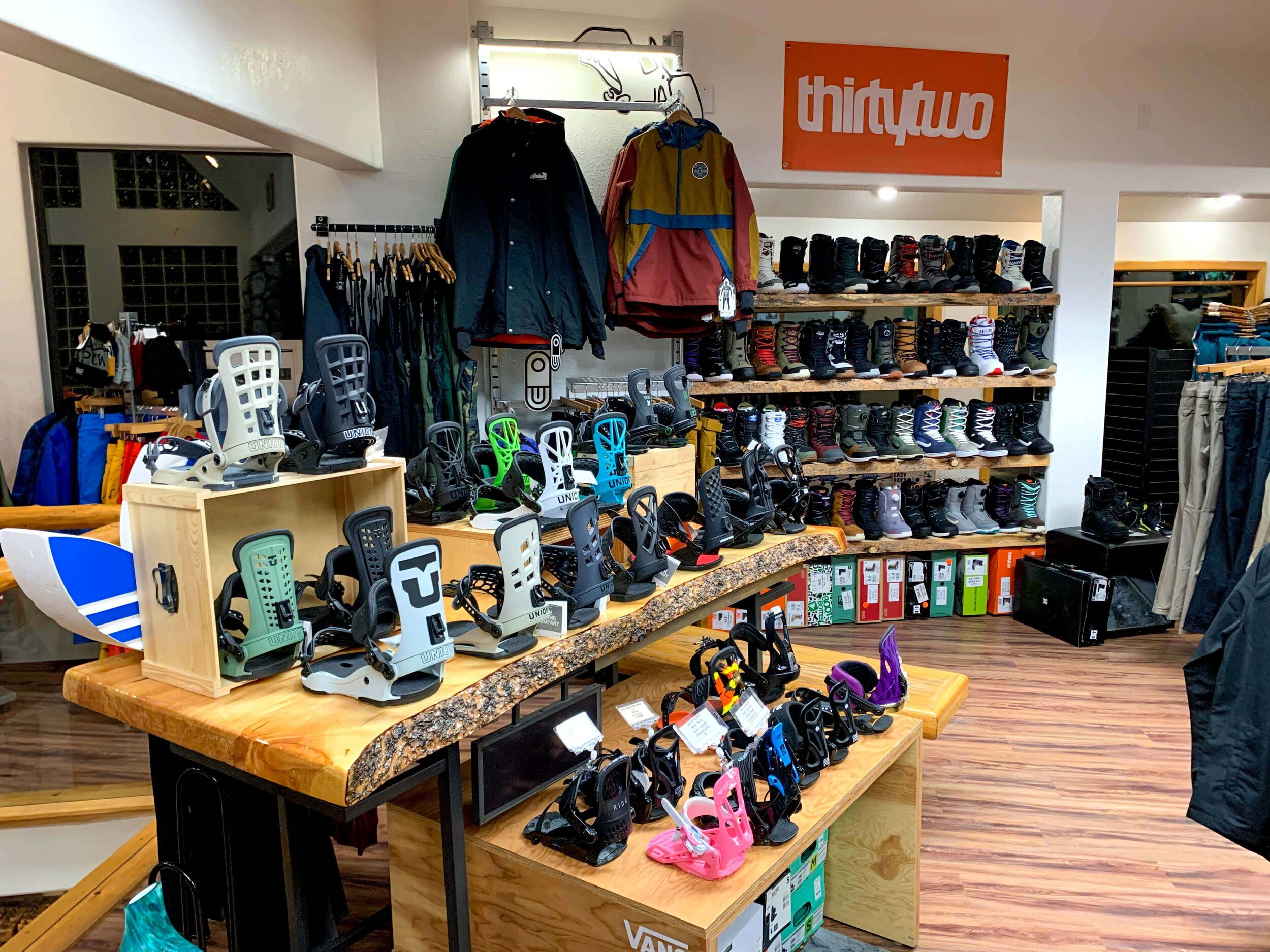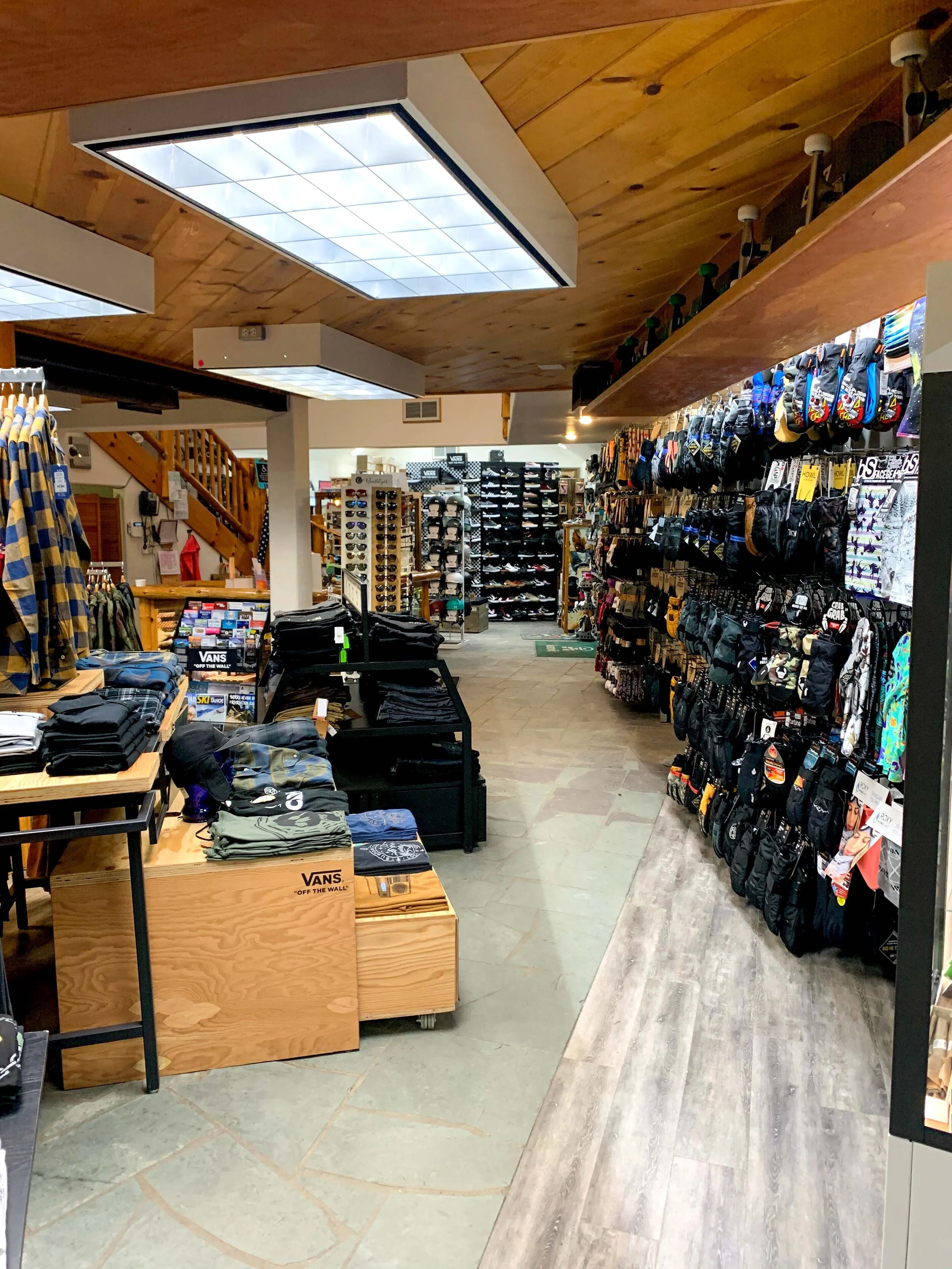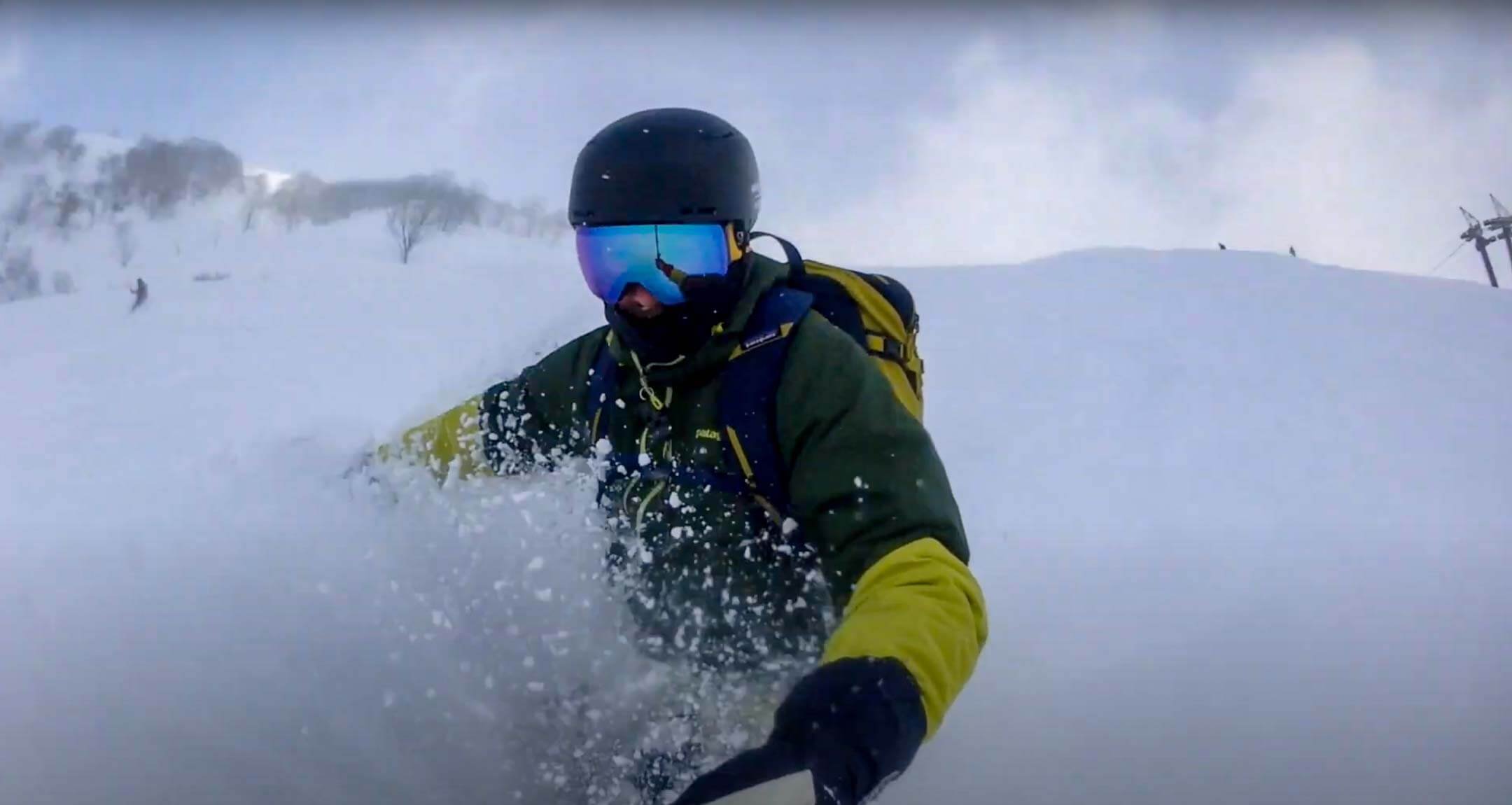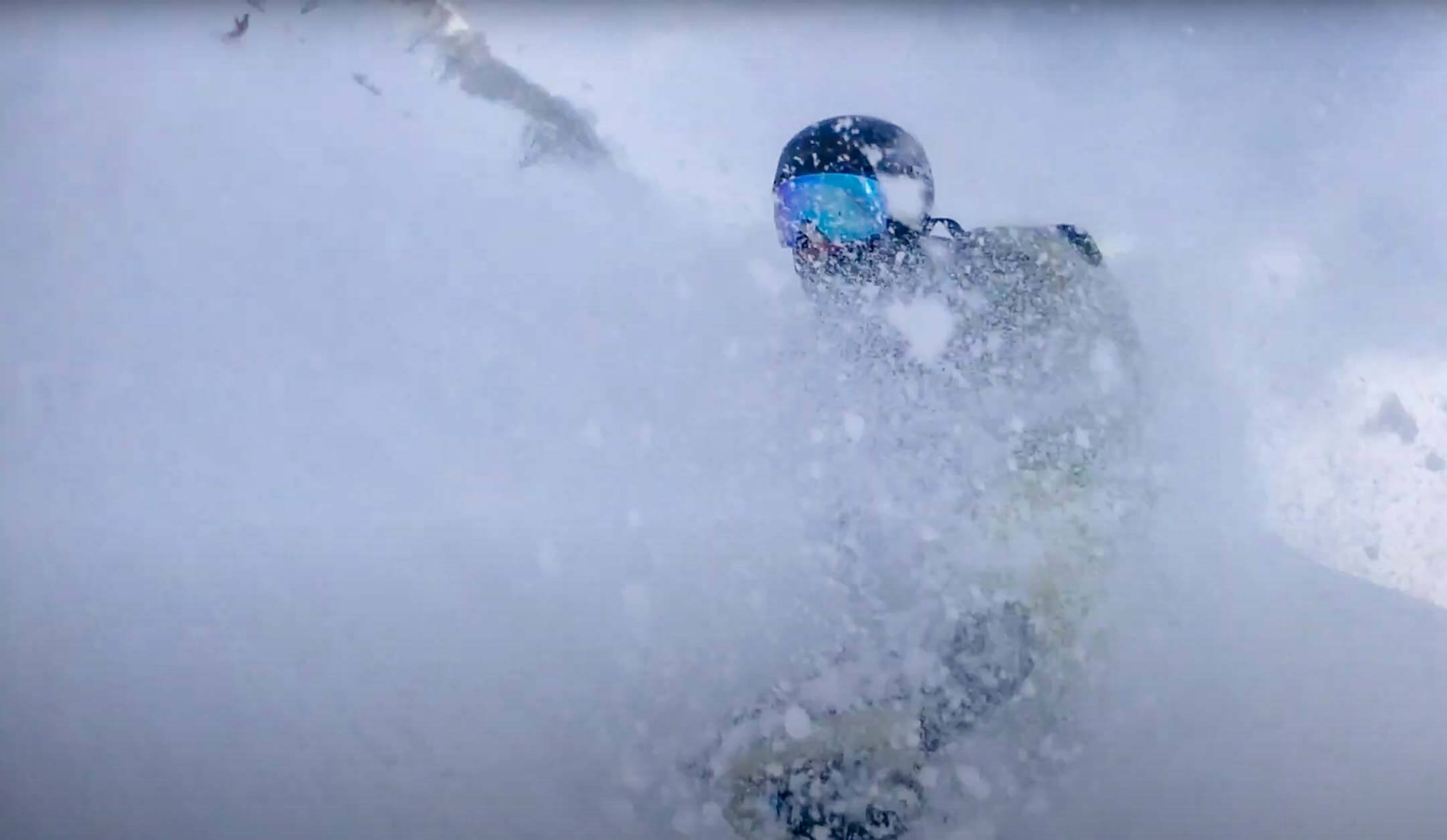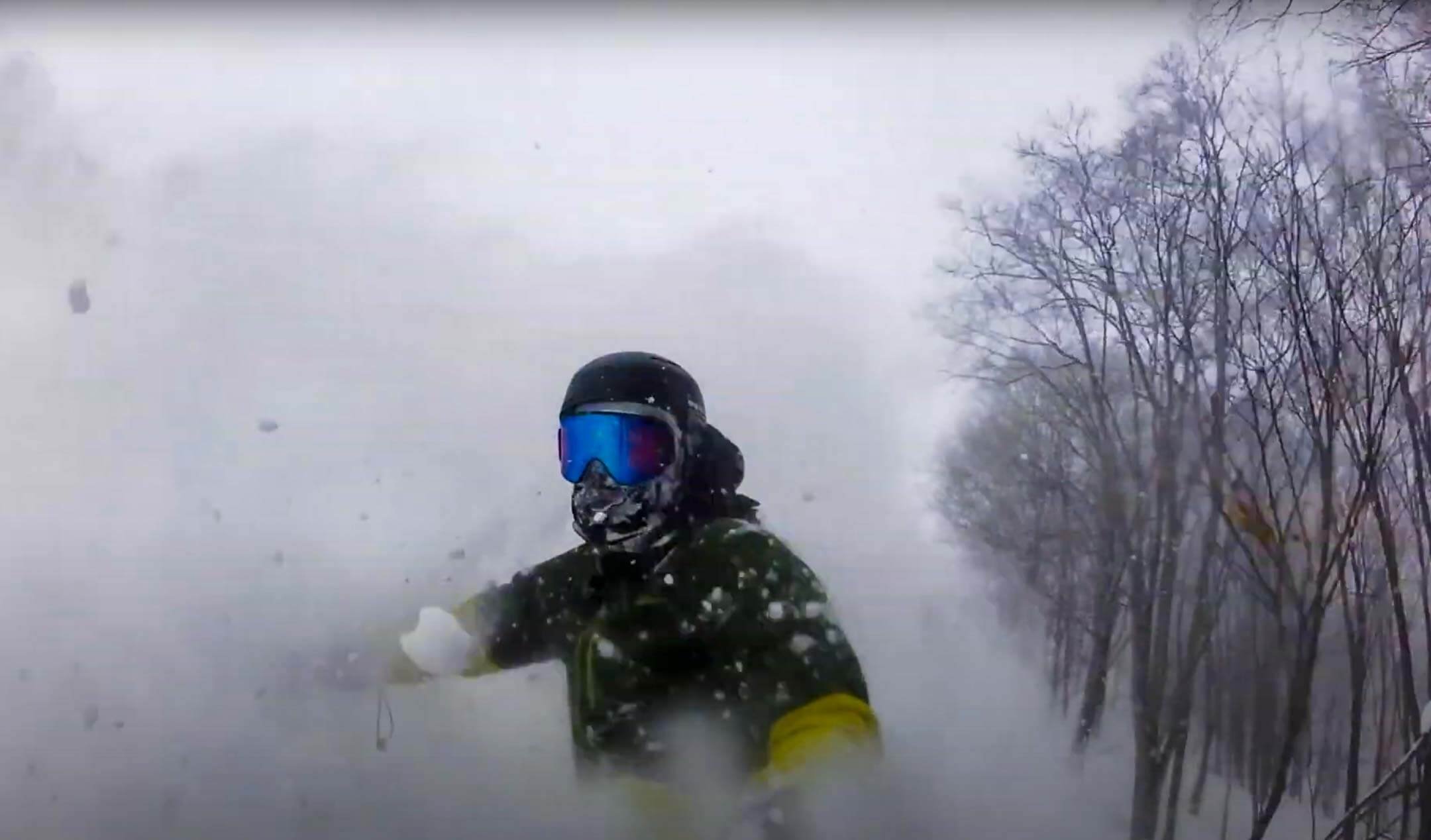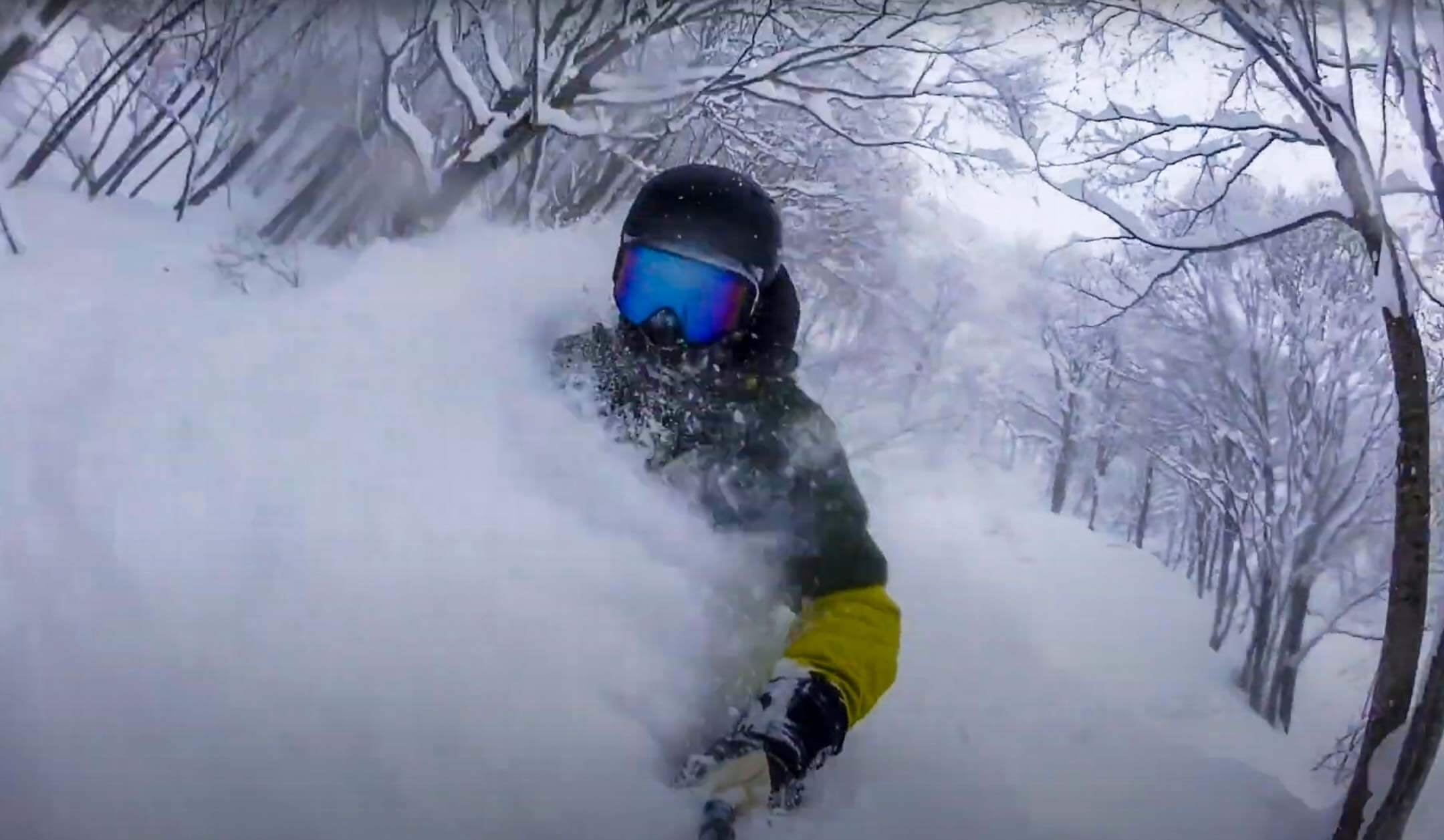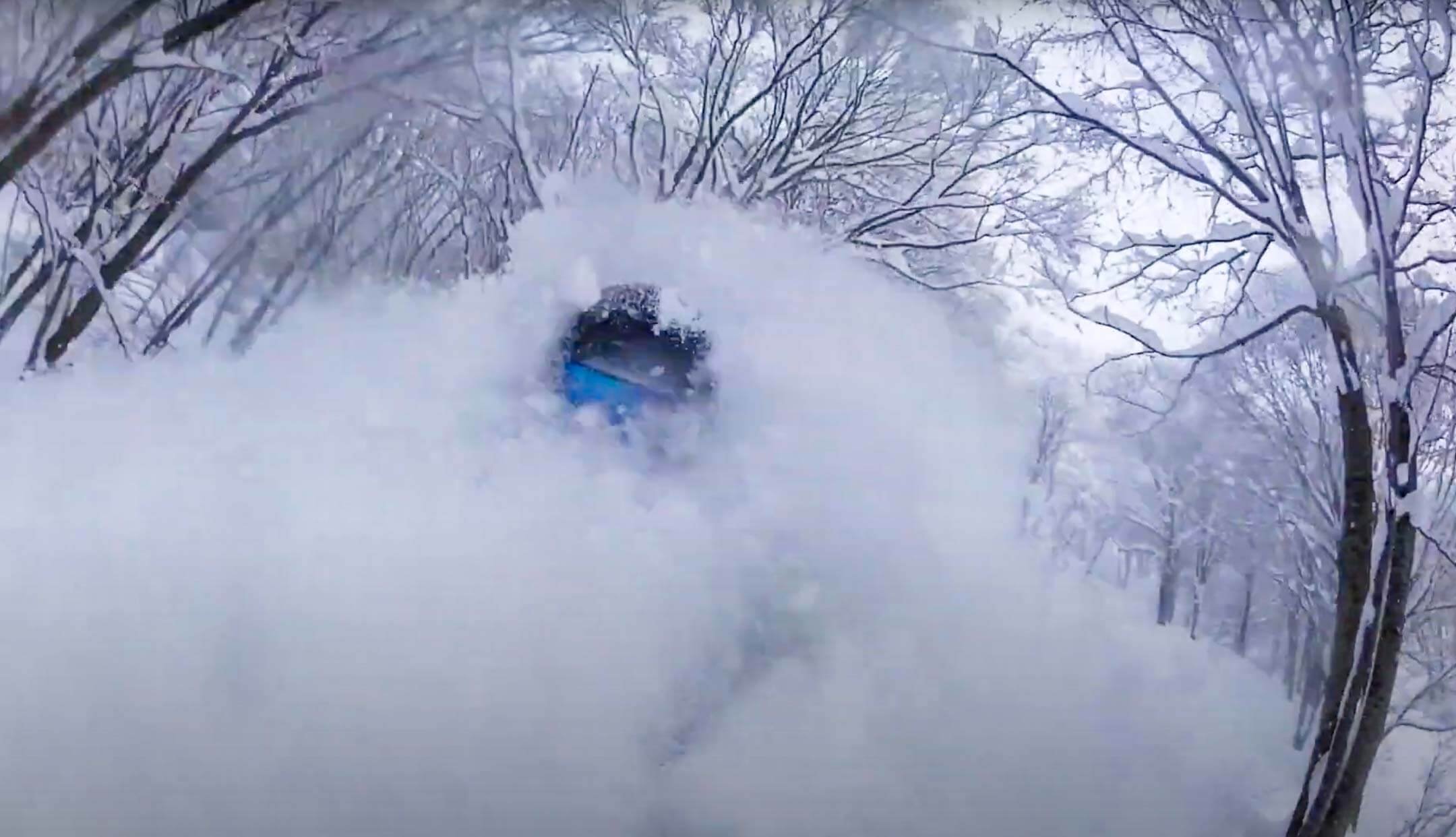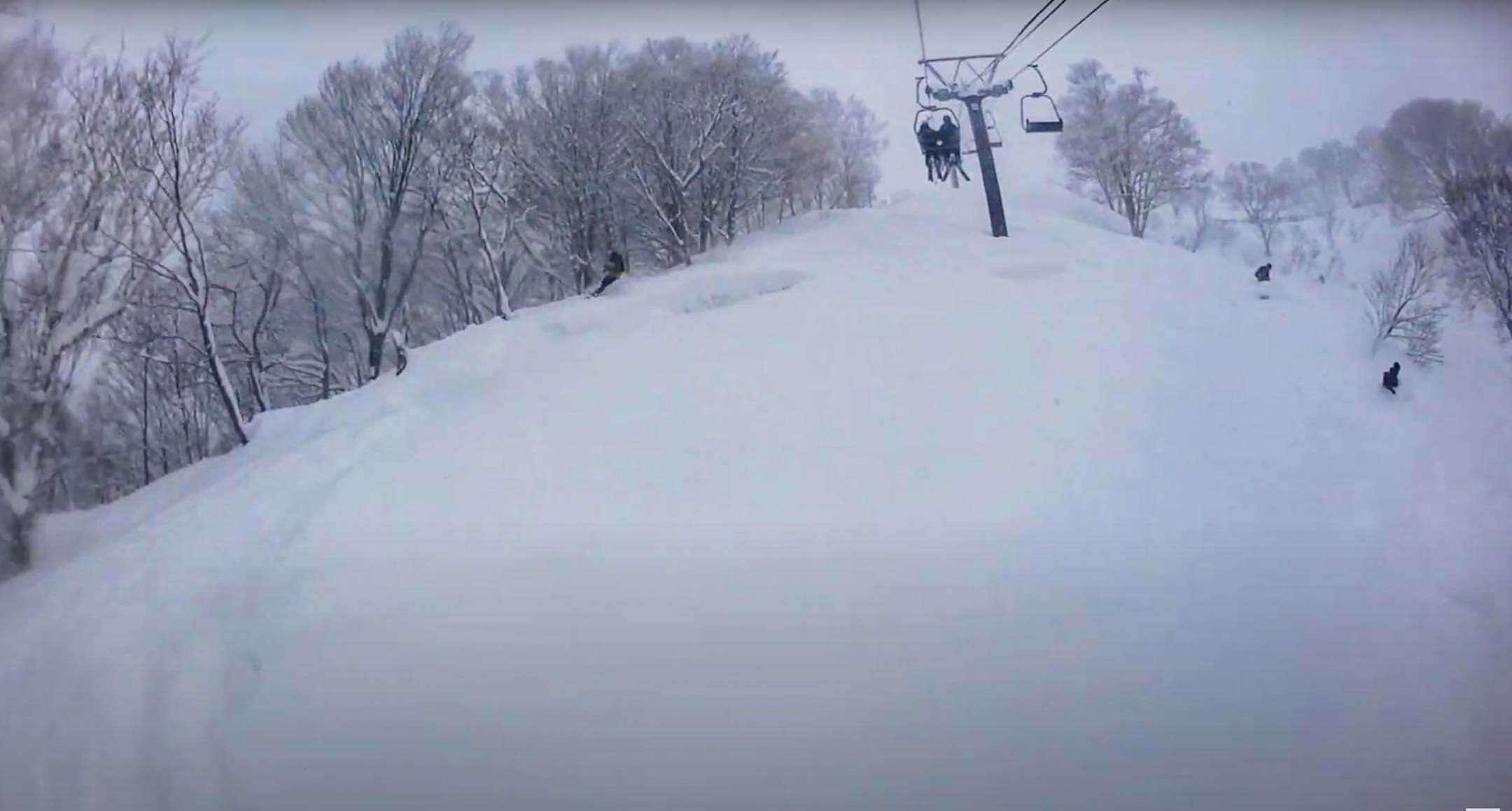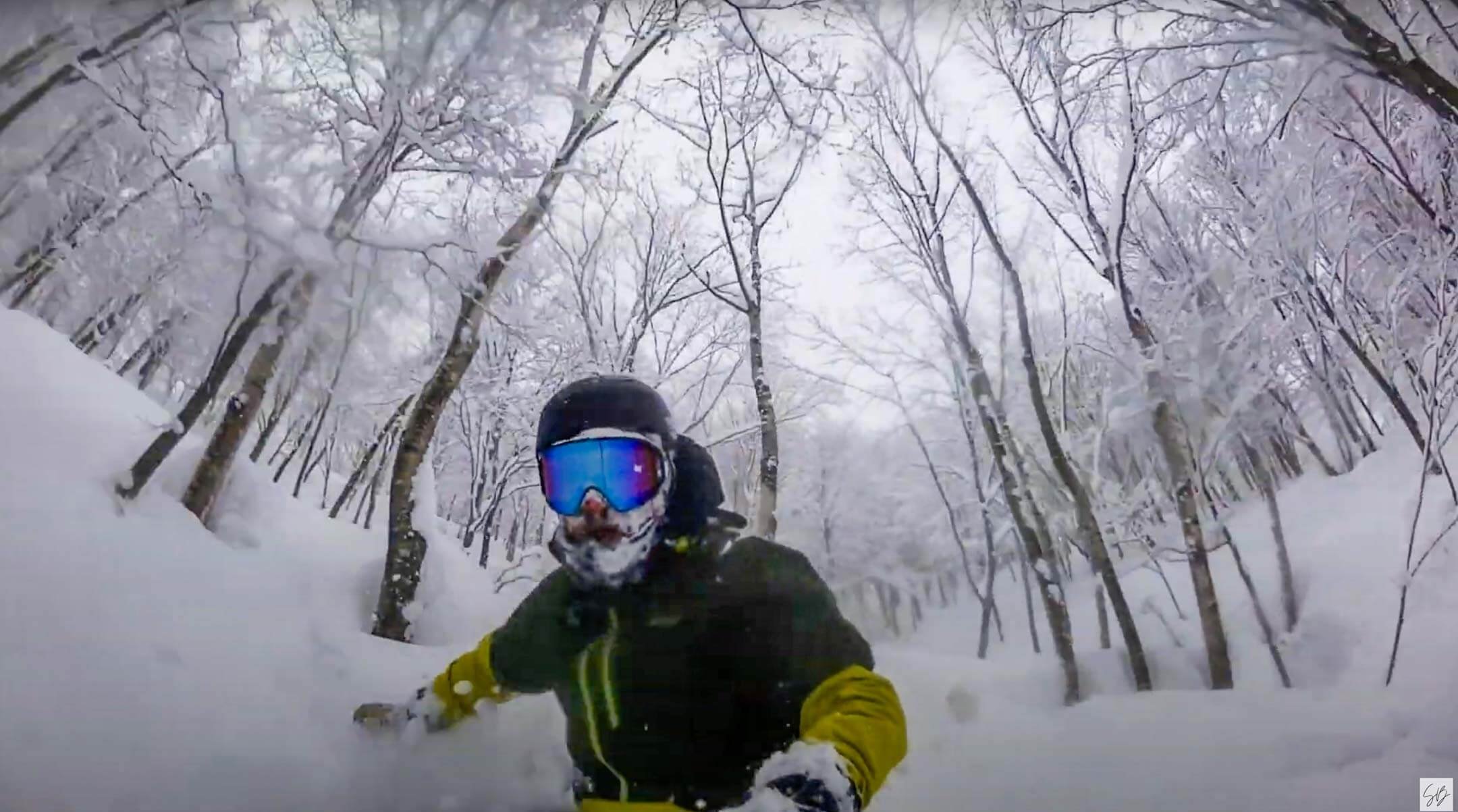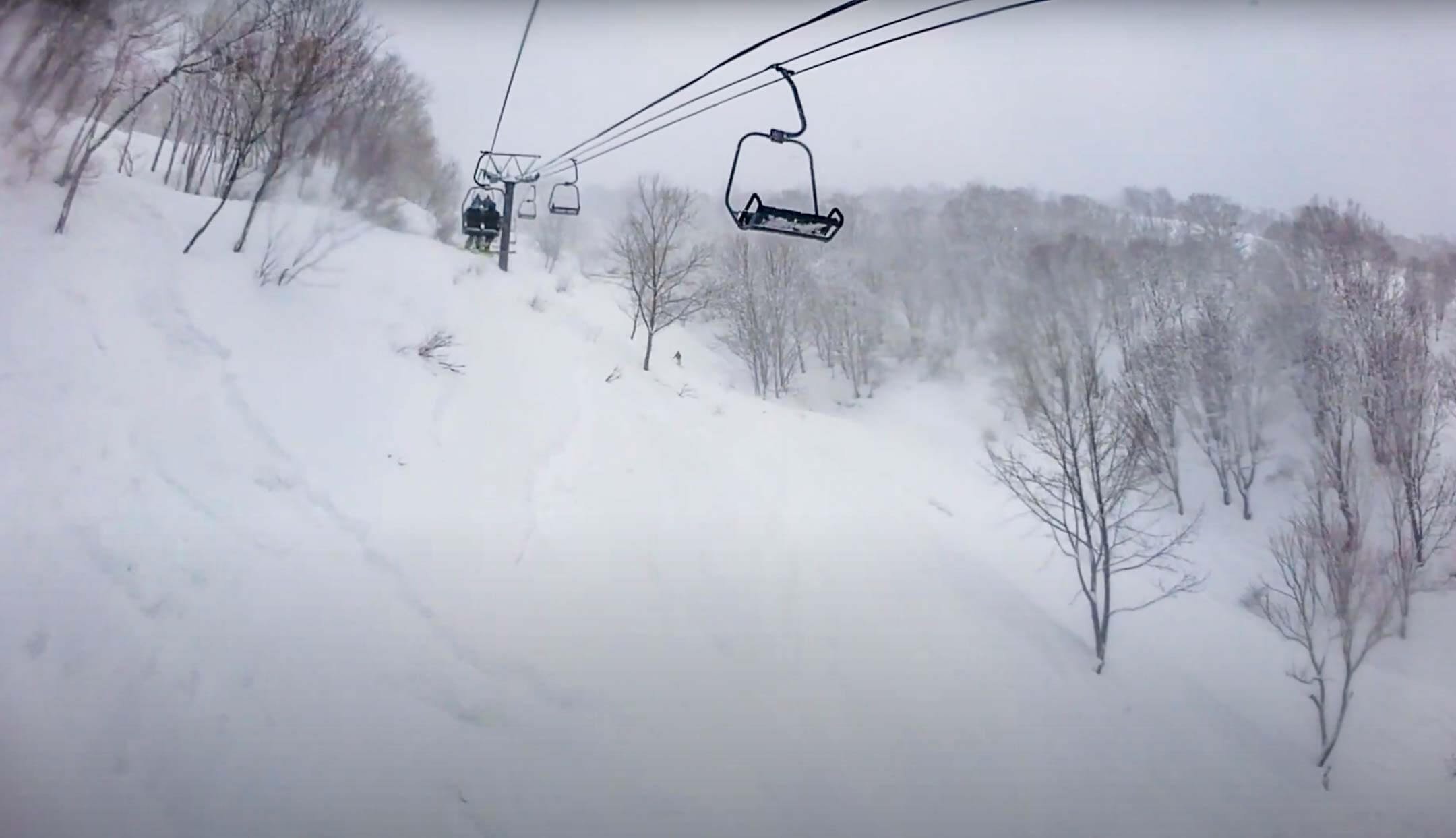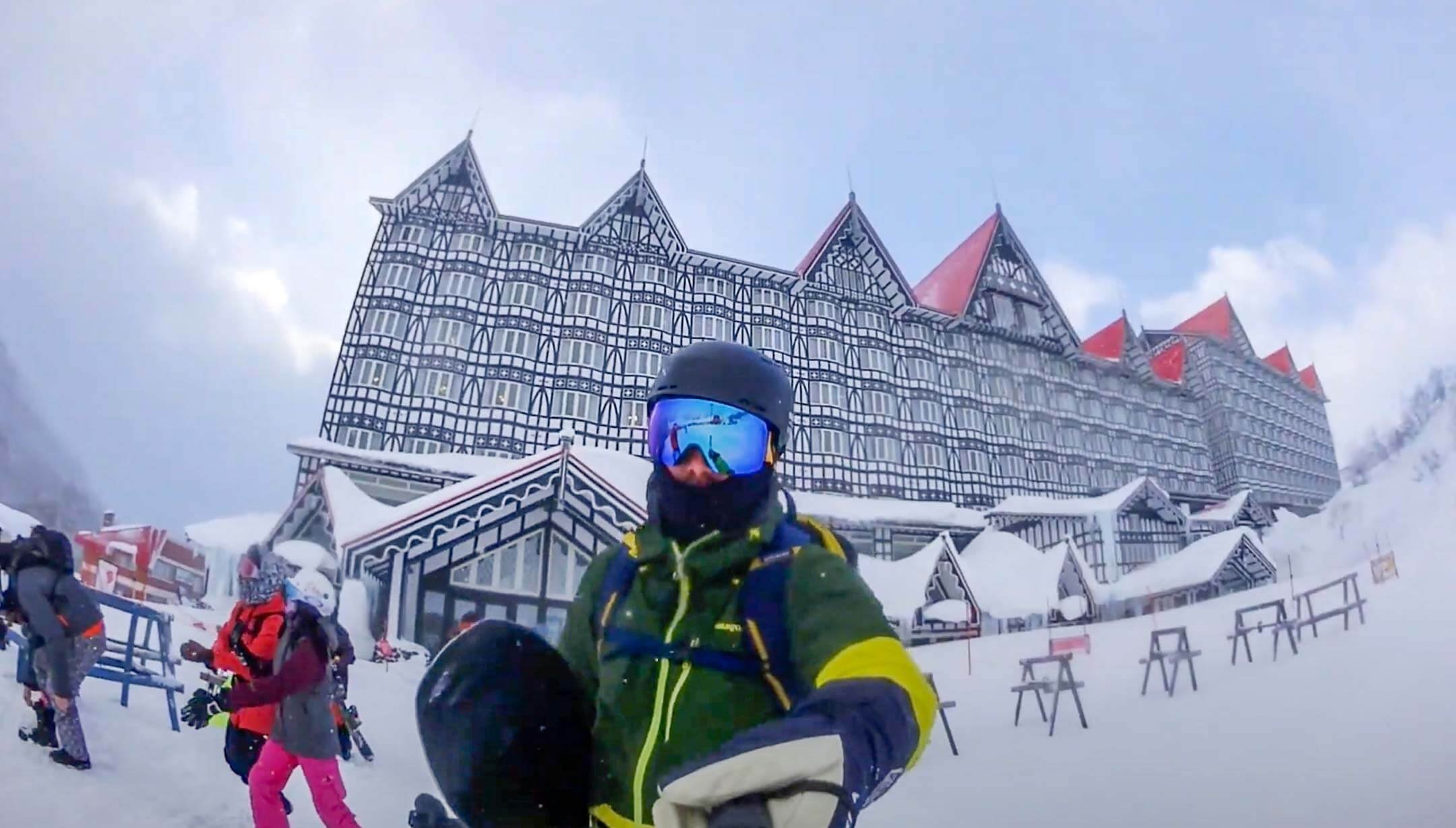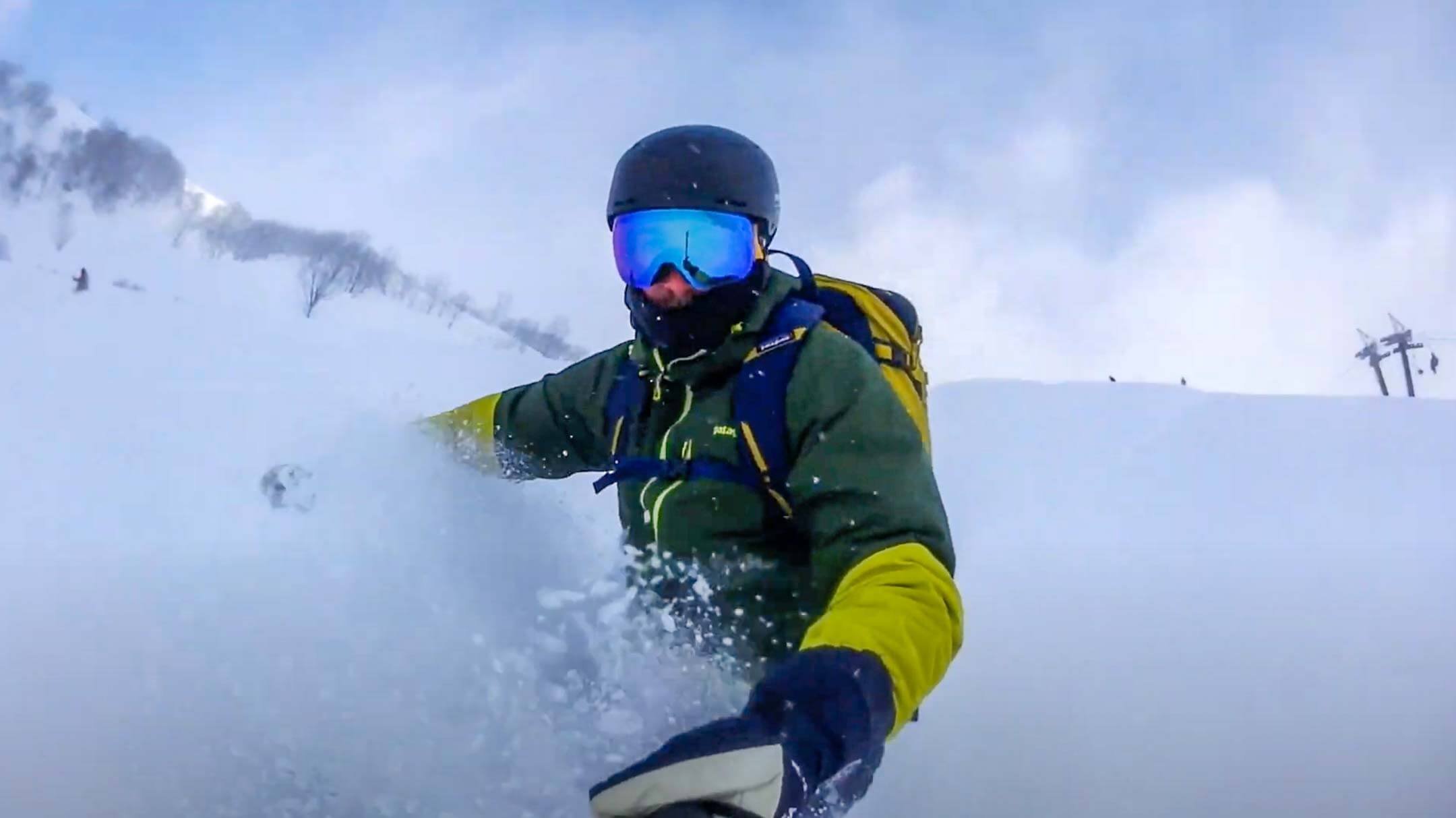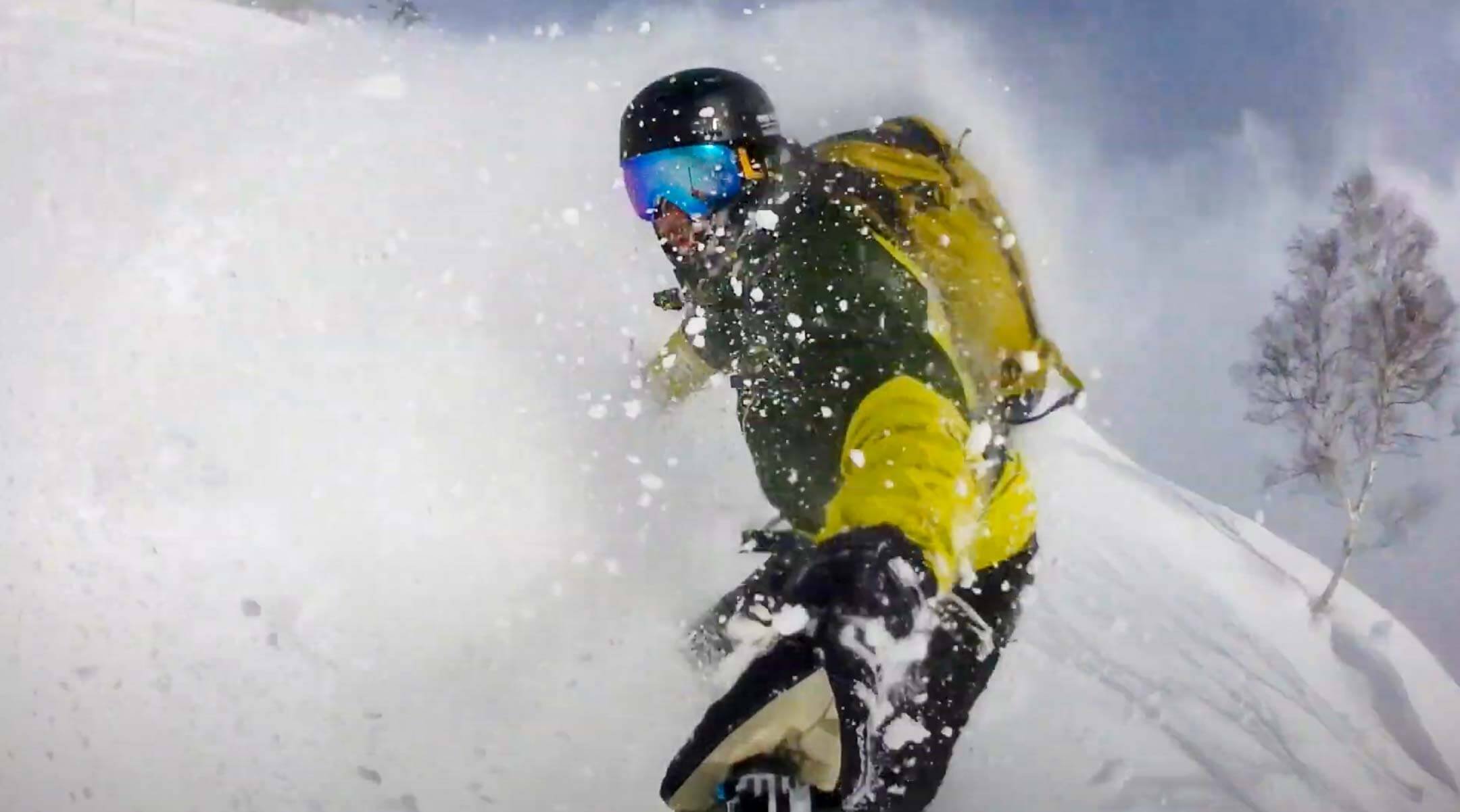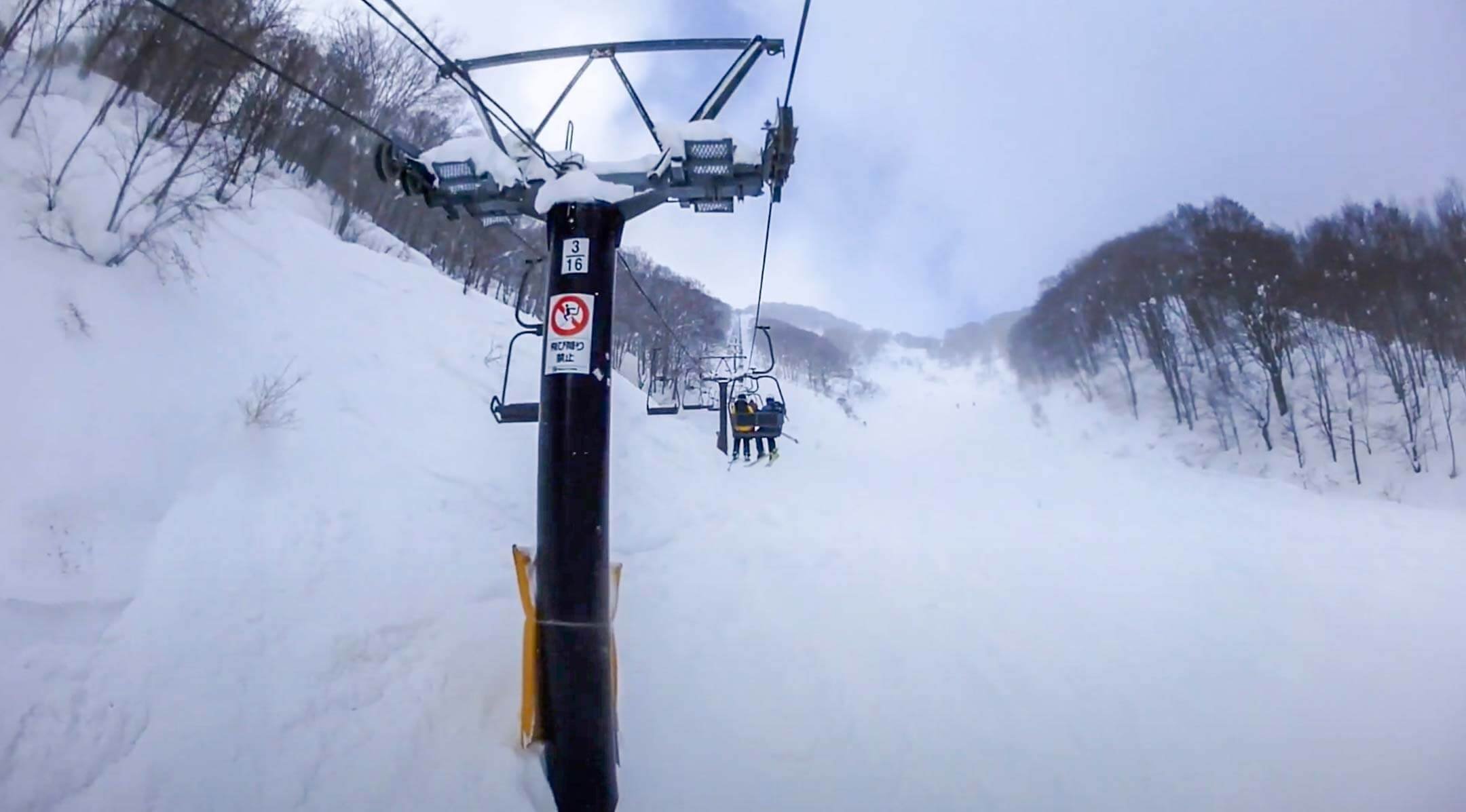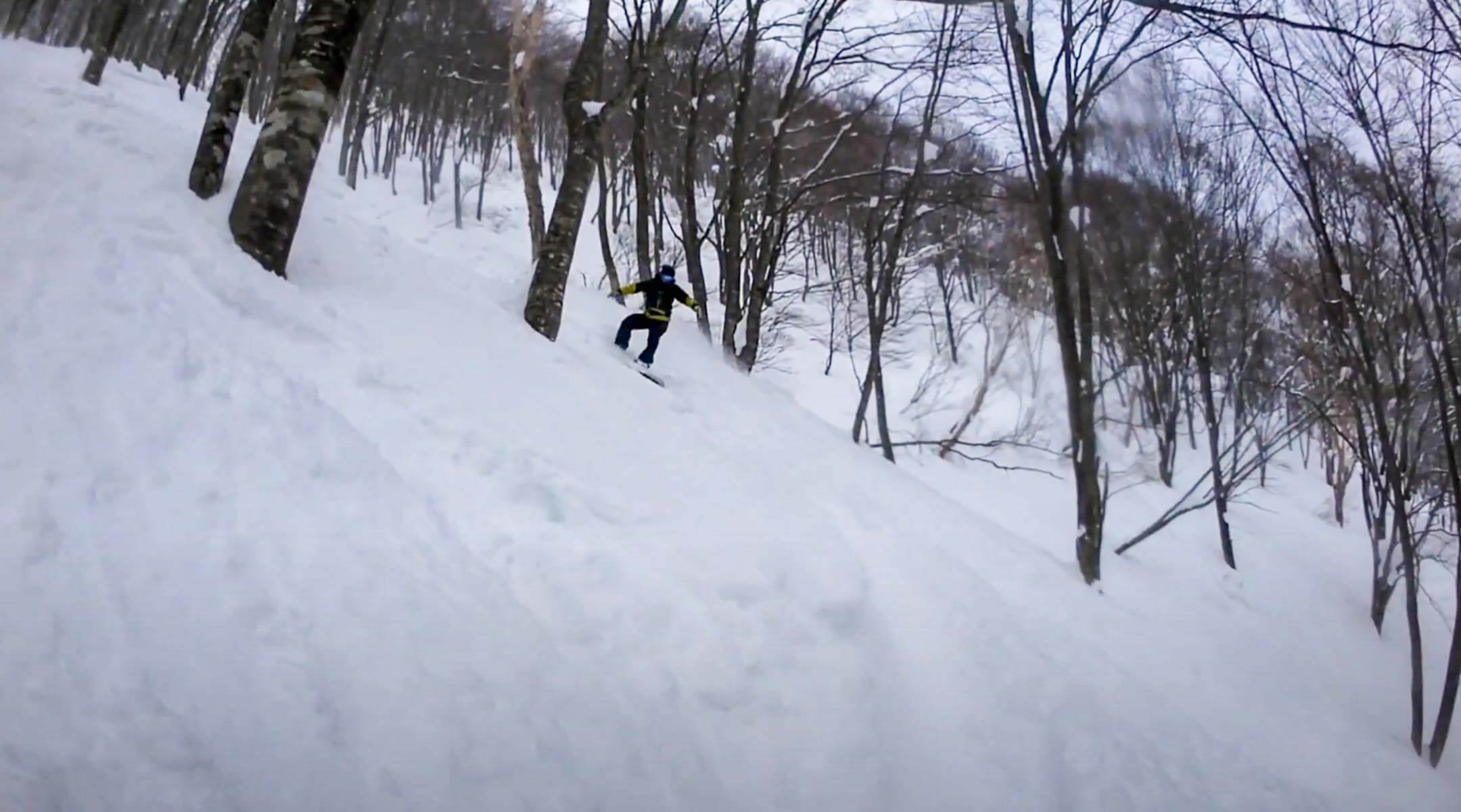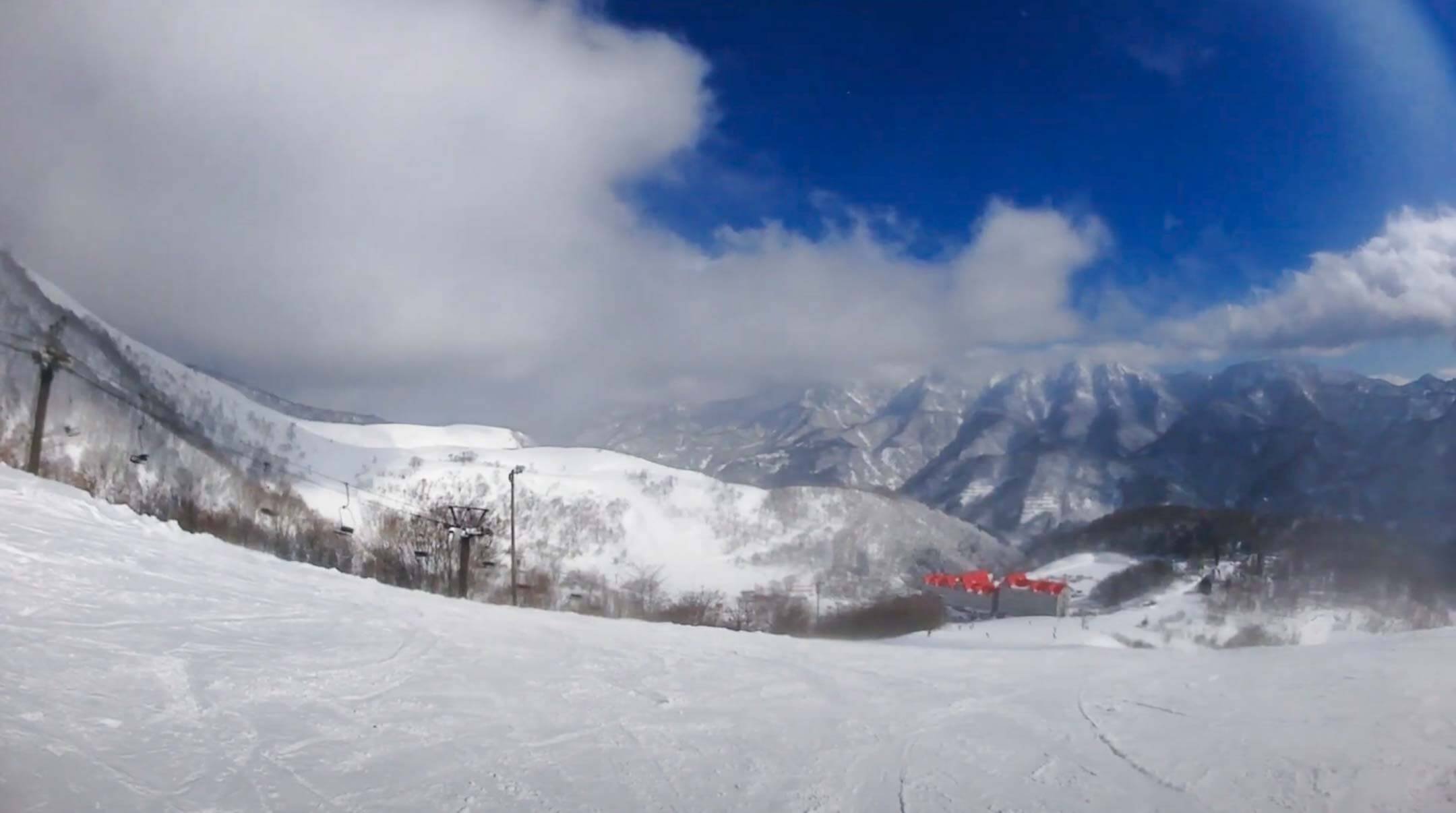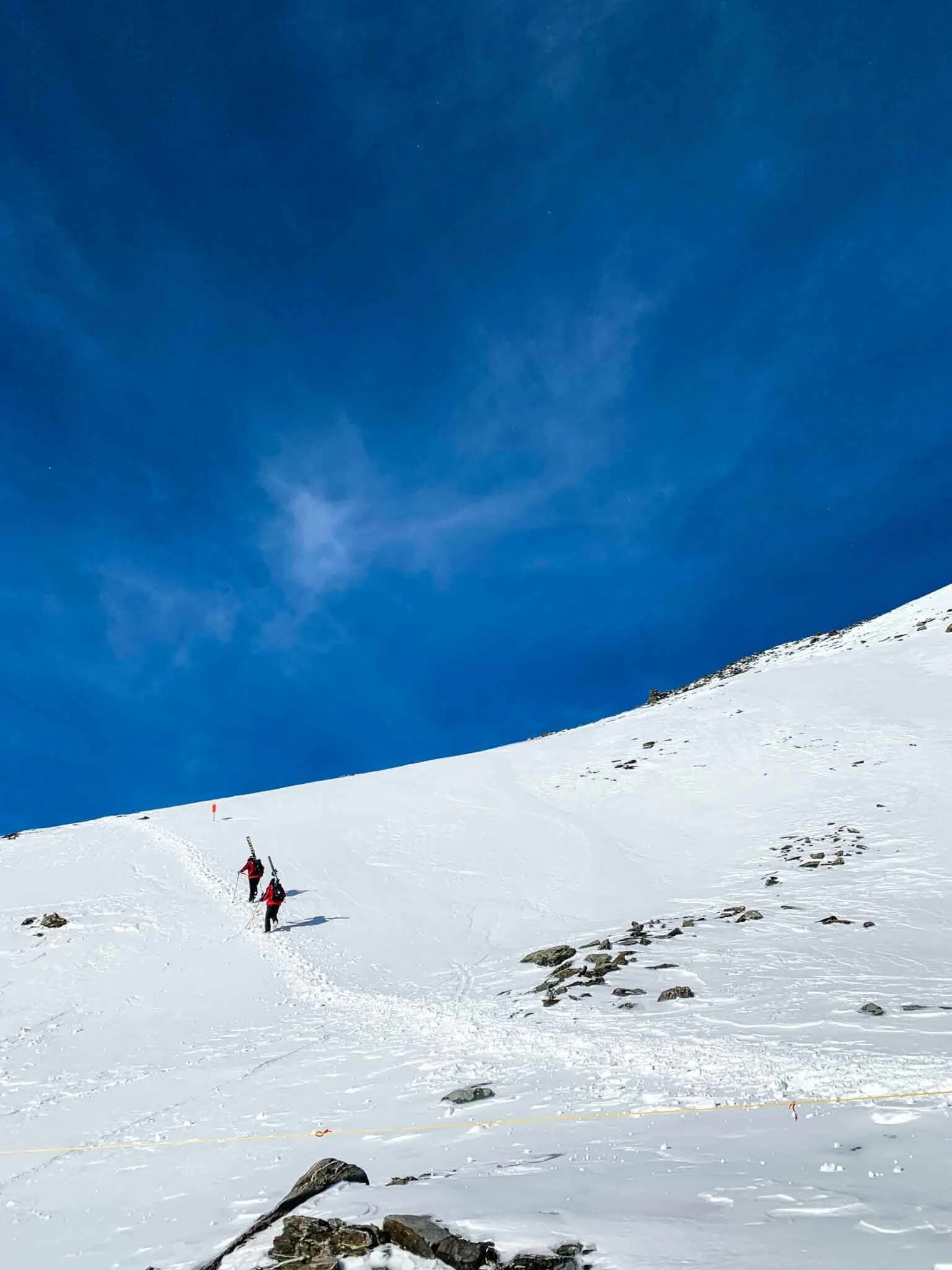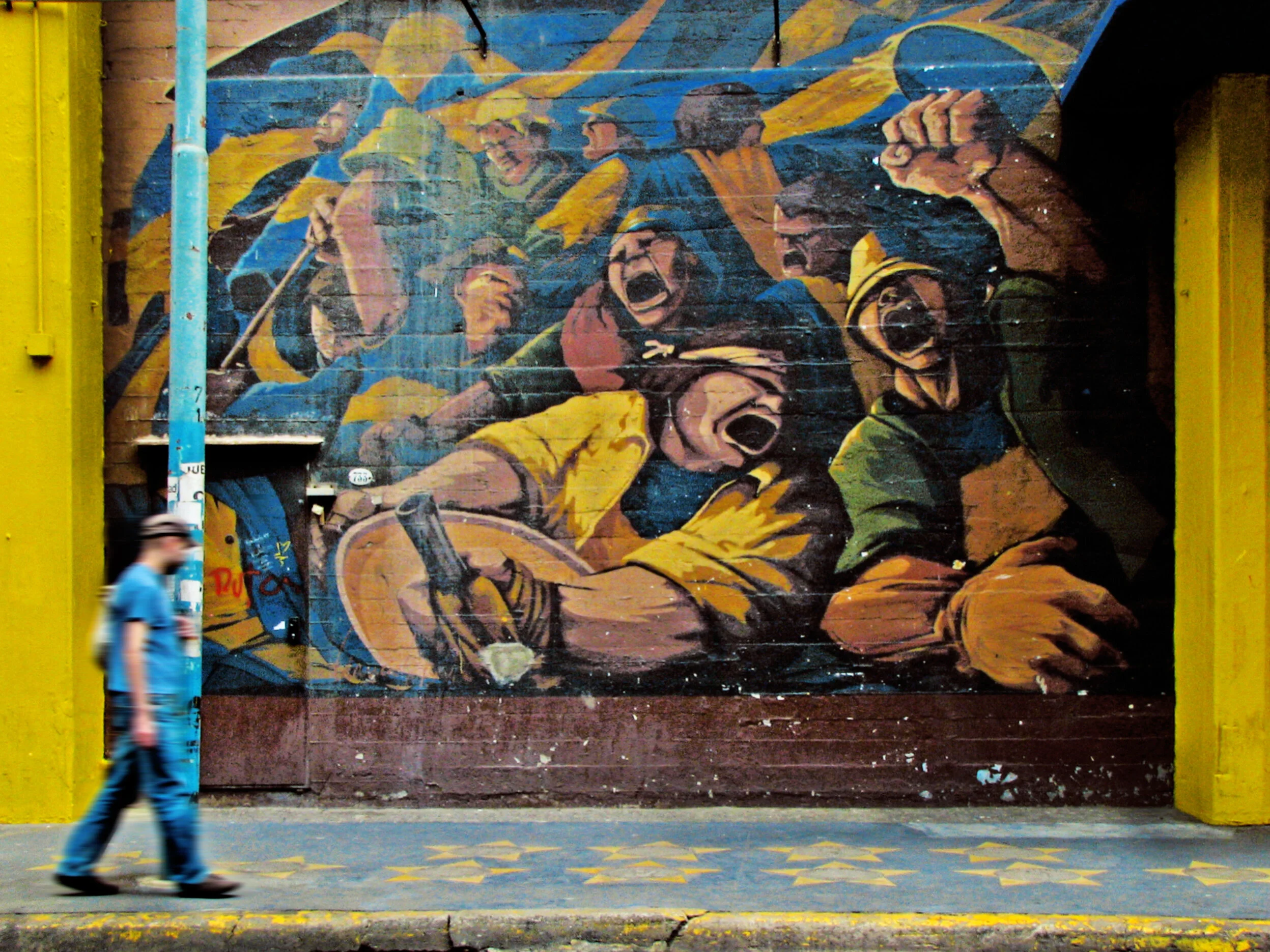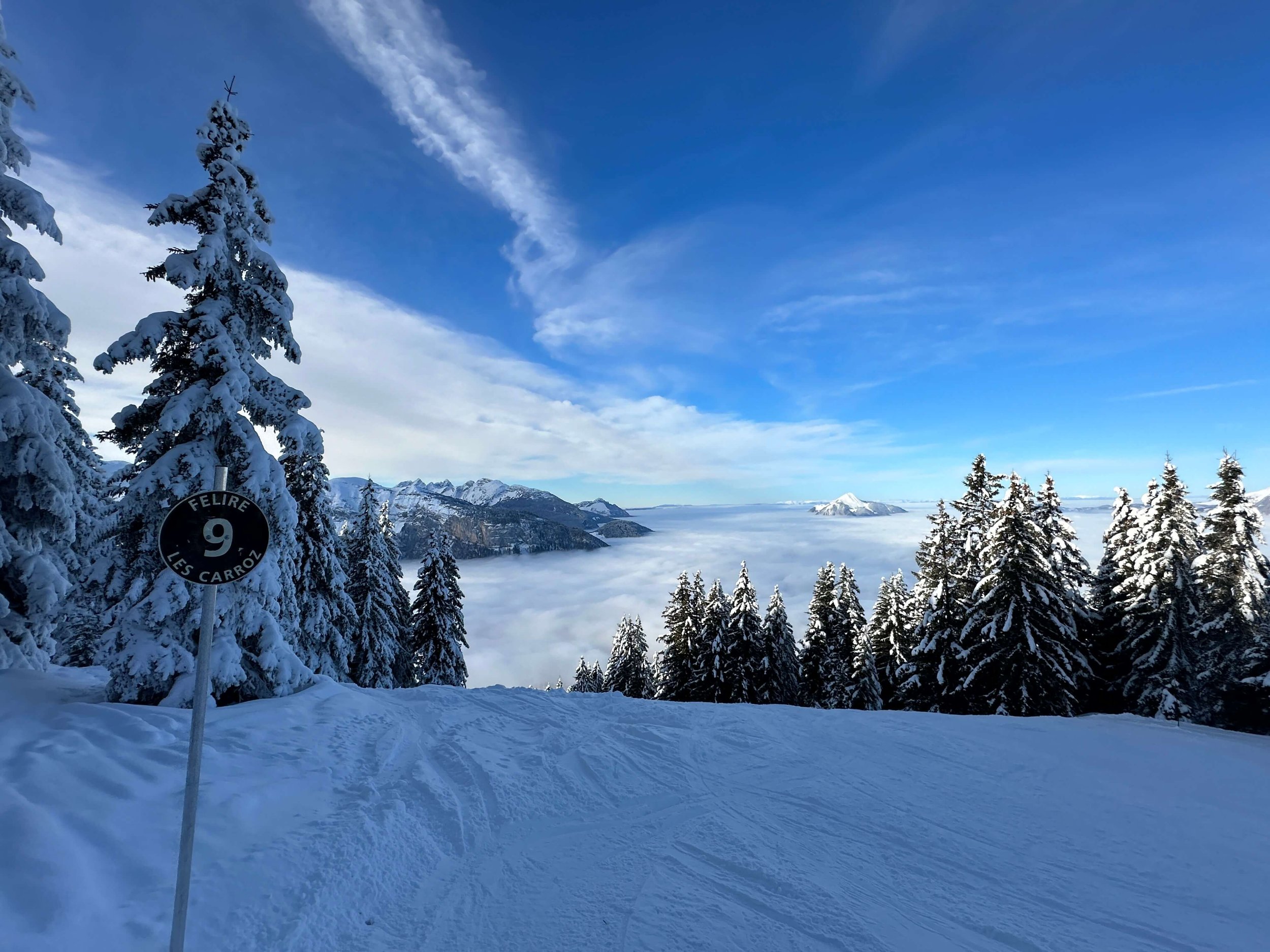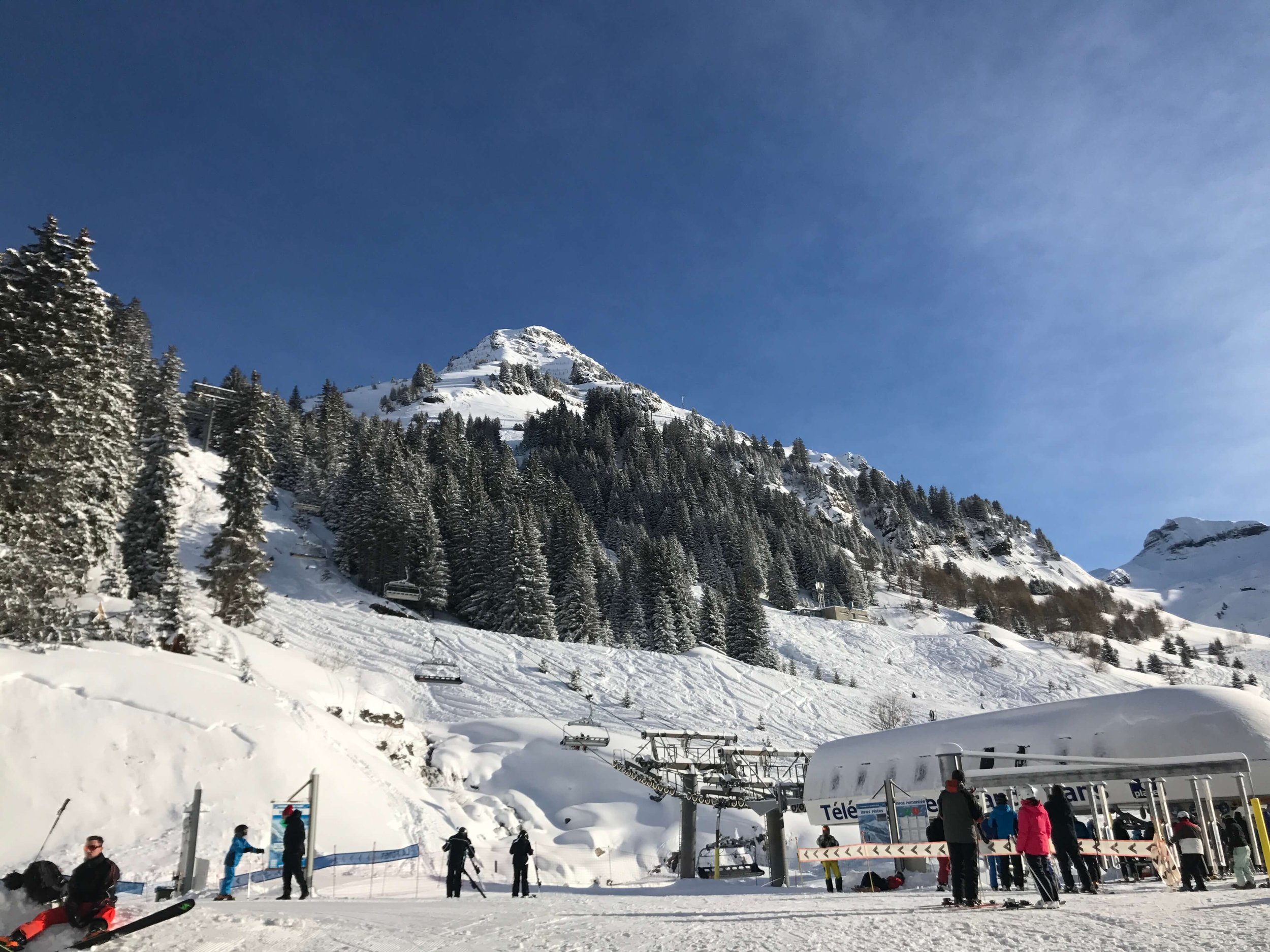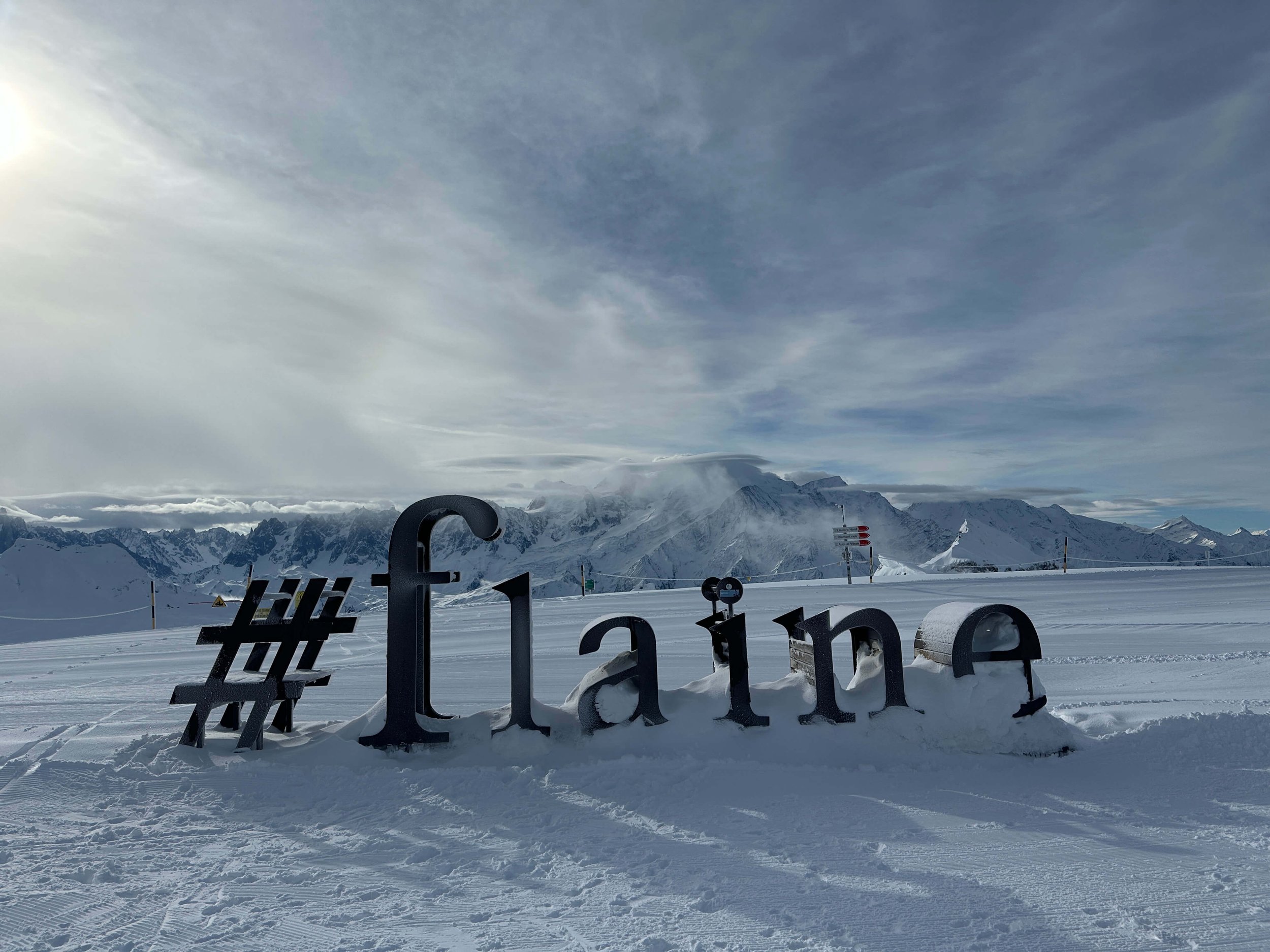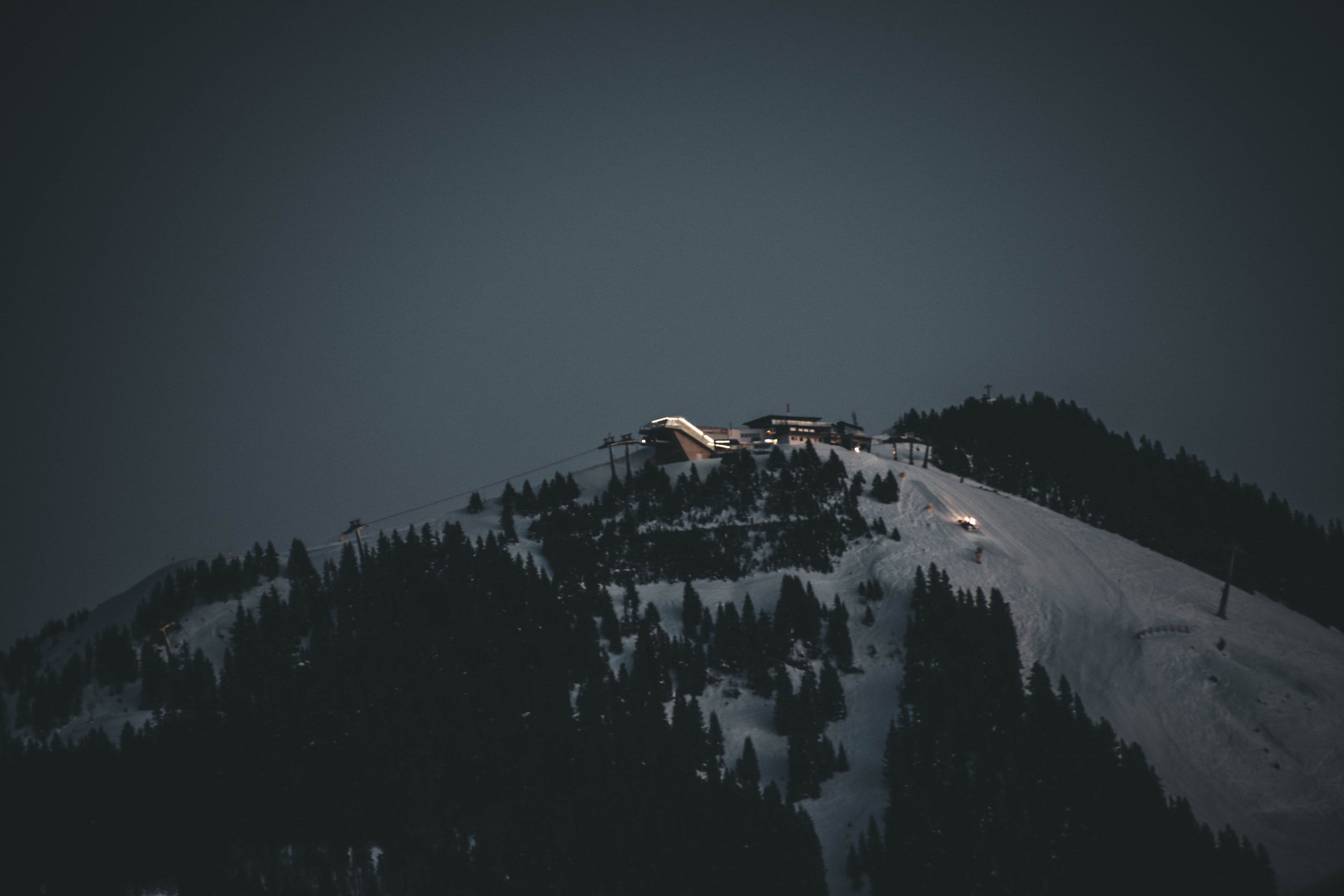OVRONNAZ SKI RESORT GUIDE
Ovronnaz ski resort, nestled in the Swiss Valais region, offers a distinctly authentic alpine experience away from the usual crowds found at the big name Swiss ski resorts. The village of Ovronnaz is known for its thermal baths and sunny terraces, but Ovronnaz ski resort is also worth the trip. The resort features mainly intermediate terrain however beginners and advanced skiers will also find pistes to suit suitable their ability. In total, 30km of empty slopes can be found with incredible views of the Swiss Alps. Unlike the larger, more commercialized resorts, Ovronnaz provides a peaceful change of pace, making it an great destination for skiers seeking quality snow, stunning views of the Rhone Valley, and a taste of traditional Swiss mountain hospitality.
OVRONNAZ FIRST IMPRESSIONS
I drove up to Ovronnaz from the valley and was immediately taken in by the beauty in this area. The village itself has a traditional charm however when arriving at the base area it was like there is nothing really there. The car park sits below the Jorasse chairlift and a lonely ticket office with no other real amenities. It is only once up the Jorasse chairlift where you see the resorts main restaurant and a small souvenir shop. This area is busy with skiers and snowboarders utilising the facilities and the beginners area. Once away from this area and around the resort there is a calmness to Ovronnaz.
OVRONNAZ SKI AREA
Ovronnaz ski area offers around 30km of mostly intermediate pistes, set against the stunning backdrop of the Valais Alps. With a vertical drop of approximately 1100m, the resort provides the opportunity to combine some pretty awesome pistes for a long run top to bottom. If you do not believe me check this video here. Ovronnaz is a particular favourite amongst the Magic Pass crowd for after a storm so if you hit it at the right time you could find yourself enjoying some incredible powder laps.
Intermediate skiers and snowboarders will love Ovronnaz for the abundance of beautiful groomed pistes which when avoiding weekend crowds are suitably quiet. Ovronnaz has enough to keep the able intermediate happy. Beginners have less to occupy them, although there is a beginners area near the Jorasse top station. This small learners area has its own drag lift and is an ok spot to learn your first turns. Away from the beginners area, a couple of gentle blues near the Petit Pré chair can keep advancing beginners entertained. Advanced terrain is limited however there are a couple of black routes in Ovronnaz. The real challenge for the more able skiers and snowboarders can be found in the freeride posibilities within the area.
WATCH THE FULL REVIEW
LIFTS AT OVRONNAZ
In Ovronnaz the lifts are not going to break any speed records, especially the Jorasse chairlift from the base area, however they do suitably handle the demands of the ski resort. The 4 chairlifts in Ovronnaz, include the new Petit Pré chairlift, which has been installed to replace an old draglift and improve the visitor experience. The lifts in Ovronnaz are fine, and during the week when it is quiet you wont be longing for bigger faster lifts. In addition to the four chairlifts, the Tsantonnaire drag lift accesses Ovronnaz highest lift accessible point at 2427m. The Tsantonnaire is an experience not to miss, its steepish climb, long duration and bend at the top is a badge of honour for any snowboarder who is successful in reaching the top. The only downside to the Tsantonnaire was the queue to ascend it… even on a quiet day.
Tsantonnaire Drag Lift Ovronnaz
WHERE TO SKI IN BAD WEATHER OVRONNAZ
This wasn’t an issue on my visit as I was blessed with bright bluebird skies for the duration of my visit. However, looking at the Ovronnaz ski area I can see with the lack of trees on the upper mountain it could be difficult to navigate in adverse weather. If I was in Ovronnaz during a storm, I would head to the area under the Col Express chairlift. This part of the resort may provide suitable context with the widely spaced trees in this area. Similarly the resort runs under the Jorasse chair are lined with trees so may provide a suitable option.
Trees under the Col-Express Chairlift
OVRONNAZ PISTE MAP
Ovronnaz Piste Map
OVRONNAZ GALLERY
OVRONNAZ SEASON DATES
Ovronnaz ski resort in Switzerland usually opens its winter season in early December and operates until late April. Thanks to its advantageous altitude and location, the resort offers consistent snow conditions throughout the winter months. The heaviest snowfall typically happens in January and February, making these months the best time to visit for excellent snow coverage. Visitors can enjoy Ovronnaz’s well-maintained pistes, often covered in a generous layer of fresh snow during this peak period. Ovronnaz ski resort receives an average annual snowfall total of approximately 450 cm ensuring its slopes are well-covered throughout the season.
TRAVEL TO OVRONNAZ
WHERE IS OVRONNAZ SKI RESORT?
Ovronnaz ski resort is situated in the Swiss canton of Valais, perched on a sunny terrace overlooking the Rhône Valley. It enjoys a strategic location approximately 1 hour and30 minutes by car from Geneva Airport, making it an accessible destination for international travelers seeking adventure. The resort lies close to the local towns of Sion and Martigny, both within a 30-minute drive; Sion serves as the regional capital with cultural attractions and amenities, while Martigny offers a gateway to the nearby vineyards and Roman history. Ovronnaz’s geographical setting provides stunning panoramic views of the surrounding peaks and easy access to the broader Valais region, blending convenience with scenic mountain charm.
GETTING TO OVRONNAZ SKI RESORT
Getting to Ovronnaz ski resort in Switzerland can be achieved smoothly through various travel options. The nearest major airport is Geneva Airport, about 1.5 to 2 hours away by car or public transport, making it the preferred gateway for international travelers. From Geneva, visitors can take a train to Martigny, a hub on the Swiss rail network, and then transfer to a local train or bus towards Ovronnaz. The train journey offers scenic views and runs regularly, ensuring convenient connections. Alternatively, self-driving from Geneva allows flexibility and direct access to the resort, with well-maintained roads suitable for winter driving conditions. For those arriving by air further afield, Zurich Airport is another option though it involves a longer transfer time. Regardless of the mode chosen, early planning is recommended, especially during peak ski season, to secure transport and enjoy a seamless journey to Ovronnaz.
Flying is and will remain the easiest and quickest way to reach a ski resort however, it also has the largest impact on your Carbon footprint.
OVRONNAZ LIFT PASSES
At Ovronnaz, lift pass prices offer excellent options for both short visits and extended stays. A one-day lift pass costs CHF 55 for adults, providing full access to the ski area for a single day of skiing or snowboarding. For those planning to immerse themselves in the mountains, a six-day lift pass is available at CHF 275 for adults, offering great value over multiple days on the slopes. Additionally, visitors should consider the Magic Pass, which includes Ovronnaz among many other resorts. This pass represents exceptional value, granting access to a wide range of ski areas across Switzerland and neighbouring countries, making it an ideal choice for travellers looking to explore multiple destinations during their ski season.
OVRONNAZ PROS
Ovronnaz has varied ski terrain suitable for all skill levels, from beginners to experts however is best suited to intermediate skiers.
Ovronnaz has reliable snow conditions due to high elevation and consistent snow record.
The lift system is suitable for the resorts needs with recent upgrades to the lifts including the introduction of the Petit Pré
Ovronnaz village has thermal spas which are perfect for unwinding after a days skiing.
Ovronnaz is included on the Magic Pass, the worlds best value ski pass. This means skiing in Ovronnaz can be linked with days at other nearby Swiss ski resorts.
OVRONNAZ CONS
Not much in the way of beginner friendly terrain can be found in Ovronnaz.
The slow Jorasse chairlift could do with updating to uplift visitors from the base area quicker.
If you find value in this content please consider supporting the website by clicking the image below and buying me a coffee.
OVRONNAZ FREQUENTLY ASKED QUESTIONS
Where is Ovronnaz ski resort located?
Ovronnaz is located in the Swiss Alps, in the canton of Valais. It sits on a sunny plateau overlooking the Rhone Valley.
What is the best time to visit Ovronnaz for skiing?
The peak ski season runs from December to April, with the best snow typically found from January through March.
How many ski runs does Ovronnaz have?
Ovronnaz offers around 30 kilometers of ski slopes, with runs suitable for beginners, intermediates, and advanced skiers.
Is Ovronnaz good for beginners?
I wouldn’t say that Ovronnaz is great for beginner skiers and snowboarders. There is a small learners area and besides from that not too much suitable terrain for learning. I would recommend other Magic Pass ski resorts like Vercorin, Saas Fee or Les Diablerets over Ovronnaz as a beginners resort.
What types of lifts are available in Ovronnaz?
The resort has a mix of chairlifts and surface lifts to access various parts of the mountain. The lifts in Ovronnaz include the newer Petit Pré lift and the less new Tsantonnaire drag lift.
Are there activities besides skiing?
Yes, Ovronnaz offers snowshoeing, winter hiking trails, and a wellness center featuring thermal baths, making it a well-rounded destination.
How accessible is Ovronnaz?
The resort is about a 1.5-hour drive from Geneva Airport and easily reachable by train and bus connections from nearby towns.
What accommodations are available?
There is a range of lodging options including hotels, chalets, and apartments, many of which offer ski-in/ski-out convenience.
Is Ovronnaz suitable for families?
Absolutely, with kid-friendly slopes, ski schools, and various family-oriented activities, Ovronnaz is ideal for a family ski holiday.
Does Ovronnaz have après-ski options?
Although quieter than larger resorts, Ovronnaz offers cozy bars and restaurants where visitors can relax after a day on the slopes.
OVRONNAZ FINAL THOUGHTS
I am glad that I visited Ovronnaz and would certainly return to ski the odd day in the right conditions. In comparison to some other favourites on the Magic Pass, Ovronnaz pales in comparison, but the village and ski area are certainly worth the visit. I feel that to make the most of a visit to Ovronnaz I would like to revisit with my splitboard to explore some of the freeride terrain available.
If you found value in this content and would like to support my adventures, consider buying me a coffee; it helps keep the blog running and fuels my passion for exploring the world's mountains.
The Complete Three Valleys Ski Area Guide
The Three Valleys in the French Alps is one of the largest and most renowned ski areas in the world. Spanning over 600 kilometers of pistes across eight interconnected ski resorts, the Three Valleys offers an unparalleled skiing experience for skiers and snowboarders of all levels. From the charming village of Courchevel to the lively resort of Méribel, this guide will provide you with a comprehensive overview of the Three Valleys ski area, including detailed information on each resort, the best runs, and insider tips to make the most of your ski vacation.
Val Thorens Village Shops
THREE VALLEYS FIRST IMPRESSIONS
The Three Valleys in the French Alps is a truly massive ski area, with over 600 kilometers of pistes spread across eight interconnected ski resorts. As you step onto the slopes, the sheer scale of the terrain can feel almost overwhelming, with endless runs, lifts, and off-piste opportunities beckoning in every direction. However, this vastness is also the Three Valleys' greatest strength, as it means you can continue to explore for days on end, always discovering new and exciting areas to ski or snowboard. Whether you're a seasoned veteran or a first-time visitor, the sense of adventure and the promise of uncovering something new around every corner is palpable, making the Three Valleys a truly captivating and immersive ski destination.
THREE VALLEYS SKI AREA
The Three Valleys ski area is one of the largest and most renowned ski destinations in the world. Encompassing eight individual ski resorts, the Three Valleys offers a staggering 600 kilometers of pistes and 328 ski lifts.
The eight resorts that make up the Three Valleys are Courchevel, Méribel, Les Menuires, Val Thorens, Orelle, Saint-Martin-de-Belleville, La Tania, and Brides-les-Bains. Each resort has its own unique character and terrain, catering to skiers of all abilities.
Courchevel, often considered the crown jewel of the Three Valleys, is renowned for its luxurious accommodations, high-end dining, and challenging terrain. With 150 kilometers of pistes and 58 ski lifts, Courchevel offers a wide range of runs, from gentle beginner slopes to steep, technical runs for expert skiers.
Méribel, the heart of the Three Valleys, is a charming resort with a traditional Savoyard architecture and a lively après-ski scene. With 150 kilometers of pistes and 42 ski lifts, Méribel caters to a wide range of skiers, from families to thrill-seekers.
Les Menuires, located at the heart of the Three Valleys, is a purpose-built resort known for its affordable accommodations and family-friendly atmosphere. With 160 kilometers of pistes and 35 ski lifts, Les Menuires offers a mix of beginner, intermediate, and advanced runs.
Val Thorens, the highest resort in the Three Valleys at an impressive 2,300 meters, is a snow-sure destination with a modern, futuristic feel. With 150 kilometers of pistes and 31 ski lifts, Val Thorens is a haven for advanced skiers, offering some of the most challenging terrain in the region.
Orelle is often forgotten as its sits in the fourth valley the other side of Val Thorens. For me, Orelle is a gamechanger and can be an affordable base to visit Val Thorens and the extended Three Valleys ski area. Orelle stands up in its own right with some great off-piste and some exciting long pistes that ensure it is worth a visit.
VAL THORENS
Nestled high in the French Alps, Val Thorens is a monster ski resort that caters to skiers and snowboarders of all abilities. With an impressive vertical drop of 2,300 meters and over 150 kilometers of pistes, this resort offers a diverse range of terrain to explore.
Val Thorens is particularly well-suited for intermediate and advanced skiers, boasting a vast network of challenging runs and off-piste opportunities. The resort's high altitude, combined with its state-of-the-art snowmaking capabilities, ensures a long and reliable ski season, with snow cover typically lasting from November through to May.
Beyond the exceptional skiing, Val Thorens is a down-to-earth base for a Three Valleys ski holiday. The resort's lively atmosphere, with its array of restaurants, bars, and après-ski activities, makes it a popular choice for those seeking an authentic mountain experience. Whether you're looking to carve fresh tracks on the slopes or simply soak up the stunning alpine scenery, Val Thorens is a must-visit destination.
To learn more about the unique charms of Val Thorens and plan your perfect ski getaway, be sure to read the comprehensive resort guide.
MERIBEL
In the heart of the renowned Three Valleys ski area, Meribel is a ski destination that offers unparalleled access to a vast network of slopes and terrain. As the central resort within the 3 Valleys interconnected system, Meribel boasts a well-balanced mix of beginner, intermediate, and advanced runs, catering to skiers and snowboarders of all skill levels.
The resort's terrain breakdown is as follows: 14% beginner, 40% intermediate, and 46% advanced, ensuring that there is something for everyone. Beginners can hone their skills on the gentle, wide-open slopes, while intermediate and advanced riders can challenge themselves on the resort's numerous steep, groomed runs and off-piste areas.
One of the primary reasons people choose to stay in Meribel is its strategic location within the Three Valleys. This interconnected ski area, the largest in the world, offers access to over 600 kilometers of pistes, 200 lifts, and a diverse range of mountain experiences. From the charming village of Meribel, skiers and snowboarders can easily access the neighboring resorts of Courchevel, Val Thorens, and La Tania, allowing them to explore the entire Three Valleys with ease.
Whether you're a seasoned skier or a newcomer to the sport, Meribel's central position within the Three Valleys makes it an ideal base for your winter adventure. To learn more about the resort's amenities, accommodation options, and the best ways to experience the Three Valleys, be sure to read the comprehensive Meribel Ski Resort Guide
COURCHEVEL
Courchevel is a world-class ski resort celebrated for its diverse terrain, luxury accommodations, and vibrant après-ski scene. Divided into several villages, each offering its own unique charm, Courchevel caters to skiers and snowboarders of all skill levels. With over 150 miles of interconnected slopes, breathtaking alpine views, and a commitment to excellent service, it stands as a premier destination for winter sports..
Courchevel is popular with beginners and intermediates who can benefit from some nice mellow slopes including the Pralong area in Courchevel 1850. Intermediates can take advantage of nearly 70% of the terrain being graded as blue or red which leaves plenty of room to explore.
Those skiers and snowboarders looking for steep runs and challenging terrain can find exactly that from the Combe du Vallon and the top of the Saulire Express. Although Courchevel is popular with beginners and intermediates this benefits the more advanced skier who can find themselves alone on the more challenging runs in the resort.
To Read more about Courchevel read the Comprehensive Courchevel Ski Resort Guide.
LES MENUIRES
Les Menuires ski resort boasts a diverse terrain that caters to skiers of all skill levels, making it an attractive destination for budget-conscious skiers. With a variety of groomed runs ranging from gentle slopes for beginners to more challenging black trails, there is something for everyone to enjoy.
Les Menuires is known for being an affordable base to visit the wider 3 Valleys ski area with excellent links to Val Thorens, Courchevel and Meribel. Les Menuires however should not be considered just an easy base for the 3 Valleys, but a quality ski area in its own right.
The local area of Les Menuires, makes up 150km of the 600km available in the 3 Valleys ski area making a huge ski area in its own right. The ski area offers 1000m of vertical drop and quality snow with skiing possible to 2800m. The Pointe de la Masse area also offers some enjoyable off-piste so should be high on the list of places to head.
To learn more about Les Menuires read the Comprehensive Les Menuires Ski Resort Guide.
BRIDES LES BAINS
Nestled at an altitude of 600 meters, Brides-les-Bains serves as a gateway to the renowned 3 Valleys ski area in the French Alps. Although there is no skiing in Brides Les Bains itself, access to Meribel is possible via the Olympe 1 and Olympe 2 gondolas.
Staying in Brides Les Bains can protect your wallet and leave more money for lift passes but this is not the only reason to stay in Brides Les Bains. The village of Brides Les Bains is well known for its thermal spas which can be the perfect apres ski activity for weary legs.
With a chilled local atmosphere filled with French charm, diverse dining options, and a potential for both relaxation and adventure, Brides-les-Bains is a great destination for skiers and snowboarders heading to the 3 Valleys.
ORELLE
Orelle could be my favourite base to explore the expansive 3 Valleys ski area with a quaint village, a nice local ski area and easy access to nearby Val Thorens, Orelle is worth consideration. In recent times, Orelle has undergone a transformation with a fast gondola installed to link Orelle to Val Thorens seamlessly.
The village has a range of economical lodging options, Orelle attracts budget-conscious skiers but without compromising the experience. I was worried that staying in Orelle would leave me isolated from the 3 Vallees. With the new lifts, this really isn’t an issue.
Locally, Orelle boasts a mix of runs that cater to all skill levels, from gentle beginner slopes to challenging pistes for advanced skiers. I personally had a fantastic time exploring the off-piste in Orelle which was really enjoyable.
Orelle itself will be a quieter experience than staying in Val Thorens, Meribel or Courcehvel which may suit families who will make the most of the quieter slopes and family friendly village.
To learn more read the Comprehensive Orelle Ski Resort Guide.
SEASON DATES
The Three Valleys ski area, one of the largest and most popular ski destinations in the world, typically opens its lifts and slopes in early December and runs through late April. Specifically, the opening date often falls on the first weekend of December, although exact dates can vary yearly depending on snowfall and weather conditions. It's common to find resorts within the area, such as Courchevel, Méribel, and Val Thorens, initiating their ski seasons with festivities and early-season discounts to attract skiers. As conditions improve and the holiday season approaches, the full range of runs and facilities are usually available by mid-December, providing a comprehensive skiing experience and optimal snow conditions for all levels of enthusiasts. Val Thorens as the highest resort in the Three Valleys has been known to open earlier than the other 3 Vallees ski areas.
THREE VALLEYS PISTE MAP
Grand Massif Piste Map
THREE VALLEYS INFRASTRUCTURE
As you would expect from a world-class ski resort, the Three Valleys invests heavily in its lift infrastructure. Across all of the ski resorts you will find high-capacity gondolas, super fast chairlifts and the more mellow magic carpets for beginners. Overall, the Three Valleys (Les Trois Vallées) is home to an impressive network of 180 ski lifts, making it one of the largest ski areas in the world.
Notable among these are the iconic Gondola de la Saulire, which provides access to some of the highest slopes at 2,738 meters, and the Grand Reverse chairlift, famous for its panoramic views of the Mont Blanc massif. Throughout the 3 Valleys the lifts work to join together the eight resorts, making it possible to ski easily between them.
Although there are some older ski lifts still lingering in the 3 Valleys, it is clear that each year the ownership is working to improve infrastructure as required. Recent examples of this are the new Orelle gondola and improve Saulire. I was particularly impressed with the lift system in Val Thorens which handled holiday crowds really well ensuring I barely waited in-line.
THREE VALLEYS ACCOMMODATION
The Three Valleys, one of the largest skiing areas in the world, offers various options for accommodations catering to families, budget travelers, and those seeking a lively nightlife. For families, Les Menuires stands out with its family-friendly amenities, ski schools, and easy access to beginner slopes, making it an excellent choice for those with children. If you're looking to save some money, Moutiers or Brides Les Bains are convenient and economical bases, providing lower-cost lodging and easy access to the ski areas. For those interested in vibrant nightlife and a party scene, Val Thorens is the place to be, boasting a host of bars and clubs that stay open late, ensuring an energetic atmosphere after a long day on the slopes. Val Thorens is also home to Club Med, which makes for a fantastic all-inclusive option directly on the slopes.
THREE VALLEYS PROS
The 3 Valleys is the largest combined ski area in the world, this means it is unrivalled in terms of variety and new places to explore.
The 3 Valleys offers something for everyone with certain villages meeting the needs of different clientele. This means that whether you are a student or work on Wall Street, you will find accommodation in your price range.
Intermediates will love the 3 Valleys for exploring between the resorts. The majority of terrain is graded as blue or red and with swift connections between the villages it’s easy to explore.
Off-Piste in the 3 Valleys is epic and there are a number of incredible runs to head to when the conditions are right!
The 3 Valleys has a long season, usually starting and finishing in Val Thorens, but there high-altitude of its resorts ensure good snow cover throughout the season.
THREE VALLEYS CONS
This one is personal for me, the money. Some parts of the 3 Valleys are flash with cash and marketed towards the world’s wealthiest visitors. For the average Joe, this can make dining and accommodation expensive when compared to other combined ski areas like the Grand Massif or Paradiski.
Crowds can be an issue during peak times at some pinch points. This however is regularly addressed by improving lift infrastructure across the ski areas.
THREE VALLEYS GALLERY
FINAL THOUGHTS
The Three Valleys is incredible. There really is so much to enjoy about a visit to the Three Valleys ski area. Sure I have my favourite areas, and there are definitely villages that I would never stay in, but ultimately that’s the magic of this place. Find the resort village that suits you and your group and use that as a base to explore this huge ski area.
DISCOVER THREE VALLEYS
THREE VALLEYSVIDEOS
RELATED POSTS
Outdoor Master Falcon Ski Goggle Review
QUALITY GOGGLES AT ENTRY-LEVEL PRICES
The Outdoor Master Falcon Ski Goggle is the flagship model from a brand that has exploded its way into the ski industry. Started as a company that wanted to produce quality products for reasonable prices they aimed to lower the barrier of entrance to a sport that we all know can be expensive. A noble aim but the reality is that if the tech doesn’t stand up to the rigours of the winter sports environment nobody will use it, so let’s take a deeper look.
In this review, I will delve deeper into what makes the Outdoor Master Falcon a fantastic ski goggle by looking at the following categories; Comfort, Lenses, Strap, Anti-Fog, Cost, and comparison to competitor goggles.
This review is my opinion of the Outdoor Master Falcon Ski Goggles, which were gifted to me. My views remain my own and I was not asked to produce this post.
If you find the review useful consider purchasing your OM gear through this referral link where you can receive 15% discount on OM products. This helps me to produce more content in the future.
ABOUT ME
Before jumping into the full review it is worth noting the following information about me as a snowboarder. I am lucky to snowboard a lot but I am not a professional. I have lots of experience riding in all terrain in all conditions and have previous snowboard shop maintenance and retail experience. I use my website to express my opinions on gear and I hope you find them useful when choosing what gear works for you.
TEST CONDITIONS
The Outdoor Master Falcon ski goggle was my goggle of choice for last winter and was worn on the majority of my days on snow. Because of its regularity of use, I was able to use the Outdoor Master Falcon ski goggles across a range of conditions as well as testing a diverse range of its lenses.
COMPETITORS
Before getting into this review you may find it useful to watch the video below where I compare the Outdoor Master Falcon to some of the biggest brands on the market. This video serves as a good overview to see what you can expect from the medium size magnetic lens goggles on the market.
COMFORT
When it comes to reviewing ski goggles you can get bogged down in all the tech however it is important to remember the number one key factor has to be comfort. If the goggle doesn’t feel comfortable for you then it will annoy you all day long.
The Outdoor Master Falcon Ski Goggles are a medium-sized frame that offers a good fit for a range of faces, as always it is best to try your goggles on to check that the nose bridge and other key areas are a good fit for you.
The Outdoor Master Falcons frame has a triple-layer foam which compares favourably to other high-end brands. This foam is soft on the face and supple enough to ensure a good fit to your face contours.
LENSES
The OM Falcon utilises a magnetic lens change that is super simple. Literally pull the lens off and drop the other lens in place. I love the lens change on this goggle and have had no issues with the magnets failing if I take a tumble.
One major plus for the OM Falcon ski goggles is that they come with a Zeiss SONAR lens. SONAR lenses boost contrast by filtering blue light which makes them a better option than a regular lens if you want to see every bump and contour in the snow.
SONAR lenses have been used by companies such as ANON and POC on more expensive ski goggles such as the ANON M4 which retails for over £200 more in the UK.
The Outdoor Master Falcon also matches premium brands by providing two lenses with each goggle purchase. This means that you always get a low-light lens for the cloudy overcast days and a lens to use in bluebird conditions.
The video below gives a good overview of the Outdoor Master Falcon lens range however my thoughts can be compressed into the following.
Green - Best Low Light Lens I have used
Red - brilliant all-round everyday lens
Sonar Dark Smoke - great on sunny days.
FIELD OF VIEW
An important category for me when choosing ski goggles in Field of View. I have always favoured larger frames that allow for increased peripheral vision both for purpose and for style. The OM Falcon has a comparable field of view to the ANON Sync and Spy Marauder but a reduced FOW compared to larger frames such as the ANON M4 or the SMITH Squad Mag XL.
The OM Falcon still allows for a wide peripheral view that offers a great view of the mountain and other skiers around you.
STRAP
There isn’t really too much to say here other than the strap does everything you would expect. With full adjustability and anti-slip silicone the strap compares favourably to that on other brands. I am a fan of the clip on SMITH goggle straps and that’s the only thing I can think of that drops my rating to 4/5.
ANTI-FOG
Again like comfort the Anti-Fog on ski goggles can make or break your day on the hill. The OM Falcon ski goggles have a few specific features that ensure a fog-free experience.
VAPOUR SHIELD
The OM Vapour Shield Treatment is a coating that is applied to the lens which absorbs moisture. This sponge-like effect ensures that any moisture in the goggle is wicked away quickly to prevent it causing issues to your vision.
TRIPLE LAYER FOAM
The Triple Layer Foam is an important factor in the OM Falcons anti-fog properties. Triple Layer Foam ensures that ventilation is possible with airflow into and out of the goggles.
PRO TIP - ENSURE A GOOD GOOGLE/HELMET FIT SO THAT THE VENTING ON THE TOP OF THE GOGGLE DOES NOT GET BLOCKED.
COST
Probably the category that has brought you here in the first place. The Outdoor Master Falcon Ski Goggles retail for £85 in the UK which quite simply is phenomenal. For the £85 you receive the goggle frame, two lenses, a protective case and two microfibre cloths. When compared to rival brands this is simply unmatched.
ANON SYNC - £200
SMITH SQUAD MAG - £219.99
SPY MARAUDER - £170
USEFUL OUTDOOR MASTER VIDEOS
FALCON E-QUICK HUE LENS OPTION
The OM Falcon Ski Goggle is also available in the E-Quick Hue Version. This version of the goggle comes with a lens that changes automatically depending on conditions. There will be a full review on this version coming soon but for now check out the video below to see the lens change between 15%VLT and 53% VLT in an instant. Honestly… mind blown!
This version retails for £117 UK and you can save 15% of all OutdoorMaster Purchases using this link.
FINAL THOUGHTS
When I was first approached by Outdoor Master before I reviewed the OM Ultra Ski Goggle I was dubious. I have always paid the big bucks and bought the so-called best brands. The Ultra impressed me, but I kept going back to my other goggles. The OM Falcon ski goggles are different! The OM Falcon not only competes with the big brands but when you consider the price point I can not make an argument for spending big on any of the big names. The OM Falcon was my go to goggle last season and I cant see that changing anytime soon.
SUPPORT FUTURE CONTENT
If you found this post useful then consider supporting future content by purchasing through the Amazon Link below or using this link to Buy me A Coffee
Courchevel Ski Resort Guide
Courchevel is known as a rich persons playground but it is more than its luxury boutiques and overpriced sandwiches. Courchevel forms an important part of the world’s largest interconnected ski area, the Three Valleys. Skiers visiting Courchevel benefit not just from the ample 150km of pistes locally, but a combined 600km spread across the Three Valleys. The Courchevel ski area offers diverse terrain, picturesque tree lined slopes and an opportunity to experience the finer things in life.
WATCH THE FULL REVIEW
COURCHEVEL FIRST IMPRESSIONS
Honestly, Courchevel at first glance made me wince. I am not someone who is bothered or interested in life’s finer things and walking through the village to the gondola’s and seeing numerous luxury boutiques and overpriced restaurants just isn’t for me. Putting the vibe to one side, and considering the ski area on its merits I can see why people rave about Courchevel. The local area is sizeable with 150km of pistes to explore which is ample for most budding skiers and snowboarders. The tree-lined beginners slopes that lead to the village look a fantastic place to learn and there is more challenging terrain around the resort to keep the rest entertained.
COURCHEVEL SKI AREA
Locally Courchevel has 150km of pistes and a huge amount of off-piste terrain. This makes Courchevel a considerable ski resort in its own right. Leg burning runs are possible with over 1600m of vertical drop possible in Courchevel ski resort.
An appealing factor for those visiting Courchevel is the mix of terrain and how the resort caters to families and groups of mixed abilities. There are numerous family areas and fun runs and there is a good mix of terrain to suit everyone. There is a good reputation within Courchevel as a good place to learn to ski and I can see this from the wide green trails that lead back into the village.
There is progression to be found in Courchevel with the majority of runs in Courchevel being graded as intermediate slopes. With 67% of the terrain in Courchevel being graded as either Blue or Red you can see why Courchevel is popular amongst many skiers and snowboarders. When you consider that Courchevel provides access to nearby Meribel and Val Thorens there are endless possibilities for the intermediate piste skier.
The popularity of Courchevel amongst beginner and intermediates skiers and snowboarders is excellent news for the more advanced. Those in search of a challenge can often find the steeper Red or Black graded slopes empty in stark contradiction the crowds found elsewhere. Courchevel offers testing steeper terrain but is also a lot of fun off-piste. The Saulire is home to some epic couloirs that provide ample challenge.
One thing is for sure, visitors to Courchevel and the 3 Valleys will not get bored of the terrain that is on offer. After multiple visits to the region I am still finding plenty of new terrain to explore and would happily return in the future.
COURCHEVEL FOR BEGINNERS
Courchevel is an excellent destination for beginner skiers, offering a variety of gentle slopes and well-groomed runs perfect for those just starting out. The Pralong area, located in the Courchevel 1850 sector, is particularly well-suited for beginners, with wide, gentle slopes and a dedicated learning area. The Bellecôte sector also features several long, easy runs that are perfect for building confidence on the slopes. As skiers progress, they can explore the more intermediate terrain in the Croisette and Chenus sectors, which provide a good challenge without being too intimidating. Overall, Courchevel's well-developed infrastructure and variety of beginner-friendly slopes make it an ideal destination for those new to skiing.
COURCHEVEL FOR INTERMEDIATES
Courchevel offers a wealth of intermediate ski runs that cater to the adventurous skier. The Verdons run, with its gentle slopes and well-groomed terrain, is a favorite among intermediate skiers, providing a thrilling yet manageable descent. For those seeking a bit more challenge, the Creux run, with its sweeping turns and occasional steeper sections, is an excellent choice that will test your skills without overwhelming. Additionally, the Biollay run, known for its diverse terrain and stunning views, is a must-try for intermediate skiers looking to explore Courchevel's diverse landscape.
COURCHEVEL FOR ADVANCED
Courchevel is how to he Suisse and Vizelle pistes which are renowned for their steep gradients and challenging terrain, providing an adrenaline-fueled experience for seasoned skiers. Those seeking an extra challenge can venture onto the infamous Combe du Vallon, a narrow, winding run that tests the skills of even the most accomplished athletes. For those looking to push their limits, the Saulire Express lift grants access to the resort's most extreme slopes, from here there are a number of couloirs which will provide ample challenge.
LIFTS COURCHEVEL
The lift infrastructure in Courchevel is modern with plenty of newer lifts being installed to regularly upgrade the current offering. Still, there are pinch points with crowds at some of the older gondolas and closer to the beginner trails. One thing about the 3 Valleys, is that they are continually working to upgrade their lifts to improve customer experience.
In total, there are 58 lifts across the Courchevel ski area which goes some way to demonstrating the incredible size of the resort.. From the state-of-the-art Saulire Express gondola to the iconic Verdons chairlift, Courchevel's lift system is designed to maximize convenience and minimize wait times, ensuring a smooth and enjoyable skiing experience for its guests.
WHERE TO SKI IN BAD WEATHER COURCHEVEL
Navigating the slopes during a whiteout can be a challenging experience, but there are a few areas that stand out as the best options. The Saulire sector, with its wide, well-groomed runs offers excellent visibility and reliable snow conditions even in poor weather. The Verdons Nord area, with its gentle, tree-lined slopes, can also provide a more sheltered and visually-appealing experience when visibility is limited.
COURCHEVEL PISTE MAP
Courchevel Piste Map
COURCHEVEL GALLERY
COURCHEVEL VILLAGES
SAINT-BON
Saint-Bon can be considered the birthplace of Courchevel with the resorts first hotel being constructed here in 1908. Saint-Bon is a traditional mountain village that is a quieter base for your Courchevel ski holiday. Staying in Saint-Bon however doesn’t mean you are not connected with regular buses running between Saint-Bon and the other Courchevel Villages.
COURCHEVEL LE PRAZ
Home to Frane’s only Olympic ski jumps, Courchevel Le Praz offers something a little different. With a mountain village feel the Chalets and narrow streets here give the village a quaint feel. Still you can be in the centre of Courchevel in 8 minutes with an easy connection to Courchevel 1850 by gondola.
COURCHVEVEL LA TANIA
La Tania is the most modern of the Courchevel ski villages. This car-free mountain village is a great base for families with new apartments and a toboggan run. The village of Courchevel La Tania has everything you need for a ski holiday base.
COURCHEVEL 1550
Courchevel 1650 is a great base for those wanting to be in the middle of everything but with a more relaxed vibe than 1850. Courchevel 1550 is another great base for families with the toboggan run offering 300m of vertical drop and the Aquamotion swimming pool nearby.
COURCHEVEL MORIOND
Courchevel Moriond
COURCHEVEL SEASON DATES
Courchevel typically opens its slopes in early December and remains operational until late April. The resort's high elevation and strategic location ensure reliable snow conditions throughout the winter season, with the peak snowfall typically occurring in January and February. For the best chance of enjoying optimal snow coverage and weather, the ideal time to visit Courchevel is during the months of January and February, when the resort's 150 kilometers of groomed runs are blanketed in a thick layer of powdery snow.
TRAVEL TOCOURCHEVEL
WHERE IS COURCHEVEL SKI RESORT?
Courchevel is a ski resort located in the French Alps, nestled within the Tarentaise Valley in the Savoie region. This prestigious destination is part of the expansive Trois Vallées ski area, the largest connected ski domain in the world, offering over 600 kilometers of groomed pistes and access to some of the most challenging and diverse terrain in Europe. Courchevel is divided into five distinct villages, each with its own unique character and amenities, catering to a wide range of skiers and snowboarders. From the chic and glamorous Courchevel 1850, to the more family-friendly Courchevel 1550, the resort provides an exceptional skiing experience complemented by world-class dining, shopping, and accommodation options.
GETTING TO COURCHEVEL BY AIR
Traveling to Courchevel by air is a convenient and efficient way to reach this renowned ski destination in the French Alps. The closest major airport is Chambéry-Savoie Airport, located approximately 45 minutes from Courchevel. Alternatively, skiers can fly into Lyon-Saint Exupéry Airport, which is about 1.5 hours away. From either airport, visitors can arrange for private transfers or utilize public transportation options, such as shuttle services or taxis, to complete the journey to Courchevel.
Despite being further away, Geneva (2.5 hours) is the airport of choice for most visitors to Courchevel and the Three Valleys. Geneva has a more regular flight schedule which ramps up through the winter season with many transfer companies operating out of the arrivals area at Geneva airport.
It's important to note that during the peak ski season, transportation can be in high demand, so it's advisable to plan and book your travel arrangements well in advance.
Flying is and will remain the easiest and quickest way to reach a ski resort however, it also has the largest impact on your Carbon footprint.
GETTING TO COURCHEVEL BY TRAIN
Travelling to Courchevel from the UK by train is a great scenic option. The journey typically begins at a major train station in England, such as London's St. Pancras International, where passengers can board the Eurostar service to Paris. From there, skiers can connect to a regional train that will take them directly to Moutiers, the closest station to Courchevel. Once at Moutiers, skiers and snowboarders can easily access the slopes of Courchevel via a short transfer, making the train a practical and enjoyable way to reach this premier alpine destination.
Getting the train to the French Alps is a fantastic way to reach your ski holiday destination with many advantages. Firstly there are no luggage weight restrictions or baggage fees on these services so travellers heading to the ski resort can pack their ski gear without additional charges. Secondly, you can enjoy the ride knowing that you are travelling in a eco friendly way. Finally, the train is a scenic route that allows you to see much of France before arriving in the French Alps.
GETTING TO COURCHEVEL BY CAR
The drive to Courchevel from the UK, spanning approximately 600 miles from Calais to Courchevel, offers a scenic route through the picturesque countryside of France, with the snow-capped peaks of the mountains gradually coming into view as you approach your destination. I have always enjoyed the freedom of driving to a ski resort and have often tagged on a overnight city stop along the way.
Most brits driving to the French Alps will arrive in Calais France via the Ferry or Le Shuttle. From Calais, the drive takes around 9 hours depending on conditions and in all honesty can feel like a long slog along the motorway. The drive becomes more interesting as you arrive closer to the French Alps as you wind your way past mountain villages on your way to Courchevel.
You do not need a car in Courchevel however it can be useful as I found on this day in Orelle when the lifts stopped and I was able to drive to Brides Les Bains and ski in Meribel instead.
COURCHEVEL LIFT PASSES
Skiers visiting Courchevel have several lift pass options to choose from. A 1-day ski pass for the Courchevel ski area costs €55 for adults and €44 for children. For those planning an extended stay, a 6-day ski pass is available for €275 for adults and €220 for children. Courchevel is part of the expansive 3 Valleys ski area, which offers access to over 600 kilometers of slopes. Skiers can purchase a 3 Valleys ski pass for €62 per day for adults and €50 per day for children, providing access to the entire interconnected ski region.
Additionally, skiers who hold an Epic Pass can ski in the 3 Valleys and Courchevel for 7 days at no additional charge. Just take your Epic Pass and ID to the ticket office.
COURCHEVEL PROS
Courchevel has an extensive ski terrain with over 150 km of pistes in addition the wider 3 valleys ski area.
There is a variety of slopes in Courchevel which caters to all skill levels, from beginner to expert.
Courchevel has excellent snow conditions throughout the season due to high elevation and snowmaking capabilities.
Courchevel has a modern lift system with 58 lifts providing quick and efficient access to the slopes.
Courchevel is a vibrant and lively ski town with high-end shopping, dining, and nightlife options that appeals to many visitors.
Courchevel has good access to airports with convenient transfers from Chambéry, Lyon, and Geneva.
Courchevel offers well-developed infrastructure with purpose built villages that cater to families, singles or groups of visitors.
Whether I like it or not, Courchevel has a reputation as an upscale and prestigious ski destination that attracts skiers from world-wide.
COURCHEVEL CONS
Courchevel is an extremely expensive ski resort with high prices for lodging, dining, and lift tickets.
Courchevel can suffer from crowded slopes, especially during peak holiday seasons.
Lack of affordable dining and accommodation options for budget-conscious travelers like myself. Consider staying in Val Thorens and visiting Courchevel.
Despite having many modern lifts, there are still a few oldies hanging around that need replacing.
If you find value in this content please consider supporting the website by clicking the image below and buying me a coffee.
COURCHEVEL FREQUENTLY ASKED QUESTIONS
What is the elevation range of the Courchevel ski area?
The Courchevel ski area has an elevation range of 1,300 meters (4,265 feet) to 2,738 meters (8,980 feet).
How many ski runs and lifts are there in Courchevel?
Courchevel offers 150 ski runs served by 60 ski lifts, including 10 gondolas, 17 chairlifts, and 33 surface lifts.
What is the ski season duration in Courchevel?
The ski season in Courchevel typically runs from early December to late April, depending on snow conditions.
Are there any terrain parks in Courchevel?
Yes, Courchevel has several terrain parks catering to different skill levels. There is a family park with a fun run located in Courchevel
What is the average snowfall in Courchevel?
Courchevel receives an average annual snowfall of around 6 meters (20 feet), ensuring excellent skiing conditions throughout the season.
Are there any off-piste skiing opportunities in Courchevel?
Yes, Courchevel offers numerous off-piste skiing opportunities, with a variety of ungroomed and challenging terrain for experienced skiers. From the steep, technical chutes of the Saulire sector to the wide-open bowls of the Vizelle area, Courchevel's off-piste offerings cater to a range of skill levels.
What is the closest airport to Courchevel?
The closest airport to Courchevel is Chambéry-Savoie Airport, located approximately 90 kilometers (55 miles) from the ski area.
Are there any ski schools or lessons available in Courchevel?
Yes, Courchevel has several ski schools and offers a wide range of lessons for skiers of all levels, from beginners to advanced. The resort's ski schools are renowned for their exceptional instruction, with experienced and certified instructors who cater to both children and adults.
What are the dining and après-ski options in Courchevel?
Courchevel boasts a diverse range of dining options, from traditional French cuisine to international fare, as well as lively après-ski bars and nightlife. One of the crown jewels of Courchevel's dining landscape is Le Chabichou, a two-Michelin-starred restaurant helmed by the renowned chef Michel Rochedy. Another must-visit destination for food enthusiasts is Le Café des Prés, a cozy and inviting restaurant that has earned a reputation for its exceptional regional specialties.
Are there any non-skiing activities available in Courchevel?
Beyond the world-class skiing and snowboarding, this picturesque alpine town boasts a vibrant culinary scene, with Michelin-starred restaurants and charming local eateries serving up delectable regional cuisine. Adventurous travelers can embark on guided snowshoeing excursions, exploring the winter landscapes. Additionally, the town's luxurious spas offer the perfect respite, with rejuvenating treatments and wellness experiences that rejuvenate both body and mind. Whether you're seeking gastronomic delights, cultural enrichment, or simply a chance to unwind, Courchevel's off-snow offerings ensure that your winter getaway is truly unforgettable.
COURCHEVEL FINAL THOUGHTS
Personally I would choose to stay elsewhere in the Three Valleys and sadly this is not a decision based on the actual skiing and snowboarding. With plenty on offer in Courchevel that make it an incredible ski holiday destination this is perhaps a sour outlook however, I left Courchevel feeling that I didn’t really fit in. The restaurants were well above my price range and I certainly prefer the more down-to-earth feel of Val Thorens.
I would love to hear from you if you feel I have missed the point on Courchevel or if there are more affordable ways to ski here? Drop your thoughts in the comments.
If you found value in this content and would like to support my adventures, consider buying me a coffee; it helps keep the blog running and fuels my passion for exploring the world's mountains.
Meribel Ski Resort Guide
Meribel sits at the heart of the Three Valleys, the World’s largest interconnected ski area, and as such has a reputation as the best base for a Three Valleys ski holiday. From this central location it is easy to explore the 600km of pistes that the 3 Valleys ski area has to offer, but locally Meribel can also offer a good experience. The local Meribel ski area has been popular with British skiers for decades and with exceptional terrain, extensive accommodation options and pretty much everything you’d want/need on a ski holiday easily to hand I can’t see that changing anytime soon.
WATCH THE FULL REVIEW
MERIBEL FIRST IMPRESSIONS
Riding down into Meribel it was clear that during peak times you can suffer from lifelines in Meribel. Being the central valley you not only have the skiers and snowboarders enjoying the local area, but additionally you have those just passing through to reach Val Thorens or Courchevel. To me, it felt that Meribel suffers from lift lines more than the neighbouring resorts, but my first visit was also during a peak week.
Liftlines normally mean one of two things, poor infrastructure or in the case of Meribel, excellent terrain and a village that lots of people want to visit. Meribel is potentially a victim of its excellent location and fantastic facilities, leading to a glowing reputation as a reliable ski holiday destination. There is so much to love about Meribel, so let’s dive straight in.
MERIBEL SKI AREA
Meribel ski resort is huge. The 150km of local terrain would be enough to stand alone as a top European ski area. When you think that an additional 450km of pistes are available in nearby ski resorts the appeal of Meribel jumps out. Locally, there is also 1852m of vertical drop ensuring that Meribel has some leg burning decents, such as those off Mont Vallon.
Meribel ski area offers a good mix of beginner, intermediate and advanced terrain with a decent terrain park thrown in for good measure. The wide runs in Meribel are appealing to beginners and with plenty of green and blue graded pistes, Meribel is a great resort to learn to ski in with the majority of terrain close to Meribel centre graded as green or blue.
Intermediates will enjoy exploring Meribel with long blues and reds possible from the Pas Du Lac, Cote Brune and pretty much everywhere else in Meribel. As an intermediate visiting the Three Valleys Meribel provides an easy base from which to explore nearby Courchevel and Val Thorens.
Advanced skiers may not see many black trails jumping off the piste map but Meribel does offer some really fun off-piste. Mont Vallon is serviced by a modern gondola and offers the opportunity to head to the sides of the piste in search of fresh turns. Popular with many the aptly named ‘Go Pro Couloir’ is popular at the top of the Saulire Express.
Running alongside the Chatelet lift is the Meribel terrain park. Freestyle isn’t a massive focus in Meribel, however there was more than enough in the Meribel terrain park to keep the freestyle focussed happy. Multiple jump lines, a rail garden and a half-pipe are all skiable in this area and make Meribel well worth a visit for some freestyle fun.
MERIBEL FOR BEGINNERS
Meribel is well-known for its beginner terrain making it an exceptional ski resort to learn in. Those learning to ski or snowboard in Meribel will benefit from the Yéti Park above Meribel Mottaret which is a nice place to start. When confidence grows, beginners really are spoilt for choice in Meribel with options all around the valley.
MERIBEL FOR INTERMEDIATES
Meribel is fantastic for intermediates and those at this stage should consider saving money and only buying the Meribel ski pass not the larger Three Valleys. Everywhere you ski in Meribel there are long blues and reds for intermediates to lap and get mileage in their legs.
If exploring the Three Valleys is part of your gameplan, then swift links to neighbouring Val Thorens make this a great first excursion from Meribel. You will enter the resort of Val Thorens to find excellent intermediate terrain that you can explore on the way to Les Menuires making for an excellent day out.
MERIBEL FOR ADVANCED
Advanced skiers or snowboarders heading to Meribel will want to make the most of the geographical location and Meribels central links to the remainder of the Three Valleys. Val Thorens, Les Menuires, Orelle, and Courchevel all have decent off-piste options, as does Meribel when the conditions are right. In Meribel, the area of Mont Vallon is most appealing to those with a hunger for off-piste. This area has two long reds which are worth a spin in addition to ample off-piste.
LIFTS MERIBEL
There are a total of 42 ski lifts across Meribel which goes some way to demonstrating the size of the ski resort. Meribel has a good mix of modern lifts that ensure that crowds can navigate their way across both sides of the Meribel Valley. 13 gondolas and 17 ski lifts make up the majority of the infrastructure with a number of surface lifts coming in the shape of Magic Carpets or button lifts.
WHERE TO SKI IN BAD WEATHER MERIBEL
Every ski resort is prone to its bad weather days therefore knowing where to head on these occasions is paramount to your enjoyment. Luckily, unlike its neighbour Val Thorens, Meribel has a number of nice treelined areas that are perfect for storm days. Head towards the Altiport area where trees provide a good level of contrast for whiteout conditions.
MERIBEL PISTE MAP
MERIBEL GALLERY
MERIBEL VILLAGES
MERIBEL VILLAGE
Méribel Village, nestled at an altitude of 1,400 meters, serves as a charming gateway to the expansive Trois Vallées ski area, one of the largest in the world. It is conveniently located just a short ride from the larger Méribel center, offering easy access to a plethora of slopes catering to all skill levels, with direct lifts leading into the broader ski domain. Off the slopes, the village boasts a variety of cozy amenities, including well-regarded dining options like Le Comptoir de la Montagne, known for its hearty mountain fare, and La Table de l’Ours, which offers a delightful blend of local and international cuisine. For après-ski, the lively pub scene includes popular spots such as Le Pub, where visitors can unwind with a drink and enjoy live music. Accommodations range from luxurious chalets to more budget-friendly options, providing a perfect blend of comfort and accessibility for all types of travelers.
MERIBEL MOTTARET
Meribel Mottaret is located in the heart of the Three Valleys ski area in the French Alps, offering direct access to over 600 kilometers of interconnected slopes. This charming ski village is positioned at a high altitude, ensuring excellent snow conditions throughout the season. For dining, La Brizolée is a popular choice, known for its Savoyard specialties, while the cozy Restaurant Le Marmite serves both traditional French and international dishes. After a day on the slopes, the lively Le Cactus bar is a favorite among skiers for its vibrant après-ski atmosphere. Accommodations in Meribel Mottaret range from luxurious hotels like the Hotel Le Mottaret to more budget-friendly chalets and apartments, catering to various preferences and budgets.
BRIDES LES BAINS
Brides Les Bains serves as an excellent budget-friendly base for skiers eager to explore the renowned Meribel and the broader Three Valleys region. Located just a short gondola ride away from the heart of Meribel, this charming spa town offers affordable accommodation and dining options, making it an attractive choice for those looking to maximize their skiing experience without breaking the bank. Visitors can enjoy the extensive ski terrain that the Three Valleys has to offer while benefiting from the lower prices found in Brides Les Bains, ensuring that a fantastic skiing adventure doesn't have to come with a hefty price tag. With its convenient access to one of the world's largest ski areas, Brides Les Bains proves that you don't need to compromise on quality for savings.
LES ALLUES
Nestled in the heart of the French Alps, the Village of Les Allues offers a charming base for skiers eager to explore the expansive Three Valleys ski area. With its convenient gondola linking directly to Méribel, skiers can easily access a diverse range of slopes and stunning alpine scenery. This connection is particularly advantageous for those looking to maximize their skiing experience, as it opens up immediate access to an extensive network of runs suitable for all skill levels, from novice to expert. Furthermore, the picturesque village vibe of Les Allues provides a peaceful retreat after a day on the slopes, making it an appealing option for those who wish to balance adventure with relaxation.
MERIBEl SEASON DATES
Meribel typically opens for the winter season in early December, with the resort generally welcoming skiers and snowboarders by the second weekend of the month. The season usually runs until late April, often closing around the last weekend of the month, depending on snow conditions. For those looking to enjoy the best of what Meribel has to offer, the ideal month to visit is February. This month typically boasts the most reliable snow coverage and a blend of vibrant après-ski activities, making it a popular choice among visitors seeking both fantastic skiing and lively entertainment.
TRAVEL TO MERIBEL
WHERE IS MERIBEL SKI RESORT?
Meribel ski resort is located in the heart of the Three Valleys, one of the largest ski areas in the world, situated in the Savoie region of the French Alps. Nestled at an altitude of approximately 1,450 meters (4,757 feet), Meribel boasts a charming village atmosphere with traditional alpine architecture. It is surrounded by breathtaking mountain scenery and offers direct access to over 600 kilometers (373 miles) of ski slopes that cater to all skill levels. The resort is easily accessible by road and is close to the popular town of Courchevel and the bustling resort of Les Menuires, making it a prime destination for skiers and snowboarders alike.
GETTING TO MERIBEL BY AIR
To reach Meribel from the UK by air, travelers should book a flight to either Geneva Airport or Chambery Airport, with Geneva being the most commonly used option due to its larger number of international flights and proximity to the resort. From Geneva, it’s approximately a 2.5 to 3-hour drive to Meribel, and various transfer services—including shuttles, private taxis, and car rentals—are readily available. For travelers from the US, consider flying into major European hubs such as London or Paris before connecting to a direct flight to Geneva or Chambery. Be sure to check the seasonal service availability as direct flights may vary. Once in the Alps region, local transportation options provide convenient access to this beautiful ski resort.
Flying is and will remain the easiest and quickest way to reach a ski resort however, it also has the largest impact on your Carbon footprint.
GETTING TO MERIBEL BY TRAIN
To reach Méribel by train from the UK, begin your journey by taking a Eurostar service from London St Pancras International to Paris Gare du Nord. Upon arrival in Paris, transfer to Gare de Lyon, where you can catch a TGV high-speed train heading to Moûtiers-Salins-Brides-les-Bains. The TGV trip usually takes around five hours, so be sure to check the schedule ahead of time. Once you arrive at Moûtiers, you can take a local bus or taxi for the final leg of your journey, which is approximately a 30-minute ride to Méribel. It’s advisable to book your train tickets in advance, especially during the peak ski season.
GETTING TO MERIBEL BY CAR
To get to Méribel by car from the UK, start your journey by taking the Eurotunnel or a ferry from Dover to Calais. Once in France, follow the A26 motorway towards Reims, then merge onto the A5 heading south. Continue on the A6 towards Lyon, and from there, take the A43 to Albertville. After reaching Albertville, follow signs for the D90 until you reach Moûtiers. From Moûtiers, take the D915 which will lead you directly to Méribel. The entire journey typically takes around 12 to 14 hours, depending on traffic and stops, so it's wise to plan for a full day of travel. Make sure to check the road conditions, especially during winter months, as snow can impact driving routes.
GETTING TO MERIBEL BY COACH
When planning your coach travel to Méribel from the UK, several options stand out for their convenience and comfort. Companies like Eurolines and FlixBus provide direct services from major cities such as London and Birmingham, typically requiring a change at key hubs like Paris or Geneva. The journey offers a scenic route through the French countryside, with travel times ranging from 18 to 24 hours depending on the connections. Coaches are equipped with comfortable seating, onboard restrooms, and often free Wi-Fi, ensuring a pleasant trip. For a hassle-free experience, booking a return fare in advance can secure your spot and potentially save on costs, especially during peak ski seasons. Be sure to check for any special services and luggage allowances as well, which are crucial when packing ski equipment.
MERIBEL LIFT PASSES
Meribel offers a variety of lift pass options to cater to different skiing needs. The local area pass, known as the Meribel Valley lift pass, typically costs around €60 per day for adults, providing access to about 150 kilometers of slopes specifically within the Meribel area. In contrast, the Three Valleys lift pass, which encompasses Meribel, Courchevel, and Val Thorens, is priced around €65 to €70 per day for adults, granting access to an extensive 600 kilometers of interconnected ski runs, making it a popular choice for those wanting to explore multiple resorts.
Additionally, skiers who hold an Epic Pass for the winter season can enjoy access for 7-days of skiing in Meribel as part of the broader Epic Pass program, which allows for skiing at various resorts worldwide, though specific details and availability should be confirmed prior to planning. Discounts may also be available for families or multi-day purchases, so it’s advisable to check the official lift pass website for the latest deals and offers.
MERIBEL PROS
Extensive Ski Area: Part of the Three Valleys, the largest ski area in the world, offering over 600 kilometers of pistes.
Variety of Terrain: A wide range of slopes for all skill levels, from beginners to advanced skiers.
Charming Alpine Village: Picturesque architecture with a warm and welcoming atmosphere, complemented by numerous shops and restaurants.
Apres-Ski Options: Vibrant apres-ski scene with bars, cafes, and entertainment options to enjoy after a day on the slopes.
Great Snow Conditions: Typically reliable snow conditions and a long ski season, thanks to its north-facing slopes and snow-making capabilities.
Family-Friendly: Facilities and programs tailored for families and children, including ski schools and childcare options.
Access to Other Resorts: Easy access to nearby resorts like Courchevel and Val Thorens, allowing for diverse skiing experiences.
MERIBEL CONS
Pricey Accommodation: Known for its high-end lodging options, which can be expensive, especially during peak season.
Crowds During Peak Times: Can become very busy, particularly during school holidays and on weekends, leading to long lift lines.
Limited Off-Piste Terrain: While great for on-piste skiing, off-piste options can be less appealing due to avalanche risks and potential challenges.
Variable Weather Conditions: Weather can be unpredictable, with low visibility and poor conditions occasionally impacting skiing experience.
Transportation Costs: Potentially high costs for transportation if staying in nearby areas rather than directly in Meribel.
Nightlife Limitations: While there is a lively apres-ski scene, nightlife may not be as vibrant for those seeking late-night entertainment.
Accessibility:
If you find value in this content please consider supporting the website by clicking the image below and buying me a coffee.
MERIBEL FREQUENTLY ASKED QUESTIONS
WHAT IS THE BEST TIME TO VISIT MERIBEL?
The peak ski season in Meribel typically runs from mid-December to early April, with the best snow conditions usually found from January to March. However, the resort can be enjoyed year-round, with summer offering excellent hiking, mountain biking, and other outdoor activities. The shoulder seasons of late spring and early fall can also be pleasant times to visit, with smaller crowds and milder weather.
HOW DIFFICULT ARE THE SKI RUNS IN MERIBEL?
Meribel offers a diverse range of ski terrain to suit skiers and snowboarders of all abilities. Approximately 27% of the runs are classified as beginner, 41% as intermediate, and 32% as advanced. The resort is part of the expansive Trois Vallées ski area, which provides access to over 600 kilometers of pistes, including some challenging off-piste and black diamond runs for expert skiers.
WHAT IS THE BEST WAY TO GET TO MERIBEL?
The closest major airport to Meribel is Chambéry Airport, located about 90 minutes away by car or shuttle. Other options include Grenoble Airport, Lyon Airport, and Geneva Airport, all of which are within a 2-3 hour drive of the resort. Many visitors choose to rent a car or utilize the resort's shuttle services and public transportation options to reach Meribel.
WHAT IS THE AVERAGE COST OF A SKI PASS IN MERIBEL?
Ski pass prices in Meribel can vary depending on the length of the pass, the time of year, and any discounts or packages available. As a general guideline, a one-day adult lift pass typically ranges from €50 to €65, while multi-day and season passes can offer significant savings. It's recommended to check the resort's website or speak with a local travel agent to get the most up-to-date pricing information and explore any available discounts or package deals.
WHAT ARE THE BEST FAMILY ACTIVITIES IN MERIBEL?
Meribel is renowned for its family-friendly atmosphere and amenities. In addition to the well-groomed ski runs, the resort offers a variety of non-skiing activities, such as sledding, ice skating, snowshoeing, and snowmobiling. The resort also has several childcare facilities, ski schools, and après-ski options catered to families. Off the slopes, visitors can enjoy activities like swimming, bowling, and visiting the resort's adventure parks and recreational centers.
IS MERIBEL EXPENSIVE?
Visiting Méribel can be considered expensive compared to many other ski resorts, primarily due to its reputation as a high-end destination in the French Alps. Accommodations range from luxury chalets to more budget-friendly hotels, but even the latter can still be pricey during peak season. Lift passes, equipment rentals, and dining options also reflect the premium experience that Méribel offers. However, savvy travelers can find ways to moderate costs, such as booking in advance, exploring package deals, or visiting during off-peak periods. Overall, while it is possible to manage expenses, a trip to Méribel typically requires a higher budget to fully enjoy the resort’s renowned amenities and services.
WHICH AIRPORT DO YOU FLY TO FOR MERIBEL?
The airport of Chambery is indeed the closest option for those heading to Meribel, especially during the winter season when ski traffic peaks. However, travelers should be prepared for the limited choice of flights, which can make planning a bit challenging.
On the other hand, flying into Geneva or Lyon offers more flexibility with a greater number of flight options. While the transfers from these airports to Meribel are longer—averaging around two to three hours—they generally provide cheaper fares and more frequent services. The scenic drives through the Alps can also be a rewarding experience, making the journey part of the adventure.
For those considering the best travel options, weigh the convenience of a shorter transfer against the potential savings and variety of flights available at the larger airports.
MERIBEL ACTIVITIES
When visiting Meribel, you can enjoy a wide range of activities beyond skiing and snowboarding. In the winter, try snowshoeing through scenic trails, take part in exhilarating sledding experiences, or relax with a day of wellness at a local spa. For those seeking a thrill, ice climbing offers a unique adventure on frozen waterfalls, while paragliding provides stunning aerial views of the majestic Alps. In the summer, hiking and mountain biking take center stage, with picturesque trails suitable for all skill levels. Additionally, Meribel’s vibrant village hosts lively markets, gourmet dining, and cultural events that showcase the local flavor, ensuring an enjoyable experience year-round.
MERIBEL FINAL THOUGHTS
In conclusion, Meribel ski resort truly stands out as a premier destination for winter sports enthusiasts. With its stunning alpine scenery, extensive ski runs that cater to all levels, and a vibrant après-ski scene, Meribel offers a well-rounded experience that is hard to match. From the charming chalet-style architecture to the easy access to the expansive Three Valleys ski area, every aspect of the resort enhances the overall adventure. Whether you're carving fresh tracks on pristine snow or unwinding in a cozy bar, Meribel is a place that will make you want to visit again.
If you found value in this content and would like to support my adventures, consider buying me a coffee; it helps keep the blog running and fuels my passion for exploring the world's mountains.
Outdoor Master Falcon E-QUICK HUE Ski Goggle Review
WHAT I THOUGHT WAS A GIMMICK IS ACTUALLY A GAME CHANGER
Let’s get straight to the point, when I first saw these goggles I thought it was an absolute gimmick. I had seen photochromic lenses before and had always liked the idea of a one goggle that fits every scenario idea but a microchip… really? Well after two weeks of use for some quality spring skiing in the Grand Massif, this lens may have just revolutionised how I feel about ski goggle lenses.
If you would like to read a more in-depth review about the Outdoor Master Falcon Ski Goggles you can find my full review here. This post will focus more on the E-Quick Hue Lens technology and whether it is worth the upgrade.
This review is my opinion of the Outdoor Master Falcon Ski Goggles, which were gifted to me. My views remain my own and I was not asked to produce this post.
If you find the review useful consider purchasing your OM gear through this referral link where you can receive 15% discount on OM products by using code SIM15 at checkout. This helps me to produce more content in the future.
ABOUT ME
Before jumping into the full review it is worth noting the following information about me as a snowboarder. I am lucky to snowboard a lot but I am not a professional. I have lots of experience riding in all terrain in all conditions and have previous snowboard shop maintenance and retail experience. I use my website to express my opinions on gear and I hope you find them useful when choosing what gear works for you.
TEST CONDITIONS
The E-Quick Hue version of the Outdoor Master Falcon ski goggles was my goggles of choice for my late-season snowboard trip to Flaine in the Grand Massif. During this trip, I had a good mix of bluebird skies, overcast days and some insane powder days. The E-Quick Hue lens was brilliant across the majority of these conditions.
COMPETITORS
If you are interested in learning how the OM Falcon ski goggles compare to some of the major competitors be sure to check out the video below.
THE TECHNOLOGY
The OM Falcon E-Quick Hue Goggle Lens utilises solar energy to powder the LCD Photochromic lens. The goggle lens uses a built-in microchip to detect the brightness out on the mountain and then quickly assigns the lens to react to the correct VLT. The lens has a VLT range between 15.2% to 54.3% which covers everything from bright sunshine to cloudy days. The really impressive thing is that the transition takes 0.1 seconds meaning the lens adjusts automatically when riding between sun and shade. This is something that no other lens on the market can rival. Check out the lens change by viewing the Youtube Short linked here.
In the below video, I am wearing the Outdoor Master Falcon E-Quick Hue Lens on an overcast powder day in Flaine Grand Massif.
FIELD OF VIEW
One real positive of the Outdoor Master Falcon ski goggles is that they offer a great field of view with exceptional peripheral vision. My main concern with the E-Quick Hue lens was that the microchip which sits centrally on the goggles lens would obscure your view. My feeling is that yes you know it is there, but when you are riding about I didn’t find myself thinking about it. I was impressed with how little the microchip impacted my vision, however, if they were to redesign the goggles I would suggest placing the chip towards the periphery of the lens.
COST
The E-Quick Hue version of the Outdoor Master Falcon Ski Goggles does come at an extra cost when compared to the original OM Falcon. The E-Quick Hue version costs £117 in the UK versus £85 for the original version. I feel this still represents great value for money when you consider that the rival brands all offer similar goggles for closer to the £200 mark.
ANON SYNC - £200
SMITH SQUAD MAG - £219.99
SPY MARAUDER - £170
USEFUL OUTDOOR MASTER VIDEOS
FINAL THOUGHTS
As I mentioned at the beginning of this post, when I first saw these lenses with the microchip I thought this has to be a gimmick. After use, it was clear to me that this was the most sensible choice of lens for most occasions on the mountain. It just meant no faff or carrying a spare lens. The only time I opted for a different lens was when I knew it would be cloudy all day and I swapped it out for the OM Falcon Green lens which is excellent for those conditions.
Another consideration is whether the OM Falcon E-Quick Hue is worth the extra outlay. For most people, the answer to this is probably no. The original Outdoor Master Falcon Ski Goggles come in at £32 cheaper in the UK and that includes two lenses. Granted the E-Quick Hue lens negates the need to have a spare lens with you but if you are snowboarding a few weeks a year then the original version will do you well.
SUPPORT FUTURE CONTENT
If you found this post useful then consider supporting future content by purchasing through the Amazon Link below or using this link to Buy me A Coffee
A Guide To Snowboarding In France
France is renowned as a world-class skiing destination which makes it popular not only with the British ski family but with skiers and snowboarders around the world. A snowboarding trip to France offers the opportunity to visit some of the most incredible mountains, with large combined ski areas, and some of the best facilities. France offers many ski in ski out villages at some of the biggest name resorts in skiing, it is hard to argue that France is anything but a premiere ski holiday destination.
Photo Credit @yourlifestylebusiness
France is home to around 200 ski resorts split between the French Alps and the Pyrenees, with many bordering neighbouring ski areas in Italy and Switzerland. Skiing between resorts in France and local neighbour countries is becoming a theme in France with many areas joining together to offer extended ski areas by combining multiple ski resorts and villages. France is home to some of the largest combined ski areas in the world with the 3 Valleys, Paradiski, Port Du Soleil, Grand Massif, & Les Sybelles being just a few.
With a seemingly endless choice of world-class skiing choosing where to ski in France can seem overwhelming. Luckily, Frances ski resorts can differ greatly meaning that they can cater for specific requirements or needs narrowing down the options.
Most of the so-called French mega-resorts will allow skiers and snowboarders to cover huge distances throughout your holiday ensuring that you make the most of the lift pass. These resorts are also bases for large ski schools that can help beginners access ski lessons in France. This mix allows France to cater to the whole family/group meaning holidays with skiers and snowboarders of varying abilities should not be a problem.
French ski resorts also invest heavily in the infrastructure ensuring that their ski areas remain modern and that connections between resorts run smoothly. Whether it is new fast gondolas or fresh accommodation that is going up, French ski resorts offer fantastic facilities.
THE FRENCH ALPS
The French Alps border the other European giants of skiing Switzerland and Italy, offering many resorts with cross-border skiing opportunities. The ski resorts of the French Alps, not only offer some of the biggest names but also some of the most expansive terrain available. The French Alps are home the the Three Valleys, Paradiski, Espace Killy, Grand Massif and many more combined ski areas.
A huge factor in the popularity of the French Alps is the accessibility for British tourists. Regular ski transfers are available in winter from the major airports in Geneva, Lyon, Chambery and Grenoble. Alternatively, the ski resorts of the French Alps are connected to London by the ski train that runs via Paris into Bourg St Maurice.
It is possible to ski and snowboard in the French Alps in the winter and summer with some of the highest ski areas offering glacier skiing in Les Deux Alpes and Val d’Isere.
THE FRENCH PYRENEES
The French Pyrenees is often overlooked in favour of the Alps, however the Pyrenees has a number of excellent ski resorts to suit all abilities. As a generalisation, French Pyrenees ski resorts tend to be smaller than those in the alps, with less infrastructure. This doesn’t need to be a negative though with ski resorts in the French Pyrenees tending to remain uncrowded and cheaper than their French Alps counterparts. The Pyrenees doesn’t have the big names, but it does have snow-sure resorts with some excellent skiing and snowboarding. I have had some great weeks skiing in the French Pyrenees in the resort of Gourette and I look forward to exploring even more of the Pyrenees soon.
COMBINED SKI AREAS FRANCE
THREE VALLEYS
The Three Valleys is the largest combined ski area in the world offering 600km of pistes between the ski resorts of Val Thorens, Meribel, Courchevel, Les Menuires and St Martin de Belleville. Each of the resorts offers something
GRAND MASSIF
Five Resorts combine to make the Grand Massif ski area with the best known being Flaine. Flaine is joined by; Samoëns, Les Carroz, Morillon and Sixt to form this exciting ski area. The Grand Massif is perfect for Brits with short transfer times from Geneva Airport.
PORTES DU SOLEIL
The Portes Du Soleil is a combination of 12 ski resorts split across the border of France and Switzerland. Snowboarding in the Portes Du Soleil includes access to Avoriaz where you can tackle the Swiss Wall or head into the Stash. The Portes du Soleil is a short transfer from Geneva.
Coming Soon
LES SYBELLES
Les Sybelles is the 4th largest ski area in France combining six French Ski Areas. Les Seybelles offers 310km of ski trails accessible via the same lift pass ensuring its place as Top 10 largest ski area in the world!
Coming Soon
FRENCH SKI RESORT GUIDES
Coming Soon
Coming Soon
Coming Soon
Coming Soon
Coming Soon
Coming Soon
HOW TO GET TO FRENCH SKI RESORTS
The most popular way to travel to French ski resorts is by air with most arrivals landing at Geneva Airport in nearby Switzerland. The Geneva International Airport has a regular flight schedule to many UK and European cities and this makes it the preferred entry route. It is possible to get flights into Chambery, Grenoble and Lyon airports, which can have shorter transfer times to ski resorts in the French Alps. The trade of is usually more expensive flights and less choice in transfer companies. It is also possible to visit the French Alps via the Italian airports in Milan, which for example is a 2 hr 30 min drive from Chamonix.
Search for Cheap French Ski Flights
France is also very accessible by train and some of my favourite ski trips have started by taking the train from London to my French ski destination. Whilst some are put off by the station transfer in Paris, in reality, the journey between Paris Gare Du Nord and Gare De Lyon is simple, even with luggage. Access to French ski resorts by train is excellent with Bourg St Maurice and Moutiers being fantastic entry points to the Paradiski and 3 Valleys respectively. Travelling by train to French ski resorts allows you to not worry about luggage restrictions and can consist of some beautiful scenery when close to the mountains.
Self-drive to French ski resorts is a popular option with multiple ferry crossings and train crossings via Le Shuttle possible. Although I have found the journey to French ski resorts long by car it has occasionally been the best option, especially when travelling with multiple people/pets. When driving be sure to have the correct tyres and chains as these remain legal requirements.
WHY SNOWBOARD IN FRANCE?
France gives you access to some of the largest combined ski resorts with impressive facilities and some of the best ski towns in the world. A snowboarding trip to France is likely to include ski-in-ski-out accommodation in one of the world’s most beautiful mountain ranges. Whether we are talking fast lifts, fantastic accommodation or exceptional restaurants, French ski resorts have the whole package.
One of the charms of skiing and snowboarding in France is the purpose-built mountain villages that offer on-slope accommodation. France has some of the highest ski towns in the world that not only guarantee snow throughout the season but also have a party atmosphere. Although some French ski towns are lamented for their ugly architecture (Flaine, Les Menuires) you can’t fault the location and access to door-step skiing.
A real selling point for French skiing is the large number of combined ski areas. These ski areas combine individual resorts on one lift pass allowing you to ski between the neighbouring resorts. Ski areas like the Three Valleys, Grand Massif, Paradiski and Portes Du Soleil combine huge amounts of terrain which not only makes for a diverse ski area but also exceptional value.
FRENCH MULTI-RESORT PASSES
France offers nowhere near the value of Multi-Resort Ski Passes that can be found in North America or even neighbouring Switzerland with their Magic Pass. It is worth noting that a weeks skiing in the 3 Valleys is included on Vail Resorts Epic Pass, something that I have taken advantage of during a trip to Val Thorens. Additionally, IKON Pass holders benefit from 7 days skiing at Chamonix Mont-Blanc Valley further to their numerous North American holder benefits. Realistically, there isn’t a major ski pass that will combine the resorts of France, however France does hold an ace up its sleeve… MEGA RESORTS.
France’s Mega Resorts like; Les 3 Valleys, Paradiski, Grand Massif, Espace Killy, Grand Domaine Alp d’Huez, Porter Du Soleil, and Les Seybelles offer skiing and snowboarding at multiple local resorts on one lift pass. Even more, these mega resorts are so well interconnected with great infrastructure such as modern lifts and transport routes it is possible to ski multiple resorts in one day.
Sadly, these French ski resorts know that they are offering a great package and they charge accordingly. A season pass for Les 3 Vallees for example is over €1300 but covers the 8 local ski resorts. Some value can be found in resorts that offer early bird discounts with the Grand Massif holding a sale before December that means season passes can be bought for half price.
Although there isn’t a one pass to rule them all like the Epic Pass or Magic Pass in France, France does offer multi-resort skiing. My advice is buy your passes early to save the most money.
THE FRENCH SKI SEASON
France offers a long winter of skiing usually starting in November at some of the higher ski resorts such as Val Thorens with the season getting into full swing in mid-December. The ski season in France tends to last into the middle of April with a couple of key exceptions. Les 2 Alpes and Val d’Isere are both open for summer skiing, although the dates for this are being adjusted to preserve the glaciers. One thing is sure that throughout winter France offers skiers plenty of options for snow sure ski resorts to make for a great ski and snowboard holiday.
FRENCH SKI RESORT VIDEOS
LATEST FRENCH SKI RESORT POSTS
WAS THIS POST VALUABLE?
Consider supporting future content by buyingmeacoffee using the link or QR code below.
Outdoor Master Ultra vs Falcon: Which Affordable Ski Goggles Are Right for You?
Choosing the right ski goggles is crucial for a successful and enjoyable winter sports experience, especially for skiing and snowboarding enthusiasts on a budget. With the market offering a variety of options, the Outdoor Master Ultra and Outdoor Master Falcon ski goggles have emerged as popular choices due to their affordability and impressive features. Both models boast advanced lens technology, comfort-enhancing designs, and adaptability to diverse weather conditions, making them contenders worth considering. This comparison will delve into the specifications and unique attributes of each pair, helping you determine which affordable ski goggles will best suit your needs for your next snowy adventure.
Outdoor Master Ski Goggles
In the realm of winter sports gear, ski goggles are essential for ensuring both safety and enjoyment on the slopes. Affordable ski goggles like those from Outdoor Master provide features that rival more expensive models without compromising quality. The Outdoor Master Ultra and Falcon models are prime examples, offering skiers and snowboarders an opportunity to experience high-quality lens technology at a fraction of the cost. These goggles are designed with the latest anti-fog and anti-scratch coatings, ensuring clear vision across varying weather conditions. Additionally, their comfortable fit and durable construction make them ideal for long days in the snow. By focusing on affordability without sacrificing essential features, Outdoor Master ski goggles make it possible for budget-conscious skiers and snowboarders to enjoy their trips without worrying about spending hundreds of pounds on a pair of ski goggles.
Importance of Choosing the Right Goggles
Selecting the right ski goggles is vital for any skier or snowboarder, as it directly affects safety, comfort, and overall performance/enjoyment. The right goggles not only shield your eyes from harsh UV rays and cold winds but also enhance visibility by reducing glare and improving contrast. This can be particularly important in varying light conditions, from bright sunny days to overcast or snowy weather. Moreover, well-chosen goggles prevent fogging, ensuring clear vision during intense activity. Comfort is another critical factor, as poorly fitting goggles can lead to discomfort or even pain, disrupting your focus and enjoyment on the slopes. As such, finding the right balance between fit, functionality, and style is essential. Outdoor Master ski goggles provide an excellent option by combining advanced features and comfort with affordability, making them a strong contender for those looking to invest in reliable eye protection for their winter sports adventures.
Outdoor Master Ultra Ski Goggles
Lens Technology and Features
The Outdoor Master Ultra ski goggles are equipped with cutting-edge lens technology designed to enhance visibility and protection in various weather conditions. These goggles feature a dual-layer lens with an anti-fog coating, which minimizes fogging and maintains clear vision during intense activities. The lenses also include UV400 protection, effectively shielding your eyes from harmful UVA and UVB rays. Additionally, the Ultra model boasts interchangeable lenses, allowing users to easily swap lenses to suit changing light conditions on the slopes. This adaptability ensures that you can always have optimal vision, whether you're facing bright sunlight or overcast skies. The toric lens design provides a wide field of view, enhancing peripheral vision and reducing visual distortion. With these advanced features, the Outdoor Master Ultra ski goggles offer a blend of innovation and practicality, making them a compelling choice for skiers and snowboarders seeking reliable, affordable ski goggles.
Comfort and Fit
These goggles feature a triple-layer foam padding that contours to the face, providing a snug yet comfortable fit. This padding not only adds a layer of warmth but also helps to wick away moisture, reducing the likelihood of skin irritation. The adjustable, non-slip strap ensures a secure fit, keeping the goggles in place even during vigorous activity. Additionally, the Ultra goggles are compatible with most helmet designs, making them a versatile choice for skiers and snowboarders who prioritize safety. The goggles' lightweight construction further enhances comfort by minimizing pressure on the face, allowing for extended wear without fatigue.
Performance in Various Weather Conditions
The Outdoor Master Ultra ski goggles are designed to perform exceptionally well in a wide range of weather conditions, ensuring that you remain well-equipped for any situation on the slopes. These goggles feature interchangeable lenses, allowing you to select the most appropriate lens for the current weather, whether it be bright sunlight, overcast skies, or snowy conditions. The lenses are specifically engineered with anti-fog and anti-scratch coatings, maintaining clear vision and durability even in challenging environments.
The UV400 protection guards your eyes against harmful UV rays, which can be particularly intense at higher altitudes. In addition, the toric lens shape provides a broad field of view, enhancing peripheral vision and reducing glare from the sun or reflective snow. These features combined make the Outdoor Master Ultra ski goggles a reliable choice for skiers and snowboarders who need consistent performance across varying weather conditions, ensuring safety and visibility throughout their winter adventures.
Outdoor Master Falcon Ski Goggles
Innovative Lens Design
The Outdoor Master Falcon ski goggles stand out with their cylindrical lens design that rolls back the years however everything else about this goggle is incredibly modern! Cylindrical lens goggles are my favourite style, but more than look the Outdoor Master Falcon delivers exceptional clarity and fantastic peripheral vision.
Additionally, the Falcon goggles come with a magnetic lens change system, allowing for quick and effortless swapping of lenses to adapt to changing weather conditions. This feature is especially useful for those who like to adjust their lenses as the conditions demand. The lenses are also equipped with anti-fog and anti-scratch coatings, ensuring durability and clear vision in various environments. By integrating these advanced lens technologies, the Outdoor Master Falcon ski goggles offer an exceptional visual experience.
Comfort Features and Adjustability
The Outdoor Master Falcon goggles are equipped with triple-layer foam padding, which contours to your face for a secure and cozy fit. The foam also helps to wick away moisture, preventing sweat build-up and maintaining a comfortable temperature around your eyes.
The adjustable strap is designed to be helmet-compatible, offering a secure fit that stays in place during intense activities. It features a non-slip silicone lining, which ensures the goggles remain firmly positioned, reducing the need for constant adjustments. The lightweight construction of the Falcon goggles minimizes pressure on your face, allowing for extended wear without discomfort.
These thoughtful design elements collectively provide a high level of comfort and adjustability, making the Outdoor Master Falcon ski goggles a reliable and comfortable choice for skiers and snowboarders who demand both performance and comfort in their gear.
Weather Adaptability and Visibility
The Outdoor Master Falcon ski goggles excel in weather adaptability and visibility, making them an ideal choice for diverse skiing conditions. These goggles feature a magnetic lens change system, allowing users to swiftly adapt to varying light conditions by swapping lenses in seconds. This system ensures you maintain optimal visibility whether the weather shifts from bright sunlight to overcast skies or sudden snowfall.
Learn more about the Outdoor Master Falcon lens range by watching the video below
The lenses are designed with UV400 protection, safeguarding your eyes against harmful UV rays, which are prevalent at high altitudes. Additionally, the anti-fog and anti-scratch coatings ensure clear vision and durability, even in damp or harsh environments. The toric lens design further enhances peripheral vision, reducing glare and distortion, which is crucial for navigating challenging terrains.
By combining these features, the Outdoor Master Falcon ski goggles provide reliable performance and visibility across all weather conditions, ensuring that winter sports enthusiasts can focus on their adventures without compromise.
Comparing Ultra and Falcon Goggles
Key Differences in Lens Technology
When comparing the lens technology of the Outdoor Master Ultra and Falcon ski goggles, several key differences emerge, each catering to specific user needs. The Ultra goggles feature spherical lenses, which provide a wide field of view and enhance peripheral vision, making them ideal for skiers who value expansive sightlines. The Falcon goggle conversely boast a cylindrical lens design which still offers great performance on the slopes. When it comes to the Cylindrical vs Spherical debate for me it comes down to style preference with me personally not noticing too much in the way of performance between the two styles.
Both the Ultra and the Falcon goggles boast a magnetic lens change system offers a quick and convenient way to adapt to changing light conditions. Being able to adapt your lenses easily on the slopes is a massive selling point for both of these Outdoor Master ski goggles variants.
A major difference between the Outdoor Master Ultra and Falcon ski goggles is that the Falcon goggles have Zeiss Sonar lenses. Outdoor Master have partnered with Zeiss to partner the Falcon goggle with this lens clarity technology. For me this is a stand out feature and should be considered seriously as a determining factor in your choice.
Comfort and Fit Comparisons
Both models offer excellent comfort features, but the choice between them may come down to personal preferences: the Ultra's emphasis on snug warmth and moisture control versus the Falcon's adjustability and minimal pressure design. Skiers can select the model that best aligns with their comfort needs and skiing style. It may be worth considering face shape as a determining factor here, the Ultra is a larger fitting goggle where the Falcon is a medium fitting goggle.
Visibility and Weather Performance
When assessing visibility and weather performance, both the Outdoor Master Ultra and Falcon ski goggles excel in their own ways. The Ultra goggles, with their spherical lenses, offer superior peripheral vision and reduced distortion.
The Falcon goggles are available in two versions… one which automatically adjust the VLT of the lens based on weather conditions. This partnered with a good range of lenses including Sonar make the Falcon my choice for visibility and weather adaptability.
Both models provide excellent visibility, but the choice between them depends on whether consistent or adjustable lens capabilities are needed, allowing skiers to optimize their vision based on the day's conditions.
Making Your Decision
Budget and Feature Considerations
When deciding between the Outdoor Master Ultra and Falcon ski goggles, budget and desired features play a significant role. Both goggles offer excellent value, but the Ultra model is generally more budget-friendly, making it an attractive choice for those looking for high-quality performance without breaking the bank. The Ultra provides all the essential features such as spherical lenses for wide peripheral vision and anti-fog coatings, which are crucial for most skiing conditions.
The Falcon goggles, while slightly more expensive, offer enhanced features that justify the cost for certain users. The magnetic lens change system is a standout feature, providing versatility for those skiing in variable weather conditions. Additionally, the Sonar lens design of the Falcon enhances visual clarity, which may be worth the investment for more serious or frequent skiers.
Ultimately, your choice should reflect a balance between your budget constraints and the specific features that will enhance your skiing experience, ensuring you get the best value for your needs.
Final Recommendation and Discount Code
After weighing the features and performance of the Outdoor Master Ultra and Falcon ski goggles, your final decision should align with your specific needs and skiing preferences. For budget-conscious skiers who prioritize ample vision and essential protective features, the Ultra goggles are an excellent choice. They provide all the basics needed for a great skiing experience without the higher price tag.
For those who ski frequently or in unpredictable weather conditions, the Falcon goggles offer superior adaptability and clarity, thanks to their magnetic lens change system and Sonar lenses. These features ensure that you are prepared for any conditions that the slopes may present.
Regardless of your choice, you can maximize your savings by using the discount code "SIM15" at OutdoorMaster.com to receive a 15% discount on your purchase. This offers an added incentive to invest in the pair of goggles that best suits your needs, ensuring both value and performance for your winter adventures.
Recommended Video
How do Outdoor Master compare to the big brands? Well pretty favourably, just watch this comparison video that compares OM ski goggles to Spy, Smith and Anon ski goggles with similar features.
Explore the 13 Most Popular Ski Resorts: Why Every Skier Should Visit
Skiers and snowboarders know that the thrill of carving down pristine slopes and the breathtaking beauty of snow-covered mountains are second to none. With countless ski resorts around the globe, each offering unique experiences and world-class amenities, it can be challenging to decide which ones to visit. In this guide, I will delve into the 13 most popular ski resorts in the world, highlighting why each destination stands out and why every skier or snowboarder should have these on their bucket list. From expansive skiable terrain and exhilarating runs to charming villages and après-ski activities, get ready to discover the best ski resorts that promise unforgettable adventures on the snow.
MOST POPULAR SKI RESORTS
Why Every Skier Should Visit
Each ski resort in this guide has something unique to offer, making them must-visit destinations for any skiing enthusiast. From the powdery slopes of North America's Rockies to the majestic peaks of the Alps, these resorts provide diverse terrains and experiences that cater to skiers of all levels. Whether you're seeking the adrenaline rush of black diamond runs, the tranquility of scenic trails, or vibrant après-ski activities, you'll find it all here. Additionally, these resorts are known for their top-notch facilities, including modern lifts, quality ski schools, and luxurious accommodations. Visiting these top ski resorts not only enhances your skiing skills but also allows you to immerse yourself in different cultures and landscapes. So, pack your skis and get ready to explore some of the best ski resorts that the world has to offer.
How Resorts Were Ranked
To determine the most popular ski resorts in the world, several key factors were considered important to skiers and snowboarders. First, I looked at the sheer size of the skiable terrain, as more extensive areas offer greater variety and excitement. I also took into account the quality and difficulty of the runs, ensuring that there is something for everyone, from beginners to seasoned pros. Additionally, I evaluated the amenities available at each resort, including modern lifts, ski schools, and accommodations.
Visitor reviews and ratings played a crucial role in these rankings, providing insights into the overall experience and satisfaction of skiers. Also considered were the unique attractions and activities offered at each resort, such as après-ski entertainment, cultural events, and off-slope adventures. By combining these elements, the aim was to highlight the best ski resorts that deliver exceptional skiing experiences and unforgettable memories.
WHISTLER BLACKCOMB, CANADA
Vast Skiable Terrain
Whistler Blackcomb is renowned for its extensive and diverse skiable terrain, making it one of the most popular ski resorts in the world. Spanning over 8,000 acres, the resort offers an array of slopes that cater to all skill levels. Whether you're a novice looking for gentle greens or an expert seeking challenging black diamonds, Whistler Blackcomb has it all. The resort's two interconnected mountains, Whistler and Blackcomb, provide a variety of terrains, from wide-open bowls to steep chutes and glades.
One of the standout features is the Peak 2 Peak Gondola, which connects the two mountains and offers breathtaking views of the surrounding landscape. This vast terrain ensures that skiers and snowboarders never run out of new areas to explore. With such an extensive network of slopes and trails, it's no wonder Whistler Blackcomb consistently ranks among the best ski resorts globally.
Top Attractions and Best Runs
Whistler Blackcomb offers more than just extensive terrain; it features some of the best runs and attractions that make it a must-visit ski resort. One of the top attractions is the iconic Peak 2 Peak Gondola, which offers a 360-degree panorama of the stunning mountain scenery. This is a unique experience that should not be missed. For those who love a challenge, the Couloir Extreme on Blackcomb is one of the most thrilling and steep runs, providing an adrenaline-pumping descent.
For a more relaxed experience, the Harmony Ridge on Whistler Mountain offers breathtaking views and wide-open runs perfect for intermediate skiers. The Dave Murray Downhill is another favorite, known for its smooth, cruising path that was once a part of the Winter Olympics. Off the slopes, the vibrant Whistler Village offers a plethora of dining, shopping, and après-ski options, making it a complete destination for any skier.
Visitor Experience and Amenities
Whistler Blackcomb excels in providing a top-notch visitor experience, supported by an impressive array of amenities. The resort features state-of-the-art lift systems, including high-speed gondolas and chairlifts, which ensure minimal wait times and more time on the slopes. For those new to skiing or looking to improve their skills, the Whistler Blackcomb Snow School offers lessons for all ages and levels, taught by experienced instructors.
Accommodations range from luxury hotels to cozy lodges, catering to various budgets and preferences. Dining options are plentiful, with everything from fine dining restaurants to casual eateries available both on the mountain and in Whistler Village. The resort also boasts a vibrant après-ski scene, with numerous bars, spas, and entertainment venues to unwind after a day on the slopes.
Accessibility is another strong point, with the resort being just a two-hour drive from Vancouver. All these factors contribute to making Whistler Blackcomb a world-class destination for ski enthusiasts.
EXPLORE MORE CANADIAN RESORTS HERE
VAIL, COLORADO USA
Notable Skiable Terrain
Vail, Colorado, is one of the most popular ski resorts in the world, famous for its expansive and varied skiable terrain. With over 5,300 acres of skiable area, Vail offers something for every type of skier. The resort is divided into three main sections: the Front-Side, the Back Bowls, and Blue Sky Basin. Each of these areas provides a unique skiing experience.
The Front-Side is perfect for all skill levels, offering a mix of groomed runs and challenging moguls. The Back Bowls are legendary for their wide-open spaces and deep powder, making them a haven for advanced skiers looking for off-piste adventures. Blue Sky Basin offers a more remote and natural setting with tree skiing and scenic glades.
This diversity in terrain ensures that skiers and snowboarders can find new challenges and experiences every day, solidifying Vail's reputation as one of the best ski resorts in the world.
Must-Visit Attractions
Vail, Colorado, is not just about skiing; it also offers a range of attractions that make it a must-visit ski resort. One of the highlights is Vail Village, a charming, pedestrian-friendly area filled with shops, restaurants, and bars. The village exudes a European alpine vibe, making it a delightful place to explore after a day on the slopes.
Adventure Ridge is another must-visit attraction. Located at the top of the Eagle Bahn Gondola, it offers a variety of winter activities, including tubing, snow biking, and a mountain coaster. It's perfect for families and those looking to add some fun to their skiing trip.
For those interested in culture, the Colorado Snowsports Museum provides insights into the history of skiing and snowboarding in the region. Additionally, the resort hosts various events and festivals throughout the season, ensuring there's always something exciting happening in Vail.
Unique Visitor Appeal
Vail, Colorado, stands out for its unique visitor appeal, offering a blend of luxury and adventure that attracts skiers from around the globe. One of the key aspects is the resort's exceptional customer service, ensuring that every visitor feels pampered and taken care of. From ski valets to personalized concierge services, Vail sets a high standard for guest experiences.
The resort's dining scene is another highlight, featuring a variety of gourmet restaurants that cater to diverse tastes. Whether you're in the mood for fine dining or casual fare, Vail's culinary offerings do not disappoint. Additionally, the après-ski scene is vibrant, with numerous bars and lounges providing the perfect setting to unwind and socialize.
Vail also boasts a strong sense of community and tradition, with events like the annual Vail Snow Days and the Burton US Open Snowboarding Championships adding to its charm. This combination of luxury, adventure, and community makes Vail a truly unique destination for ski enthusiasts.
ST. ANTON, AUSTRIA
Expansive Skiable Area
St. Anton, Austria, is renowned for its expansive skiable area, making it one of the most visited ski resorts in the world. The resort is part of the Arlberg ski region, which boasts over 300 kilometers of marked slopes and 200 kilometers of off-piste terrain. This vast area caters to all levels of skiers, from beginners to experts.
The terrain is incredibly diverse, offering everything from wide-open pistes to challenging steep runs and deep powder fields. Valluga, the highest peak accessible by lift, provides breathtaking views and some of the most exhilarating runs in the region. For those who enjoy off-piste skiing, the backcountry routes in St. Anton are legendary, offering endless opportunities for adventure.
The interconnected lift system ensures that skiers can easily explore different parts of the resort without hassle. With such an extensive and varied skiable area, St. Anton is a paradise for those seeking both challenge and variety on the slopes.
Highlighted Runs and Attractions
St. Anton, Austria, is famous for its challenging runs and vibrant attractions, making it a must-visit for any serious skier. One of the most notable runs is the Valluga Nord, accessible only to expert skiers and providing a thrilling descent from the resort's highest peak. The Kandahar run, known for hosting World Cup races, offers a mix of steep sections and wide turns, perfect for those looking to test their skills.
For a more relaxed experience, the Galzig area features gentle slopes and beautiful scenery, ideal for intermediate skiers. The Rendl Beach is another popular spot, offering a sun terrace where skiers can relax and enjoy panoramic views of the Alps.
Off the slopes, St. Anton's après-ski scene is legendary. The MooserWirt and Krazy Kanguruh are two of the most famous après-ski bars in the Alps, known for their lively atmosphere and great music. These attractions make St. Anton not just a ski destination, but a complete alpine experience.
Visitor Services and Facilities
St. Anton, Austria, offers exceptional visitor services and facilities, ensuring a seamless and enjoyable experience for all guests. The resort features a modern and efficient lift system, including high-speed gondolas and chairlifts, which minimize wait times and maximize skiing time. For beginners or those looking to improve their skills, the ski schools in St. Anton are among the best in the world, offering lessons from highly qualified instructors.
Accommodations in St. Anton range from luxurious hotels to cozy alpine chalets, catering to various preferences and budgets. The resort also boasts a wide array of dining options, from gourmet restaurants to traditional Austrian eateries, ensuring that everyone finds something to their taste.
Additional facilities include equipment rental shops, wellness centers, and childcare services, making it a family-friendly destination. The resort's robust transportation network ensures easy access to and from the slopes, as well as convenient connections to nearby villages and attractions. With these comprehensive services and facilities, St. Anton provides a top-tier experience for all visitors.
EXPLORE EUROPEAN SKI RESORTS HERE
COURCHEVEL, FRANCE
Extensive Skiable Terrain
Courchevel, France, is part of the legendary Les Trois Vallées, the largest ski area in the world, offering an extensive skiable terrain that attracts skiers from all corners of the globe. With over 600 kilometers of interconnected slopes, Courchevel ensures that skiers of all levels find ample opportunities to explore and challenge themselves.
The resort itself is divided into four villages, each offering unique access points to the slopes. From the gentle green and blue runs perfect for beginners and families to the more demanding red and black runs for advanced skiers, Courchevel has something for everyone. The Grand Couloir, one of the most challenging runs in the region, provides an adrenaline-pumping descent for expert skiers.
The well-maintained pistes are complemented by an efficient lift system, ensuring smooth and quick transitions between different areas. This extensive and varied terrain, combined with breathtaking alpine scenery, makes Courchevel one of the best ski resorts globally.
Premier Attractions and Runs
Courchevel, France, is not just celebrated for its extensive terrain but also for its premier attractions and runs that make it a top ski destination. One of the standout runs is the Saulire, which offers breathtaking views and a thrilling descent from over 2,700 meters. For those seeking a challenge, the Grand Couloir is a must-try, known for its steep gradient and demanding conditions, making it one of the most challenging black runs in the Alps.
Apart from skiing, Courchevel boasts a variety of attractions that enhance the visitor experience. The Aquamotion Center is a state-of-the-art facility featuring swimming pools, spa services, and an indoor surfing wave, perfect for a day off the slopes. The village itself is renowned for its luxury, offering high-end boutiques, gourmet restaurants, and world-class hotels.
Events such as the International Fireworks Festival add a unique charm, ensuring that there is always something exciting happening in Courchevel. These premier attractions and runs solidify Courchevel's reputation as one of the best ski resorts in the world.
Visitor Experience Insights
Courchevel, France, offers a visitor experience that blends luxury with adventure, making it one of the most popular ski resorts in the world. The resort is known for its impeccable service and high-end amenities, ensuring that every guest feels pampered from the moment they arrive. Accommodations range from opulent five-star hotels to charming chalets, catering to a variety of tastes and budgets.
On the slopes, the well-groomed pistes and efficient lift system ensure a smooth skiing experience. For those new to skiing or looking to improve their skills, the ski schools in Courchevel are top-notch, offering lessons from expert instructors.
Off the slopes, the village provides a plethora of dining options, from Michelin-starred restaurants to cozy bistros, ensuring a memorable culinary experience. The après-ski scene is equally impressive, with numerous bars, spas, and entertainment venues offering the perfect way to unwind after a day on the slopes. These elements combine to create a visitor experience that is both luxurious and exhilarating.
Although Courchevel is clearly a premium ski resort with lots to offer, it didn’t blow me away on my visit. I preferred Val Thorens and Meribel and you can see my video detailing my thoughts on Courchevel here.
ASPEN SNOWMASS, COLORADO, USA
Diverse Skiable Terrain
Aspen Snowmass in Colorado is renowned for its diverse skiable terrain, making it a standout destination among the most popular ski resorts in the world. The resort encompasses four distinct mountains—Aspen Mountain, Aspen Highlands, Buttermilk, and Snowmass—each offering a unique skiing experience.
Aspen Mountain is known for its challenging runs and black diamond trails, catering to advanced skiers looking for a thrill. Aspen Highlands features the Highland Bowl, a must-visit for those seeking steep, deep powder. Buttermilk is perfect for beginners and families, offering gentle slopes and excellent ski schools. Snowmass, the largest of the four, provides a mix of wide-open groomers, tree runs, and terrain parks, making it suitable for all skill levels.
This variety ensures that skiers and snowboarders of all abilities find something to enjoy. The interconnected lift system allows for easy access between the mountains, providing a seamless skiing experience across diverse terrains.
Main Attractions and Runs
Aspen Snowmass, Colorado, offers a wealth of main attractions and runs that make it a premier ski destination. One of the standout features is the Highland Bowl at Aspen Highlands, known for its challenging terrain and deep powder. This run is a must-visit for advanced skiers seeking an adrenaline rush.
For those looking for a more leisurely experience, the Longshot run at Snowmass offers a scenic descent that stretches for over five miles, making it the resort's longest run. Buttermilk Mountain is home to the X Games Aspen and features excellent terrain parks for freestyle enthusiasts.
Off the slopes, Aspen Snowmass boasts a vibrant cultural scene with numerous art galleries, high-end boutiques, and gourmet dining options. The après-ski scene is lively, with popular spots like the Ajax Tavern and the Snowmass Base Village providing a perfect end to a day on the mountain. These attractions and runs ensure that Aspen Snowmass offers an unforgettable skiing experience.
Visitor Facilities and Services
Aspen Snowmass, Colorado, excels in providing top-tier visitor facilities and services, ensuring a comfortable and enjoyable experience for all guests. The resort features an extensive network of modern lifts, including high-speed gondolas and chairlifts, which reduce wait times and increase time on the slopes.
Accommodation options range from luxurious hotels and upscale condos to more budget-friendly lodges, catering to a wide array of preferences and budgets. Dining choices are abundant, with everything from gourmet restaurants to casual eateries available both on the mountains and in the nearby towns of Aspen and Snowmass Village.
The resort also offers comprehensive ski and snowboard rental services, making it convenient for visitors to gear up without hassle. For those looking to improve their skills, the Aspen Snowmass Ski & Snowboard Schools are renowned for their high-quality instruction. Additional amenities include childcare services, wellness centers, and a vibrant après-ski scene, ensuring that every aspect of the visitor experience is covered. These facilities and services make Aspen Snowmass a world-class ski destination.
CHECK OUT OTHER NORTH AMERICAN SKI AREAS HERE
ZERMATT. SWITZERLAND
Scenic Skiable Terrain
Zermatt, Switzerland, is renowned for its breathtaking scenic skiable terrain, making it one of the most popular ski resorts in the world. Nestled at the foot of the iconic Matterhorn, the resort offers over 360 kilometers of well-groomed pistes, catering to all levels of skiers, and is open year round.
The terrain is varied and expansive, with runs that offer stunning views of the surrounding Alps. The Gornergrat area is particularly famous for its panoramic vistas, providing an unforgettable skiing experience. For those seeking a challenge, the Matterhorn Glacier Paradise offers year-round skiing on its high-altitude slopes, ensuring excellent snow conditions.
The resort's interconnected lift system allows easy access to different sections, including Sunnegga and Rothorn, each offering unique landscapes and skiing experiences. The scenic beauty of Zermatt's terrain, combined with its well-maintained runs, makes it a top choice for skiers looking to enjoy both the sport and the stunning alpine environment.
Iconic Attractions and Runs
Zermatt, Switzerland, is home to iconic attractions and runs that make it a premier destination for ski enthusiasts. One of the standout runs is the legendary Matterhorn Glacier Trail, which offers skiers the unique experience of gliding down slopes with the Matterhorn as a stunning backdrop. The Klein Matterhorn area features some of the highest-altitude pistes in Europe, providing exhilarating descents and spectacular views.
Another must-visit attraction is the Gornergrat Railway, a cogwheel train that takes visitors up to 3,089 meters, offering panoramic views of the surrounding peaks and glaciers. The descent from Gornergrat to Riffelalp is a favorite among skiers for its long, scenic runs.
For those looking to explore off the beaten path, the Stockhorn area offers challenging off-piste routes that are a thrill for advanced skiers. These iconic attractions and runs, coupled with the majestic alpine scenery, make Zermatt an unforgettable ski destination.
Visitor Amenities and Experience
Zermatt, Switzerland, offers a premium visitor experience supported by exceptional amenities, making it one of the best ski resorts in the world. The resort boasts a sophisticated lift system, including modern gondolas and high-speed chairlifts, ensuring smooth and efficient access to the slopes.
Accommodation options range from luxurious five-star hotels to charming alpine lodges, catering to various tastes and budgets. Zermatt is also known for its culinary excellence, offering a wide array of dining options from gourmet restaurants to cozy mountain huts serving traditional Swiss cuisine.
For those looking to relax after a day on the slopes, Zermatt provides numerous wellness facilities, including spas and thermal baths. The car-free village adds to the charm, offering a peaceful and picturesque setting. Additionally, ski schools and rental services are top-notch, ensuring that all visitors have a seamless and enjoyable experience. These comprehensive amenities and the overall visitor experience make Zermatt a world-class ski destination.
CHECK OUT OTHER SWISS SKI RESORTS HERE
NISEKO, JAPAN
Unique Skiable Terrain
Niseko, Japan, is renowned for its unique skiable terrain, making it one of the most popular ski resorts in the world. The resort is famous for its incredible powder snow, often referred to as "Japow." With an average annual snowfall of over 15 meters, Niseko offers some of the deepest and lightest powder conditions globally.
The terrain is diverse, catering to all levels of skiers and snowboarders. Niseko is divided into four interconnected areas: Grand Hirafu, Hanazono, Niseko Village, and Annupuri, each offering its own distinct skiing experience. Grand Hirafu is the largest and most popular area, featuring a variety of runs and excellent night skiing. Hanazono is known for its wide-open bowls and terrain parks, making it a favorite for freestyle enthusiasts.
The resort also offers extensive off-piste and backcountry opportunities, with guided tours available for those looking to explore beyond the marked trails. This unique combination of abundant powder and varied terrain makes Niseko a must-visit destination for any ski enthusiast.
Highlighted Runs and Attractions
Niseko, Japan, offers a variety of highlighted runs and attractions that make it a standout destination for skiers. One of the most famous runs is the Miharashi course in the Grand Hirafu area, known for its wide-open slopes and consistent powder. For those seeking a more challenging descent, the Mizuno no Sawa in Niseko Village offers steep pitches and deep powder, providing an exhilarating experience for advanced skiers.
Hanazono is home to some of the best tree skiing in Niseko, with terrain that weaves through beautiful birch forests. The Stomping Grounds terrain park in Hanazono is a must-visit for freestyle enthusiasts, featuring a variety of jumps, rails, and boxes.
Off the slopes, Niseko offers a range of attractions, including natural hot springs (onsen) that provide the perfect way to relax after a day of skiing. The vibrant après-ski scene features numerous restaurants and bars, offering delicious Japanese cuisine and a lively atmosphere. These highlighted runs and attractions make Niseko a unique and exciting ski destination.
Visitor Services and Experience
Niseko, Japan, excels in providing top-notch visitor services and an overall exceptional experience, making it a favorite among skiers worldwide. The resort features a modern lift system, including high-speed gondolas and chairlifts, ensuring quick and efficient access to the slopes.
Accommodation options are diverse, ranging from luxurious hotels and high-end condos to more affordable hostels and lodges, catering to a wide array of preferences and budgets. Dining in Niseko is a delight, with numerous restaurants offering everything from traditional Japanese cuisine to international dishes.
For those new to skiing or looking to enhance their skills, Niseko's ski schools are renowned for their high-quality instruction, offering lessons in multiple languages. Equipment rental shops are plentiful, providing the latest gear to ensure a comfortable and enjoyable skiing experience.
Additionally, the après-ski scene in Niseko is vibrant, with a variety of bars, hot springs (onsen), and entertainment options available. These comprehensive services and the overall visitor experience make Niseko a world-class ski destination.
PARK CITY, UTAH, USA
Broad Skiable Terrain
Park City, Utah, boasts one of the broadest skiable terrains in North America, making it a top destination for skiing enthusiasts. The resort covers over 7,300 acres of diverse terrain, catering to beginners, intermediates, and experts alike. With more than 330 trails, there is something for everyone, from gentle beginner slopes to challenging black diamonds.
The resort features two distinct areas: Park City Mountain and Canyons Village. Park City Mountain is known for its well-groomed runs and family-friendly atmosphere, while Canyons Village offers more rugged terrain and expansive backcountry opportunities. The interconnected lift system allows for seamless transitions between the two areas, ensuring that visitors can explore the full extent of the resort without hassle.
Additionally, Park City is home to some of the best terrain parks in the country, making it a favorite among freestyle skiers and snowboarders. This broad and varied skiable terrain makes Park City a premier destination for winter sports.
Must-Visit Runs and Attractions
Park City, Utah, offers a wealth of must-visit runs and attractions that make it a premier ski destination. One of the standout runs is the King Con Ridge, which offers panoramic views and a mix of intermediate and advanced terrain. For those seeking a challenge, the Jupiter Bowl provides steep and deep powder runs that test even the most experienced skiers.
The resort is also renowned for its terrain parks, with the 3 Kings Terrain Park being a favorite among freestyle enthusiasts. It features a variety of jumps, rails, and boxes, catering to all skill levels.
Off the slopes, Park City has plenty to offer. The historic Main Street is a must-visit, lined with charming shops, art galleries, and a diverse range of dining options. Additionally, the resort hosts numerous events throughout the winter season, including the famous Sundance Film Festival.
These must-visit runs and attractions ensure that Park City provides a comprehensive and memorable skiing experience.
Visitor Experience Overview
Park City, Utah, offers an exceptional visitor experience, making it one of the most popular ski resorts in the world. The resort features modern and efficient lift systems, including high-speed gondolas and chairlifts, ensuring minimal wait times and more time on the slopes. Accommodations range from luxurious hotels and private condos to more budget-friendly options, catering to a wide array of preferences and budgets.
Dining in Park City is a culinary delight, with a diverse range of restaurants offering everything from gourmet cuisine to casual fare. The resort's après-ski scene is vibrant, with numerous bars, live music venues, and entertainment options available to unwind after a day on the slopes.
For those new to skiing or looking to improve, the resort offers high-quality ski schools with experienced instructors. Additional amenities include equipment rental shops, wellness centers, and childcare services, ensuring a seamless and enjoyable experience for all visitors. These comprehensive services and the overall visitor experience make Park City a premier ski destination.
VAL D’ISERE. FRANCE
Expansive Skiable Area
Val d'Isère, France, is renowned for its expansive skiable area, making it one of the best ski resorts in the world. As part of the Espace Killy ski area, the resort offers access to over 300 kilometers of pistes, catering to skiers and snowboarders of all levels. The terrain is diverse, ranging from gentle green and blue runs perfect for beginners to challenging black runs and off-piste areas for advanced skiers.
One of the standout features is the interconnected lift system, which seamlessly links Val d'Isère with Tignes, allowing easy exploration of the entire Espace Killy area. Popular areas like Solaise and Bellevarde offer a mix of groomed runs and more rugged terrain, ensuring variety and excitement.
The resort also boasts impressive snowmaking capabilities, ensuring excellent conditions throughout the season. This extensive and varied skiable area, combined with stunning alpine scenery, makes Val d'Isère a top destination for winter sports enthusiasts.
Premier Attractions and Runs
Val d'Isère, France, offers a range of premier attractions and runs that make it a must-visit destination for skiing enthusiasts. One of the most famous runs is La Face de Bellevarde, a challenging black run that was used in the 1992 Winter Olympics. This run offers a thrilling descent with steep pitches and stunning views, making it a favorite among advanced skiers.
For those seeking a more leisurely experience, the Pissaillas Glacier provides gentle slopes and breathtaking scenery, perfect for intermediate skiers and families. The Col de l’Iseran area offers a mix of wide-open runs and off-piste opportunities, catering to a variety of skill levels.
Off the slopes, the resort village is a major attraction, known for its charming alpine architecture, world-class dining, and vibrant après-ski scene. Events such as the annual Critérium de la Première Neige add to the resort's allure, ensuring there's always something exciting happening. These premier attractions and runs make Val d'Isère a top choice for skiers.
Visitor Amenities and Services
Val d'Isère, France, excels in providing top-tier visitor amenities and services, enhancing the overall skiing experience. The resort features a modern lift system, including high-speed gondolas and chairlifts, ensuring efficient access to the slopes. Accommodations range from luxury hotels and chalets to more affordable lodges, catering to a broad spectrum of preferences and budgets.
Dining options are plentiful, with a variety of restaurants offering everything from gourmet French cuisine to casual mountain fare. For those looking to unwind after a day on the slopes, the resort offers numerous wellness centers and spas, providing a perfect setting for relaxation.
Val d'Isère is also home to excellent ski schools, offering lessons for all ages and skill levels, ensuring that everyone can enjoy the slopes. Additional services such as equipment rentals, childcare, and shuttle services add to the convenience, making the resort accessible and family-friendly. These comprehensive amenities and services make Val d'Isère a world-class ski destination.
EXPLORE EUROPEAN SKI RESORTS HERE
SUNSHINE VILLAGE, BANFF, CANADA
Picturesque Skiable Terrain
Banff Sunshine, located in the heart of the Canadian Rockies, is celebrated for its picturesque skiable terrain. The resort spans over 3,300 acres of diverse slopes, offering skiers and snowboarders stunning views of snow-capped peaks and pristine wilderness. The terrain caters to all skill levels, with gentle beginner slopes, wide-open intermediate runs, and challenging expert trails.
One of the standout areas is Goat's Eye Mountain, which provides steep, thrilling descents and breathtaking vistas. For a more relaxed experience, the wide, groomed runs on Lookout Mountain offer scenic routes through beautiful alpine landscapes.
The resort's location within Banff National Park ensures that the surroundings are utterly spectacular, with untouched natural beauty at every turn. The high altitude and reliable snowfall guarantee excellent conditions throughout the season, making Banff Sunshine a top choice for those seeking both adventure and awe-inspiring scenery. This picturesque terrain ensures an unforgettable skiing experience.
Highlighted Attractions and Runs
Banff Sunshine, Canada, offers a variety of highlighted attractions and runs that make it a premier destination for skiers. One of the standout runs is Delirium Dive, an expert-only area known for its steep chutes and deep powder, providing an adrenaline-pumping experience for advanced skiers. For those looking for a more leisurely descent, the Banff Avenue run on Lookout Mountain offers a scenic route with gentle slopes, perfect for beginners and intermediates.
The resort also features the Sunshine Village, a charming alpine village at the base of the slopes, offering dining, shopping, and accommodation options. The village's lively atmosphere makes it a great place to relax and unwind after a day on the mountain.
Additionally, the resort hosts various events throughout the season, such as the annual Slush Cup, which adds an element of fun and excitement to the skiing experience. These highlighted attractions and runs ensure that Banff Sunshine provides a memorable and diverse skiing adventure.
Visitor Services and Experience
Banff Sunshine, Canada, is dedicated to providing exceptional visitor services and a memorable experience for all its guests. The resort features a modern lift system, including high-speed gondolas and chairlifts, ensuring quick and efficient access to the slopes. Accommodations range from luxurious hotels to more budget-friendly lodges, catering to a variety of preferences and budgets.
Dining options are diverse, with a range of restaurants and eateries offering everything from fine dining to casual fare. The resort's Sunshine Mountain Lodge provides ski-in/ski-out convenience and offers amenities such as a spa and outdoor hot tub, perfect for relaxing after a day on the slopes.
For those new to skiing or looking to improve their skills, Banff Sunshine offers top-notch ski schools with experienced instructors. Equipment rental shops are readily available, providing the latest gear to ensure a comfortable and enjoyable skiing experience. These comprehensive services and the overall visitor experience make Banff Sunshine a world-class ski destination.
JACKSON HOLE, WYOMING, USA
Challenging Skiable Terrain
Jackson Hole, Wyoming, is renowned for its challenging skiable terrain, making it a top destination for advanced skiers and snowboarders. The resort boasts over 2,500 acres of steep and varied slopes, with 50% of the terrain rated as expert. One of the most famous runs is Corbet's Couloir, a legendary chute that starts with a daunting drop and continues with steep, narrow turns—it's a rite of passage for thrill-seekers.
The Hobacks offer another intense experience, featuring long, sustained pitches and deep powder, perfect for those looking to push their limits. The resort's backcountry terrain is also highly regarded, providing endless opportunities for off-piste adventures.
For those seeking a mix of difficulty and breathtaking scenery, the Rendezvous Mountain area offers a combination of technical runs and stunning views of the Teton Range. This combination of steep pitches, deep powder, and expert terrain solidifies Jackson Hole's reputation as one of the most challenging and exhilarating ski resorts in the world.
Key Attractions and Runs
Jackson Hole, Wyoming, is home to several key attractions and runs that make it a must-visit for skiing enthusiasts. One of the standout features is Corbet's Couloir, an iconic run known for its heart-pounding drop and steep descent, drawing expert skiers from around the globe. The Aerial Tram is another major attraction, whisking visitors to the summit of Rendezvous Mountain for access to some of the most challenging and rewarding terrain.
For those seeking a mix of difficulty and scenic beauty, the Hobacks offer long, steep runs with deep powder and incredible views of the valley below. The Bridger Gondola area provides a variety of runs catering to intermediate and advanced skiers, ensuring a diverse skiing experience.
Off the slopes, the Teton Village offers a range of dining, shopping, and après-ski options, enhancing the overall visitor experience. These key attractions and runs make Jackson Hole a premier destination for those seeking adventure and natural beauty.
Visitor Experience and Facilities
Jackson Hole, Wyoming, offers a top-notch visitor experience with a range of high-quality facilities that cater to all needs. The resort features modern lift systems, including the iconic Aerial Tram and high-speed gondolas, ensuring quick and efficient access to the slopes. Accommodations range from luxurious hotels and cozy lodges to budget-friendly options, providing a wide array of choices for visitors.
Dining options are abundant, with a variety of restaurants offering everything from gourmet cuisine to casual fare. The après-ski scene in Teton Village is vibrant, with numerous bars, live music venues, and wellness centers available for relaxation and entertainment.
For those new to skiing or looking to hone their skills, Jackson Hole offers excellent ski schools with experienced instructors. Equipment rental shops are conveniently located, providing the latest gear to ensure an enjoyable skiing experience. These comprehensive facilities and services, combined with the resort's challenging terrain and breathtaking scenery, make Jackson Hole a world-class ski destination.
EXPLORE NORTH AMERICAN SKI RESORTS
VERBIER, SWITZERLAND
Extensive Skiable Area
Verbier, Switzerland, is celebrated for its extensive skiable area, making it one of the most popular ski resorts in the world. As part of the 4 Vallées ski area, Verbier offers access to over 400 kilometers of pistes, catering to skiers and snowboarders of all levels. The terrain is diverse, with everything from gentle beginner slopes to challenging off-piste areas for advanced skiers.
One of the standout features of Verbier is the Mont Fort glacier, which provides breathtaking views and some of the most exhilarating runs in the region. The resort's interconnected lift system ensures seamless transitions between different areas, including La Tzoumaz, Nendaz, Veysonnaz, and Thyon, allowing skiers to explore a vast and varied landscape.
With its combination of well-maintained pistes, stunning alpine scenery, and extensive skiable area, Verbier offers an unparalleled skiing experience that attracts enthusiasts from around the globe. This broad terrain ensures that visitors can find new challenges and adventures on every visit.
Highlighted Runs and Attractions
Verbier, Switzerland, boasts a range of highlighted runs and attractions that make it a premier ski destination. One of the most famous runs is the Tortin, known for its steep, mogul-filled descent that provides a thrilling challenge for advanced skiers. Another must-visit is the Mont Fort glacier, offering breathtaking panoramic views and a long, exhilarating run that descends from 3,330 meters.
For those looking for off-piste adventures, the Vallon d’Arbi and Col des Mines provide excellent opportunities for backcountry skiing, with deep powder and exciting terrain. Verbier is also home to the renowned Verbier Xtreme, part of the Freeride World Tour, attracting top freeriders from around the globe.
Off the slopes, the resort offers a vibrant après-ski scene with numerous bars, restaurants, and shops in the charming village. Events like the Verbier Festival and the Polaris electronic music festival add to the attraction, ensuring there's always something exciting happening. These highlighted runs and attractions make Verbier a must-visit for any skiing enthusiast.
Visitor Amenities and Experience
Verbier, Switzerland, offers exceptional visitor amenities and an outstanding overall experience, making it one of the best ski resorts in the world. The resort features a modern lift system, including high-speed gondolas and chairlifts, ensuring quick and efficient access to the slopes. Accommodation options range from luxurious hotels and private chalets to more budget-friendly lodges, catering to a wide array of preferences and budgets.
Dining in Verbier is a gastronomic delight, with a variety of restaurants offering everything from Michelin-starred cuisine to traditional Swiss fare. The après-ski scene is vibrant and diverse, featuring numerous bars, live music venues, and wellness centers for relaxation after a day on the slopes.
For those new to skiing or looking to enhance their skills, Verbier provides top-notch ski schools with experienced instructors. Additional amenities such as equipment rental shops, childcare services, and shuttle buses add to the convenience and comfort of visitors. These comprehensive amenities and the overall visitor experience make Verbier a world-class destination for ski enthusiasts.
EXPLORE SWISS SKI RESORTS
CHAMONIX, FRANCE
Scenic Skiable Terrain
Chamonix, France, offers some of the most scenic skiable terrain in the world, making it a popular destination for skiing enthusiasts. Nestled in the shadow of Mont Blanc, Western Europe’s highest peak, Chamonix provides breathtaking alpine vistas that enhance the skiing experience. The resort's terrain is incredibly diverse, catering to all levels of skiers and snowboarders.
One of the standout areas is the Vallée Blanche, a 20-kilometer off-piste run that descends from the Aiguille du Midi and offers stunning views of glaciers and snow-covered peaks. For those seeking a mix of difficulty and beauty, the Grands Montets area provides challenging slopes with panoramic views of the surrounding mountains.
Chamonix also boasts several interconnected ski areas, including Les Houches, Le Tour, and Brévent-Flégère, each offering unique landscapes and skiing experiences. This scenic and varied terrain, combined with Chamonix’s rich alpine history, makes it a must-visit for any skiing enthusiast looking to enjoy both the sport and the stunning natural environment.
Premier Attractions and Runs
Chamonix, France, is renowned for its premier attractions and runs, making it a top destination for avid skiers. One of the most iconic runs is the Vallée Blanche, an off-piste adventure that spans 20 kilometers and offers breathtaking views of glaciers and the Mont Blanc massif. This run is a bucket-list experience for any advanced skier seeking both challenge and beauty.
Another highlight is the Grands Montets area, known for its steep slopes and deep powder. The Bochard and Pylônes runs here are particularly popular among experienced skiers. For those looking for a mix of scenery and variety, the Brévent-Flégère area provides a range of pistes with stunning panoramic views of Mont Blanc.
Off the slopes, the Aiguille du Midi cable car is a must-visit attraction, taking visitors to an altitude of 3,842 meters for unparalleled views of the Alps. These premier attractions and runs make Chamonix a world-class destination for skiing enthusiasts.
Visitor Services and Facilities
Chamonix, France, excels in providing top-tier visitor services and facilities, ensuring a memorable experience for all guests. The resort offers a modern and efficient lift system, including gondolas and high-speed chairlifts, allowing quick access to its vast terrain. Accommodations range from luxurious hotels and charming chalets to budget-friendly hostels, catering to a variety of preferences and budgets.
Dining options in Chamonix are abundant, with a wide array of restaurants offering everything from fine French cuisine to cozy mountain fare. For those seeking relaxation after a day on the slopes, the resort features numerous wellness centers and spas.
Chamonix is also known for its excellent ski schools, offering lessons for all ages and skill levels, ensuring that everyone can enjoy the slopes safely and confidently. Equipment rental shops are conveniently located throughout the town, providing the latest gear for an optimal skiing experience. These comprehensive services and facilities make Chamonix a premier ski destination.
EXPLORE EUROPEAN SKI RESORTS
HAVE YOU VISITED THESE SKI RESORTS?
I hope this guide has inspired you to pack your skis and hit the slopes. Each resort offers something unique, from the thrilling runs of Jackson Hole to the scenic beauty of Zermatt and the luxurious experience of Courchevel. Whether you're a seasoned skier or just starting, these destinations promise unforgettable experiences and memories.
If you're eager to dive deeper into planning your next ski trip, I invite you to check out the comprehensive ski resort guides. You'll find detailed information on each resort, including tips on where to stay, what to do, and how to make the most of your visit.
Additionally, don't miss out on my resort reviews playlist on my YouTube channel. There, you'll get a firsthand look at these incredible locations, complete with personal insights and tips to enhance your skiing adventures.
Happy skiing, and see you on the slopes!
Saint Sorlin d'Arves Ski Resort Guide
Saint Sorlin d’Arves is a modest ski resort that goes under the radar of its larger neighbours in the French Alps. With a quiet village steeped in history and tradition Saint Sorlin is more than just a ski holiday. A bonus, Saint Sorlin is linked via chairlift to surrounding Les Seybelles resorts allowing access to 144 slopes and 310km of trails on the same lift pass. The Les Seybelles region consists of Saint Sorlin d’Arves, Le Corbier, Saint Jean d’Arves, Saint Colomban des Villards, La Toussuire and Les Bottières and forms one of the Top 10 largest ski resorts in the world. .
SAINT SORLIN FIRST IMPRESSIONS
Approaching Saint Sorlin d’Arves can feel surreal compared to arriving in other well-known French Alps resorts. The resort feels calm and there is little hustle or nightlife. On our trip, we were based in the village a short walk from the slopes and there was a solitary bar nearby. It was hard to tell if this was due to being a pre-Christmas trip and maybe the village wasn’t quite in full swing but the quietness was also reflected on the slopes. With no lift lines or crowds, it was easy to enjoy the skiing on offer in Saint Sorlin.
SAINT SORLIN SKI AREA
The local area of Saint Sorlin d’Arves has 44 runs with a slight bias towards beginner terrain with 27 green or blue pistes. The 17 red and black runs offer some challenge, however experts will want to ensure they get the Les Seybelles lift pass so they can explore the wider ski region.
Stating that Saint Sorlin d’Arves is mainly suitable for beginners would do the area a disservice as we were able to find some interesting spots away from the piste to explore. Not only was the slackcountry incredibly enjoyable but it certainly felt as if we had less competition for powder turns than at other French ski resorts.
Within the boundry of Saint Sorlin d’Arves, it is possible to ski 1000m of vertical drop between Les 3 Lacs (2620m) and the village (1600m). Close to the village the La Balme (2240m) area has many chilled green pistes which meander their way back to the village lifts. Rather strangely this seemingly gentle area is also home to the Bartavelle black piste, but ensure you are comfortable riding drag lifts to re-enter the resort from here.
The Vallons run from Les 3 Lacs is a long blue that leads to Chalets D’Olle and the access points to the remainder of the Seybelles region. Those looking for a higher concentration of red runs should head towards Le Corbier where there are some excellent options.
The real beauty of the combined ski areas like Les Seybelles, Paradiski, Portes du Soleil and the Three Valleys is the option to explore multiple ski resorts on one lift pass. Despite not being a big-name ski area, Les Seybelles sits within one of the ten largest combined ski areas in the world. The 310kms of pistes accessible from Saint Sorlin d’Arves make this one of the must visit ski resorts in Europe.
SAINT SORLIN D’ARVES GALLERY
SAINT SORLIN PROS
Saint Sorlin offers a quiet alternative to overcrowded French Alps Resorts
Access to the whole Les Seybelles region is possible using just one lift pass.
Lots of beginner and intermediate terrain coupled with quiet slopes make Saint Sorlin d’Arves a great place to learn.
Ski in - Ski Out accommodation is possible to find in Saint Sorlin
SAINT SORLIN CONS
Five Black runs could be seen as too few for a more advanced skier
Saint Sorlin sits on the edge of the Les Seybelles region meaning skiing over to St Colomban Des Villards can be tiresome.
WHERE IS SAINT SORLIN D’ARVES
Saint Sorlin d’Arves is located in the Maurienne Valley in the French Alps. The resort of Saint Sorlin and the rest of Les Seybelles are located close to the border of Italy a short drive from the city of Turin. You will access Saint Sorlin via St Jean de Maurienne which is around half an hour from the ski resort village.
TRAVEL TO SAINT SORLIN SKI RESORT
Saint Sorlin is accessible from both Chambery and Grenoble airports which offer direct flights into London and other major European cities. Located in the Maurienne Valley the village of Saint Sorlin d’Arves is 104km from Chambery Airport which has the closest transfer. Grenoble and Lyon are 177km and 180km away respectively.
TRAIN TO SAINT SORLIN SKI RESORT
Arriving to Saint Sorlin d’Arves by train is an option for both domestic and international travellers. The nearest train station to Saint Sorlin is Saint Jean de Maurienne which is conveniently linked to Paris, Chambéry and Turin. On arrival to the station a direct transfer shuttle can be taken to the resort. You can search for the latest train prices here.
OTHER FRENCH SKI RESORTS
SAINT SORLIN ACCOMMODATION
Saint Sorlin d’Arves is a ski village that offers a calmer more traditional base for your ski holiday. Throughout Les Seybelles there are six villages and although Saint Sorlin’s neighbours may offer more nightlife, I enjoyed the quiet base that Saint Sorlin offers. The majority of the accommodation on offer is self-catering apartments, with modern chalets accompanied by exceptional views of the surrounding mountains.
FINAL THOUGHTS ON SAINT SORLIN D’ARVES
Saint Sorlin d’Arves is a resort that I would be keen to revisit. The lack of crowds is a real draw especially when compared to other French ski resorts. The pistes are great, with some super fun side country. With the option to explore further across the Les Seybelles region, there is plenty here to discover.
HAVE YOU VISITED SAINT SORLIN D’ARVES OR LES SEYBELLES? LET ME KNOW YOUR THOUGHTS IN THE COMMENT SECTION.
Heavenly Ski Resort Guide
Heavenly Ski Resort in South Lake Tahoe could not have a more incredible location. Divided across the states of California and Nevada, Ski Heavenly has panoramic views of Lake Tahoe in one direction and Nevada desert vistas in the other. A snowboarding trip to Heavenly is more than just incredible views though with Heavenly offering everything from steep tree-skiing, to two terrain parks, and some great family fun. This Heavenly Mountain ski resort review aims to give you all the information to make the best out of your trip to Heavenly.
HEAVENLY FIRST IMPRESSIONS
Arriving at Heavenly after the long drive from San Francisco I headed straight up for an afternoon of exploration. Taking the gondola from the Heavenly village on the California side I was first struck by stunning views across Lake Tahoe. I don’t think it is over the top to say this may just be the prettiest place I have ever snowboarded. Certainly, it would be up there with Cerro Catedral, Argentina, and the views from Coronet Peak in Queenstown. At the top of the gondola, there is a small beginner area and a lodge, but a quick ride up the Tamarack Express provides you with a dilemma.. to stay in California or head over to the Nevada side. Wherever you go you will be able to find; awesome tree runs, big bump lines, great groomers, and of course insane views!
HEAVENLY SKI AREA
Heavenly is the largest ski area in Lake Tahoe, around 800 acres larger than the popular Squaw Valley Resort. The amount of terrain is a fantastic pull for skiers and snowboarders to Heavenly, especially given how it serves all abilities of skiers and snowboarders.
There are dedicated beginner areas at both the California Lodge and the Tamarack Lodge which are both meeting places for the ski school. The slopes at Heavenly are particularly suited to intermediates who will make the most of the groomed terrain on both California and Heavenly side. The groomers at Heavenly are exceptional with High Five being a particular favorite.
If you want to avoid the crowds then the Nevada side certainly sees less traffic. Looking for more challenging terrain? You will not be disappointed! Heavenly has an expanse of exciting tree runs across the resort with Mott Canyon offering steep skiing in bounds. At Heavenly you will also find a lot of moguls and it seems that Heavenly skiers like their bumps big.
An iconic run down Gunbarrel at the end of the day will ensure the best views as well as sore legs! Heavenly ski resort offers the most vertical drop as well as the largest ski area in Lake Tahoe. Heavenly also has two terrain parks, both on the California side of the resort. You will find that the Groove and Remix Parks cater to different abilities but both are excellent. Groove Park has entry-level through to medium size features and is served by its own chairlift. Remix Park is home to the large jumps and rails.
LIFTS AT HEAVENLY
Heavenly ski resort has a modern system of 24 lifts across the resort, but they are not without fault. Let’s start with the positives, you have a choice of where you would like to access the mountain with three main uplift sites. California Lodge offers two options for uplifting, a tram and the Gunbarrel chairlift both take you to the top of Patsy’s run so you can start your day. Alternatively, you can take the gondola from Heavenly village which rises over 1000m to the Tamarack Lodge. If you are looking for a quieter start to your day consider heading to Nevada and Stagecoach lodge where you can uplift on the Stagecoach Express chair. Nevada side in general sees fewer crowds.
Once on the mountain, the modern lift system mainly consists of fast quad or six-seater chairs, although beware of the bottleneck at Sky Deck, with Sky and Canyon chairs having serious crowding on weekends.
One major negative about the lift system at Heavenly is that key chairs are prone to wind closures. This is common across many ski resorts but sadly it can really affect your day at Heavenly. If you park on the California side and ski over to Nevada before Dipper and Comet chairs close, you can then find yourself stranded across the state line.
If this occurs, Heavenly does not run its bus service between the two states so you could end up needing to pay for a taxi. The best advice is to pay attention to the weather and if in doubt stay on the side you park.
HEAVENLY SNOW RECORD
Heavenly ski resort receives an average of 9m snowfall throughout its winter season, which is plenty to keep the fun rolling well into April. Helped by its elevation and extensive snowmaking Heavenly does a pretty good job of maintaining snow quality throughout the season.
SEASON DATES
The ski season at Heavenly runs from late November until the third week of April with snow permitting. Nearby Squaw does have longer season dates with skiing possible into July!
HEAVENLY LIFT TICKETS
Buying a day pass for Heavenly isn’t cheap with prices above $100 per day. If you intend to ski at Heavenly book your multi-day pass in advance of your trip to secure a discount. I visited Heavenly as an Epic Pass Holder and found being an Epic Pass holder to be an affordable way to ski across many resorts. With an Epic Pass, you can also ski at nearby Kirkwood and Northstar.
TRAVEL TO HEAVENLY
WHERE IS HEAVENLY?
Heavenly ski resort is split between the states of Nevada and California and is located in South Lake Tahoe. To access Heavenly is easiest with self-drive car hire although shuttles are available from downtown San Francisco.
HOW TO GET TO HEAVENLY
INTERNATIONAL
If arriving internationally you will be best served to fly into San Francisco International Airport. From San Francisco, you can continue your journey by either taking an internal flight to Reno or take the 3-hour drive to South Lake Tahoe straight from San Francisco.
DOMESTIC
An internal flight to Reno will bring you to your closest access point to the South Lake Tahoe Ski Resorts, but realistically you will still require car hire to get you the 1.5hr from Reno to Heavenly ski area.
HEAVENLY ACCOMMODATION
At Heavenly you will find an array of accommodation options available. The unique opportunity to stay in a casino at a ski resort is possible here, but be wary of low room prices that may tempt you to spend your spare change in the slots. Alternatively, you can opt for a stay in condos, lodges, or motel-style accommodations.
SEARCH HEAVENLY ACCOMMODATION
HEAVENLY PROS
Heavenly Ski Resort has insane views that are unrivalled!
Heavenly Mountain’s modern lift system with various entry points to the mountain
Heavenly is a purpose-built town with a lively Apres scene.
Mott Canyon offers a great inbounds challenge with steeps and bumps accessible by Heavenly’s lift system
Heavenly Ski Resort has a really good beginner’s area.
HEAVENLY CONS
Lifts at Heavenly Ski Resort can close due to high winds, which can lead to you getting stranded and needing to find a way back across the Stateline.
Heavenly Mountain, like many US ski resorts, is incredibly expensive with budget options few and far between.
Heavenly gets way more crowds at peak times than nearby Kirkwood and Northstar.
HEAVENLY ACTIVITIES
Despite being a pretty epic ski resort at Heavenly there are many alternatives on and off-snow activities to take part in. Near Tamarack Lodge you will Adventure Peak, which has a mountain coaster and tubing hill. These activities are an additional cost to your ski lift ticket.
Near the resort, it is possible to take snowmobile tours, skate at the village ice rink, or see the latest films at Heavenly Cinema. A trip to Lake Tahoe is a must, with a walk along the beach possible as well as lake cruises or fishing excursions.
The Casinos at Heavenly provide entertainment with regular shows, nightclubs, and of course the casino floor itself. But don’t get sucked into spending too much time in the casinos. Heavenly Village has a number of really good restaurants and bars to explore.
HEAVENLY GALLERY
NEARBY SKI RESORTS
HEAVENLY FREQUENTLY ASKED QUESTIONS
IS HEAVENLY SKI RESORT GOOD FOR BEGINNERS?
Heavenly has a really good beginners area near the Tamarack Lodge and another at the California Lodge base area. Heavenly resort is mostly suited to intermediates but beginners will find it a good place to learn as they will find plenty of blue graded pistes to progress onto.
IS HEAVENLY A GOOD SKI RESORT?
Honestly, the simple answer is yes. I would struggle to find reasons other than price why people would not enjoy a trip to ski at Heavenly. The pistes are well maintained, the terrain parks are great, and the tree skiing is so much fun. Add to this the location and the views that Heavenly ski resort offers and it all adds up to being a fantastic ski resort.
HOW MUCH IS THE GONDOLA RIDE AT HEAVENLY?
Don’t panic, if you are at Heavenly to ski then the gondola price is of course included with your ski pass. If however, you are a foot passenger than the $50 sightseeing pass may seem a bit steep. This pass will allow you a return trip on the gondola from Heavenly village.
WHERE SHOULD I STAY WHILST STAYING AT HEAVENLY?
This question really depends on what you are in fact looking for from your ski holiday. I stayed at Econo Lodge as I was looking for the most budget option I could find. It was well placed to explore the village and for access to both California Lodge and the Heavenly Village gondola. It was actually much nicer than I was expecting as well and would stay again.
A lot of people I spoke to at Heavenly opted for casino accommodation to be in the thick of the action, alternatively, if you are looking for a quieter holiday then head to Nevada where the accommodation is cheaper and less in your face.
HEAVENLY FINAL THOUGHTS
Visiting Heavenly ski resort was a trip I had wanted to take for years and it did not disappoint. In California, you are spoilt for choice with a number of quality ski resorts but Heavenly is up there with the best. I would say for an all-round experience if you were looking for everything in one place then Heavenly is a good choice that will meet most people’s requirements from a ski holiday. For me, I would love to return if only to take in the Lake Tahoe view just once more.
GET IN TOUCH
Thanks for reading this Heavenly ski resort review and I hope it has answered many of your questions. I’ve given my opinion but I’d love to hear from you in the comments or via the socials. Have you been to Heavenly ski resort? What were your opinions? Are there better ski resorts in Lake Tahoe?
RELATED HEAVENLY POSTS
Hakuba Cortina Ski Resort Guide
Hakuba Cortina is by far the best resort in the Hakuba Valley for those in search of steep and deep turns on a Japanese powder day. A combination of factors makes Hakuba Cortina ski resort the ultimate destination for those deep days, starting with the pitch of the trees. Unlike other Japanese resorts, Cortina opens its glades without restriction and this makes for an incredible experience. The steep pitch combined with the widely spaced trees makes this the pinnacle of a trip to Hakuba. Sadly, talk of the quality of Cortina’s tree riding is widespread meaning it is no longer a secret. This can result in some pretty big lift cues after a snowfall.
HAKUBA CORTINA FIRST IMPRESSIONS
Arriving at Cortina you at met by the sight of the iconic Green Park Hotel. A Tudor style hotel offering ski in ski out accommodation at Cortina. Most of the resorts facilities are inside the hotel, which can be pricey so if like me you are on a budget… bring your own lunch. Walking through the hotel to the slopes you will soon get a sense of excitement and anticipation, everyone is talking about getting in the lift line for the first lift.
Stepping outside the hotel you can be forgiven for thinking Cortina is a bit of nothing. There are three lifts at the base area which all run fairly slowly and it’s hard to get an appreciation for the terrain from the base area.
HAKUBA CORTINA SKI AREA
Similar to most Hakuba Valley ski resorts the terrain stats are nothing to get excited about, but who goes to Cortina to ride its 16 trails? Well, the Japanese, which is another reason it’s great because its best asset is mainly avoided by the locals. Cortina’s 16 runs sit mainly within a bowl and can be expanded if you consider that it is linked to neighbour Hakuba Norikura, but you will either need the Hakuba Valley Pass or a combined lift ticket to make use of this link.
There is some pretty decent beginner runs at Cortina however there are better Hakuba resorts to learn at. The real draw is the free ride zones including the backcountry lap that leads through to Norikura. The trees through these routes are well spread out, perfectly so! The combination of the well-spaced trees and the steep pitch makes Cortina an absolute must-visit resort.
The approach to off-piste at Cortina ski resort is different to the neighbouring Hakuba resorts. Most Hakuba resorts make you attend a course before you can ride in the dedicated off-piste zones. Hakuba Cortina is more relaxed and you are free to explore the terrain at your discretion. The tree-skiing at Hakuba Cortina is steeper, better and blessed with huge amounts of snowfall what’s not to love? Well, the one downside to skiing and snowboarding at Hakuba Cortina is that everyone knows how good it is. Be prepared to stand in lift queues but don’t worry, there is plenty of Japow to go around.
As mentioned above Hakuba Cortina ski resort is a small resort if you only take the trail map into consideration. Connected via lift to Hakuba Nortikura this opens more terrain including a fantastic backcountry route to Norikura through the trees from the top of the Number 4 chair.
BEGINNERS TERRAIN AT HAKUBA CORTINA
Cortina isn’t best known for its beginner ski and snowboard terrain but actually, it would be a decent place to learn your turns. The main beginner trail runs back down to the base area from the No. 1 chair and is a fairly long stretch. The beginner’s trail is nice and wide offering plenty of space for beginners to learn.
Also, what better place to learn than in a ski resort with copious amounts of snow, think about those soft landings.
INTERMEDIATE TERRAIN AT HAKUBA CORTINA
Intermediates will enjoy riding at Hakuba Cortina but should also consider adding the Norikura ski resort to their lift pass. A dual Cortina Norikura lift pass will open up more intermediate terrain. The Hiedayam Rinkan Course from the top of No. 4 chair allows intermediates to ski from the top of the resort dipping in and out of the trees within their comfort level.
ADVANCED TERRAIN AT HAKUBA CORTINA
Advanced skiers and snowboarders will have an absolute field day at Hakuba Cortina. The steep Hiedayama Courses are great but in reality, everyone is at Cortina for the trees. This is where Hakuba Cortina really stands out with its wide tree runs. Tree skiing at Hakuba Cortina is at your own risk and you should treat it with caution. If possible ride with a friend and bring the correct safety gear. Although the terrain is in bounds there is more snow than most skiers and snowboarders are used to so it wouldn’t be that difficult to run into trouble.
FREESTYLE TERRAIN AT HAKUBA CORTINA
There is no terrain park at Hakuba Cortina, but neighbour Norikura has a Pipe, a small terrain park as well as a boarder cross, and a mogul run. If freestyle is your thing then consider looking at these Hakuba Valley ski resorts; Hakuba 47, Tsugaike Kogen.
LIFTS AT HAKUBA CORTINA
Hakuba Cortina’s lift infrastructure can be quite frustrating. Seven lifts in total but none of them run particularly fast. Well, they do say good things come to those who wait and I can assure you that the run down is well worth the slow uplift. To access the more advanced terrain you will need to catch the No. 1 lift from the base area where you can then head up the No. 4 chair. There are normally long lift queues for the No. 4 lift on a powder day so if you are impatient then head to the No.5 chair which also accesses some incredible tree skiing.
HAKUBA CORTINA PROS
Hakuba Cortina ski resort has some of the best trees runs out of any resort I have visited. The combination of steepness, the spread of trees and the quality of snow all help this.
Hakuba Cortina and nearby Norikura receive more snow than the resorts closer to Hakuba village.
The quality of the snow at Hakuba Cortina is unrivalled in my experience.
Hakuba Cortina is one of the few resorts in Hakuba linked via chairlift to another. Ride between Cortina and Hakuba Norikura on the same day and explore both resorts.
Free shuttles are available to Cortina from the Happo Bus Terminal
HAKUBA CORTINA CONS
Hakuba Cortina Ski Resort is no longer a secret and due to the slow speed of the chairs, you can expect to spend 30-40 minutes in lift lines on busy days (it is more than worth it).
Despite having free transport it is not an enjoyable journey with the bus normally packed full. You will need to get the 7:30 am bus to make the first lift at Cortina Japan.
TRAVEL TO HAKUBA CORTINA SKI RESORT
Free shuttle buses run to Hakuba Cortina from the Happo Bus Terminal throughout the day. If you are planning to get first tracks, you will need to get the 7:30 am bus, but be warned this is incredibly popular so be early or you could miss out. This bus also stops at Tsugaike Kogen ski resort which is another favourite in Hakuba. Cortina is the furthest resort from Hakuba Village and the drive takes around 30 minutes.
HAKUBA CORTINA SNOW RECORD
Cortina gets the most snow out of all the Hakuba Valley ski resorts. 12m plus during the winter season! That is insane. Whether Cortina gets more snowfall or it catches the snowfall better with its bowl-shaped terrain matters not as the facts are as follows. The amount of snowfall that Cortina Hakuba receives is legendary and it is more than enough to blow your mind!
HAKUBA CORTINA LIFT PASSES
HAKUBA VALLEY PASS
If you are planning to visit more Hakuba Valley ski resorts than Hakuba Cortina it may be worth picking up a Hakuba Valley pass. The Hakuba Valley Pass not only offers access to the slopes but the interconnecting resort shuttles. This means your transport and skiing is included on the same pass. Find out more by watching the video below.
EPIC PASS
If you are an Epic Pass season pass holder than you will get access to the resorts of the Hakuba Valley included with your pass. The Epic Pass allows for 5 consecutive days of skiing in the Hakuba Valley, additional tickets can be purchased at a discount.
PAY AS YOU PLAY
If you want more freedom to choose your day to day activities and resorts you won't lose much money by paying on the day. Paying for your lift passes on the day offers a number of benefits. You can get full-day, morning or afternoon passes which offers flexibility.
MORE HAKUBA CORTINA VIDEOS
HAKUBA CORTINA GALLERY
To be fair I wasn’t stopping very often to take photos and in hindsight needing photos for a blog post that wasn’t that great an idea. But the conditions were insane so it was just go go go. These screenshots below should give a pretty decent idea about what to expect when snowboarding at Hakuba Cortina.
ACCOMMODATION AT HAKUBA CORTINA
If you have the money, a stay at the Green Plaza Hotel will leave you as close to the lifts as possible. A stay in this Tudor style hotel will cost around £200 per night. More likely is that you will stay in Hakuba Village and travel to Cortina when the forecast is good.
NEARBY RESORTS
FINAL THOUGHTS ON HAKUBA CORTINA
Hakuba Cortina brought me not only some of my best days on snow but also some of the best days of my life. Although there can be crowds (usually at No.4 chair) there is some great skiing and snowboarding to be had. The traverse left from the No. 5 chair before dropping into the trees is less crowded than other parts of the resort but has some great turns.
Argentina Snowboarding Guide
Argentina has a rich history and a welcoming culture that has seen many Europeans settle and call it home. A quick walk around the capital of Buenos Aires will see the influence of its European settlers in the names, faces, and traditions of the locals. You will need to leave Buenos Aires and head into the Andes Mountains to reach the snow. In this Argentina snowboard guide, I will look at Argentinian ski resorts that will help you make the most of your Argentina ski holidays.
La Laguna @ Cerro Catedral
WHERE TO SNOWBOARD IN ARGENTINA
Snowboarding in Argentina is split between three distinct areas; High Andes (Mendoza), Lake District Patagonia, and Southern Patagonia Ushuaia.
PATAGONIA AND THE LAKE DISTRICT SKI RESORTS
Possibly the most popular place to snowboard in Argentina, the Lake District in Patagonia is stunning. When snowboarding in the Lake District expect to find epic views of mountains surrounded by lakes.
Bariloche is a popular access point to the resorts in this region with direct flights available from Buenos Aires. In Bariloche, you will find a bustling town filled with chocolate shops, bars, and incredible steak restaurants. Be sure to check out El Boliche de Alberto for the best Argentinian steak experience.
Most importantly, Bariloche is only a 12-mile drive to the Patagonia ski resort of Cerro Catedral, which offers modern lifts and some incredible terrain. Catedral Alta Patagonia is one of the prettiest resorts I have snowboarded at with views across Lago Nahuel Huapi into Chile. More importantly than the views, the terrain at Catedral Alta Patagonia is insane with easy access backcountry into the La Laguna area.
North of Bariloche you will find Caviahue ski resort which sits on a stratovolcano Copahue at nearly 3000m. Caviahue runs mostly surface lifts with a mere 418m of vertical drop.
Other notable Lake District ski resorts are; Cerro Chapelco, Cerro Bayo and La Hoya. Chapelco is outside the town of San Martin de Los Andes and offers some good riding through the trees. A mere 40 miles from Bariloche you will find Cerro Bayo. Cerro Bayo is a small ski resort offering a different experience to that found at nearby Cerro Catedral. South of Bariloche you will find La Hoya, which despite its modest size packs a punch. La Hoya has steep couloirs and the longest ski season in Argentina due to the colder temperatures.
MENDOZA SKI RESORTS
Snowboarding in Mendoza may be harder to access than most ski areas in Argentina but it may just be worth that extra effort. Mendoza is home to Las Leñas ski resort which is known worldwide for its steep freeride terrain. Las Leñas is the highest ski resort in Argentina with lifts reaching 3,340m. This pretty much guarantees great snow and Las Leñas receives an average of 5-6m per season. A combination of lift-accessible steeps and easy-access hiking make Las Leñas popular with the extreme crowd.
Mendoza is also home to Los Penitentes ski resort close to the border of Argentina and Chile. At Los Penitentes, you are unlikely to find many international skiers and snowboarders instead, Penitentes caters to the locals. That is not to say that Los Penitentes does not get international clients just that it is less common as a multi-day ski destination and is more likely to be an add-on. Similarly to Las Leñas, Penitentes has terrain above 3000m with a good proportion of the terrain intended for advanced riders.
SOUTHERN PATAGONIA SKI RESORTS
Ushuaia at the very southern tip of Argentina in Tierra del Fuego is home to Cerro Castor. Cerro Castor is not only Argentina’s most southerly ski resort but also the world’s. Cerro Castor is essentially at the end of the road but is surprisingly accessible. Direct flights to Ushuaia are possible from Buenos Aires which makes skiing and snowboarding at Cerro Castor popular. The terrain at Cerro Castor isn’t on the same scale as what you may find at Las Leñas or Cerro Catedral but the location is incredibly unique.
IF YOU FIND VALUE IN THIS POST CONSIDER CLICKING THE BUYMEACOFFEE LINK BELOW TO SUPPORT MY CONTENT
ARGENTINA GALLERY
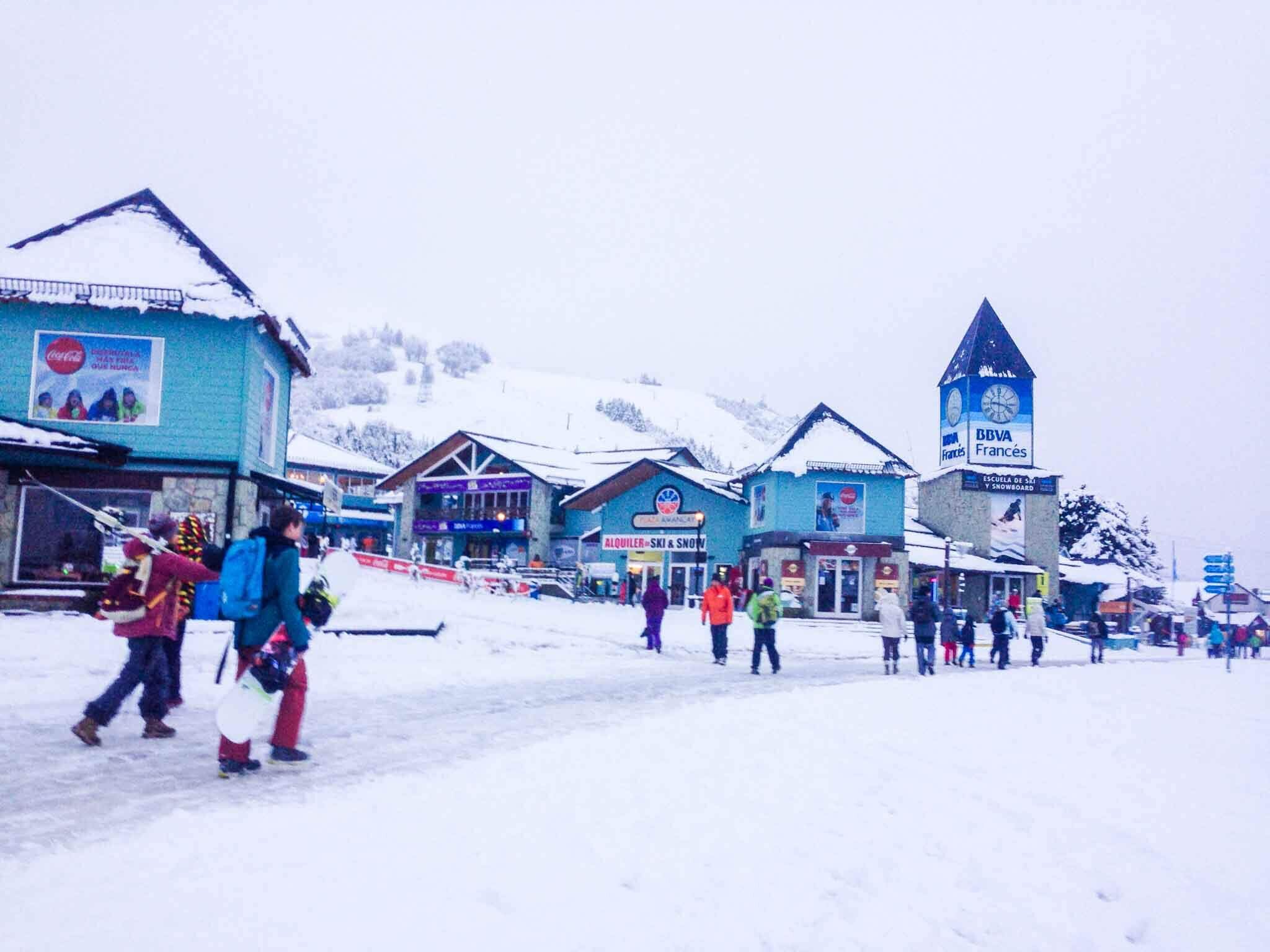
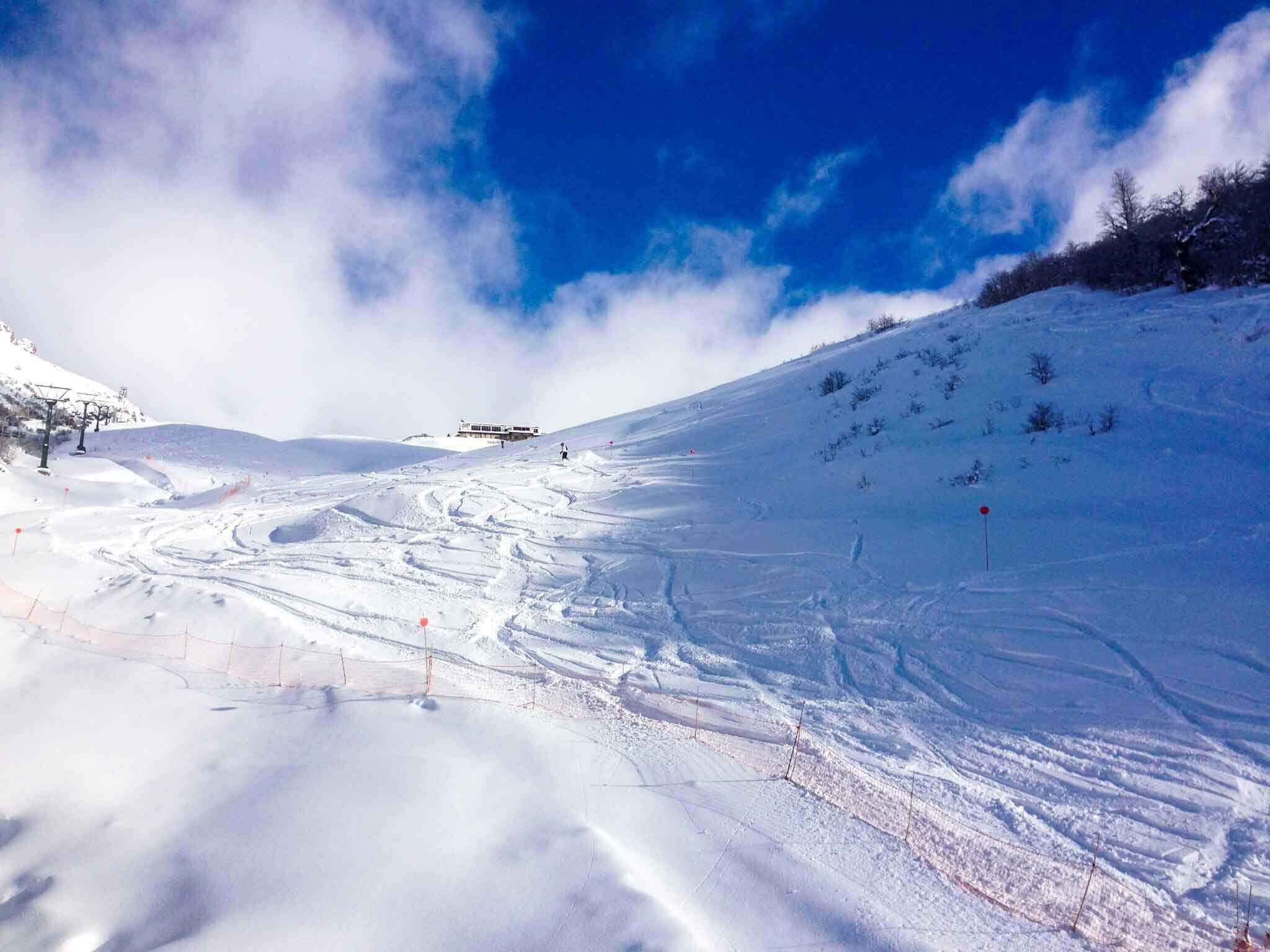
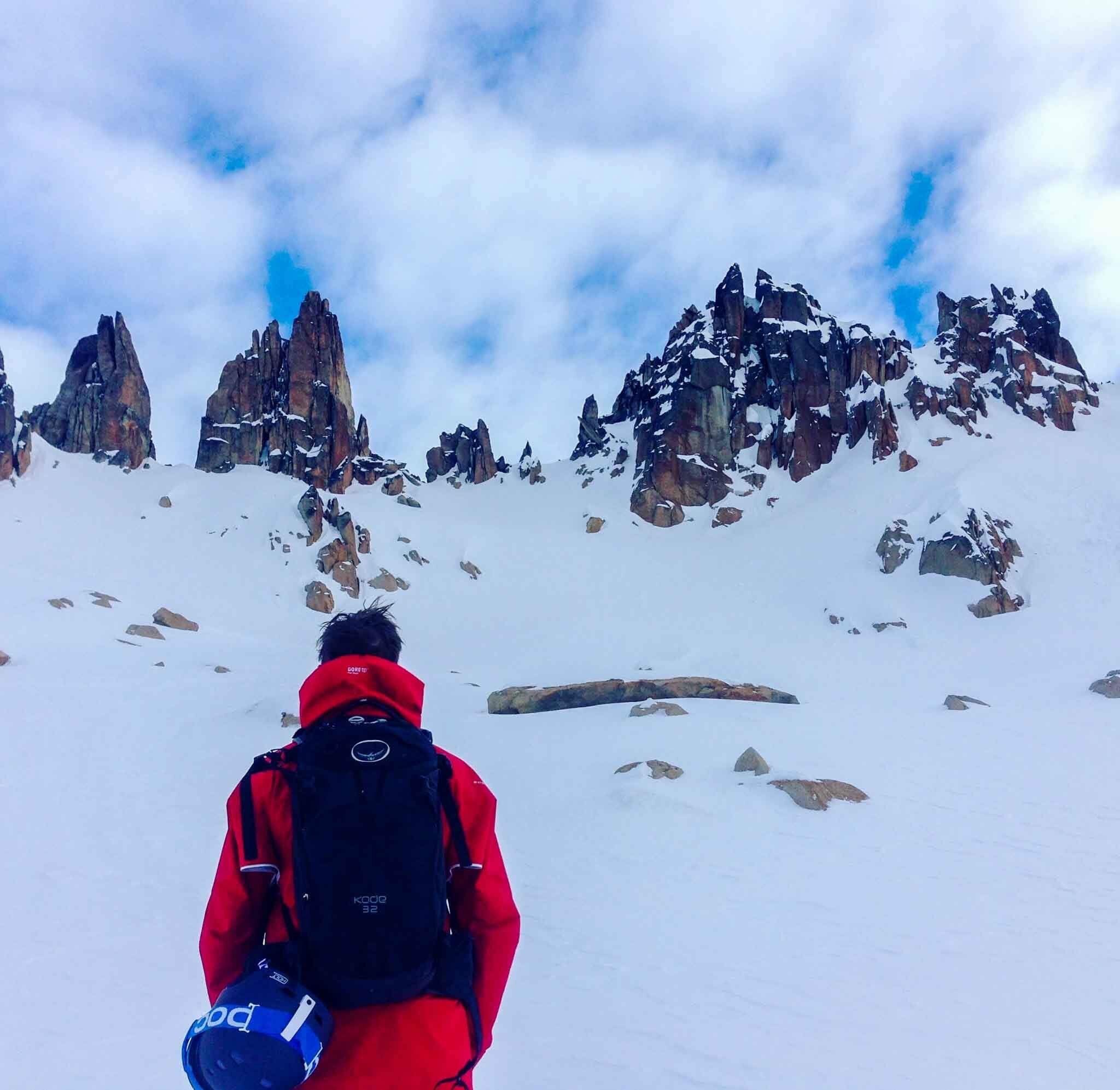
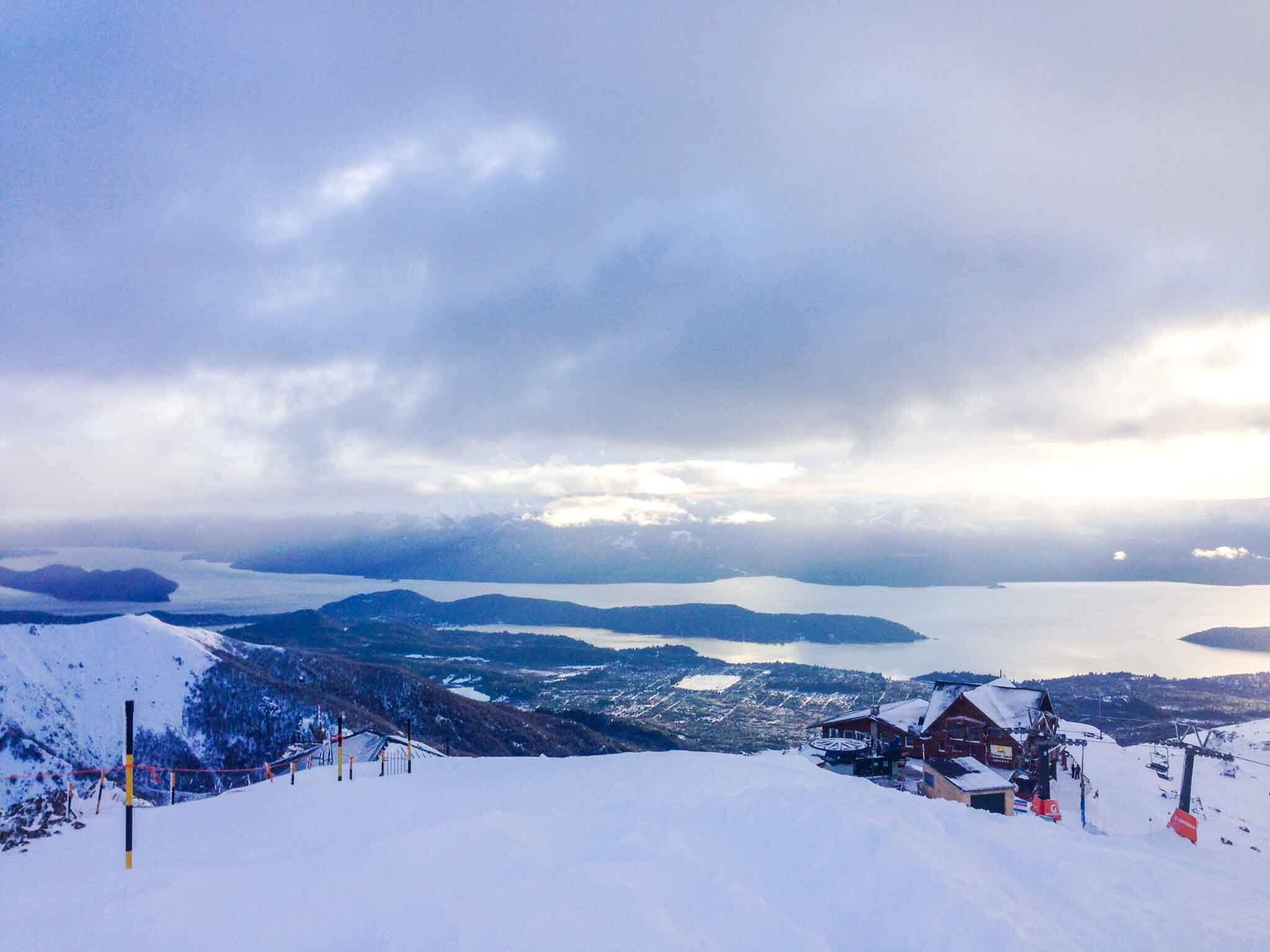
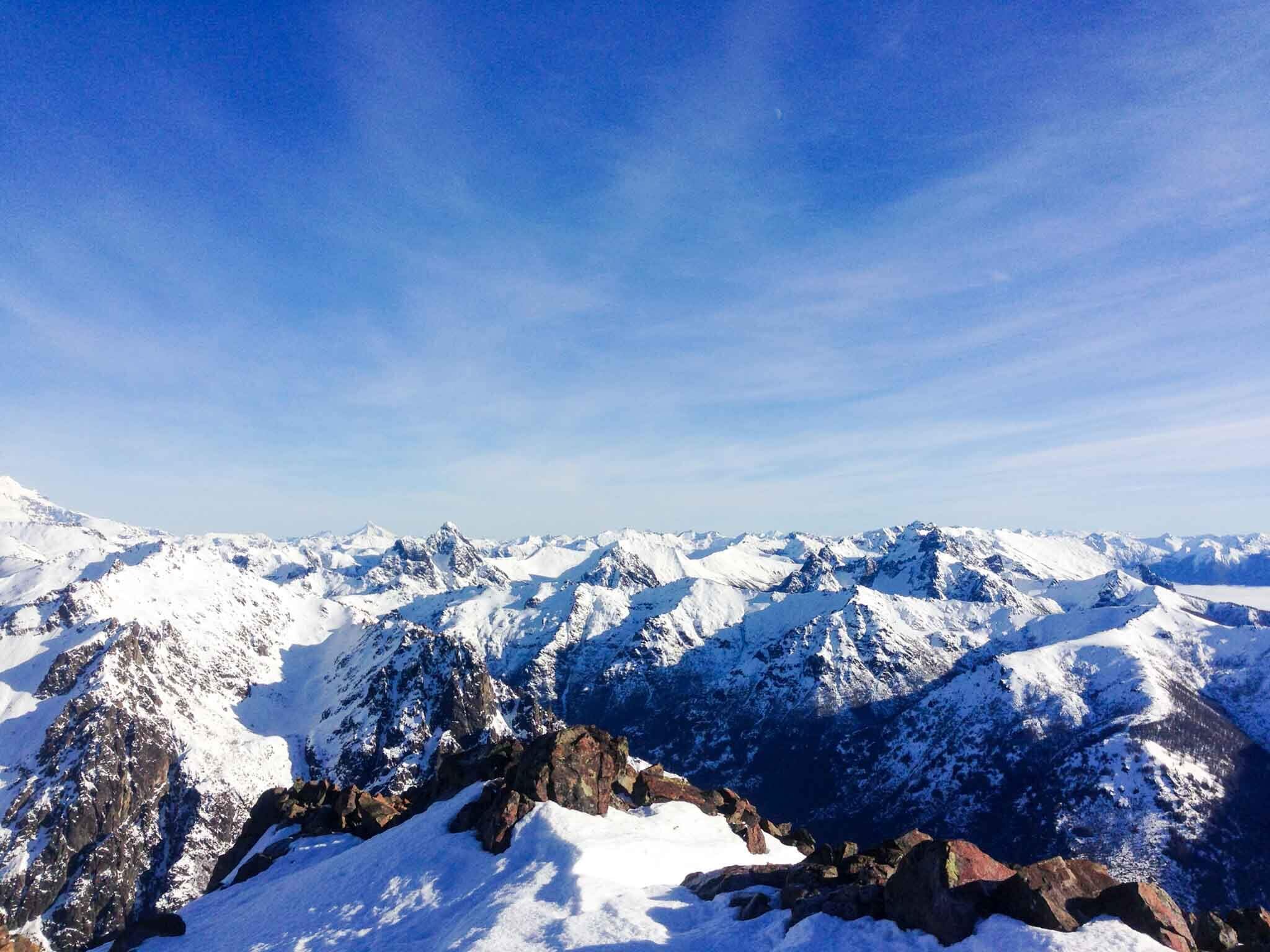
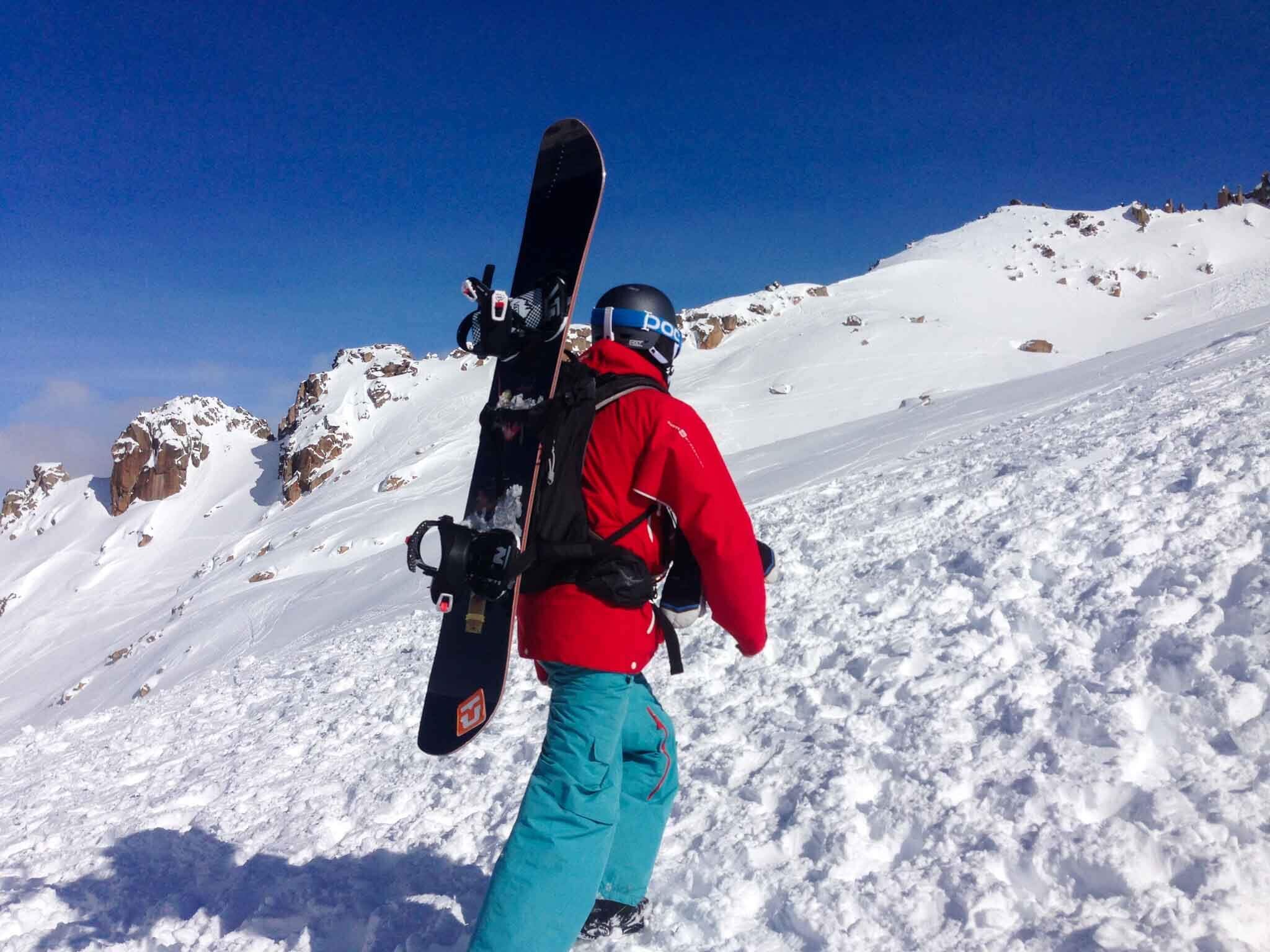
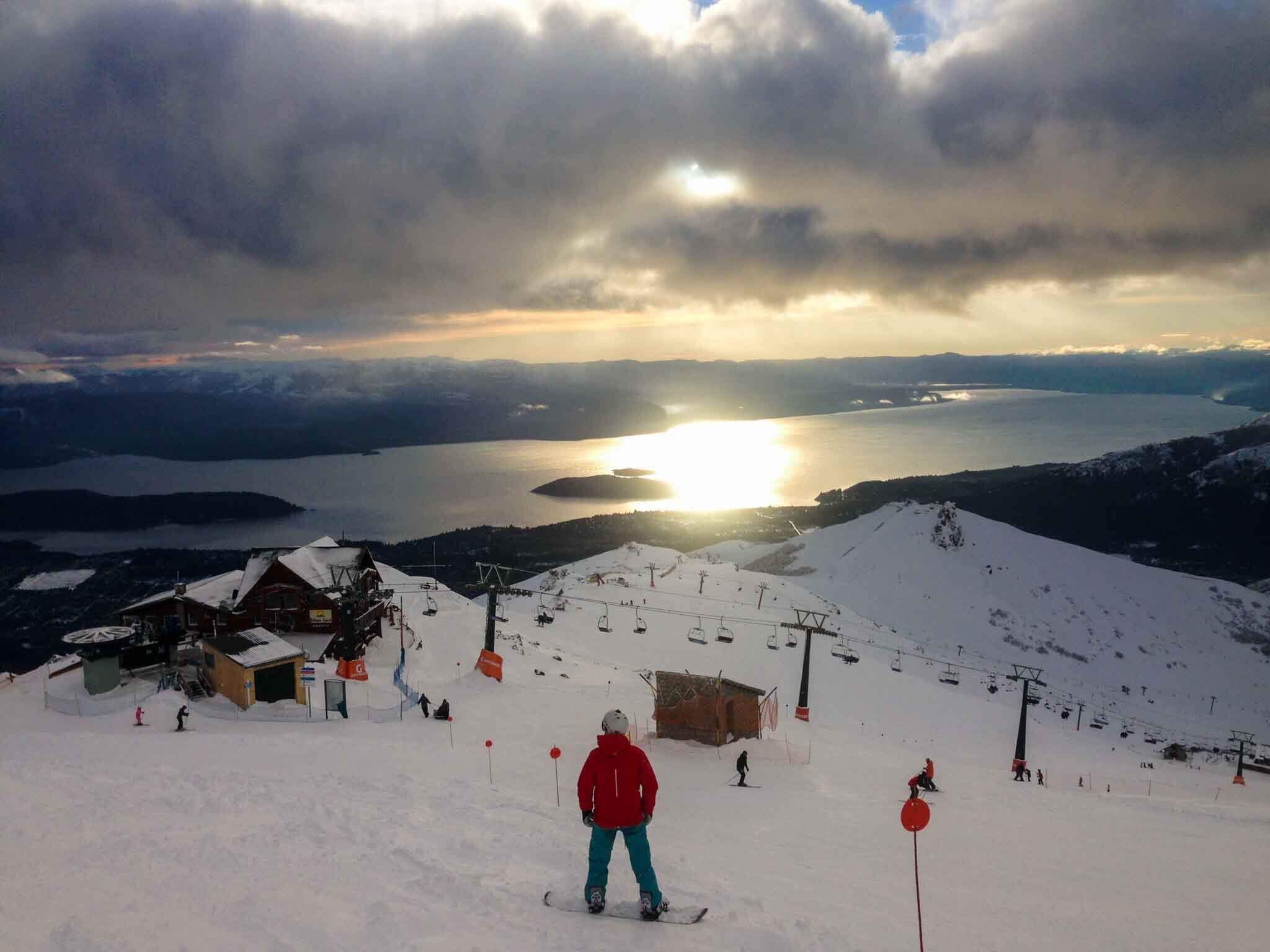
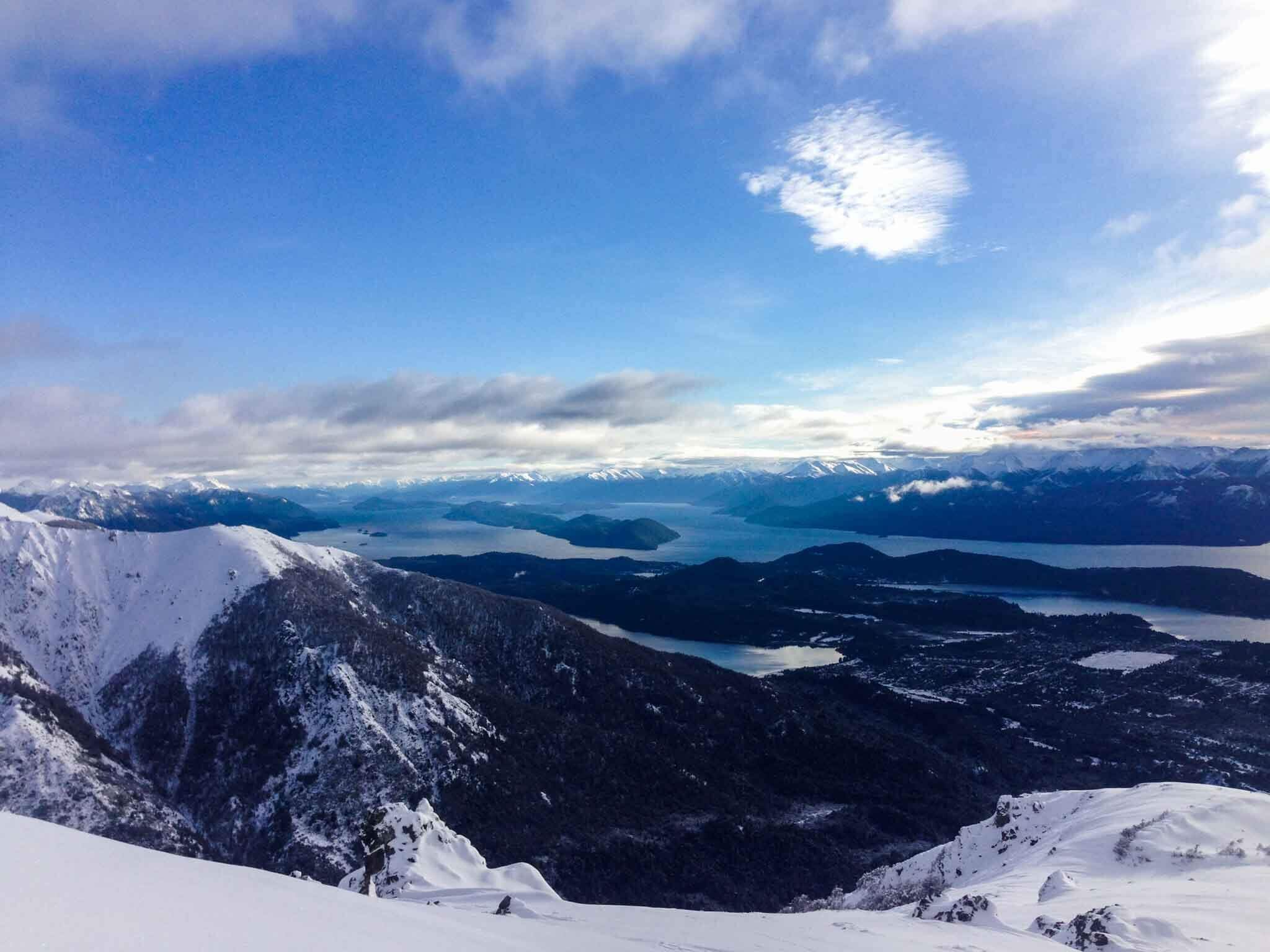
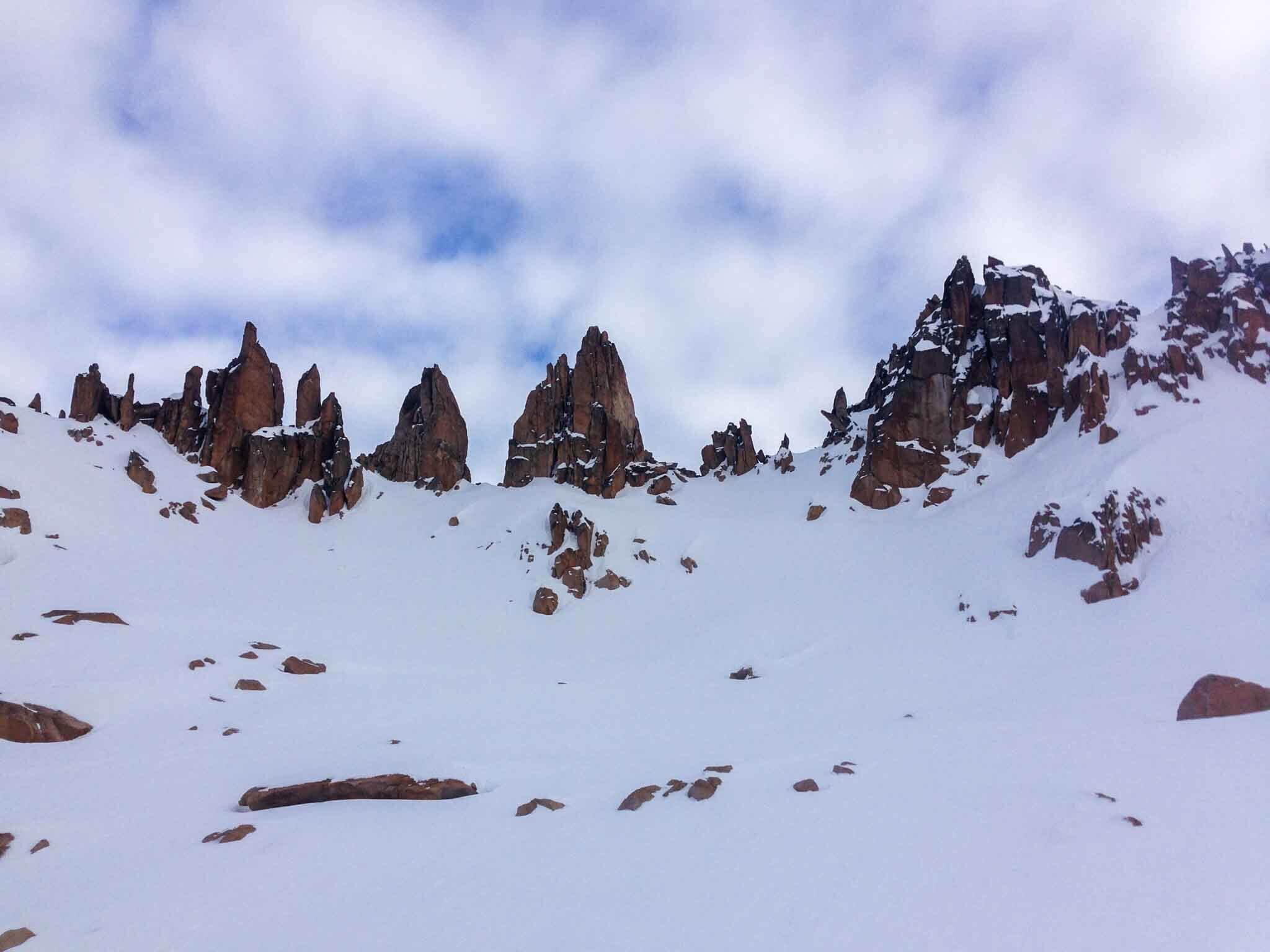
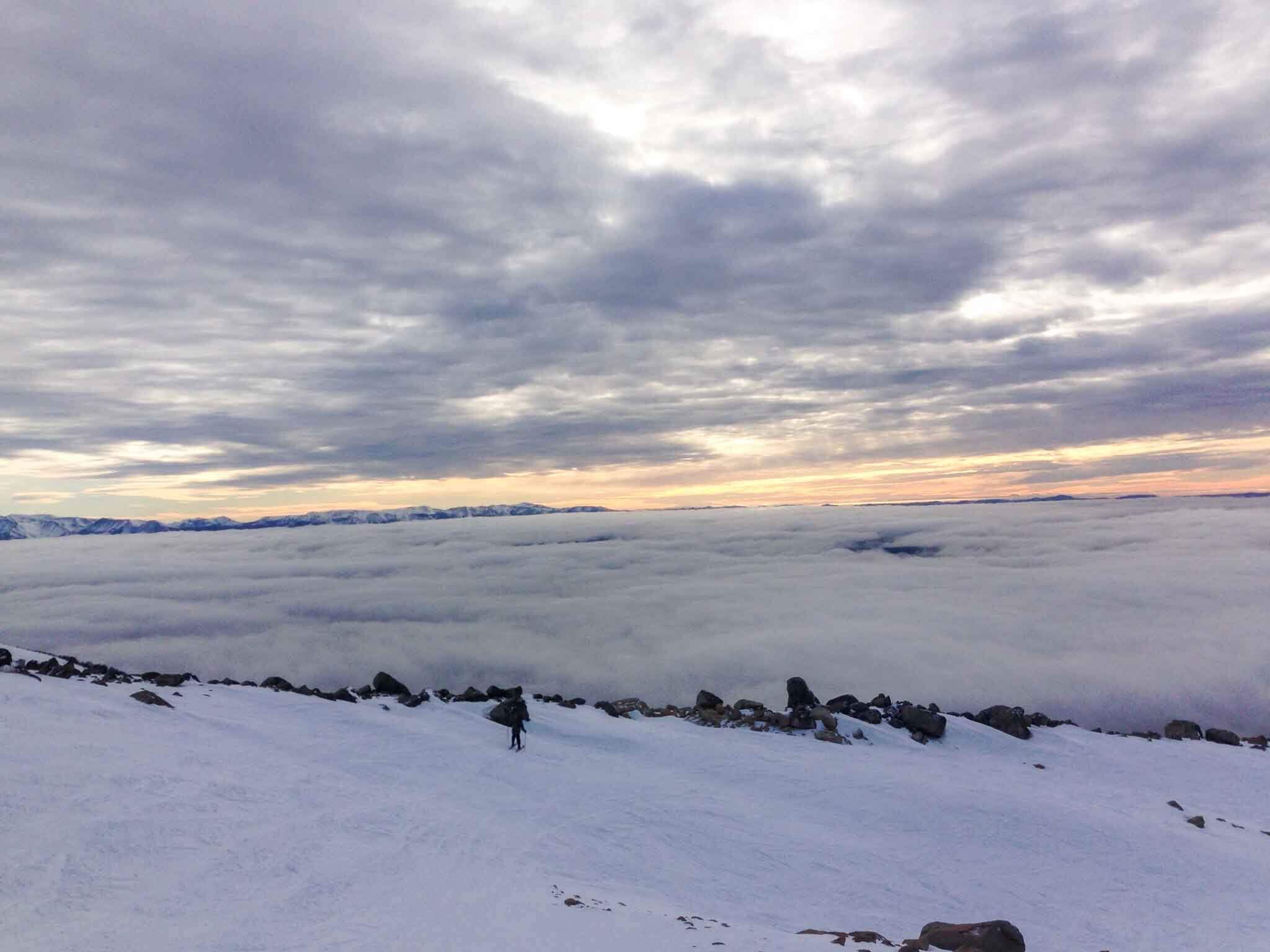
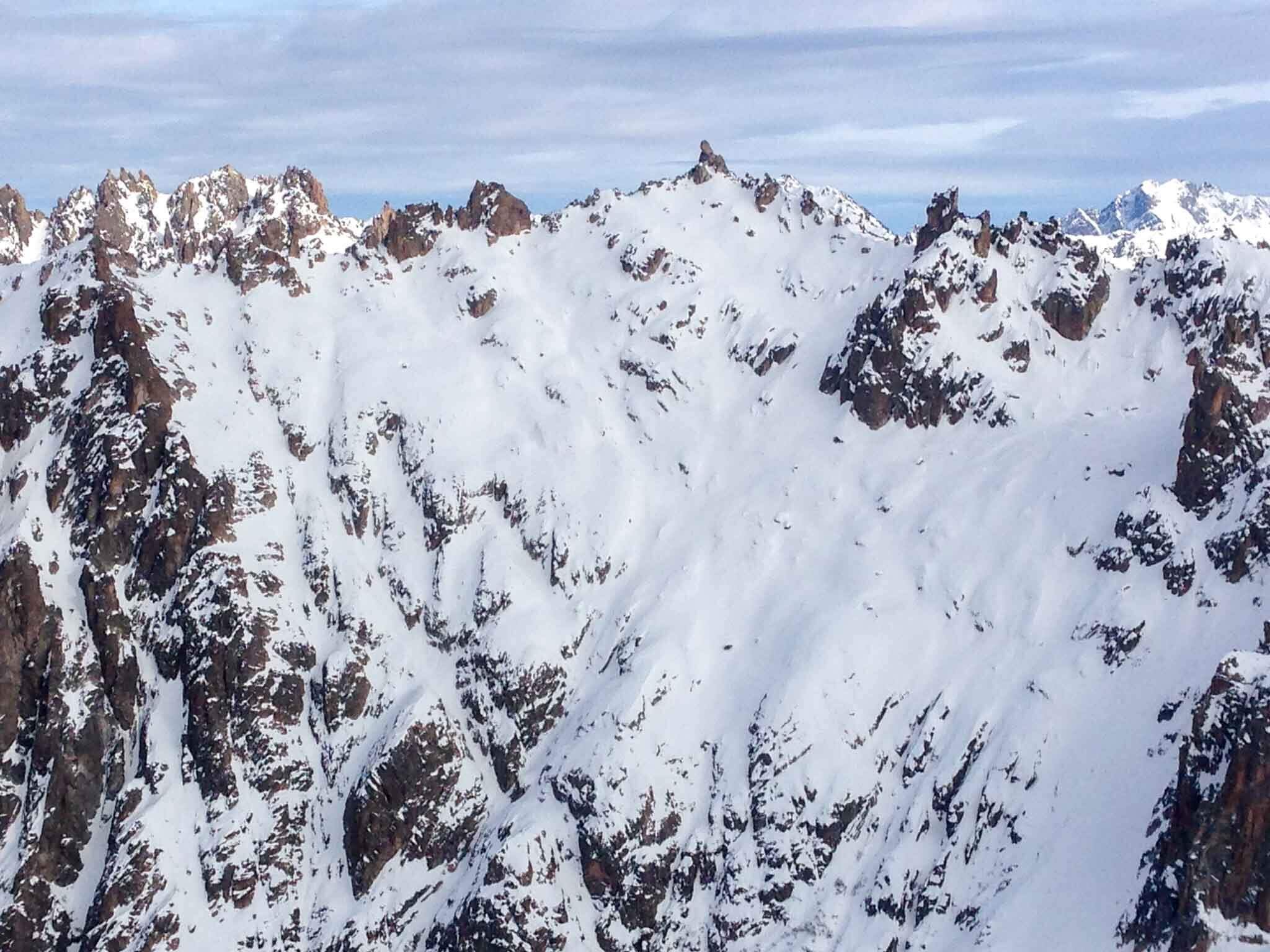
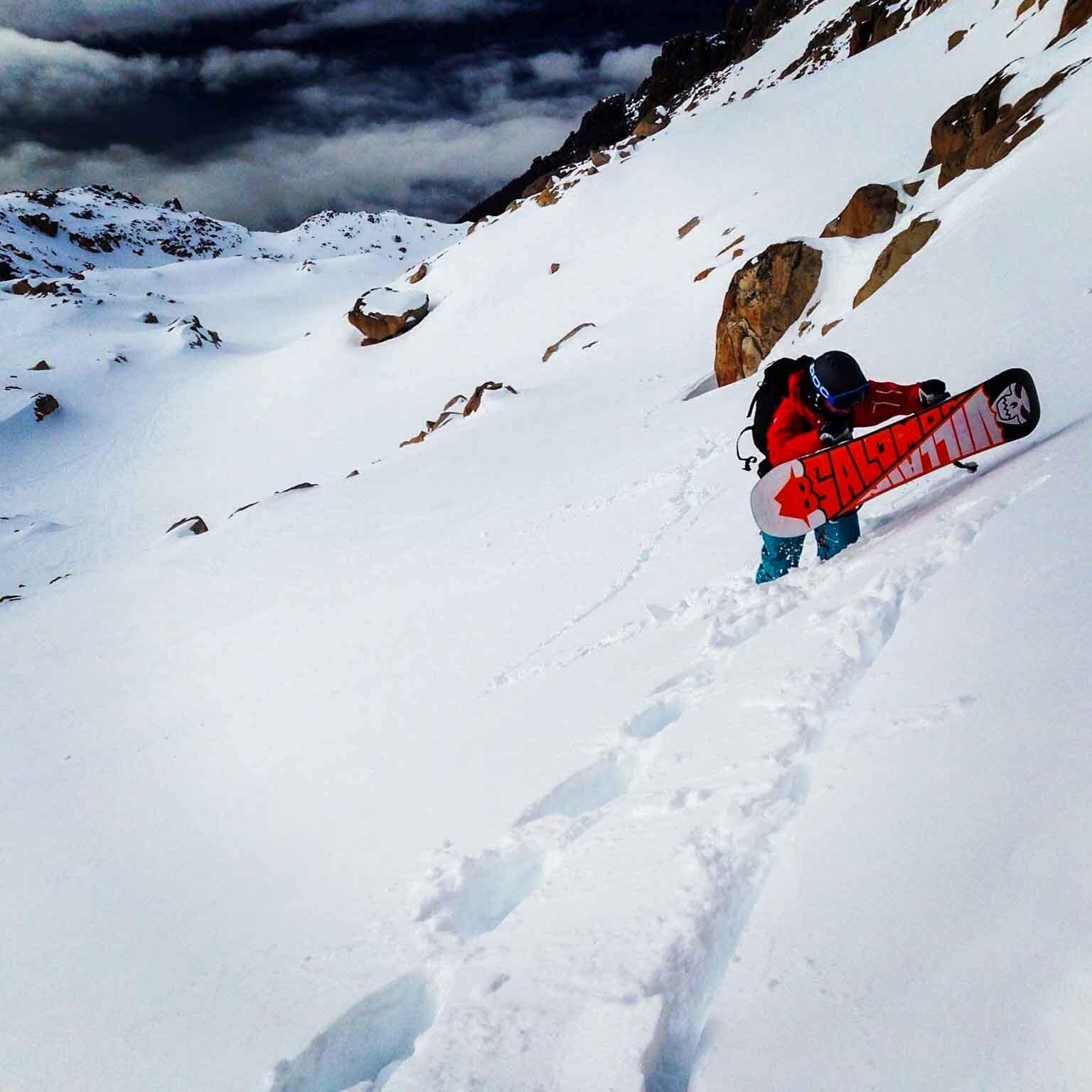
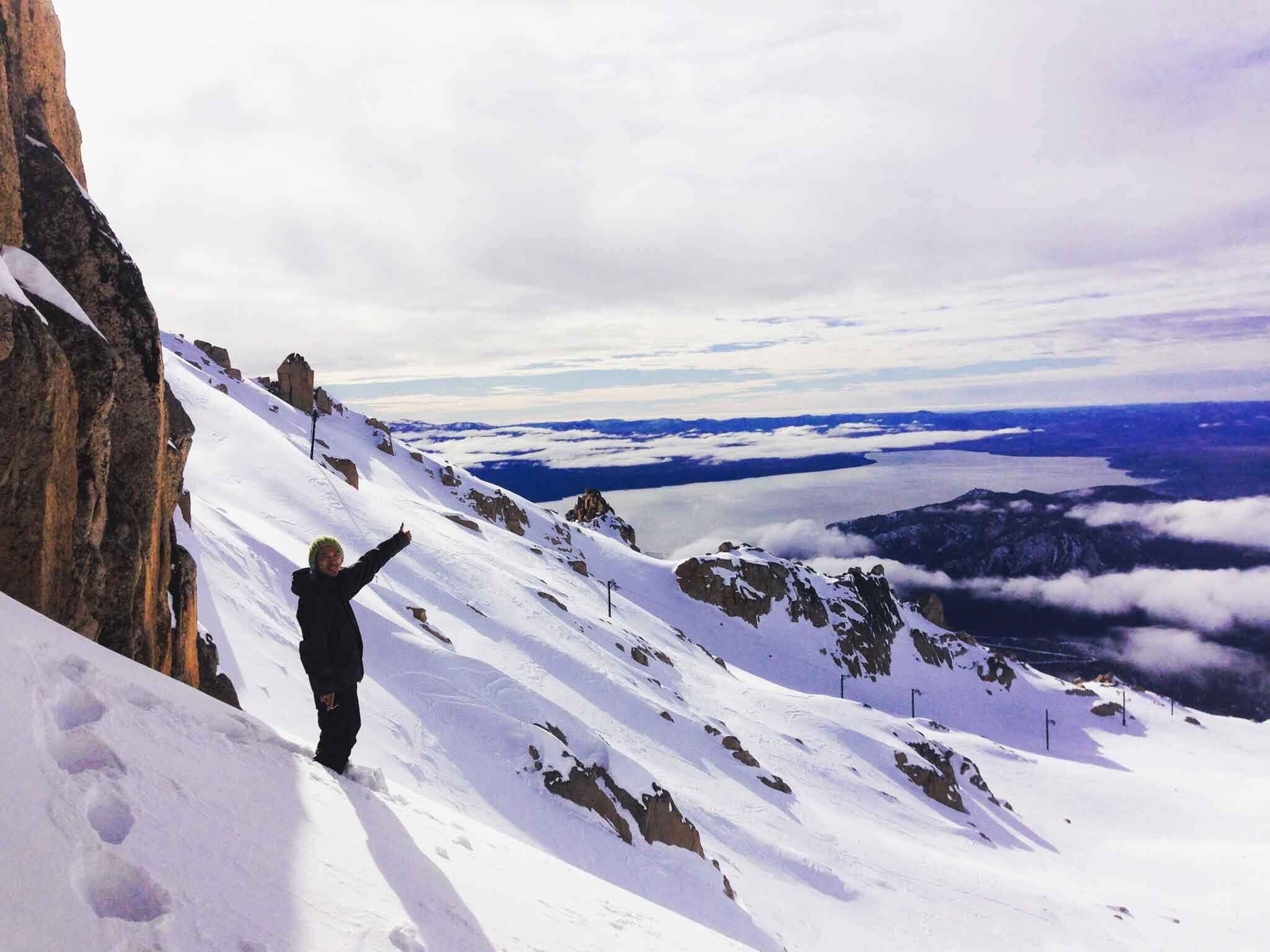
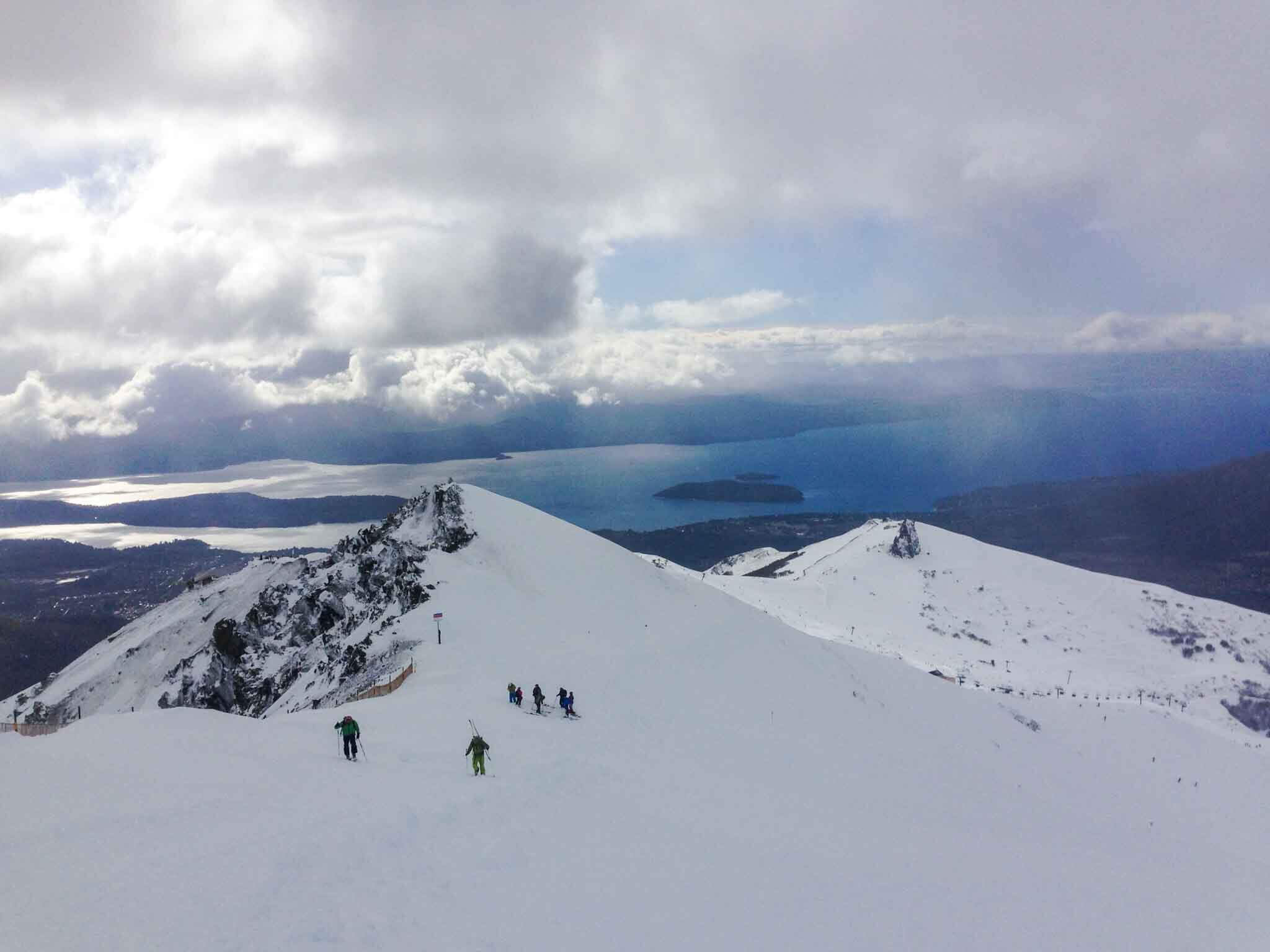
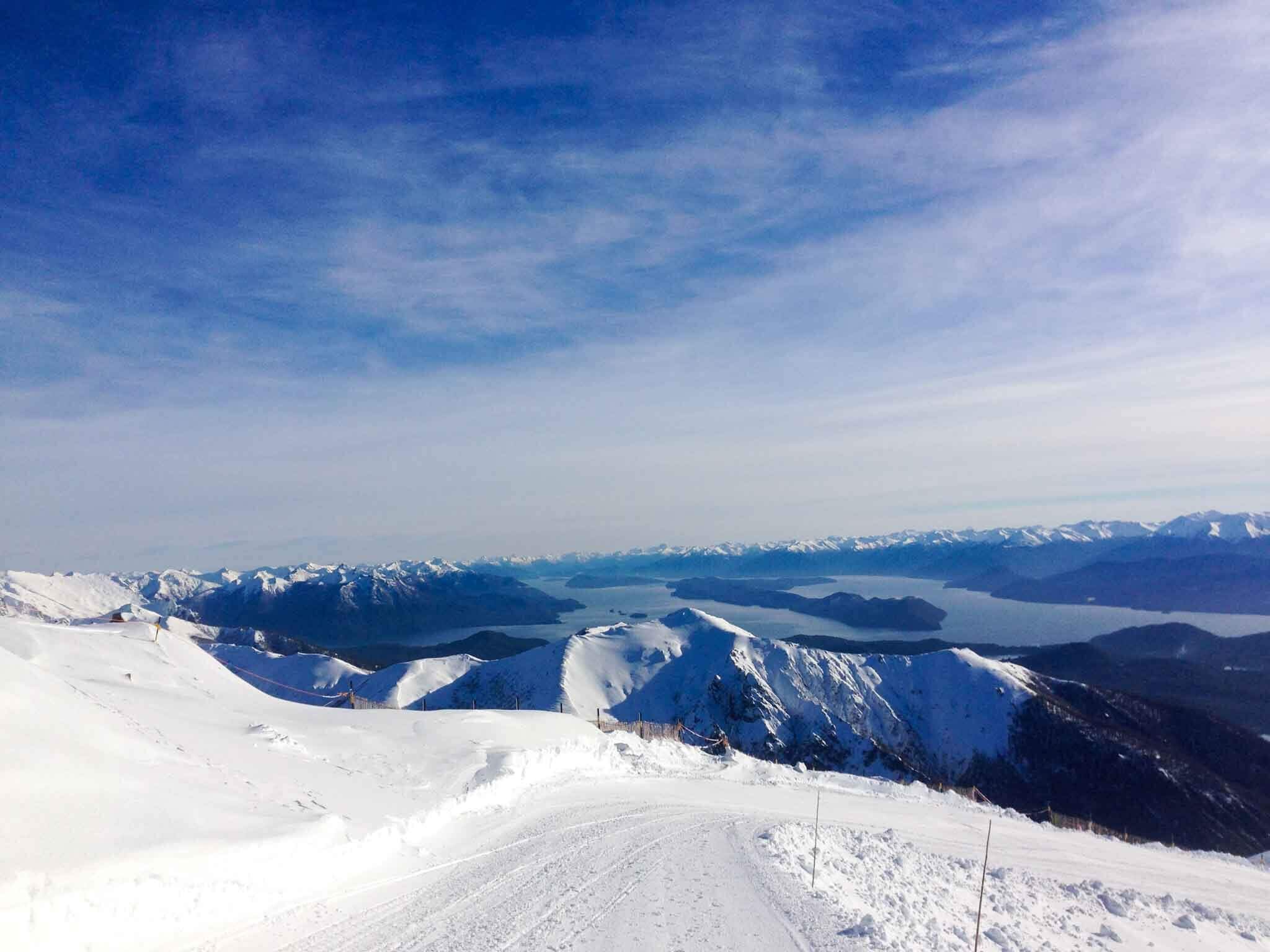
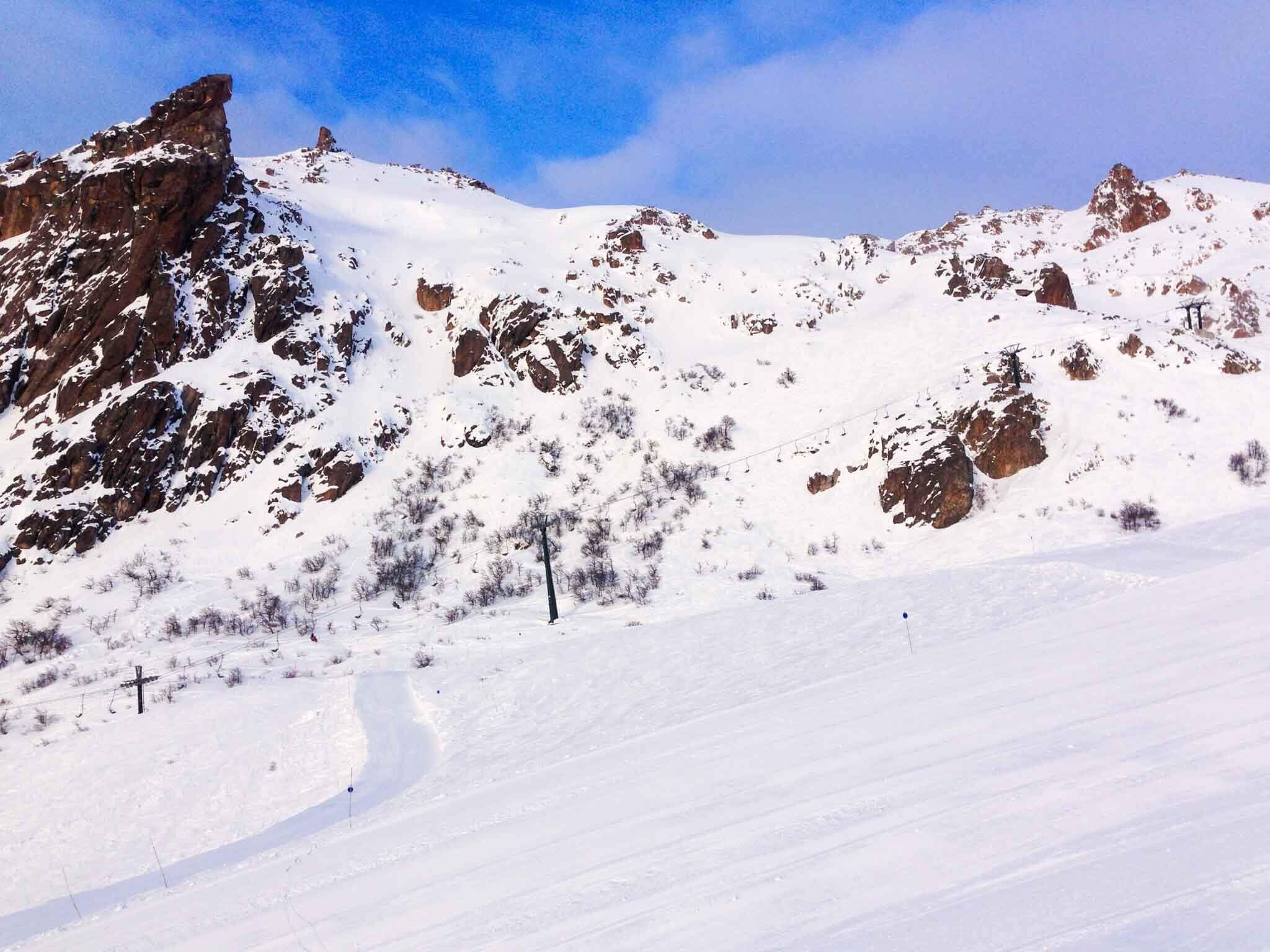
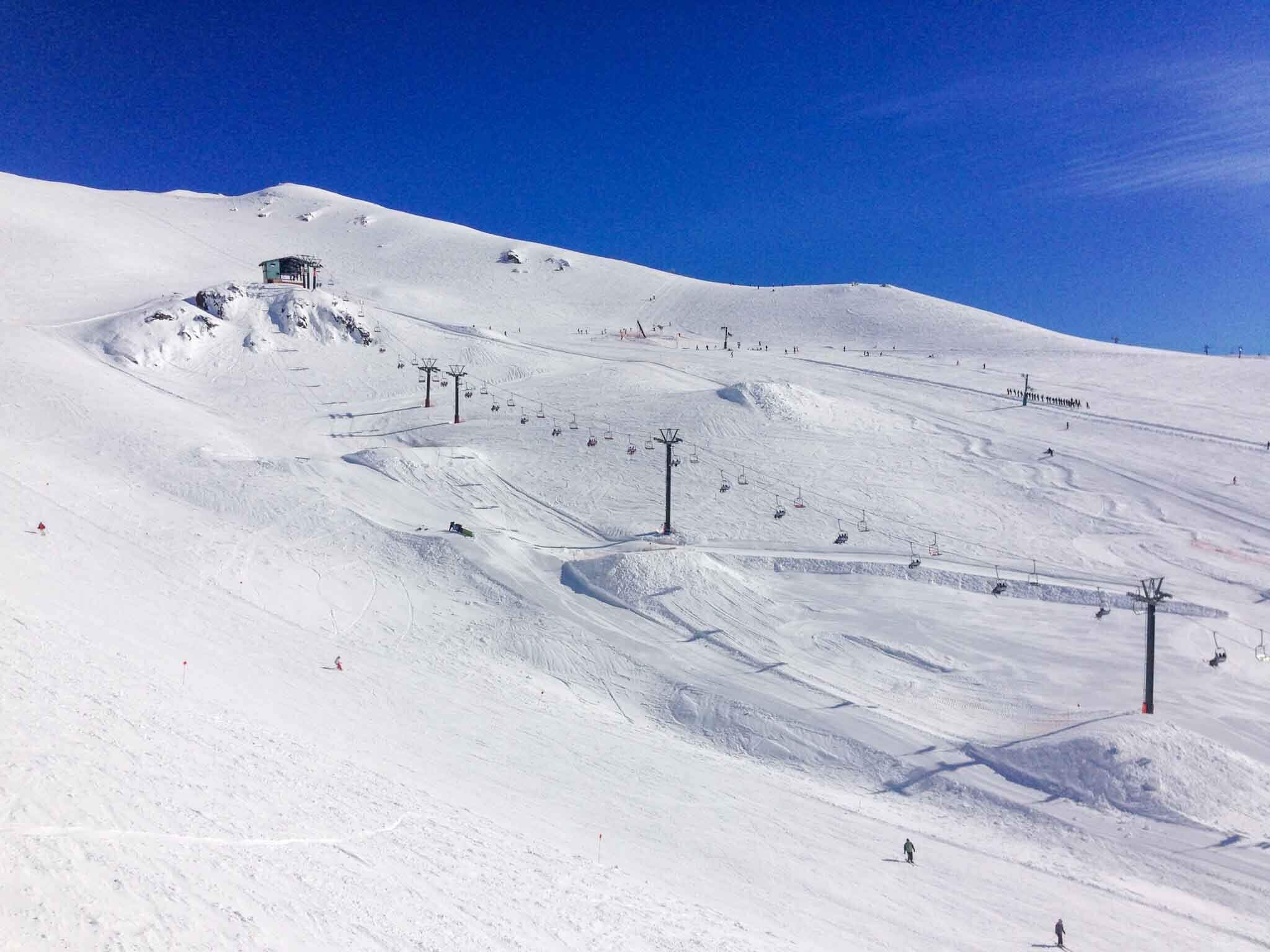
WHAT TO EXPECT WHEN SNOWBOARDING IN ARGENTINA
Snowboarding in Argentina can be amazing and it can be a complete write-off. In Argentina, you really have to be prepared for the worst and make the most of the good days you get. Like in most mountain environments, the weather dictates everything and Argentina can be prone to some pretty serious weather systems. There is nothing quite like the feeling of being sat on a chairlift in 100km winds whilst hoping the resort staff can get the chair running again. With this in mind, Argentina’s resorts can be prone to wind closures that can last days rather than hours.
When conditions are good, Argentina is an incredible place to snowboard. Bluebird days bring with them insane views of Argentina’s rugged landscape and powder days combine epic snow and some jaw-dropping terrain. The majority of my days on snow in Argentina have been positive and it is worth remembering that on the days when things don’t go right.
The resorts are a mixture of modern facilities and some of the slowest chairlifts you could ever experience. Cerro Catedral specifically has a good mixture of high-speed chairs and some older ones that really could do with replacement. With that being said if there is one place I don't mind a slow chairlift ride it’s Argentina, the views are worth it.
Freeride is the main reason to visit Argentina with the Andes Mountain range creating some incredible natural terrain to play in. If freestyle is your thing, then there will be terrain parks to play in but don’t expect the same scale as some New Zealand resorts.
WHY SNOWBOARD IN ARGENTINA
Argentina is a great destination for a summer snowboard trip. Unlike Australia and New Zealand, you will find big mountain terrain within the resort boundaries. This means that not only will you be chasing summer pow laps but you can head into some pretty epic areas to get it. There is hikeable terrain at most Argentinian resorts with Las Leñas and Cerro Catedral having great sidecountry access straight from the chairlift.
Argentinians are great people and will be a highlight of any trip to this awesome country. I found Argentinians to be incredibly welcoming during my travels and even had some volunteers show me their local spots on the hill. I was blown away by the helpful nature of the Argentinians whether it be; hitchhiking to the resort or inviting me for Asado.
Argentina is about so much more than just the on-snow experience. The capital of Buenos Aires is well worth investing a couple of days of your trip to visit. Everything from the historic Plaza De Mayo to watching a football match at La Bombonera should be high on your tourist bucket list. Of course, any trip to Buenos Aires would be incomplete without a steak dinner and a night learning the Tango.
La Laguna @ Cerro Catedral
ARGENTINA SKI SEASON DATES
As summer seasons go Argentina’s is pretty long. Starting in June and running into October. Depending on the season the early and late season conditions can be pretty sketchy with the best time to visit during August. In August you will have your best chance of scoring that Argentinian powder day however it can be crowded during the holiday season. Luckily, my experience is that most tourists to Argentine ski resorts are first-timers and won’t be out stealing your stashes.
POPULAR ARGENTINA POSTS
TRAVEL TO ARGENTINA
Getting to Argentina from London is a long flight, 14 hours into Buenos Aires and you will need to connect to get closer to your chosen resort. Internal flights in Argentina can be expensive but will save you a long bus journey. Argentina’s bus network is pretty impressive and fairly inexpensive. Be sure to choose the ‘cama’ option which is a reclining seat and will offer more comfort.
ARGENTINIAN APRES SKI
Argentinians know how to have fun and this is no different in their ski towns. Most resorts will offer a lively happy hour after the lifts are closed but this is normally just a prelude to what is to come. Argentina is about the community so expect to be invited to eat Asado. If the mood takes you, nightclubs are popular but be prepared to start late with most opening around midnight.
TRAVEL MONEY ARGENTINA
Argentina is famous for a currency that is continually fluctuating. This means getting your money at the right time can make a huge difference in how affordable your trip is. It is well known that in Argentina there are two currency exchange rates, the official rate, and the black market rate. The black market rate will get you around 20-30% more for your money over exchanging your money in banks but this is obviously at your own risk.
ARGENTINA FREQUENTLY ASKED QUESTIONS
IS SNOWBOARDING BETTER IN ARGENTINA OR CHILE?
Argentinian and Chilean ski resorts offer you incredible terrain if you love freeriding. With terrain that will challenge even the most experienced snowboarders, you can really push your boundaries in both countries. Like most places in the world, Argentina and Chile have different scale resorts suited to different styles or levels of snowboarding and you just need to find the resorts that suit your style. There are plenty of reasons to visit both countries for a snowboarding trip.
HOW MUCH IS A SKI PASS IN ARGENTINA?
As with most things in Argentina the actual cost when you consider currency conversion can change drastically. Expect to spend between £40 to £80 per day for a lift pass at the major resorts. It is worth checking out the Flexi pass options if you want some coverage due to poor weather and you can save massively by purchasing multi-day passes.
IS IT SAFE TO TRAVEL AROUND ARGENTINA?
As with all countries is it best to use common sense and proceed with caution in high-risk areas. Our experience is that Argentina is a safe place to travel and we have never had any issues. Listen to local advice and leave potential problem spots before it gets dark. Around the ski resorts, Argentina is incredibly safe and you can feel more relaxed. Buenos Aires is one of the safest cities in South America but it does have its problem spots. In Buenos Aires, areas like La Boca are huge tourist hotspots and prone to crime. We enjoyed visiting La Boca but the advice was always to leave before 5 PM.
DOES ARGENTINA HAVE GOOD SNOW?
Argentina can deliver some epic snow conditions with big mountain powder runs a thing of legend. Typically the ski season has its most reliable conditions through July and August in Argentina so it is best time time your trip between these months.
DOES ARGENTINA HAVE GOOD SKIING?
If you are looking for a summer skiing destination then you can’t go wrong by opting for Argentina. Argentina is home to some mega-resorts like Las Lenas and Cerro Catedral which offer some of the best skiing on the continent. The ski resorts in Argentina are on a bigger scale than those in other summer skiing destinations like Australia.
GET IN TOUCH
As always thanks for reading and know it is your turn to have your say! Let me know in the comment section if you have visited Argentina. What was your favourite activity in Argentina?
PIN IT FOR LATER
IF YOU FIND VALUE IN THIS POST CONSIDER CLICKING THE BUYMEACOFFEE LINK BELOW TO SUPPORT MY CONTENT
Five Best Ski Runs In Hakuba Valley
The Hakuba Valley is an area of Japan renowned for world-class skiing and snowboarding. Blessed with an average of 12m of snow per winter, it is no wonder that people flock from around the globe to experience Japanese powder conditions. In this post I share the five best ski runs in the Hakuba Valley.
With ten resorts included on one pass there is an expanse of terrain to choose from when heading to Hakuba. This means whittling all the options down to a list of the five best runs possible in Hakuba was a hard task. This list is based on my experience of snowboarding in Hakuba in Jan-Feb 2019 and my fondest memories of the trip. The runs I have selected are varied and I will fully explain my reasoning below.
5. TSUGAIKE DBD GATE 3
Tsugaike is nicknamed ‘powder heaven’ and this should tell you all you need to know. Geographically it is close to Hakuba Cortina but it doesn’t draw the same crowds despite receiving similar amounts of snow. This is most likely down to the restriction on tree riding at Tsugaike, requiring you to take a course to enter to the tree areas or DBD. There are four main gates into the Tsugaike DBD area and I enjoyed the lines through Gate 3 the most. Gate 3 provides a longer run than Gate 1 with a steeper incline but the same well spaced trees!
4. HAKUBA 47 TERRAIN PARK
When you think of a Japanese snowboard trip heading to the terrain park is not what comes to mind. Sadly not every day can be a powder day and Hakuba 47 offers another option to keep you entertained during your trip to Hakuba. The terrain park at Hakuba 47 is in my opinion the best in Hakuba. The layout is great with its own (fairly slow) chairlift, making park laps a fairly simple task. Hakuba 47 has Hakuba’s only half pipe at the top of the park which leads down to a choice of lines. Skiers and snowboarders can choose between simple ride-on boxes to large kickers and more advanced rail features.
3. CORTINA CHAIR 5 TREE RUN
Cortina was bound to feature in this list and it does twice, but the run from the number 5 chairlift might be a surprise entry to some. This is where I found some of my best and less contested turns in Cortina. With the crowds that flock to Cortina if you want to make the most of it you need to get away from the crowds. Number 4 chairlift accesses some great terrain but you can expect a 40 minute lift cue on a busy day. With this in mind the trees that are accessible from Number 5 chairlift are a great option. My advice is from the top of the chairlift go left, take a short traverse and then drop in. Most skiers and snowboarders go right of the chair meaning you can find untracked lines well into the afternoon. Whatever chairlift you use at Cortina will lead to widely spaced trees and copious amounts of JAPOW! Taking chairlift number 5 just means you don’t need to share.
2. SANOSAKA LAKE DOWN TRAIL
Sometimes good things come in small packages and Sanosaka is a prime example. Making the list at number two is my favourite non-powder day run in Hakuba, Lake Down Trail. It blows my mind how quiet this resort is and you can have the groomers to yourself all day. Lake down trail is a wide blue run offering great views of Lake Aoki. Stood at the top you have the option to take the groomed piste or go to skiers right where there is a pump track… as the run mellows out towards the chairlift, you will also find some small park features. This means in one run you can; take in a great view, carve a groomer, build up speed on the pump track, hit a jump, slide a rail and then head up for some more…. oh did I mention dogs are allowed? So be sure to keep an eye out for a furry friend.
1. CORTINA TO NORIKURA BACKCOUNTRY RUN
Hakuba Cortina not only has no restrictions on where you can tree ride but it is also linked to neighbouring resort Norikura Onsen Ski Resort. From the top of number 4 chairlift at Cortina, you can access a backcountry run that takes you between the two resorts and this was a highlight of my days at Cortina. As soon as you drop in you are met with perfectly spaced trees and a steep incline that make face shots a regular occurrence. The amount of snow combined with the terrain makes this a run I have not found elsewhere on my snowboard travels. You will want to gradually ride towards skiers left as this will take you towards Norikura resort where you will be able to head back up and do it all again.
Have you visited Hakuba? Do you have a favourite run? Let me know in the comments.
RELATED POSTS
The Complete Grand Massif Snowboard Guide
A combined five-resort ski area with reliable snow and affordability not found in other parts of France, the Grand Massif is a trip everyone should consider. From the super resort of Flaine with its art deco buildings and sculptures on the slopes to the quaint village feel of Samoëns, you can find something for everyone in Le Grand Massif. The Grand Massif combines the five resorts of Flaine, Les Carroz, Samoëns, Morillon and Sixt-Fer-A-Cheval to provide access to 265kms of slopes with a good snow record.
View before dropping into the Tete de Saix
GRAND MASSIF FIRST IMPRESSIONS
Arriving in the Grand Massif has always been hassle-free on each of my trips there. Access via transfer from Geneva airport is seamless and the transfer times to the villages are not excessive. My first trip to the Grand Massif saw me stay in Samoëns where access to the ski area is via Grand Massif Express or Vercland gondolas. Facilities and lift infrastructure throughout the Grand Massif is brilliant.
GRAND MASSIF SKI AREA
The Grand Massif Ski Area is home to five unique French Ski Resorts. Combined they account for 265km spread across 152 pistes which makes remarkable value when a season pass can be purchased for under €600 (Early Bird Pricing). The ski area of the Grand Massif doesn’t stand out as groundbreaking in that it is not the steepest or the largest however, it is well-equipped to deliver an exceptional package to its guests.
The Grand Massif can be considered one of the best combined French ski areas to visit with its extensive piste map with connecting trails offering something for the whole family. Half of the terrain in the Grand Massif is marked as green or blue pistes which means it can be great for those learning to ski or intermediates looking to explore a larger area.
The fact that the Grand Massif caters well to beginners shouldn’t put off the more able skier or snowboarder with the variation of terrain across the resorts offering substantial challenges. There are several interesting black trails and some easily accessible off-piste including Agate which is accessible from Flaine’s highest point, Tete Des Lindars (2561m).
Each resort making up the Grand Massif offers something different, so it is well worth investing in a full area pass. This is especially true given that it is not a big deal to ski from one end of the piste map to the other, which can be the case in the larger Portes Du Soleil and Three Valleys ski areas.
You can travel between the resorts of Flaine, Les Carroz, Morillon, Samoëns and Sixt using chairlifts or free shuttle buses. On piste- the links between the resorts are also well-established with plenty of options to ride between the resorts. I enjoy the Grand Massif for not being restricted to one ski area for a day. In contrast to the 3 Valleys where you may opt to ski in Val Thorens for a day and then Meribel on another, the Grand Massif is big enough to make it interesting but small enough that skiing multiple resorts in a day is not just possible but advisable.
FLAINE
Flaine represents the highest point in the Grand Massif at 2500m, ensuring a consistent snow record throughout the season. A year-round resort, Flaine comes alive in the winter and is the most well-known resort in the area.
Flaines Village as seen from a Mountain Restaurant
The pistes in Flaine are well-maintained and were designed by Emile Allais, a former French Ski Champion. The beginner’s area at Flaine is perfect for establishing those first turns. However, I would still opt for lessons in nearby Samoëns, which provides a great space for learning including a children’s park.
Intermediate skiers and snowboarders will enjoy Flaine’s expanse of terrain and easy access to the nearby resorts. There is some interesting tree riding to be found and those looking for a challenge should head towards Gers Bowl, especially when there is fresh snow.
Flaine is serviced by fast lifts and a combination of chairs and gondolas can be found. A ride on the Flaine bucket lift is a unique experience. Perhaps for beginners, the best thing about Flaine’s lift system is free access to the moving carpets, ensuring an option to self-learn.
READ THE FULL FLAINE SKI RESORT GUIDE HERE
LES CARROZ
Les Carroz sits in the heart of the Grand Massif and is an ideal location to explore the rest of the resorts. With easy access to Flaine, Samoëns and Morillon it is easy to see why so many people choose Les Carroz as their base.
Les Carroz ski resort is relatively small with 37km of local pistes however this stat doesn’t do it justice. There is plenty of fun to be found away from the piste, through the trees and in the off-piste near Corbalanche and the Tete de Saix. As a small resort, Les Carroz benefits from being part of the wider Grand Massif ski area but equally stands alone as a resort that offers a good all-round package. Les Carroz boasts a pretty awesome terrain park and boarder cross track, as well as a couple of challenging black pistes.
READ THE FULL LES CARROZ SKI RESORT GUIDE HERE
SAMOËNS
If you are looking for a slightly different ski holiday base, then Samoëns certainly offers you an alternative to purpose-built on-mountain accommodations. The beautiful village at the base of the Grand Massif Express gondola has a quaint town centre which hosts nice restaurants, ample shopping and entertainment for the children. The village of Samoëns is amongst my favourite bases for any ski holiday.
The resort itself is found above the village and is accessed via either the Grand Massif Express or Vercland gondolas. Samoëns ski resort is possibly the most versatile ski area in the Grand Massif. Ranging from one of the largest beginner areas in the French Alps to challenging off-piste skiing and snowboarding. Beginners will find everything they need in Samoëns with a steady progression of runs serviced by magic carpets and chairlifts, although this area can become a bottleneck for crowds in peak weeks.
Intermediates will love the Coulouvrier chairlift, a high-speed chair currently the longest in Europe at 2.9km, which accesses blue and red runs that pass through a natural bowl. Additionally, the run down to the old Vercland bubble gives ample opportunity for stretching those legs.
Advanced skiers and snowboarders will want to make a b-line for the Chariande Express chairlift before the crowds and move away from the resort base. From here they will have the option to drop into an unpisted bowl or head over to the Tête de Saix.
READ THE FULL SAMOËNS SKI RESORT GUIDE HERE
MORILLON
With one of the lowest altitudes out of the Grand Massif resorts at 1100m you could be forgiven for ignoring Morillon, this would be a mistake. The local area has 45km of trails which are home to some of the best cruisey pistes in the entire Grand Massif.
Beginners and intermediates will enjoy the wide pistes in Morillon with the 7km Marvel Slope a particular highlight. Winding its way through the trees Marvel Slope is a great place to spark that excitement in young skiers. In Morillon, you can ride down to the village which is a fantastic way to end your day on snow.
Unfortunately, the lower terrain in Morillon is rarely in action these days with the lower reaches of Morillon struggling with little snow below 1100m. Luckily the 650m of vertical drop between the top of Sairon chair and the gondolas mid-station. offers some fantastic terrain.
I have spent multiple weeks based in the village of Morillon and am fond of it. Morillon is a quieter base for your Grand Massif ski holiday, but with easy access to Les Carroz and Samoëns in addition to the local area, Morillon can be a great budget base for your Grand Massif trip.
READ THE FULL MORILLON SKI RESORT GUIDE HERE
SIXT
Sixt is a ski resort set amongst a nature reserve that is unspoilt by the modern world and mega-resorts that sit around it. The finishing point for the incredible 14km Cascades piste that starts with views of Mont Blanc before ending in this beautiful French village. Sixt is a resort of culture and heritage. You head to Sixt to step away from the crowds and take in the surroundings. At only 765m snow can be sketchy towards the end of the season however the Rouget waterfalls will be a draw.
Sadly skiing and snowboarding in Sixt fer a Cheval is becoming a thing of the past. Last winter (23/24) I don’t recall the ski area in Sixt being open at all and the Cascades trail from Flaine was also noticeably absent. If you are staying in Sixt don’t fret as you have free shuttle buses linking the village to Samoëns and Morillon where you can access the Grand Massif ski area.
SEASON DATES
The season in the Grand Massif runs between December and April. Although all resorts will have good snow throughout the season Flaine will have the best conditions in early and late season. Sixt can suffer from poor snow towards the end of the season, due to its altitude at 750m, but this makes it an affordable base with free buses connecting you to other resorts.
GRAND MASSIF PISTE MAP
Grand Massif Piste Map
TRAVEL AROUND THE GRAND MASSIF
With 265kms of terrain it can be easy to feel overwhelmed with the decisions of where to ski each day. However, with the Grand Massif being so well connected, it is fairly easy to ski across all of the resorts in one ski day. Travelling between the ski resorts of Flaine, Morillon, Les Carroz, Samoëns and Sixt Fer a Cheval is possible via the connecting lifts or in some cases free shuttle buses.
GRAND MASSIF CHAIRLIFTS
The main way to move between the resorts of the Grand Massif is to use the linked chair lifts. The links are fast chairs and allow for large amounts of people to move between the resorts fairly easily. Just be sure to keep an eye on the times that each link will close so as not to get stuck in the wrong resort. Sometimes the linked chairlifts close due to high wind, this was rare during my visits but was communicated brilliantly by staff at each chair.
The Tete de Saix is the main crossroads of the Grand Massif with the following lifts all meeting on or close to the Tete de Saix; Coulouvrier (Morillon), Chariande Express (Samoëns), Tete de Saix (Les Carroz) and Corbalance (Les Carroz). From here it is easy to ski directly into the aforementioned resorts or head to the Vernant chair which accesses Flaine.
GRAND MASSIF BUS ROUTES
Included with your Grand Massif lift pass is free access to the inter-resort shuttle buses. The routes are colour-coded so it’s fairly simple to navigate. Although there is a timetable for the buses, they are not always regular so be sure to plan.
Sixt, Morillon and Samoëns are linked by bus with a few different routes heading to the varying lift stations. If you are based in Sixt and do not have access to a car it is likely you will need to rely on the bus service to move between the resorts. Skiing between Samoëns and Morillon is simple but the buses are there as another option if needed.
Flaine has local buses that run around its village dropping skiers and snowboarders back to their accommodation. From Flaine, you can take a bus to Les Carroz however it is most likely you will choose to ski this route instead.
DRIVING
Driving is an option I would certainly consider if returning to the Grand Massif. Samoëns offered free parking in the base area of the Grand Massif Express and this might make other aspects of a self-catering trip more practical. Similarly, there is free parking at Morillon gondola and various lifts in Les Carroz. It is worth noting that Flaine is a car-free resort so bare this in mind.
TRAVEL TO THE GRAND MASSIF
When visiting the Grand Massif I have always booked a transfer from Geneva Airport. This method of getting to the Grand Massif has always seemed the most simple and I have never felt like I needed a car. Companies like Go Massif and Alpin Bus offer regular transfers from Geneva Airport.
To check transfer prices you can search for the best deals below.
GRAND MASSIF ACCOMMODATION
Being such a varied combination of ski areas the Grand Massif can offer accommodation to suit all budgets and tastes. On the top end of the scale is the Club Med in Samoëns, offering an all-inclusive option with ski in ski out location that would be perfect for families. The upmarket village of Les Carroz offers some plush accommodation options but if you have a lower budget don’t be put off. I stayed in a budget apartment in Les Carroz and found it a perfect base from which to enjoy the Grand Massif. Similarly, I found a budget apartment in Samoëns for a New Year trip in a location adjacent to the Grand Massif Express. As with most French ski areas, there is the option for an apartment on the slopes with Samoëns 1600 and Flaine being great options.
GRAND MASSIF PROS
Grand Massif Season Pass costs only €489 if purchased before mid-December.
The Grand Massif offers 265km of pistes on one lift pass.
The Grand Massif has a variety of ski areas with each resort offering something different.
Snowsure skiing in Flaine until late April makes a Grand Massif ski trip reliable.
The villages of the Grand Massif offer a short transfer time from Geneva Airport.
GRAND MASSIF CONS
Samoëns base area can get crowded during peak weeks.
High winds can close the linked chairlifts between different resorts.
GRAND MASSIF GALLERY
FINAL THOUGHTS
I am incredibly fond of my visits to the Grand Massif which have offered an expanse of skiable terrain at a reasonable price, especially for France. During my rips I have experienced the best and worst of the possible snow conditions however I have always found a way to get some enjoyable skiing in. The Grand Massif should be on your bucket list if you are looking for a multi-resort ski area with some brilliant terrain and something for the whole family.
DISCOVER GRAND MASSIF
https://www.grand-massif.com/en/
GRAND MASSIF VIDEOS
RELATED POSTS
Off-Piste Etiquette: Where Is The Boundary?
Whether you love fresh corduroy in the morning or a park lap in the sun, there is one thing that unites all skiers and snowboarders… a powder day! Waking up in the morning to a fresh cover of snow is why so many people work minimum wage resort jobs but when the pistes are tracked out where we go next is often heated debate. Having snowboarded across the continents this is our take on where the boundaries lie.
ARGENTINA
The mountain environment in Argentina is pretty special. The Andes offer towering peaks and pretty harsh weather systems. These weather systems bring plenty of snow but also incredibly high-speed winds that can make the snowpack variable. At Cerro Catedral the freeriding opportunities were incredible and I have heard the same for many other South American resorts.
Cerro Catedrall offers the opportunity for easy access backcountry into La Laguna area and there is no boundary rope showing the laid-back attitude of the South American ski patrols. The Nubes area would close when the lift could not run due to high winds, but there was no barrier to those who would take the hike to the top. This means backcountry at Cerro Catedral and other South American ski resorts should not be taken lightly and you really should operate with caution and knowledge. With the lack of closures at Cerro Catedral, we often found ourselves asking questions and even walking away from a run after reaching the summit of a hike.
JAPAN
If there is one place in the world I had always wanted to experience snowboarding it was Japan. An absolute mecca for skiers and snowboarders, the amount of snow that Japanese resorts receive in a season shouldn’t be legal! With such regular snowfall, heading off-piste or into the backcountry needn't be high on your priority list, that is until you realize just how good tree riding is here in Japan.
Attitudes to off-piste in Japan are completely juxtaposed to what we Europeans are used to. For starters, some Japanese skiers and riders believe that the trees are home to spirits and it was believed these should be disturbed. This attitude resulted in many Japanese ski resorts roping off their tree runs and designating them as out of bounds.
Now I don’t know about you, but if I see an area of widely spaced trees with a carpet of fresh snow that is exactly where I want to be. Fortunately, Japanese ski resorts are starting to open these areas to budding powder hunters, although you may need to take a course to enter.
In Hakuba, these resorts offered off-piste skiing under the following conditions
Hakuba Cortina - No restrictions
Tsugaike Kogen - On completion of DBD course and only in gated areas
Hakuba Iwatake - In gated areas only
Hakuba 47 - On completion of the course and only in gated areas
Norikura Onsen - No Restrictions
Hakuba Goryu - Adventure course only
At least the few resorts not currently opening off-piste terrain to the public are blessed with an incredible snow record. That being said, with the number of Western tourists visiting Japan each year, it can’t be long before these resorts get with the times… Can it?
IF YOU FIND VALUE IN THIS POST CONSIDER CLICKING THE BUYMEACOFFEE LINK BELOW TO SUPPORT MY CONTENT.
NORTH AMERICA
North America is home to some great off-piste resorts with Canada’s powder triangle and America’s West Coast Resorts getting pounded with fresh powder. North American resorts tend to have groomed and ungroomed terrain. In effect, from a European perspective, I would not class it as off-piste.
You can feel pretty safe at all times in the knowledge that even the ungroomed terrain is patrolled, although be aware accidents do happen and it is again down to you to use your best judgment. It is pretty clear within both US and Canadian ski resorts that a rope means DO NOT CROSS and you do so risking not only your life but your lift privileges.
Ropes tend to mean that patrol is currently managing terrain and crossing could put you in range of dynamite, not something I’d advise. Resorts in Canada are starting to introduce gated areas, for example, Sunshine Village has Delerium Dive, but these are still the minority. If you want the true backcountry experience in North America you will have to leave the resort boundaries completely. Outside of the resort’s boundaries, you are in charge of your safety and there isn’t anybody coming to help you if things go array, not without paying huge fees anyway.
EUROPE
Oh Europe, the land of you can ski where you want but if you die don’t look at us culture. Europe pretty much offers freeriders exactly that, the freedom to ride. Do not get me wrong, in Europe, you will find ropes and closure signs however you have the freedom to cross them at your own risk.
Resorts like Verbier offer runs classed as Itineraries which are within the resort’s boundaries but are unmanaged. Normally a row of yellow poles will mark the route down an itinerary run but besides that, you are free to ride wherever you see a fresh turn.
WHY IS IT SO DIFFERENT IN EUROPE?
Well, I think it comes down to two main cultural aspects. Firstly from my experience, in Europe people are more likely to ski with an instructor or guide than in North America. This means Europeans are happy to hire an expert to make safety decisions for them.
Secondly, and linked to point one, by having a culture of hiring ski/snowboard instructors or guides Europeans also promote a culture of learning. This education culture promotes a strong sense of mountain etiquette and understanding of the risks which is not always prevalent when these decisions are made for you by ski patrol.
For this reason, I would urge caution when riding off-piste or backcountry routes in Europe. It is not uncommon to find a crevasse or other unmarked hazards between pistes so what could you find in the backcountry?
NEW ZEALAND
Similarly to North American resorts, in New Zealand, the Ski Patrol will let you know where the boundary is. Any area outside of the pisted terrain tends to be roped off but with gated access. The main difference I found when riding in New Zealand as compared to Canada was that at the gate you would occasionally find a patroller to give you a heads-up on the conditions. Mt Hutt, in particular, was great for this, with a Patroller normally sitting at the entrance to the lower towers informing people about the traverse. In the absence of a patroller, there would normally be a sign giving a rundown of recent conditions.
Leaving the resort boundary in New Zealand is similar to the European attitude… here is the information you need to know, now go and make smart decisions. If you choose to leave the resort boundary you are no longer covered by the protection of ski patrol. New Zealand resorts are small and with this in mind, you may want to explore outside the boundary lines. Outside of the resort’s boundaries terrain isn’t managed for avalanche danger (unless it could cause havoc on the access roads) so be sure to have the correct equipment and ride with a friend.
AUSTRALIA
Ok honestly, Australia is not being added to this list as a joke. Having spent time working Australian winters I know first-hand that Australian snowboarding can be really good. Although resorts are heavily reliant on snowmaking that does not mean there is no backcountry scene. Within the resorts, Australia is similar in approach to New Zealand and Europe. If you step out of the resort’s boundaries you do so at your own risk. Sometimes the best snow can be found outside of the resort’s boundary due to the high wind found at Australian resorts. This wind often blows snow, natural/man-made, out of bounds and into some pretty interesting gullies.
Check out the video below for some insight into Australian backcountry snowboarding.
CHINA
Heading out of bounds directly from the ski resort in China is a big no-no and not actually that exciting. With resorts tending to be purpose-built and with much focus on the inbounds experience, off-piste in China isn’t really a thing. There will be ropes and fences that are possible to cross in the resort, but the risk of losing your pass is rarely worth the rewards as runs are pretty short.
If you are heading to China instead opt for a backcountry tour. The mountains in China can rival anywhere in the world for terrain and the backcountry should be at the top of most people’s lists when visiting. Consider the Altai Mountains which border Mongolia offering some incredible peaks. Our advice is to travel with a guide, as amazing a country as China is, there are plenty of ways you can overstep the line and end up in trouble. Having a guide will help you stay safe both on snow and culturally.
FINAL THOUGHTS
Wherever your travels take you this year if you plan to venture off the groomers be sure to know the local attitudes. By understanding the local’s approach to backcountry you will be in a better place to make decisions that will keep you safe, but also on the right side of ski patrol. Knowing the local culture can inform your decisions with regard to the amount of support you will receive if you run into trouble. If you are heading through the gate and out of bounds, stay safe and ride with a friend.
Samoëns Ski Resort Guide | Grand Massif
Samoëns offers two bases, the traditional village with its cobbled streets and historic town square and the satellite village of Samoëns 1600 where ski-in-ski-out accommodation provides direct access to the Grand Massifs 265km of pistes. Samoëns is a fantastic base to the wider Grand Massif but equally remains a stand-alone ski resort with plenty to offer.
Samoëns 1600m
SAMOËNS FIRST IMPRESSIONS
Arriving in the town of Samoëns has a different feel to most European ski areas. The old village sits at the base of the Grand Massif Express, a gondola that rises 900m to the ski area. From the gondola top station, a quick run takes you to the Chariande Express where you can access the rest of the extended ski area.
SAMOËNS SKI AREA
Samoëns is perfectly placed to access the slopes of the Grand Massif resorts of Flaine, Morillon and Les Carroz by chairlift or the village of Sixt by bus. If you do not want to venture too far then Samoëns has enough to keep most of the family entertained.
The beginner’s area in Samoëns is first class and would make a perfect base for learning, although during peak weeks it can suffer from overcrowding. There is a magic carpet, some surface lifts, and a friendly chairlift, after graduating from this area you should be able to handle everything the mountain has to offer. The ski schools will meet in Samoëns 1600 by the gondola or entrance to Club Med.
Those looking to explore further will not be disappointed with Samoëns, there are many interesting steeps and off-piste routes that lead back to the Chariande Express Chair. Some great skiing can also be found near the Coulouvrier chair with some interesting blue and red-grade slopes.
After fresh snow, most will head to the Tete de Saix and the links over to Flaine, where you will find some awesome powder lines and tree skiing. Many neglect the long run down from Samoëns to Vercland, which can have great conditions after fresh snow. Sadly snow to Verclands base area can be unreliable.
Samoëns ski area can be prone to high wind causing the links over to Flaine, Les Carroz and Morillon to shut down. If this happens skiing in Samoëns can be great for bad weather days with ample cover in the bowl and between the trees. If you still plan to ski another Grand Massif resort on a bad weather day this is possible via the local free bus service.
BEGINNERS TERRAIN SAMOËNS
The beginner’s area in Samoëns is amongst the best in the Grand Massif. What I like about the beginner’s area is there is a perfect progression in terms of lifts. Beginners can start worry-free on the Magic Carpets before moving onto a slow drag lift and then the two slow beginners chairlifts which all access green runs.
INTERMEDIATES TERRAIN SAMOËNS
The intermediate terrain in Samoëns offers a perfect blend of challenge and enjoyment for skiers and snowboarders looking to progress their skills. With its wide array of groomed blue and red runs, this picturesque ski area caters well for intermediates. Intermediate skiers and snowboarders will also benefit from the links to nearby resorts like Morillon and Les Carroz which have beautiful blue cruisers.
Samoëns Grand Massif
ADVANCED TERRAIN SAMOËNS
Advanced skiers and snowboarders will need to enjoy heading away from the piste to make the most of skiing in Samoëns. Yes Aigle Noir can claim to be amongst the most challenging black pistes in the Grand Massif but there is little else on the piste map.
Where Samoëns comes into its own is the slackcountry areas between the pistes which can be exceptional after fresh snowfall. Samoëns is great for catching snow that gets blown into its large bowl. and this makes it a really fun resort to hit when the conditions are good.
WHERE TO SKI IN SAMOËNS DURING A STORM
Sadly in Samoëns there is little cover from bad weather when conditions turn to their worst. Luckily nearby Morillon and Les Carroz ski resorts have some fantastic terrain which is lined by trees which gives good context in bad weather.
ACCESSING THE GRAND MASSIF
From Samoëns it is easy to transition between the other Grand Massif resorts allowing you to make the most of the whole ski area. From Samoëns take the the Chariande Express or Coulovrier chairs which will take you to the Tete de Saix, the crossroads of the Grand Massif. For Flaine, head to Verdant chair, alternatively you can ski directly into Morillon and Les Carroz from this point.
Coulovrier Chair above Samoëns
FREESTYLE SAMOËNS
In terms of freestyle, you have a couple of options in the Grand Massif. Flaine has a terrain park and border cross tracks that wind down skiers left of the bowl as you head towards the village. In Les Carroz there is a small park that is serviced by a poma, the layout of this park didn’t allow for good flow between jumps and rails but had some of the best features.
SAMOËNS SNOW HISTORY
Samoëns has a pretty reliable snow history however it is worth noting that over the last few seasons, the lower reaches of the resort towards the Vercland gondola have suffered with a lack of snow. In general, throughout the past winter the majority of Samoëns and the further Grand Massif had exceptional snowfall and it’s fair to say that you will get decent snowfall when you are in the higher reaches of the resort.
RELATED VIDEOS
SAMOËNS LIFTS
Samoëns has 3 major lifts, the Grand Massif Express and Vercland gondolas which whisk skiers up to the main area of Samoëns 1600 and the Chariande Express which departs 1600m and arrives at the Tete de Saix. There are two additional quad chairs in the beginner’s bowl and the addition of some surface lifts and magic carpets.
Skiers in Samoëns also have good access to the Coulouvrier chairlift, Europes longest, when it is in service. Sadly the Chariande 2 lift that used to run from the main bowl alongside the Chariande Express is no longer in service. I made the video below to discuss the reasons for this.
SEASON DATES
The season in Samoèns runs from early December to the end of April with closing normally around the 20th April. The resort has invested heavily in snow making to ensure they are able to maintain great conditions in both the early and late season.
SAMOËNS PISTE MAP
Grand Massif Piste Map
To see the interactive piste map click here
GETTING TO SAMOËNS
Getting to Samoëns is pain-free with Geneva airport around an hour away. I’ve always taken a resort transfer directly into my Grand Massif accommodation which has always been smooth. Although driving is possible I have always favoured transfer to these resorts
TRANSFER COMPANIES
Most of my transfers to Samoëns have been with GO MASSIF. Go Massif have been fantastic for shared transfers between Geneva and the Grand Massif and having used their service multiple times I would recommend them.
Alpin Bus are a company that I have used for private transfers between Geneva Airport and the Grand Massif. The communication throughout has been fantastic and service came in cheaper than Go Massif for the private option.
FIND YOUR TRANSFER
SELF-DRIVE
If you would prefer to self-drive there are numerous counters available at Geneva Airport where car-rental is possible. From Geneva, you can expect to drive for 1-1.5 hours depending on conditions. Other nearby airports; Chambéry and Lyon, also offer short drive times of 2 hours and 2.5 hours respectively. Driving to Flaine from Geneva represents one of the shortest ski resort transfers in the Alps.
TRAVEL AROUND THE GRAND MASSIF
The Grand Massif is a large area but luckily access between the resorts is fairly simple. From Samoèns you are perfectly placed to explore the other resorts.
SAMOËNS TO FLAINE
From Samoèns you will want to take the Chariande Express chair. Here you can either drop off into the off-piste near the Corbalanche Chair then head towards Vernant's chair. If you would prefer to stick to the pistes then Silice (blue) will take you to Dolomie (blue) which will lead you to Vernant. From the top of Vernant take Tourmaline (blue) all the way into Flaine.
SAMOËNS TO MORILLON
The fastest route via the pistes to Morillon is via the Chariande Express chair from Samoëns. Take the Perce-Neige (blue) until you reach L’Arète (blue) which will lead you to Morillon. Alternatively, you can utilise the free shuttle bus services which run between Samoëns and Morillon ski resorts.
SAMOËNS TO LES CARROZ
There are a number of routes between Samoëns and Les Carroz. Perhaps the most direct for beginners and intermediates is to take the Chariande Express chair from Samoèns and follow Silice (blue and then Dolomie (blue) which will lead you to Portet (blue). This run gets fairly flat around the end of Dolomie so you can often see some people pushing or walking this route. If you can maintain your speed you should be fine.
The more advanced can take the Chamois red piste from the Tete de Saix which runs towards Marmotte and Les Molliets chair. From Les Molliets you can either return to the Tete de Saix via the chair of the same name or take Les Molliets to head towards Gron or the Keuduze gondola and Les Carroz village.
SAMOËNS ACCOMMODATION





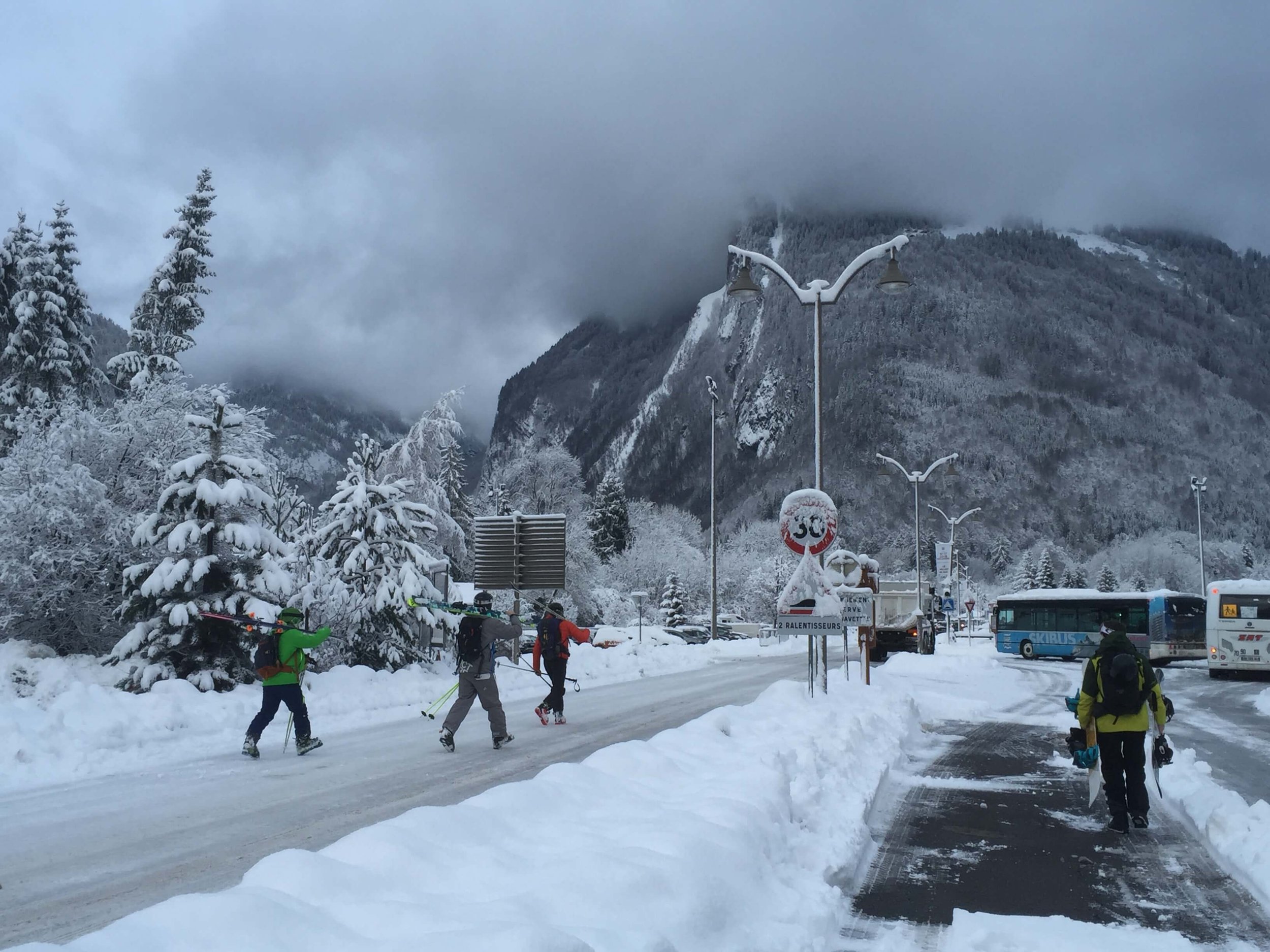
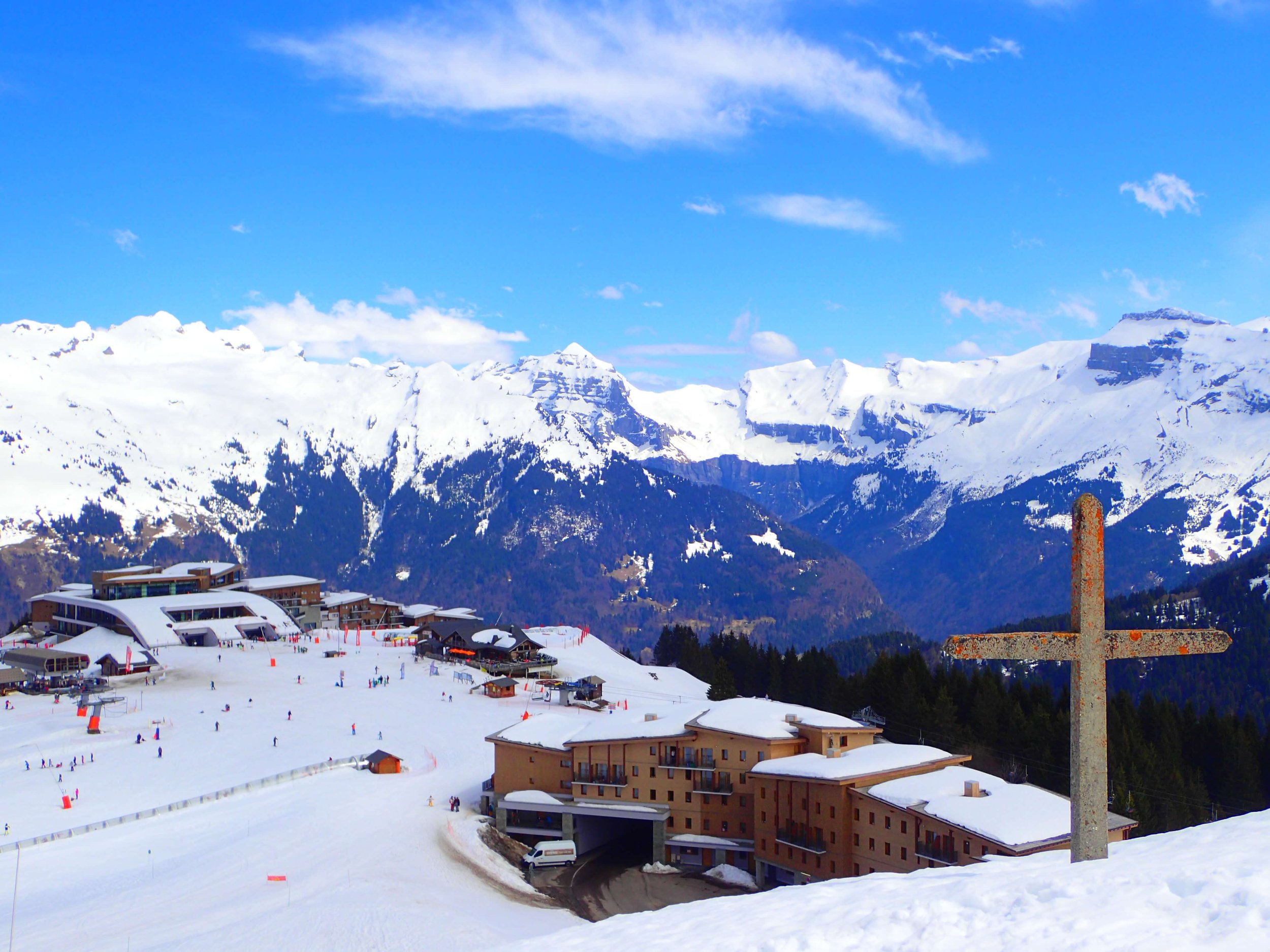
Staying in the village of Samoëns is a great base with plenty of restaurants, bars and shops within easy walking distance of your accommodation. It is worth noting that the village is a short walk or shuttle bus ride from the Grand Massif Express Gondola so you will need to factor this into your morning routine.
If you prefer on-slope accommodation there are several places to stay at Samoëns 1600 although you will miss out on the village vibe. Samoëns 1600 is also the base for a large Club Med hotel with all-inclusive facilities including a ski school. This would make a good base for families heading to the Grand Massif.
SAMOËNS LIFT PASS
Lift passes in Samoëns represent exceptional value. If you think you will ski more than one week in a season then consider getting the Grand Massif season pass, if purchased online before 30th November you save 50% meaning a whole season of skiing for €552. You can even add summer access so you have access to all the summer hiking and mountain biking.
If you are only visiting for one week then you can see all the options for lift passes here. I would always recommend getting the Grand Massif pass rather than the local area pass as it represents better value.
SAMOËNS PROS
Samoëns has direct access to the rest of the Grand Massif from the Chariande Express.
There is a brilliant beginner’s area in Samoëns that makes it the perfect base for never-evers.
Samoëns has a good mix of terrain in the local area making it a great base for mixed ability groups.
Aigle Noir black run is genuinely intense and for able skiers and snowboarders can represent a fantastic challenge.
SAMOËNS CONS
Crowding in Samoëns has become a problem during peak weeks since the closure of the Chariande 2 chairlift.
If you are staying in the village you will need to take a shuttle bus to the Grand Massif Express. Because of the bus timetable, it is hard to get to the GME before there is a queue during peak weeks.
Restaurants in the Samoëns ski area seem to charge more than in other Grand Massif resorts.
SAMOËNS GALLERY
NEARBY SKI RESORTS
FINAL THOUGHTS
Samoëns has been one of my favourite ski areas in France for years, I love it for the traditional village and the access it has to the rest of the Grand Massif. However, since the Chariande 2 lift has been out of action, Samoëns has had a problem, crowding during peak weeks. If you are visiting Samoëns outside of the main holiday weeks, I guarantee you will have a fantastic time! During peak periods, you may suffer from morning queues at the Grand Massif Express and Chariande Express chairlifts.
DISCOVER SAMOËNS
www.samoens.com
AROUND THE GRAND MASSIF
Borovets Ski Resort Guide
Borovets in the Rila mountain range is a family-focused ski resort that makes skiing affordable. With modern facilities including some resort-style luxury hotels within walking distance of the pistes, Borovets could be what you are looking for. There are plenty of reasons to visit Borovets with more terrain than rival Bansko, alongside night skiing and cross-country trails, Borovets packs a punch without needing to spend too many £££.
BOROVETS FIRST IMPRESSIONS
Arriving at Borovets my first impression was one of surprise. Honestly, before heading to Bulgaria I was probably a bit of a ski snob leading to French alps or nowhere kind of attitude. The facilities in Borovets were much better than anticipated and this is the trip that really opened my eyes to the rest of the worlds ski hills. When walking around the resort and looking at the Borovets hotels, you could see that everything was a good standard.
BOROVETS SKI AREA
Borovets has invested to improve its lift system and improve uphill times, although its gondola is still antiquated. This is a small compromise to make for access to the largest number of pistes in Bulgaria. Strangely Borovets is split between two distinct ski areas, the slopes near the Rila Hotel and the slopes by Yastrebetz Gondola. The highest point of the resort is reached via the gondola with pistes at 2550m that allow you to ski down to the base area at 1300m. Strangely the cross-country courses can be found at the top of the resort with trails to 2900m.
The beginner’s area is situated near Hotel Rila, and as such is also the base for the ski school. The slopes here are mellow and are surrounded by restaurants, bars and hotel facilities. As you progress you will head to the Sitnyakovo chairlift that offers a little more challenge. This area is quite small but is enough to get you started. The Sitnyakovo chairlift also remains open for night skiing throughout the season.
If you are looking to explore further then head to the Yastrebetz gondola. From here you will be able to explore two main sections, at the top Markudjik and lower down Yastrebetz. The Markudjik ski area has another small beginners area with mellow slope serviced by a magic carpet and poma. You can also access some blues and a short black that will take you to the gondola’s mid-station. The Yastrebetz area offers the most challenge with some decent red runs that offer some decent vertical drop. If you want to stay in this area it is easy to lap via the Yastrebetz Express, a high-speed quad that ensures you can continue to get plenty of laps.
There is little challenge in Borovets for advanced skiers or snowboards with less than 10% of the piste map dedicated to black runs. There is some off-piste but unless the conditions are prime it can be best avoided. Skiing in the trees can be a bit of a disappointment with some forestry needed to make them truly skiable.
The Borovets ski map below gives a good overview of the accessible terrain throughout the ski resort. The layout of Borovets ski resort can be tricky if your group has varying abilities as you may find yourself split between distinct areas.
Borovets Ski Resort Piste Map
SEASON DATES
The ski season in Borovets runs from December through to April although snow quality and coverage can suffer in early and late season. It is getting better with improvements to snow-making facilities. The lower slopes especially can suffer and late season operations are moved to the top of the gondola. You can check the Borovets weather by accessing the Borovets ski webcam which is a good way to check the slopes before leaving your hotel.
BOROVETS LIFT TICKETS
Further discounts are available on Borovets lift tickets with family passes available at 20% discount. To check the latest pass prices click here
Below are my ratings for Borovets ski resort. All categories are scored out of five with higher scores being better. The only exception is crowds, a higher score in this category means the resort is busier. These scores are based of my experiences in the resort and I’d love to hear your views and experiences in the comments.
TRAVEL TO BOROVETS
WHERE IS BOROVETS
Borovets ski area is the located in the Sofia Province in the Rila Mountain Range. Close to the Bulgarian capital, Sofia travel to Borovets is fairly straightforward.
GETTING TO BOROVETS
From the UK low-cost airlines fly fairly regularly into Sofia (don’t get done by baggage fees). Flights to Sofia are regular and affordable from UK airports. A Sofia to Borovets ski resort airport transfer is 1hr. Most people book their Bulgaria ski trip through a travel company that will be on hand to organise your transfer. You can also fly into Plovdiv but your transfer time will be longer.
Search for flights here
SELF DRIVE
If you do not have an organised transfer then self-drive is possible with hire cars available in the airport arrivals area.
Search Car Hire Here
TAXI TO BOROVETS
Taxi or private hire is also available from Sofia airport but be sure to pre-arrange this with an agreed price. On our trip we used Get Transfers to find the best priced airport transfer for our group. Search Below.
HOW LONG IS THE TRANSFER TO BOROVETS?
The transfer time between Sofia International Airport and Borovets is 1 hr by coach although during busier periods this can take longer.
BOROVETS ACCOMMODATION
Borovets ski resort offers a range of hotel and accommodation options. Most hotels in Borovets are well placed offering decent services with swimming pools and spas. The food at the hotels can be hit and miss but if you need to eat out there are plenty of options that won’t harm your budget. I stayed in Hotel Rila which is a large hotel directly opposite the main slopes.
You can find great deals on accommodation in Borovets with 5* hotels offering half board options for between £500-£600pp.
BOROVETS PROS
Borovets offers great value for money European skiing
Getting to the resort is easy with plenty of options from Sofia and a short transfer time.
The Rila mountains are stunning and Borovets offer some beautiful views
The ski school provides a good service at low prices (please tip your instructor)
Borovets has a lively nightlife
Borovets has more terrain than other Bulgarian ski resorts
Borovets hotels are well placed for the slopes
BOROVETS CONS
Limited off-piste available
Borovets ski area is small when compared to large French / Swiss resorts
The Borovets gondola to Yastrebets from the base is long and slow!
BOROVETS GALLERY
OTHER ACTIVITIES IN BOROVETS
Borovets can be more than the average ski holiday with plenty of activities to keep everyone occupied. Great for days you just fancy a rest or as an addition to your trip consider the following Borovets activities.
Spa Day
Nothing says relax more than a spa day. Perfect for skiers and snowboarders with tired legs there a plenty of options for spa days in Borovets. The appeal is obvious, being sat inside a warm sauna or jacuzzi whilst everyone else is out in the cold will make your friends jealous. In Borovets, most hotels have spa and pool facilities, with the larger hotels offering treatments. A massage in Borovets is likely to set you back around £30
Tobogganing
Always a hit with the kids tobogganing can make a great evening activity. Sledges are available from the local bars which can be a risky combination! This can be a perfect way to wear out the younger members of the group while you sit back and enjoy the views.
Hot Springs
Known for its thermal pools Bulgaria has plenty of hot springs. This is a great activity for soaking weary muscles and helping recovery for your next ski day. Visiting the hot springs is possible during the day or in the evening so you do not need to miss out on any slope time.
FREQUENTLY ASKED QUESTIONS
Is Borovets good for skiing?
Hopefully, I have already answered this question but just in case you need more convincing the answer is yes. Borovets offers good skiing and snowboarding at low prices. You will find 58km of pistes, which mostly suit intermediate skiers. You will not find lots of off-piste or steep runs in Borovets but the terrain will suit most people. If you are looking for more challenging terrain in Bulgaria than consider a trip to Bansko or if you are a beginner consider Pamporovo.
Which is better Bansko or Borovets?
This is ultimately down to opinion and will vary from person to person. For me, there isn’t too much difference in the actual skiing between Bansko and Borovets. Bansko does have a world cup run which offers more challenge than anything you will find at Borovets, but Borovets offers more terrain. Away from the slopes both Bansko and Borovets have a lively nightlife. I like that you can get away from this in Bansko with a trip to the old town, a Unesco heritage site. In the Old Town, you will find restaurants and bars that are quieter and set in a beautiful setting. The closer you get to the gondola in Bansko it gets more modern and more nightlife oriented. Borovets also has a good nightlife scene, but you will find the hotels in Borovets offer great entertainment for kids with games rooms etc.
Where to eat in Borovets?
Borovets has a number of restaurants conveniently placed near the base of the slopes. If you like Mexican food then check out Mamacita’s which has decent reviews. Most holidays in Borovets include half-board accommodation so if you want to stay in your hotel then food is already sorted.
FINAL THOUGHTS
Borovets is a resort that I am happy I visited. As a intermediate it was great for me and my friends who were learning to ski. The ski school did a great job and we all improved significantly. I visited as a student and the value could not be argued with. We had full board, including ski hire and lift passes for less than some French Alps 6 day lift passes. I would not recommend it for the more advanced skier or snowboarder as you may feel it lacks challenge.
DISCOVER BOROVETS
How To Make The Most Of Night Skiing
For a long time, Night Skiing had been near the top of my bucket list. Although I have been snowboarding for a while now, I had never made it to a resort that offered some after-hour laps! When looking to visit the Hakuba Valley in Japan it became evident that this was going to be my opportunity. With Night Skiing available at Happo One, Tsugaike Kogen and Hakuba Goryu I was spoilt for choice and was bound to make this finally happen. More recently I was able to back up that experience by night skiing at Coronet Peak in New Zealand. Both experiences were really cool and helped me to realise some key tips to make the most out of night skiing.
CHECK OUT THE VIDEOS BELOW FROM MY NIGHT SKIING EXPERIENCES
Considering Night Skiing? Take a look at my tips below
Wrap-Up Warm - It should go without saying but when the sun goes down it gets colder outside. Adding an extra warm layer will help you stay comfortable during your nighttime session, especially when sitting on those nighttime chair lift rides.
Lens Choice - Wearing goggles with a high VLT (visible light transmission) will really help clarity when night skiing. Try to avoid dark lenses or those designed for sunny conditions. A clear lens would be perfect but any storm lens should provide enough visibility.
Take It Easy - When the sun goes down the ground hardens up. It can be better to ride at lower speeds until you are familiar and confident with the conditions.
Focus On A skill - Depending on where you are night skiing you may have more options. At Happo we were limited to one slope which can make it quite a repetitive process. I chose to focus on a skill, this helped me to get the most out of being restricted to a small area and made the experience useful and enjoyable.
Get There Early - Most night skiing will open when the sun is still shining. This a great opportunity to get some laps in whilst the snow is still a little softer.
Pay Attention To Daytime Temps - If it has been warm during the day it is likely the top layer of snow will have melted and will refreeze as the sun goes down. This will make the surface for night skiing more prone to icy spots and you should ensure your board or ski’s have had a recent edge tune.
Check The Forecast - If there is a storm incoming, Night Skiing could just be your chance to get some fresh turns before everyone else in the morning. Night Skiing tends to be quieter so offers less competitions for those powder turns.
YOUR TURN
Are you a night skiing regular? Or is it something that is on your ski bucket list? Let me know below in the comments.
Norikura Onsen Ski Resort Guide
Norikura or Norikura Onsen Ski Resort is one of the ten resorts included on the Hakuba Valley ski pass. Much less westernised than other ski resorts in the valley, Norikura feels a world away from Hakuba Village. You will not find any large chain rental shops or bustling restaurants at Norikura but you will discover an authentic Japanese skiing experience. Much quieter than the resorts of Happo or Goryu, it can feel like you have the resort to yourself which is always an incredible feeling.
HAKUBA NORIKURA ONSEN FIRST IMPRESSIONS
Arriving at Norikura feels a little different to arriving at the other Hakuba Valley resorts. To start with, if you are taking the free Hakuba Valley shuttle buses you will notice that most people stay on the bus and head to the neighbouring Hakuba Cortina ski resort. It is a strange feeling to arrive somewhere with a bus of 50 people and be the only person to get off! Once off the bus, you will not notice any major infrastructure other than the hotels at the base of the resort. You will walk straight off the bus and onto the chairlifts!
The second noticeable thing was the lack of crowds at Norikura. The majority of skiers and snowboarders appeared to be Japanese and I could count the western visitors I noticed on one hand. Once away from the base area, which has some mellow beginner slopes, don’t expect lift lines because there aren’t any!
HAKUBA NORIKURA ONSEN SKI AREA
Similar to most of the resorts in Hakuba you will not find a particularly large ski area at Norikura. With only 500m of vertical drop 1300m-800m and 14 trails, it’s a good job that Norikura is linked to its neighbour resort Cortina. The link to Cortina adds an additional 16 runs to the Norikura ski area which should be enough to keep most people occupied for a week of skiing or snowboarding, especially when you consider the amount of snow these resorts receive.
There is nothing particularly challenging about the terrain on the Norikura Onsen side with perhaps the most challenge to be found in the trees. The tree riding at Norikura is similar to Cortina in that it is open with skiers and snowboarders taking responsibility for their own riding in these areas. With 80% of the terrain marked as beginner or intermediate, those looking for a challenge should take the connecting lifts over to Hakuba Cortina where the runs are steeper. For those staying on the Norikura side, you will face less competition for your turns.
FREESTYLE TERRAIN NORIKURA ONSEN SKI RESORT
The ski area at Hakuba Norikura has a terrain park which features a good-sized half pipe. You will also find a border cross course and freestyle moguls set up. The freestyle terrain at Hakuba Norikura Onsen is minimal and if freestyle is your main interest you should consider visiting Hakuba 47 ski area.
BEGINNERS TERRAIN NORIKURA ONSEN SKI RESORT
If you are a beginner you will find that Norikura is a great place to learn and to have easy progression. There are some nice mellow runs just opposite the Hakuba Alps Hotel, near the bus stop, accessible from lift 1. Similarly, the green trail beneath the No. 6 chair will be enjoyable for beginners. A real perk of skiing or snowboarding at Norikura as a beginner is the lack of crowds. The runs at Norikura allow plenty of space to practice your turns without worrying about crashing into other skiers.
INTERMEDIATE TERRAIN NORIKURA ONSEN SKI RESORT
Norikura Onsen ski resort is great for intermediates looking to take their first steps into tree skiing. The tree runs here are widely spaced and lack the steepness found at neighbouring resorts. This combination makes tree skiing here less worrying and more enjoyable. Partner this with the copious amounts of snow received at Hakuba Norikura and this could be the perfect intermediate powder playground.
ADVANCED TERRAIN NORIKURA ONSEN SKI RESORT
The aptly named Expert course at Norikura is one of the few black trails on offer within the bounds of the resort. Just like other black ski trails at Norikura Onsen, the Expert Course is short and over in a flash. A real treat for expert skiers is the backcountry run between Hakuba Cortina and Norikura. This route can be lapped starting in Cortina and finishing at Norikura Onsen.
The nice thing about off-piste skiing at Norikura and the neighbouring Cortina ski resort is the lack of restrictions. A number of ski resorts in the Hakuba Valley require you to attend safety briefings (Tsugaike Kogen) or to register with ski patrol (Hakuba 47). This can be a bit… over the top when you compare the terrain you can access at European resorts without restrictions. The freedom to ski in the tree areas at Norikura and Cortina is perfect, especially on a powder day! Just be careful as the amount of snow you will encounter is probably much more than you are used to!
LIFTS AT NORIKURA ONSEN SKI RESORT
In what seems commonplace for Japanese ski resorts, Norikura has nearly as many lifts as trails. The nine total chairlifts are fairly basic and run at a mild speed without being overly slow. I guess the low vertical means you don’t spend too long riding the chairs.
No.3 and No.5 Pair lifts will offer the most challenge at Norikura Ski Resort. These chairs access the steeper terrain in the resort. Beginners will enjoy the terrain under the No.6 chair which offers mellow green ski trails back to the base area.
SNOW RECORD AT NORIKURA ONSEN SKI RESORT
The ski resort of Hakuba Norikura is situated to the North of the Hakuba Village close to Hakuba Cortina and Tsugaike Kogen. This end of the Hakuba Valley is best known for receiving the most snowfall and makes it the place to go for powder turns. If you are an experienced skier or snowboarder you should make the most of the linked ski pass that Norikura shares with Hakuba Cortina as this will allow you to make the most of the great tree skiing in the area.
NORIKURA PISTE MAP
SEASON DATES
The ski seasons at Hakuba Norikura typically runs between December and April with the best skiing found between the end of January and the end of February. It is during this period that Norikura receives massive amounts of snow fall. There is a reason they call it “Japanuary”.
TRAVEL TO NORIKURA
Where is Norikura Onsen
Norikura Onsen ski resort is in-between two of the most popular resorts in the Hakuba Valley. On one side is Tsugaike Kogen ski resort known for its DBD tree skiing area. On the other is Hakuba Cortina, which is close enough to be linked via chairlift to Norikura Onsen. This part of the Hakuba Valley receives the most amount of snow and it is here you will want to head for the best Japanese powder skiing.
How to get to Hakuba Norikura
Free shuttle buses run to Norikura via Tsugaike and Iwatake ski resorts. The buses do not run very frequently so you will have to check the most up-to-date timetable. On your way back to Hakuba village the bus will leave Cortina before reaching Norikura which can mean that seats are few and far between. The drivers try to save seats on a busy day.
NORIKURA ONSEN ACCOMMODATION
If you wanted a more relaxed feel for your Hakuba holiday you could base yourself in Norikura. The Hakuba Alps Hotel is at the base of the slopes and would represent a good ski-in ski-out option. Alternatively, there is lots of accommodation options in Hakuba village and really depends on your preferences and budget. I stayed in a guesthouse which was fairly basic but provided a space to cook, wash and sleep.
NORIKURA PROS
Norikura Onsen main selling point for me would be the lack of crowds. There is less waiting in line, less competition for first tracks and more room on the pistes.
Being a linked ski area Norikura and Cortina combine to make one of the larger ski areas in the Hakuba Valley. This means there is more terrain to keep you occupied without having to repeat the same runs.
The backcountry run between Hakuba Cortina and Norikura Onsen ranked number 1 in my Five Best Runs Hakuba Valley
The resorts of Tsugaike, Norikura and Cortina receive larger amounts of snow than the other Hakuba Valley ski resorts.
Free shuttles are available to Norikura Onsen Ski Resort from the Happo Bus Terminal
NORIKURA CONS
Although free shuttle buses connect Norikura to Happo Bus Terminal and the other Hakuba resorts, they do not run as frequently. This can make inter-resort travel a little tiresome.
No major challenge for advanced skiers or snowboarders meaning you could find yourself repeating certain runs.
NORIKURA VIDEOS
NEARBY SKI RESORTS
NORIKURA ONSEN FINAL THOUGHTS
Hakuba Norikura Onsen Ski Resort was great to visit for its more relaxed vibe and I found myself visiting the combined Cortina-Norikura ski area multiple times throughout my trip. Although by staying on the Norikura side you may sacrifice some challenge, I do feel it’s worth it for less competition for fresh snow.



